Galileo FOC (Full Operational Capability)
Non-EO
ESA
Operational (nominal)
Quick facts
Overview
| Mission type | Non-EO |
| Agency | ESA |
| Mission status | Operational (nominal) |
| Launch date | 22 Aug 2014 |
Galileo Navigation Program: FOC (Full Operational Capability)
Spacecraft Launch Mission Status Navigation Payload SAR/Galileo Payload Ground SegmentReferences
Galileo is a joint initiative of the European Commission (EC) and the European Space Agency (ESA). Galileo will be Europe's own global navigation satellite system, providing a highly accurate, guaranteed global positioning service under civilian control. It will be inter-operable with GPS and GLONASS, the two other GNSS (Global Navigation Satellite Systems). The complete system consists of:
• A space segment of 30 MEO satellites in 3 planes inclined at 56º
• A launch segment to place the satellites into their operational orbits
• A control ground segment for monitoring and control of the satellites
• A mission ground segment managing all mission specific data
• A user ground segment of equipment capable of receiving and using Galileo signals
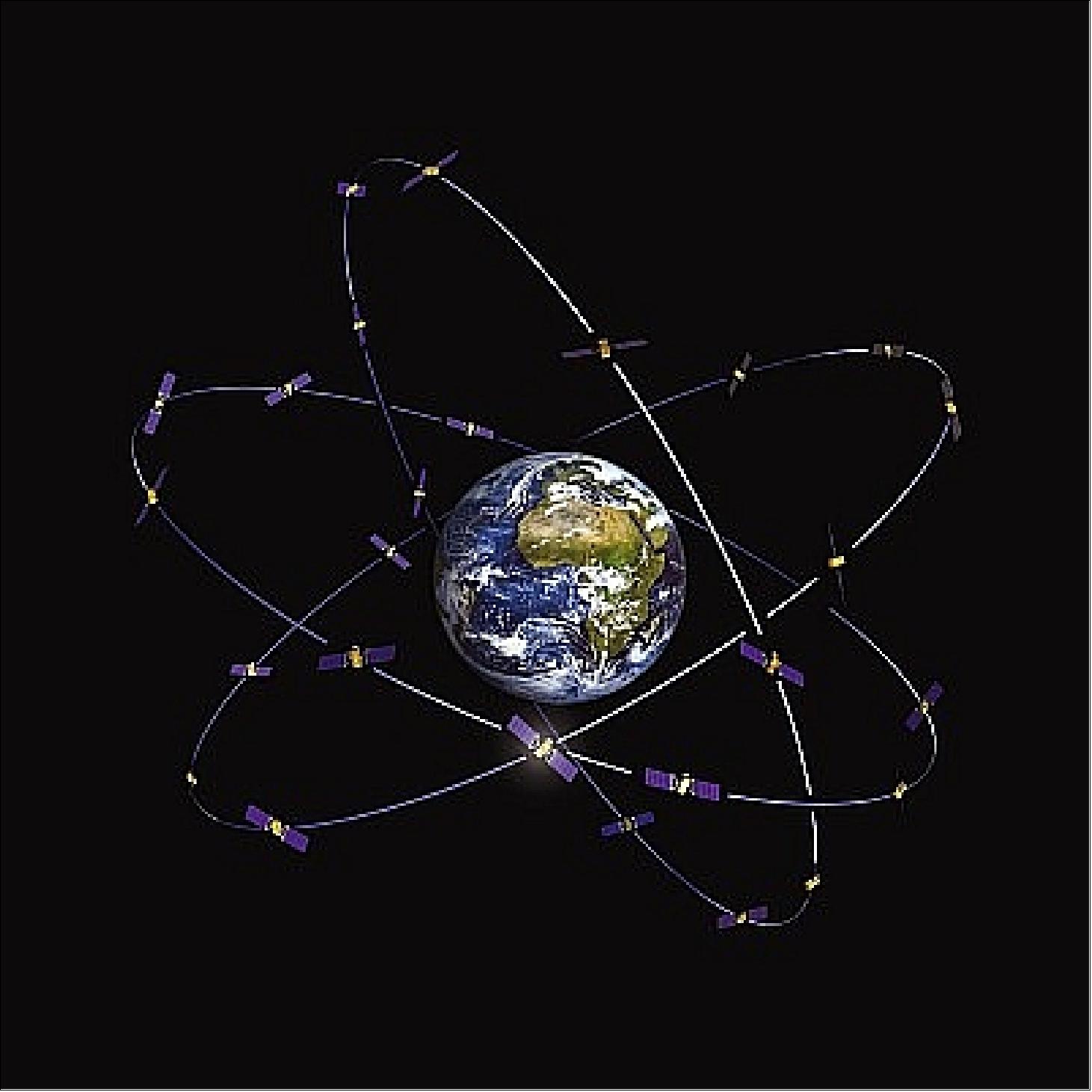
The Galileo program has been structured into two phases:
1) IOV (In-Orbit Validation) phase: IOV consists of tests and the operation of four satellites and their related ground infrastructure. The first two IOV satellites were launched on Oct. 21, 2011. The second pair of IOV satellites, IOV-3 and IOV-4, were launched on Oct. 12, 2012.
2) FOC (Full Operational Capability) phase: FOC consists of the deployment of the remaining ground and space infrastructure. It includes an initial operational capability phase of 18 operational satellites. The full system will consist of 30 satellites, control centers located in Europe and a network of sensor stations and uplink stations installed around the globe.
On July 1, 2008, the EC and ESA launched the procurement process of Galileo. Political decisions made by the European Parliament and the Council in 2007 resulted in the allocation of a budget for the European satellite navigation programs EGNOS and Galileo and provided for an agreement on the governance structure of the programs.
This framework provides for the deployment of the FOC (Full Operational Capability) of Galileo under a public procurement scheme, entirely financed out of the European Community budget. The European Commission (EC) acts as program manager and contracting authority, and ESA acts as its procurement and design agent.
The procurement initiated includes six WPs (Work Packages). In this setup, ESA functions in its role as the designated procurement agent on behalf of the European Union: 1)
• WP1 deals with system support services.
On January 7, 2010, the EC awarded a contract to TAS-I (Thales Alenia Space-Italia). 2)
• WP2 is dedicated for the ground mission.
• WP3 covers the ground control.
• WP4 covers the development of the spacecraft.
On January 7, 2010, the EC awarded a contract for a first order of 14 satellites to OHB System AG of Bremen, Germany. OHB System teamed with SSTL (Surrey Satellite Technology Ltd.), UK. - Note: In 2012, the OHB-SSTL consortium was awarded a second contract to supply a further 8 spacecraft for the program.
• WP5 deals with the launch services of the constellation.
On January 7, 2010, the EC awarded a contract to Arianespace of France.
• WP6 is dedicated to the preparation activities as well as all the operations services of the fully-deployed Galileo system.
- WP6 Work Order 1 covers all activities related to the completion of the IOV (Galileo In Orbit Validation) activities – the first four Galileo satellites are due for launch in 2011.
- WP6 Work Order 2 is dedicated to the implementation and activities of an integrated engineering team supporting ESA for system operations.
- WP6 Work Order 3 deals with the completion of deployment of operations for Galileo's FOC, scheduled for 2014.
- WP6 Work Order 4 covers the full deployment of the two Galileo Ground Control Centers, in Germany at Oberpfaffenhofen and in Italy at Fucino.
On Oct. 25, 2010, ESA signed a contract with Spaceopal, a joint undertaking between the Italian company Telespazio and the German firm GfR (Gesellschaft für Raumfahrtanwendungen mbH). GfR has been set up by the German Aerospace Center (DLR) to provide operational services for the Galileo system. 3)
Contract kick-off with OHB as the prime of the FOC space segment WP1 (Work Package 1) took place in late January 2010; two years later, again after highly competitive bidding and based on the performance in WP1, OHB was also able win the space segment Work Order 2 contract, thus increasing the total number of satellites to be built to 22. The Galileo FOC project is characterized by an extremely challenging schedule, which foresees a delivery of a finalized satellite every six weeks. 4)
Development of the Galileo Satellites
• June 13, 2022: Every moment of every day, Europe's constellation of Galileo navigation satellites that ring our planet transmits precisely shaped and timed signals, down through the atmosphere, reflecting back from Earth's land, seas and ice and extending far out into space, as far as the Moon. 5)
- This ubiquity is a byproduct of Galileo's goal to provide navigation services to all – but has also led to these signals becoming an important tool for scientific investigation of our environment, atmosphere, weather and even fundamental physics. Leading researchers will gather in Bulgaria this September to discuss the latest scientific uses of Galileo and other satnav systems – and you can register to join them.
- The 8th International Colloquium on the Scientific and Fundamental Aspects of Global Navigation Satellite Systems will take place on 8–16 September in Sofia, Bulgaria, co-organised by ESA and Sofia University St. Kliment Ohridski.
- "Measurement is a fundamental aspect of science, and the signals from Galileo and equivalent GNSS satellites represent an invaluable yardstick to hold against all kind of physical processes," comments Javier Ventura-Traveset, Head of ESA's Navigation Science Office and ESA Chair for this Colloquium.
- "It is well known that fixed GNSS stations are used to monitor geological fault lines and volcanoes, and form the basis of terrestrial reference frames for measuring the precise shape of the Earth. And the occultation of GNSS signals – for instance through ‘rain fade' – helps forecast the weather as well as the structure and trace gas constituents of the atmosphere.
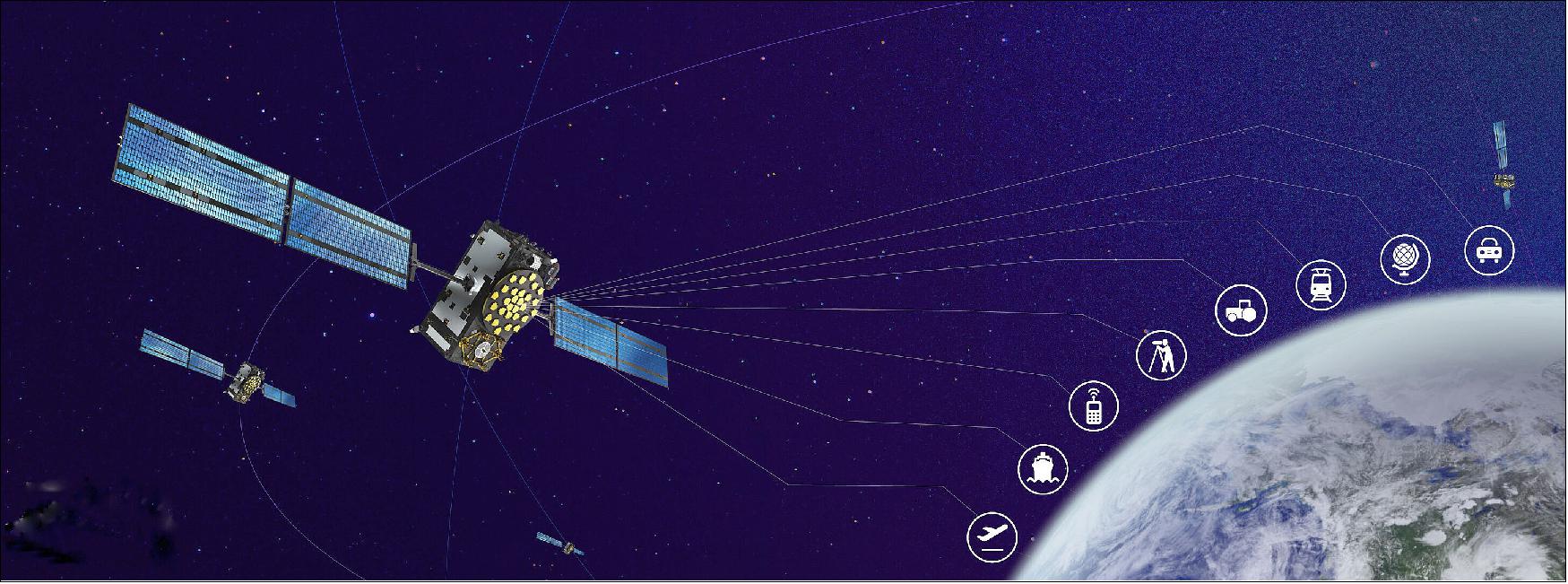
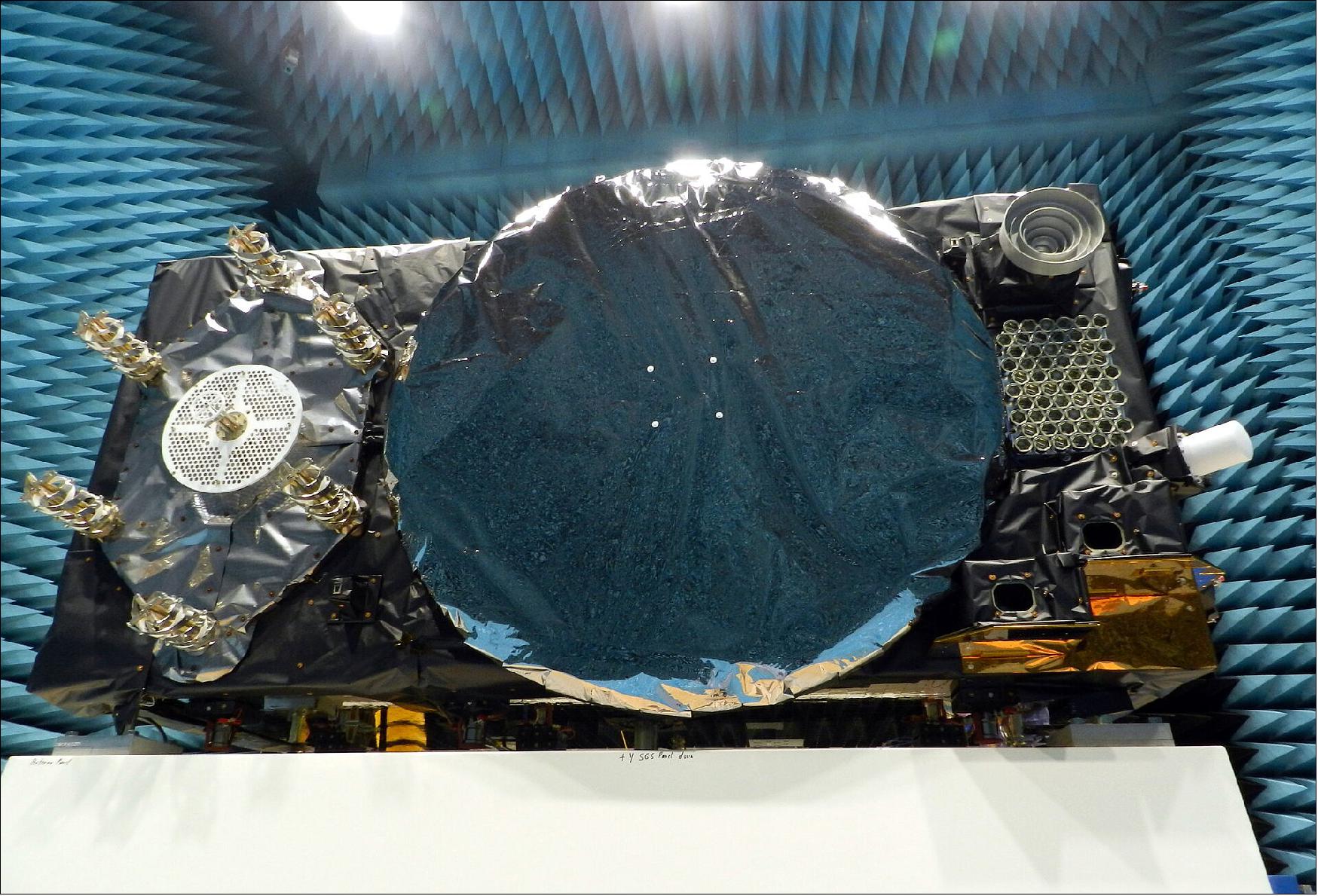
- "Reflected GNSS signals are also being employed for altimetry and remote sensing, soon to be tested by ESA's PRETTY satellite, while the timing information embedded within the signals – accurate to a few billionths of a second – can be used for all kinds of scientific testing, including fundamental physics: a pair of Galileo satellites placed in an elliptical orbit delivered the most precise measurement ever of gravitational redshift, how changes in gravity affect the wavelength of light and we have also recently being able to measure orbital perturbations due to Einstein's general relativity."
- "So scientists are eager to go on making increased use of GNSS as a tool for measurement and investigation, which has already gone beyond our initial expectations as we will see with some highly original studies during our Colloquium. ESA's Navigation Science Office aims to support them in this endeavour, coordinating through events such as September's Colloquium. This unique worldwide event is a chance for researchers to share their results and future plans in this area."
- The Colloquium will also discuss in some detail the state of the art of Systems and technologies for navigation in space, such as the use of GNSS beyond terrestrial orbits or the development of dedicated systems for ‘exo-navigation' on the Moon or Mars, as well as their scientific possibilities.
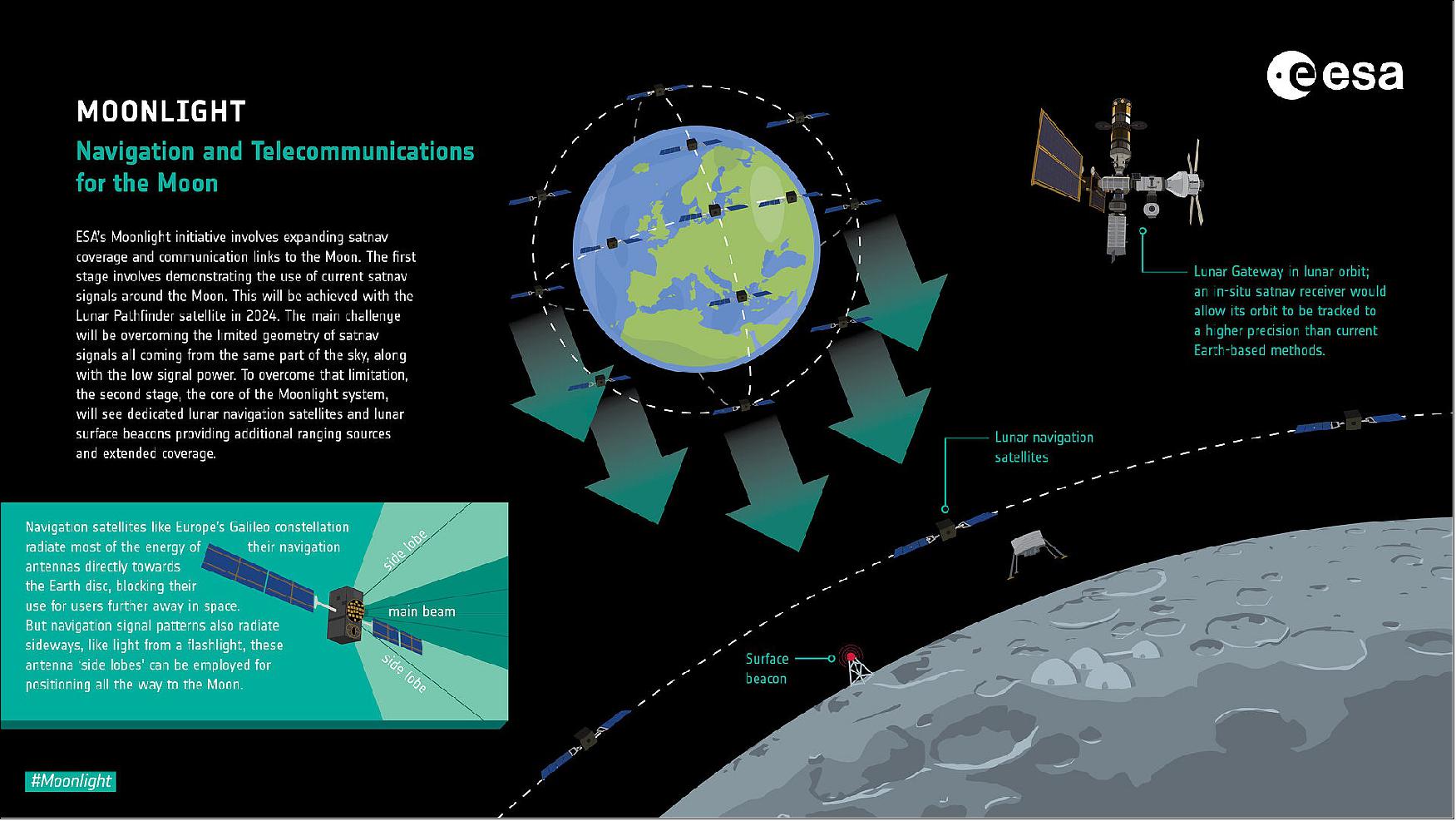
- This edition will also include ‘transversal' topics of interest to multiple fields, such as GNSS Big Data – compiling and analysing large quantities of satnav signal records – and Internet of Things positioning for science – the placement of tracking sensors on moveable items, floats or animals – as well as the use of GNSS-enabled autonomous vehicles such as drones and High-Altitude Pseudo-Satellites.
- Scientific studies with the potential to improve the future performance of GNSS will also be highlighted, such as tropospheric and ionospheric corrections and ‘hybridisation', looking into adding extra sensors to improve positioning precision and reliability and ‘precise orbit determination' – ways of sharpening the precise knowledge of satellites' position and motion through space.
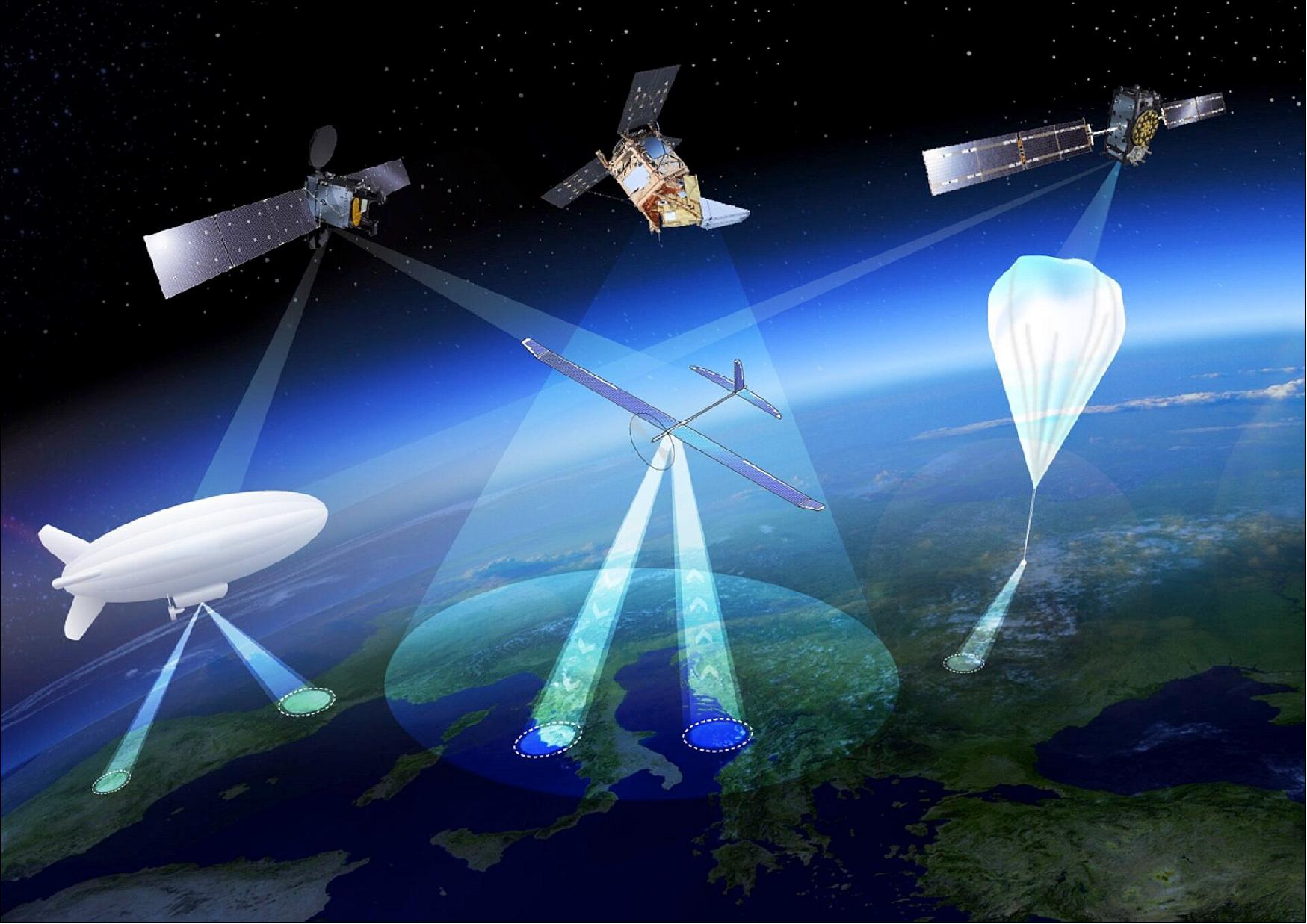
Genesis Project
- The potential of GNSS is such that ESA is proposing a dedicated mission called Genesis as part of its Future NAV programme to its Council of Ministers at the end of this year. The Genesis mission will combine, for the first time ever, all space-based ‘geodetic' (or Earth measuring) techniques aboard a single well-calibrated satellite, establishing precise and stable ties between them. Genesis will then become a true dynamic space geodetic observatory allowing to improve the realisation of the Terrestrial Reference Frame (TRF) – the single most precise model of Earth – towards the goal of achieving an accuracy of 1 mm and a long-term stability of 0.1 mm/yr.
- Javier concludes: "The Terrestrial Reference Frame is the foundation for all space- and ground-based observations in Earth Science and Navigation and, therefore, Genesis will have a major significance since it will have an impact on multiple scientific and societal endeavours, from supporting a more accurate monitoring of several climate change essential variables to improve the orbit determination accuracy of all the GNSS satellites, to name two examples."
• June 10, 2022: Ahead of Galileo satellites like this one going to space, they are switched on as if already operating there within ESA's Maxwell EMC Facility. This test procedure is a check of the satellite's ‘electromagnetic compatibility', with all its systems running together to detect any harmful interference between them. 6)
- Once Maxwell's main door is sealed, its metal walls form a ‘Faraday Cage', screening out external electromagnetic signals. The ‘anechoic' foam pyramids covering its interior absorb internal signals – as well as sound – to prevent any reflection, mimicking the infinite void of space for satellite testing.

- To the bottom right of the navigation antenna are a pair of infrared ‘Earth sensors' whose task is to keep the navigation permanently locked onto Earth by homing in on the contrast between the heat of Earth's atmosphere and the cold of deep space. Above them is the laser retro-reflector: lasers are shone up to this from the stations of the International Laser Ranging Service to perform an independent check of the satellite's orbital position down to an accuracy of less than a centimetre, as a backup of standard radio ranging.
- Above that is the circular C-band antenna which every 45 minutes or so receives the navigation messages from the Galileo ground segment. These signals incorporate corrections for slight clock errors, orbital drift or satellite malfunctions that user receivers can process as they perform positioning fixes, helping ensure Galileo remains the world's most accurate satellite navigation system, delivering metre-scale positioning to users around the globe.
- What resembles a white baton on the end of the satellite is its S-band antenna, employed to return ‘housekeeping' telemetry data to mission control on Earth and pick up telecommands in turn to operate the satellite platform and payload – as well as performing the ranging used to estimate the satellite's position in space.
- The Maxwell EMC Facility is part of the ESTEC Test Centre in ESA's technical heart in Noordwijk, the Netherlands – Europe's largest satellite testing facility, which has flight-tested all but two of the 28 Galileo satellites already in orbit, and is currently doing the same for the next 10 satellites planned to join the constellation.
About Galileo
- Galileo is currently the world's most precise satellite navigation system, serving more than three billion users around the globe.
- The Full Operational Capability phase of the Galileo programme is managed and funded by the European Union. The European Commission, ESA and EUSPA (the EU Agency for the Space Programme) have signed an agreement by which ESA acts as design authority and system development prime on behalf of the Commission and EUSPA as the exploitation and operation manager of Galileo/EGNOS. "Galileo" is registered as a trademark in the database of the European Union Intellectual Property Office (n° 002742237).
• January 6, 2022: ESA and EUSPA (European Union Agency for the Space Programme) have confirmed that Arianespace will launch eight additional Galileo satellites. 7)
- Arianespace will launch the first two satellites in 2022, leading to the Full Operational Capability of Galileo open service. Then, three successive launches on Ariane 62 in 2023, 2024 and 2025, will finalize the launch of the first generation of Galileo satellites and will increase the constellation resilience.
- These will be the 13th to 16th Galileo missions by Arianespace, which has orbited all satellites in the constellation.
- The European Union Agency for the Space Programme (EUSPA) has chosen Arianespace to launch four new Galileo satellites for Europe's own satellite navigation system. With this order, EUSPA takes over the role of placing launch services contracts for Galileo from ESA, which acted so far in the name and on behalf of the European Commission and will continue to be the technical authority for these launches.
- This order follows European Space Agency's (ESA) order for the launch of four satellites in October 2021, and will complete the deployment of first-generation Galileo satellites.
- These launches will take place from the Guiana Space Center (CSG), Europe's Spaceport in Kourou, French Guiana. After a first launch this year for Galileo, carrying satellites from a previous order, in the first half of 2022, a second Soyuz launch in 2022 will orbit the first two satellites from this latest order. The next three missions will orbit two satellites each on Ariane 62, in 2023, 2024 and 2025.
- "I would like to thank ESA and EUSPA, along with the European Commission for continuing to entrust us with their satellites," said Stéphane Israël, CEO of Arianespace. "We're very proud to once again be helping EU deploy its own global navigation satellite system. This additional order to the service of Galileo once again confirms Arianespace's assigned mission of ensuring reliable access to space for Europe."
- Each of the eight satellites under this order, built by OHB System AG in Bremen, Germany, will weigh less than 730 kg. They will join the 28 Galileo satellites already deployed to date, as well as the two to be orbited in early 2022 from the Guiana Space Center by Arianespace.
• November 25, 2021: Europe's next two Galileo satellites have been attached to the dispenser on which they will ride to orbit, and the launcher fairing that will protect them during the first part of the ascent to orbit has been closed around the pair. 8)
- Their dispenser has the double duty of securing the two satellites safely in place during the lift off and flight, then deploying the satellites into their target orbit.
- The combined satellites plus dispenser were then placed onto their Soyuz Fregat upper stage, which has the job of hauling the pair most of the way up to medium Earth-orbit, before being enclosed in their launch fairing.
- The next step will see this combined ‘upper composite' being taken to the launch site for integration with the other three stages of their Soyuz launcher, after the launcher is installed on the launch pad.
- Bastiaan Willemse, ESA Galileo Full Operational Capability Satellites Manager comments from Europe's spaceport in Kourou, French Guiana: "So far, everything has been going according to plan and we are heading towards the ending of a smooth launch campaign, which started in early October."
- These first of a total of 12, Galileo ‘Batch-3' satellites, manufactured by OHB Systems and their suppliers from all across Europe.
- The pair arrived from ESA's ESTEC Test Centre to the integration facility in French Guiana in early October, kicking off a busy launch campaign, including initial dispenser ‘fit checks', filling with the hydrazine fuel that will be used to maneuver them during their 12 years of working life and finalization of their navigation system generation units and uploading of security keys.
- These satellites will add to the 26-satellite Galileo constellation already in orbit and delivering Initial Services around the globe.
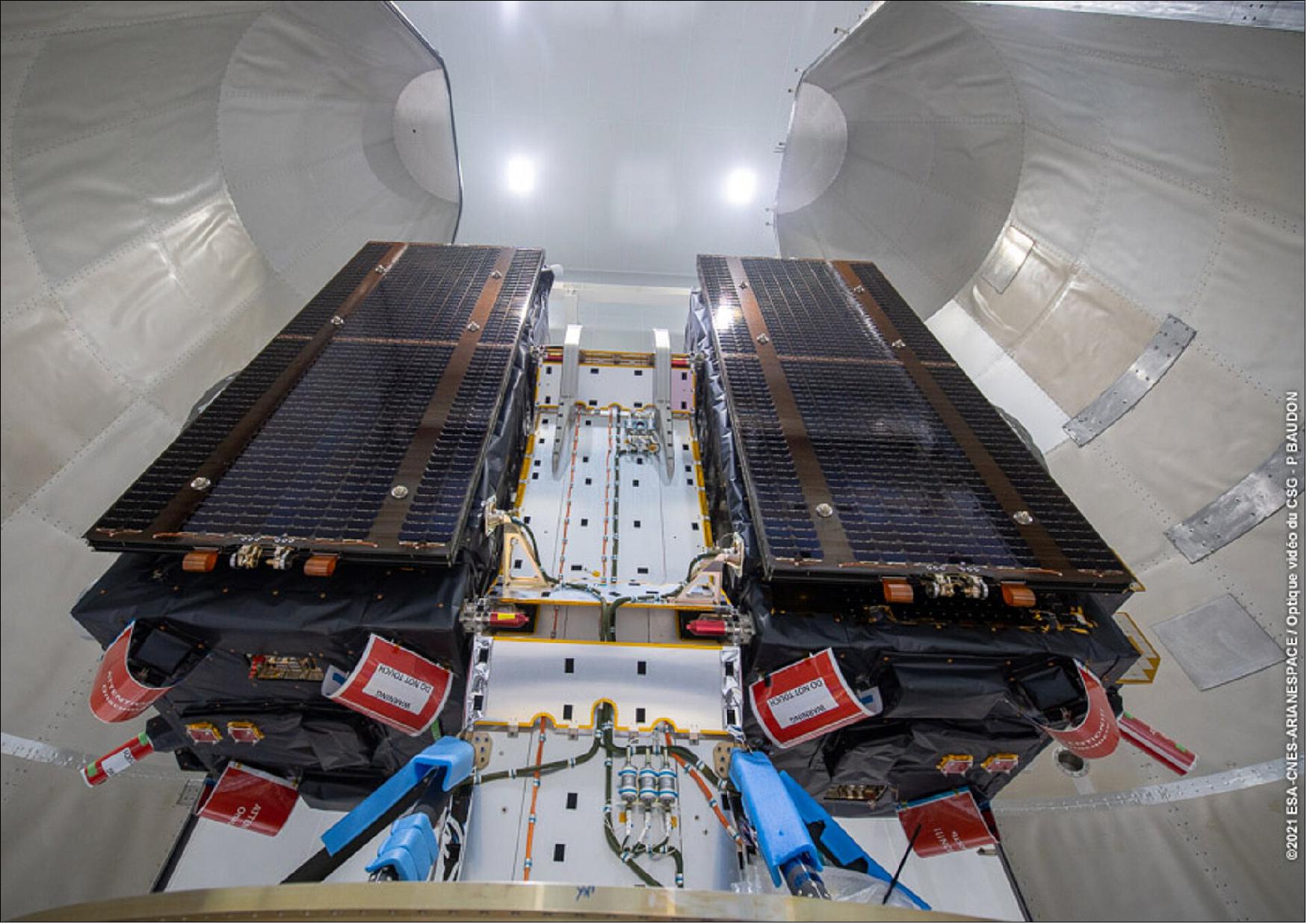
• October 10, 2021: The latest pair of Galileo satellites have touched down at Europe's Spaceport in French Guiana, ahead of their launch together next month. 9)
- Cocooned safely within environmentally controlled containers, the satellites were carried across the Atlantic aboard an Ilyushin cargo carrier. The satellites left ESA's ESTEC Test Centre in Noordwijk, the Netherlands, on Tuesday morning heading for Liège Airport in Belgium. From here they flew to Cayenne in French Guiana via a stop in Oporto Airport in Portugal, arriving at their final destination on Wednesday evening local time.
- Once unloaded from the aircraft, the satellites were then driven through the tropical dusk to the cleanroom surroundings of the spaceport nearby Kourou, where they could be safely unpacked to begin the satellite launch campaign.
- These two satellites are the first of the last batch of Galileo First Generation satellites, known as ‘Batch 3', made up of 12 satellites in all. They are built by OHB SE in Bremen, Germany, with their navigation and search and rescue payloads contributed by Surrey Satellite Technology Ltd in Guildford in the UK.
- Before being cleared for launch, the satellites have gone through rigorous testing at ESA's ESTEC Test Centre, the largest satellite test facility in Europe – their last stop before flying to South America.
- These two satellites will be launched together aboard a Soyuz launcher from Europe's Spaceport in French Guiana. The launcher incorporates a Fregat upper stage, which will carry them to their planned 23,222 km altitude medium-Earth orbit.
- These satellites will add to the 26-satellite Galileo constellation already in orbit and delivering Initial Services around the globe.
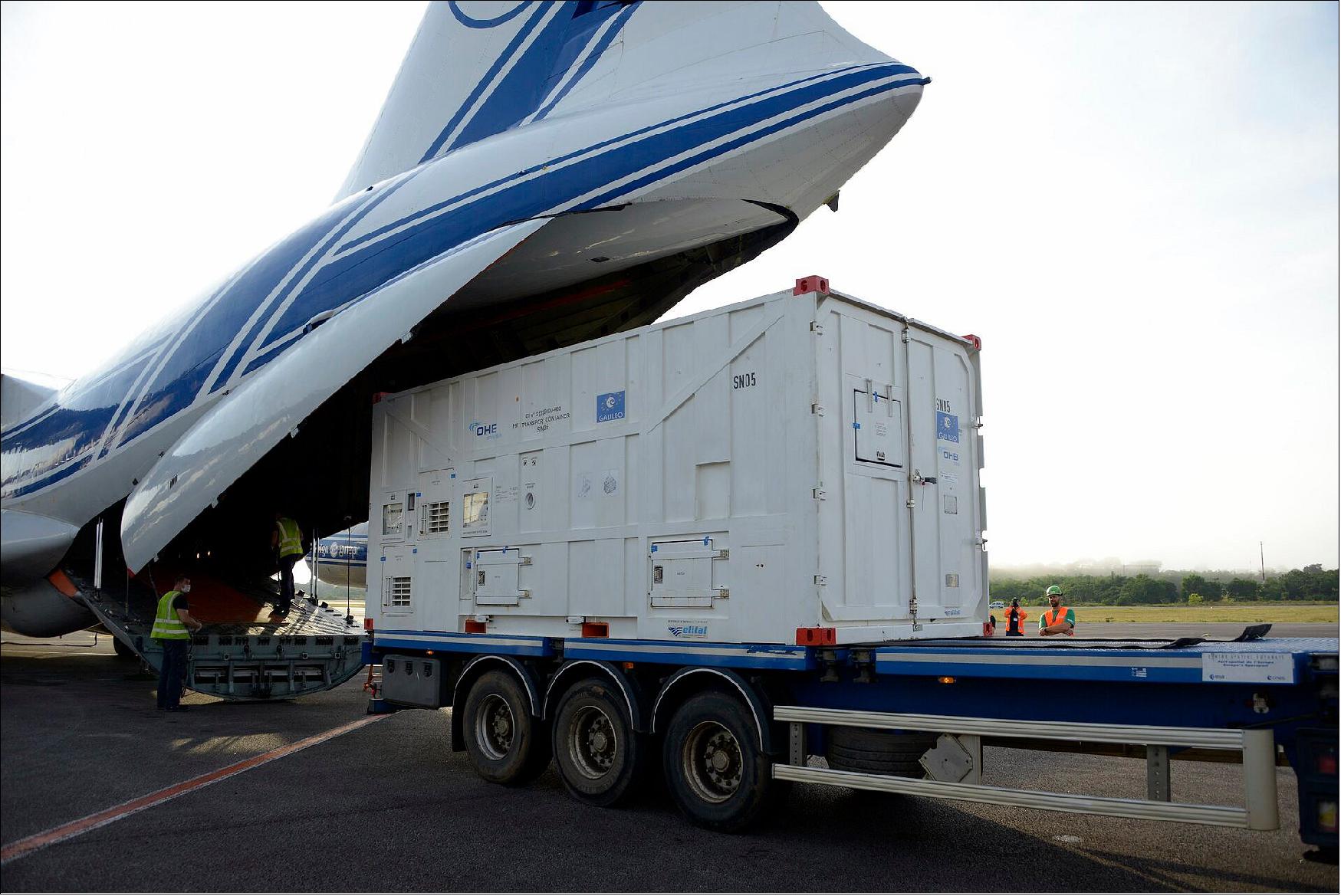
- Next month's lift-off will be the 11th Galileo launch in 10 years. Two further launches are planned for next year, to allow Galileo to reach Full Operational Capability in its delivery of services, to be followed by the launches of the rest of the Batch 3 satellites which are currently all undergoing pre-flight testing.
- In parallel to Batch 3's completion of Galileo First Generation deployment, the new Galileo Second Generation satellites, featuring enhanced navigation signals and capabilities, are already in development with their deployment expected to begin by 2024.
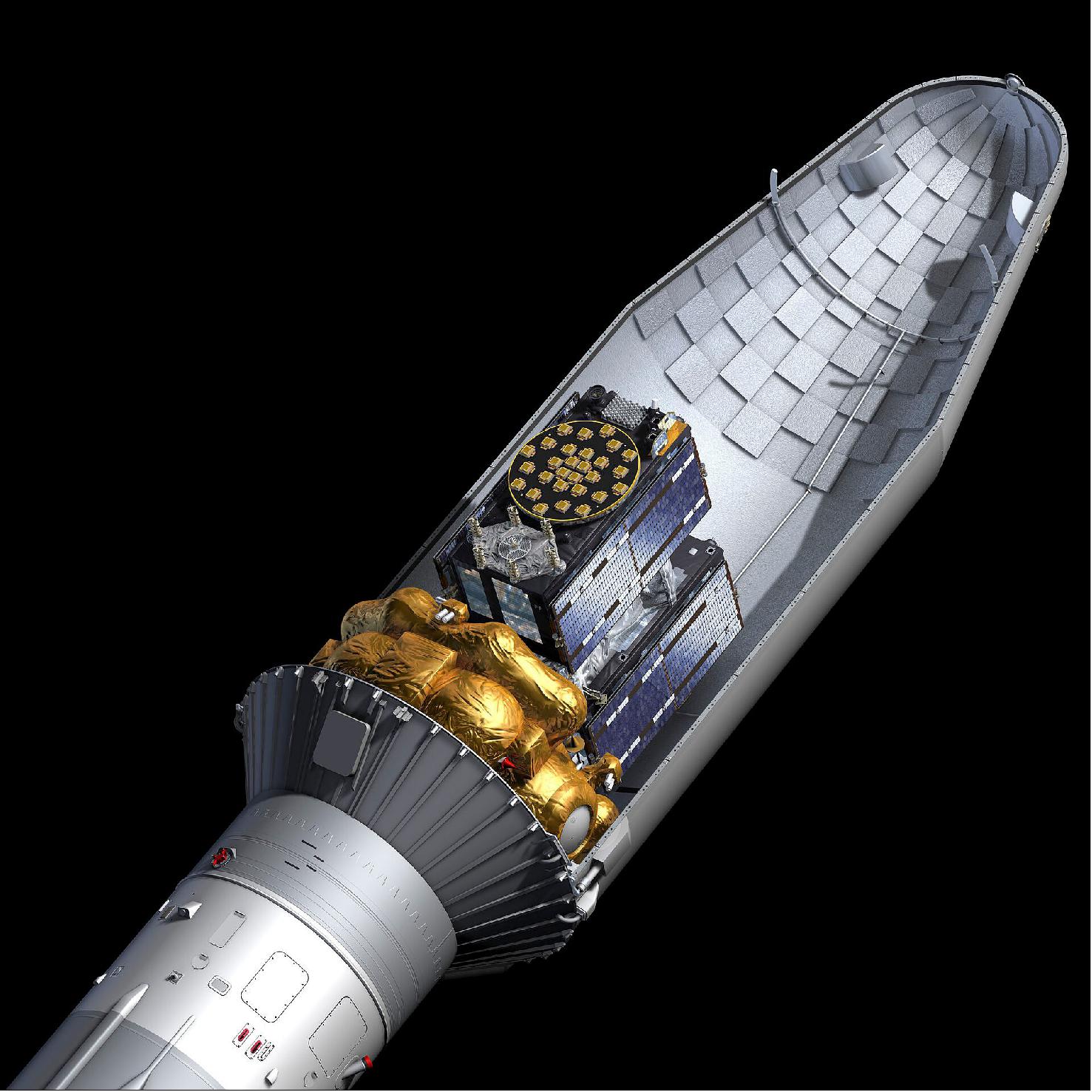
• July 19, 2021: The first Galileo Second Generation hardware has begun testing, with test versions of the satellites' navigation payloads undergoing evaluation by Airbus Defence and Space at their Ottobrunn facility in Germany and by Thales Alenia Space at ESA's ESTEC technical centre in the Netherlands. 10)
- These testbed versions of these new navigation payloads designed by the two companies are undergoing testing of their respective navigation antennas to check whether they meet the ambitious performance levels set for the coming generation of Europe's satellite navigation system.
- Known as the GPLTBs (Galileo Payload Testbeds), these are development models of the navigation payloads intended for the Galileo Second Generation (G2) satellites.
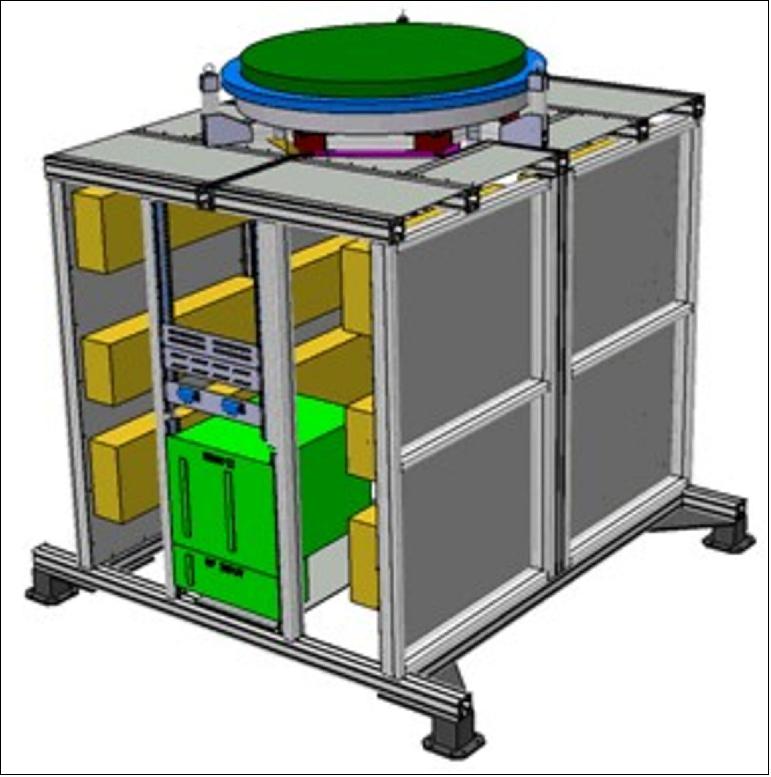
- The main difference is that instead of being assembled from space-ready components like an actual satellite payload, the GPLTBs are built up from ‘breadboard' electronic parts placed in test racks, with a proof-of-concept version of a navigation antenna attached.
- "The goal with these test campaigns are to prove their design concept early, and anticipate any technical issues that might arise as early as possible," explains Cédric Magueur, ESA's Payload Manager for the Thales G2 satellites.
- "These campaigns also allow to develop and validate new performance measurements concepts for these new generation of complex navigation payloads," adds Dirk Hannes, ESA's Payload Manager for the Airbus G2 satellites. "This will allow us to optimize the production efficiency of the Flight Model series."
- Cédric adds: "Results from the testing will feed into the up-coming Preliminary Design Review for the new satellites, backing up the analyses by the companies with solid measurements. Such early testing also supports the ambitious timescale for the development and construction of G2 satellites, with the first satellites planned to reach orbit by the middle of this decade."
- Galileo is Europe's civil global satellite navigation constellation, currently the world's most precise satnav system, offering meter-scale accuracy to more than 2 billion users around the globe. There are 26 Galileo satellites in orbit, scheduled to be joined by other 12 satellites starting to be deployed by the end of this year.
- Next will come the first 12 G2 satellites, featuring enhanced navigation signals and fully digital payloads. This new generation will be made up of two independent families of satellites meeting the same performance requirements, produced by Thales Alenia Space in Italy and Airbus Defence and Space in Germany.
- Airbus Defence and Space's GPLTB is currently undergoing radiated testing at the company's Ottobrunn facility, inside a Compact Antenna Test Range (CATR). Meanwhile the Thales Alenia Space GPLTB is about to start testing inside ESTEC's own Hybrid European Radio Frequency and Antenna Test Zone (Hertz) chamber.
- These are metal-walled chambers kept isolated from external radio interference, whose inner walls are studded with foam pyramids to minimize radio frequency signal reflections, mimicking the void of space.
- "Up until now all GPLTB testing has taken place by plugging them into test boards," adds Cédric. "These test campaigns mark the first time that their performances will be confirmed in terms of radiating signals."
- Radio-frequency radiation forming of the navigation signals takes place through a combination of digital processing and interaction with the antenna, so practical radio frequency testing is essential to check the true payload performance.
- Cédric explains: "In our first phase we will perform near-field measurements directly around the antenna to measure all the characteristics of the signal shape, to check it matches previous conductance tests. Then via computation we can derive its far-field performance.
- "In the second test phase the actual far-field measurements will be performed, using another feature of the chambers. Thanks to a pair of specially-shaped paraboloid reflectors, the signal from the testbed can be reshaped as if it has travelled the very long distance that actual Galileo signals need to stretch, all the way from an altitude of 23,222 km down to Earth's surface."
- Dirk comments:"On the Airbus side the methodology is substantially the same, except the far-field measurement are currently being performed, to be followed by the near-field.
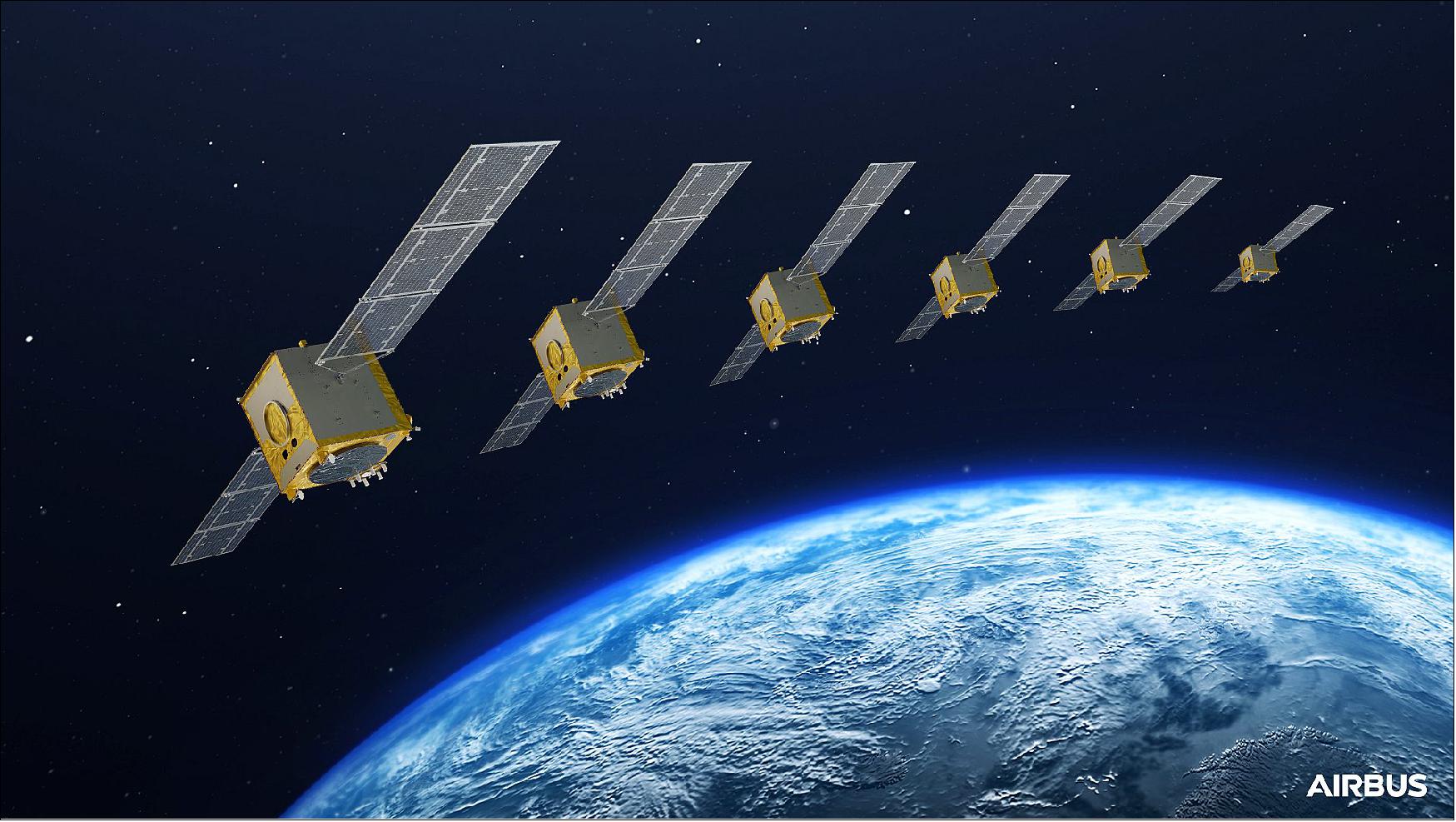
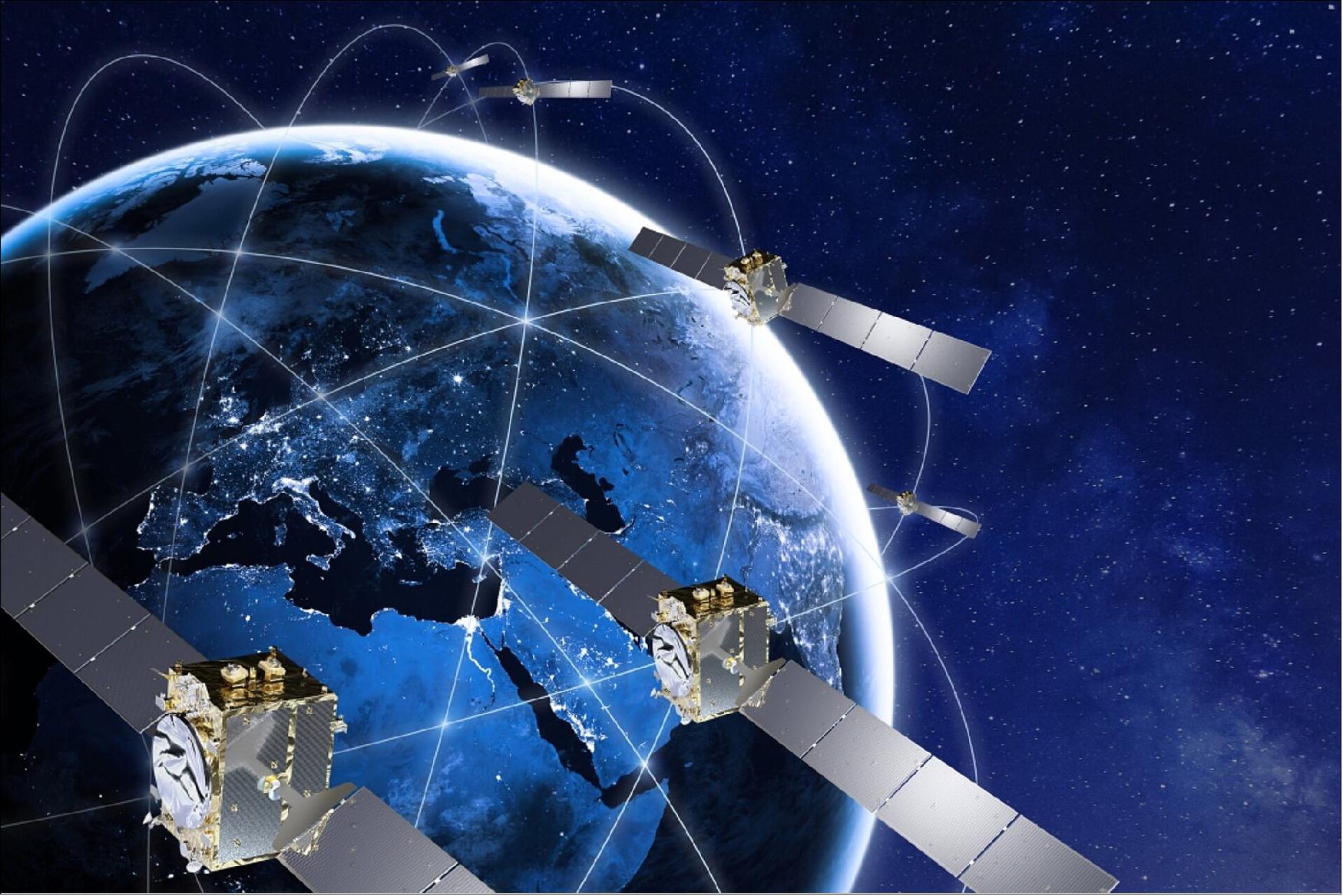
• June 3, 2021: Europe's Galileo satellite navigation constellation is set to grow. Later this year the first two out of 12 ‘Batch 3' Galileo satellites will be launched by Soyuz from French Guiana. Their last step on the way to launch is situated beside sand dunes on the Dutch coast: the ESTEC Test Centre, which is Europe's largest satellite test facility. 11)
- All but two of the 26 Galileo satellites already in orbit underwent pre-flight testing at this 3000 m2 environmentally-controlled complex, hosting test equipment to simulate all aspects of spaceflight. The Test Centre is operated and managed by European Test Services for ESA.
- All 12 Batch 3 satellites – functionally similar to the Full Operational Capability satellites already in orbit – are scheduled to come here from OHB in Germany to assess their readiness for space, before heading on to French Guiana.
- The first pair of these satellites were already at ESTEC when the COVID-19 pandemic began last year. Testing was briefly interrupted as the Test Centre was closed, but resumed once safety measures were put in place.
- Testing of this first pair was completed in April, and they are now in storage on site. Two more Galileo satellites have since arrived with another due to join them this month.
- Newly-arrived satellites begin by undergoing a two-week immersion in vacuum and temperature extremes that mimic the conditions it faces in space. This ‘thermal–vacuum' test takes place inside a 4.5 m-diameter stainless steel vacuum chamber called Phenix. An inner box called the ‘thermal tent' has sides that are heated to simulate the Sun's radiation or cooled down by liquid nitrogen to create the chill of Sunless space.
- Another test involves switching on all satellite systems within the Maxwell Test Chamber, which is fitted with shielded walls blocking out all external electrical signals and spiky, radio-absorbing ‘anechoic' material that line the chamber to prevent signal reflections. Kept isolated in this way as though floating in infinite space allows ‘electromagnetic compatibility' testing. Each satellite is switched on to check all its systems can operate together without harmful interference.
- Then, once the satellites' solar wings are fitted, which come from Airbus Netherlands in nearby Leiden, they can undergo ‘mass properties testing'. This involves measuring to check their centre of gravity and mass are aligned within design specifications. The more precisely these are known, the more efficiently each satellite's orientation can be controlled with thruster firings in orbit, potentially elongating its working life by conserving propellant.
- Each satellite also undergoes acoustic testing in the LEAF (Large European Acoustic Facility), effectively the largest sound system in Europe.
- A quartet of noise horns are embedded in one wall of this 11 m-wide, 9 m-deep and 16.4 m-high chamber, generating sound by passing nitrogen gas through the horns, surpassing 140 decibels in all. Accelerometers placed within the satellite checked for potentially hazardous internal vibration during this trial by sound.
- Once each satellite's test campaign is over, they are shipped to Europe's Spaceport in French Guiana and prepared for launch. The two tested spacecraft will leave to Kourou in October, to be launched at the end of the year.
- Summer 2020 saw the start of construction of a new 350 m2 cleanroom for the ESTEC Test Centre. Most of the time the ESTEC Test Centre has several other test items as well as Galileo satellites within its walls simultaneously.
- Complex planning and traffic management are necessary to ensure every project get access to the facility they need at the time they need it. So sufficient room is required to accommodate the different customers and allow their movement between test facilities.
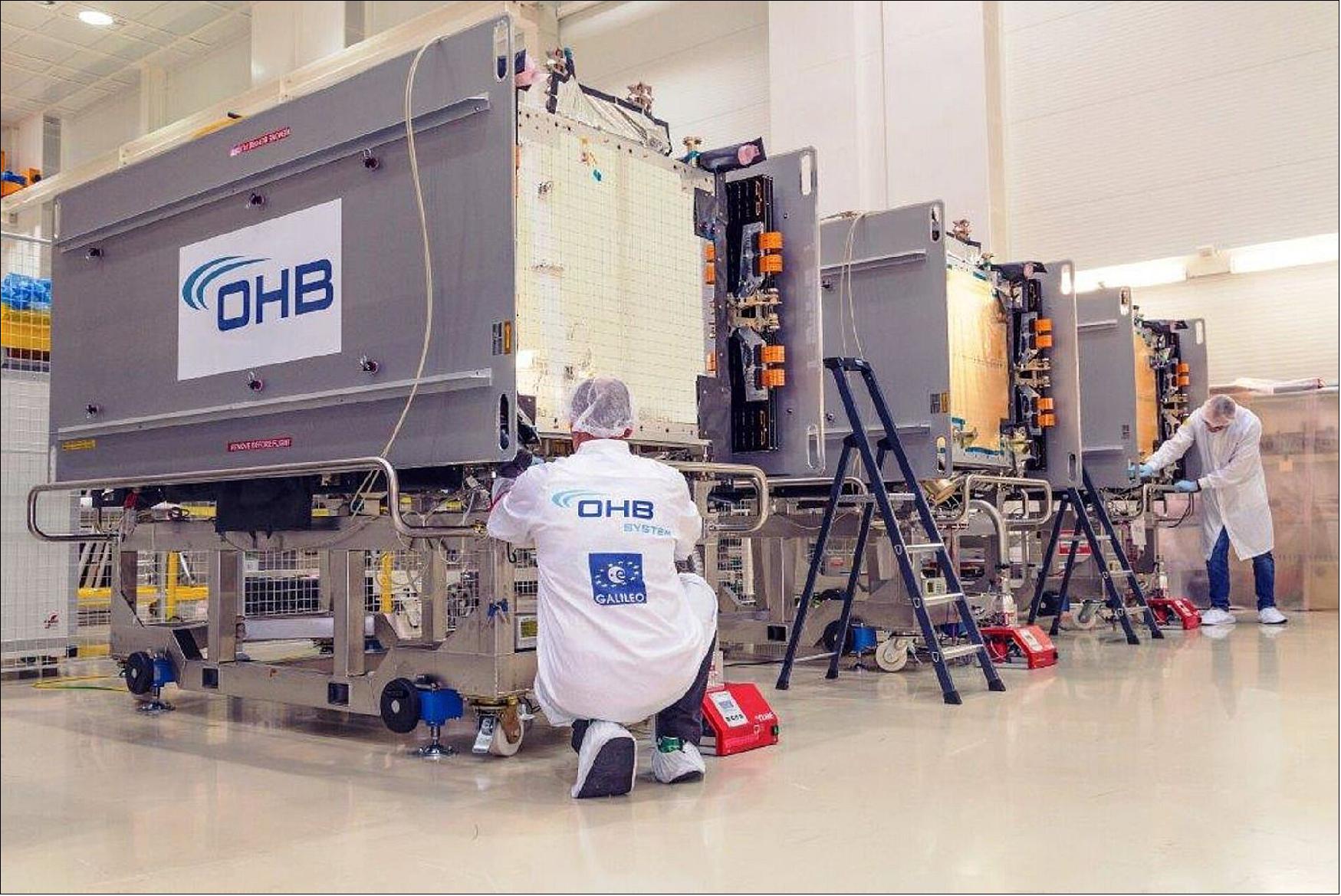
• May 28, 2021: Acting on behalf of the European Commission, ESA has signed two contracts for an overall amount of €1.47 billion, to design and build the first batch of the second generation of Europe's Galileo navigation satellites. 12)
- Following an intense process of open competition, these contracts have been awarded to Thales Alenia Space (Italy) and Airbus Defence & Space (Germany) to create two independent families of satellites amounting to 12 Galileo Second Generation satellites in total.
- "Galileo is a major success for Europe, and these contracts ensure that it is going to be around for a long time to come," comments Paul Verhoef, ESA Director of Navigation. "The Galileo Second Generation will represent a further step forward with the use of many innovative technologies to guarantee unprecedented precision, robustness and flexibility of the system for the benefit of users worldwide."
- Galileo is Europe's civil global satellite navigation constellation, currently the world's most precise satnav system, offering meter-scale accuracy to more than 2 billion users around the globe. With improved accuracy, the new generation should be able to offer decimeter-scale precision positioning to all.
- These Galileo Second Generation (G2) satellites will revolutionize the Galileo fleet, joining the 26 first generation Galileo satellites in orbit today plus the 12 ‘Batch 3' satellites currently in production and testing. The first launch of these Batch 3 satellites will take place later this year.
- The new G2 satellites will be constructed in a short time scale with their first launch expected in less than four years, allowing them to commence operations in space as soon as possible. The G2 satellites will gradually join the existing constellation, but will be much larger than existing satellites. Using electric propulsion for the first time, and hosting an enhanced navigation antenna, their fully digital payloads are being designed to be easily reconfigured in orbit, enabling them to actively respond to the evolving needs of users with novel signals and services.
- New on-board technologies include electric propulsion to propel the satellites from the orbit in which they will be launched to the final operational orbits, allowing two satellites to be launched at once despite their increased mass. Inter-satellite links between the satellites will let them routinely cross-check their performance and reduce their dependency on the availability of ground installations.
- The satellites will also feature a more powerful navigation antenna, more precise onboard atomic clocks, as well as advanced jamming and spoofing protection mechanisms to safeguard Galileo signals.
- Thanks to G2, it will be possible for navigation devices such as smartphones to acquire the signal faster and access services more quickly upon switching on their devices, with lower power consumption. This will open up new perspectives for many new devices to offer positioning capabilities, a true revolution for emerging self-driving cars, autonomous drones and the whole ‘Internet of things'.
- G2 will also offer enhanced services for search and rescue, including two-way communications to the person in trouble. And a new emergency communications capability will enable authorities to warn users in affected regions of imminent dangers such as tsunamis or earthquakes. Such warnings could be sent anywhere on Earth, independently of telecommunication providers, by using Galileo navigation signals as a one-way messaging service.
- Overall, the G2 satellites will incorporate numerous technology upgrades, developed through EU and ESA research and development programs. But the Galileo G2 system will result from a series of seamless upgrades and changes to the G1 system currently in place, without interruption to any of its services.
- The Galileo system will be operated by the EU Agency for the Space Program, EUSPA, based in Prague. ESA and EUSPA are partnering on the development and operations of Galileo.
- ESA is in charge of the design, development, procurement, qualification of Galileo satellites and the associated ground infrastructure on behalf of the European Union, the system owner.
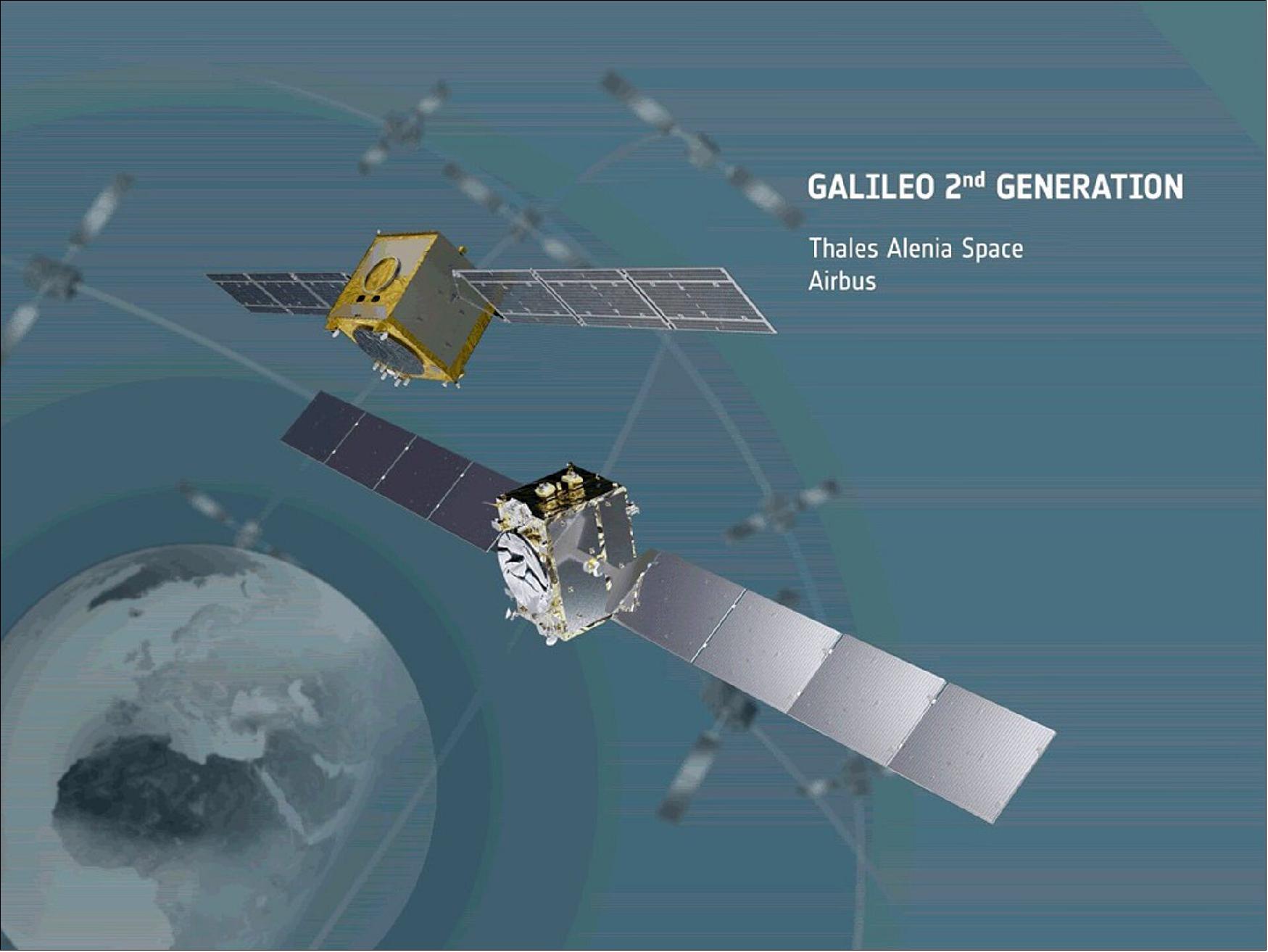
• January 20, 2021: Today the EC (European Commission) awarded two contracts for 12 Satellites (6 satellites each) for a total of EUR €1.47 billion, to Thales Alenia Space (Italy) and Airbus Defence & Space (Germany) following an open competition. 13)
- With this, the Commission is initiating the launch of the 2nd Generation of Galileo, the European satellite positioning system. The aim is to keep Galileo ahead of the technological curve compared to global competition and maintaining it as one of the best performing satellite positioning infrastructures in the world while strengthening it as a key asset for Europe's strategic autonomy.
- The first satellites of this second generation will be placed in orbit by the end of 2024. With their new capabilities relying on high innovative technologies (digitally configurable antennas, inter- satellites links, new atomic clocks technologies, use of full electric propulsion systems), these satellites will improve the accuracy of Galileo as well as the robustness and resilience of its signal, which will be key for the upcoming digital decade as well as more security & military usage.
Background
- With the Galileo satellite navigation system, Europe operates a state-of-the-art system in positioning, timing and navigation that is recognized worldwide as the most performant of this kind. In operation since 2016, Galileo provides signal services to 2 billion users around the globe. 26 satellites are currently in orbit, with 2 additional satellites due for launch in Q3 2021.
- In May 2018, the Commission launched the tender procedure to procure a first batch of 12 second-generation satellites through a competitive dialog, with the objective of signing two contracts (double source) of 6 satellites each. The tender procedure was run by the European Space Agency (ESA) by delegation. After 2 months of detailed technical and financial evaluation of the industrial offers, ESA recommended to the Commission to proceed with TAS (Thales Alenia Space) and Airbus Defence & Space that represent the best technical and financial offers. The three industrial bidders were notified yesterday.
• 2010: For the Galileo FOC development phase, OHB System of Bremen, Germany teamed with SSTL (Surrey Satellite Technology Ltd.), UK. Within this team, OHB-System is the prime contractor and is responsible for the development of the 22 spacecraft. SSTL is fully responsible for the satellite payloads. The system level activities will be led by OHB-System, making use of the experience gained by SSTL through its GIOVE-A activities. 14)
ESA is already procuring 4 satellites from Astrium through its IOV (In-Orbit Validation) program which brings the number of operational Galileo satellites now under contract to 18.
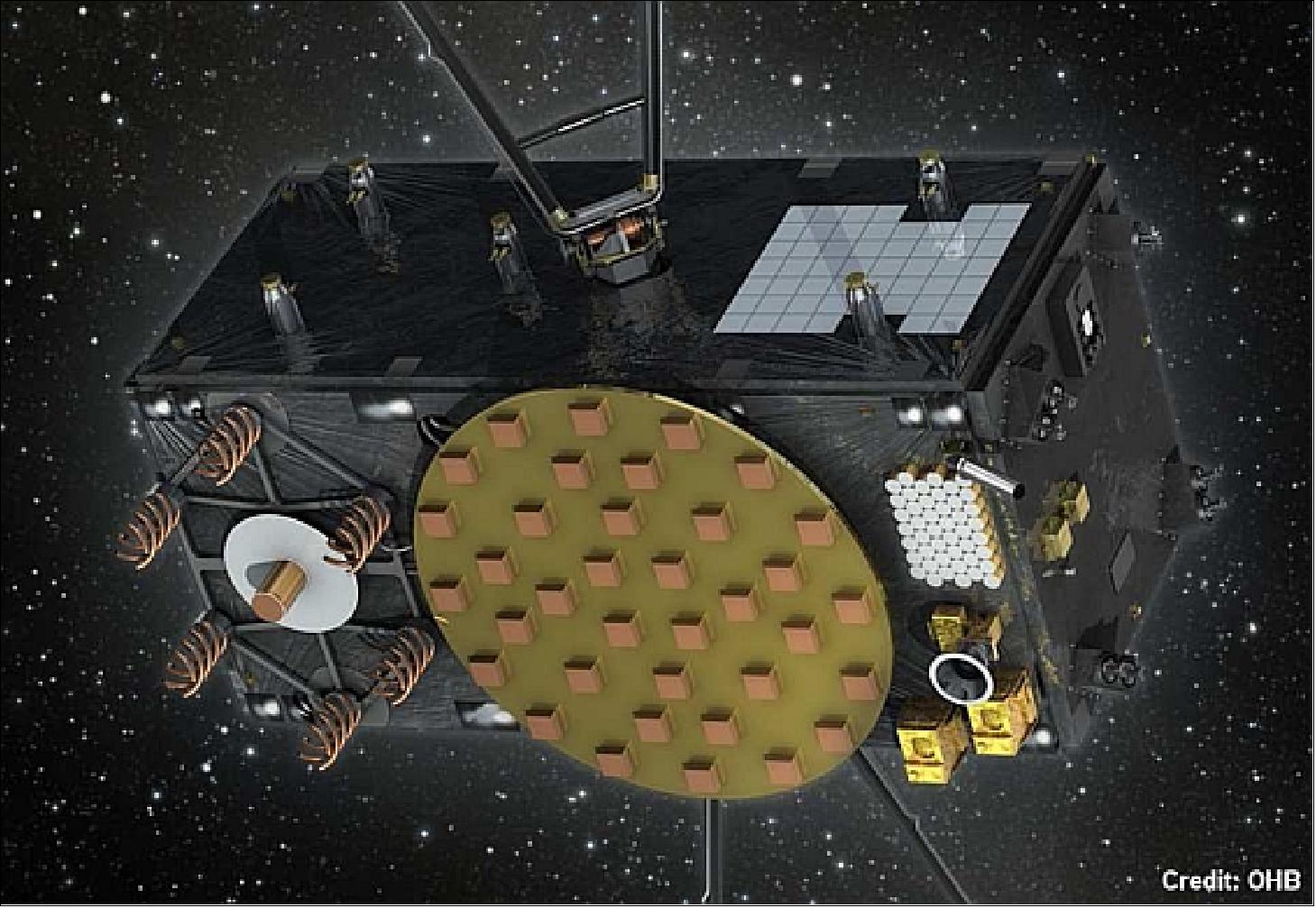
Spacecraft of the FOC Series
The production of the spacecraft series, with a delivery schedule of each pair of satellites in periods of 3 months, requires an assembly line production technique to meet the time table. This can only be achieved by implementing a modular satellite design.
The FOC satellites, 22 in total, provide the same operational services as their predecessors, but they are built by a new industrial team: OHB in Bremen, Germany build the satellites with Surrey Satellite Technology Ltd in Guildford, UK contributing the navigation payloads.
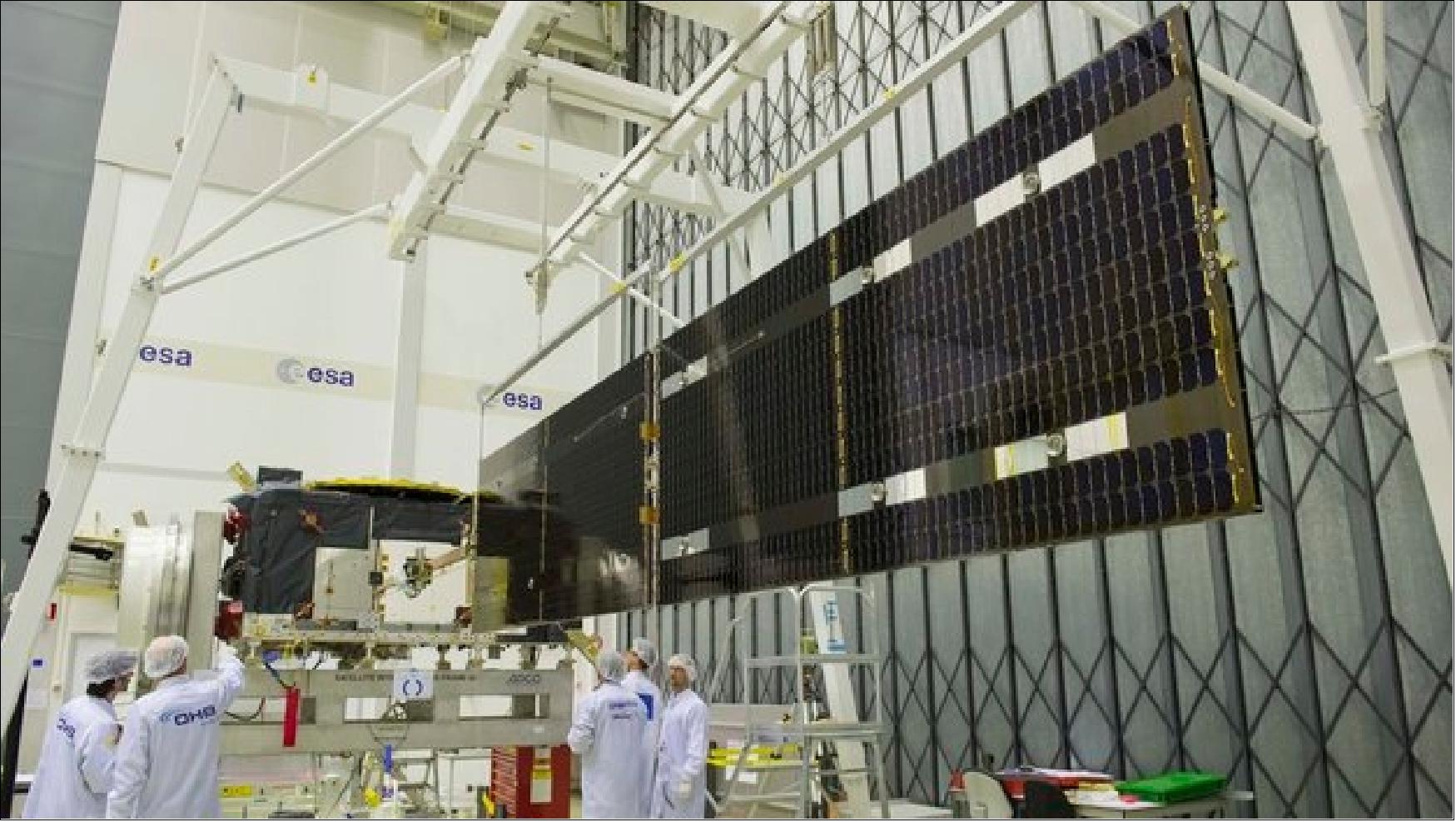
Legend to Figure 16: The navigation satellite's pair of 1 m x 5 m solar wings, carrying more than 2500 state-of-the-art gallium arsenide solar cells, will power the satellite during its 12 year working life. 15)
The design of the 22 Galileo FOC satellites is quite different with respect to that of their four Galileo IOV (In-orbit Verification) counterparts. For technical and cost reasons, only half of the units aboard were re-used from IOV. Part of the rationale are also more demanding requirements for FOC compared with IOV, e.g. an increased RF signal output power level, tougher radiation requirements, and harsher launch load requirements to name a few. Hence, qualification on subsystem and system level had to be done from scratch (Ref. 4).
Fulfilment of ESA's FOC satellite requirements was achieved through a simple and robust design, leading to a satellite of ~720 kg with a provided power production of 1.9 kW (end of life), which provides navigation signals in L1, E5, and E6 bands, as well as Search-and-Rescue services. The FOC satellite design is depicted in Figure 17.

A lot of OHB's development work went into optimizing the design for series production. It was identified that in order to meet the production cadence requirement of six weeks, parallelization of work on each satellite would have to be achieved. As this is very hard to achieve at late stages of integration and testing of a satellite, the focus was put in particular on the early stages of MAIT (Manufacturing, Assembly, Integration, and Testing).
The satellites are integrated in seven modules, depicted also in Figure 18:
• the propulsion module (integrated at the propulsion supplier, Moog Inc.)
• the solar generator module (integrated at the solar generator supplier)
• clock, antenna, and payload core module (integrated at SSTL, OHB's co-prime, responsible for the payload, located in Guildford, UK)
• the center and the platform core modules (integrated at OHB's premises in Bremen, Germany).
Work on these seven modules can be executed independently from each other and in parallel to each other. A good example for that is the propulsion module. While in most satellites, the propulsion system is distributed over the entire spacecraft, the modularity intended for Galileo FOC let OHB designers to mount all the propulsion-related systems on one panel, which can be integrated and replaced also late in the MAIT process (as depicted in Figure 17). The big access panel in the launch dispenser-facing side of the satellite increases the ease of access into the satellite, also at late stages of the assembly.
In the next step of integration after module integration, the seven modules form the platform and the payload (see Figure 2), which also can be treated independently from each other and in parallel to each other (payload at SSTL, platform at OHB). Final integration of payload and platform and system level tests are then also carried out at OHB. Subsequently, the integrated and tested satellites are shipped to ETS (European Test Services) in Noordwijk, The Netherlands, for the environmental test campaigns.
Development work was based on early availability of functional models of the board computers. These were used in subsystem breadboards to facilitate software development with hardware in the loop as early on as possible. Further development work was carried out in two thermal development models that focussed on the two thermally critical areas: firstly, the clock panel, where clock temperature stability was demonstrated, and secondly the area of the travelling wave tubes, where sufficient high dissipation on limited radiator area was validated.
On system level, a flat-sat engineering model was employed to check out inter-subsystem compatibility and interaction. A further payload-only engineering model was employed by SSTL at their premises for payload-level development work.
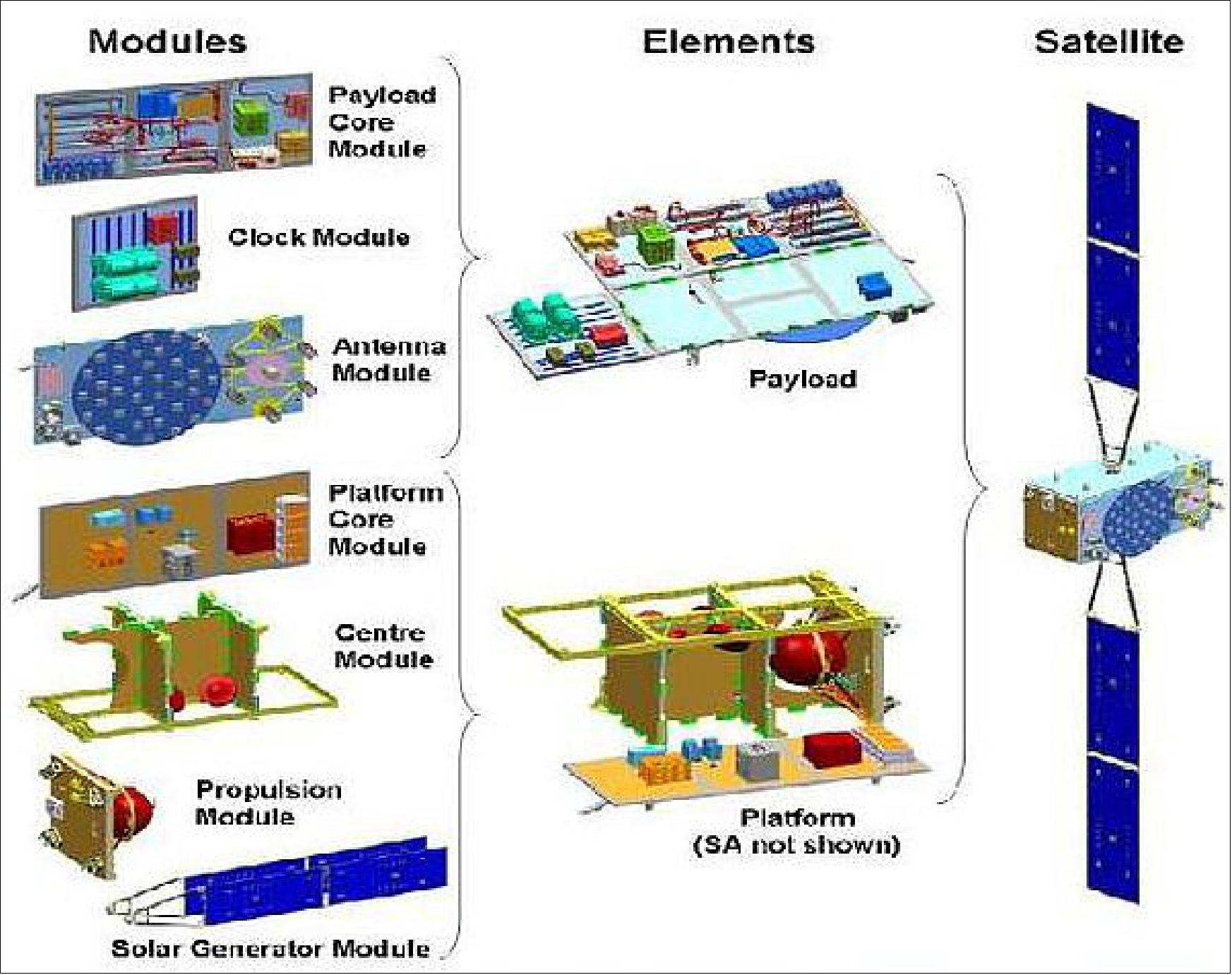
MAIT (Manufacturing, Assembly, Integration, and Testing): The MAIT approach picks up on the design of the satellite and focuses on the series production and the production cadence as well. The production is based on an island mode, while the check-out equipment and ground support equipment stays in place, it is the satellites that move from station to station. The activities that are executed at a given station are trimmed to give all stations more or less the same stay duration. After that duration, all satellites move forward one station. Primary goal is to keep the flow of satellites going, meaning to avoid "clogging" the production pipeline, as this would have impact on all previous islands, which cannot turn to the next satellite in line, whereas all succeeding islands or stations would "run dry". Hence margin for trouble shouting must be taken into account. For larger issues in the production pipeline, there is a so-called "recovery island" foreseen, which is equipped with all types of ground support equipment which can handle problems that take several days or even weeks to resolve while the rest of the pipeline continues normally.
Spacecraft launch mass | 730 kg (including 63 kg of fuel and 30 kg margin) |
Spacecraft body size, span | 2.5 m x 1.2 m x 1.1 m |
Spacecraft span | 14.67 m |
Overall size at launch | 2.91 m 1.70 mx 1.40 m |
Spacecraft design life | ≥12 years in space, ≥ 5 years ground storage |
Orbit | MEO, r=29800 km, inclination = 56º, 3 orbital planes with RAAN spacing of 120º, at EOL transfer to graveyard orbit |
Clock frequency stability | PHM (Passive Hydrogen Maser):<4.5 x 10-14 at 30000 s |
Navigation signal | 3 bands (E5, E6, L1) |
Design approach | Satellite consists of 7 modules, resulting in simple interfaces, enabling parallelized MAIT (Manufacturing, Assembly, Integration and Testing) |
Satellite reliability | 0.811/12 years (w/o SAR PL) |
Failure tolerance | - Full performance maintained after single failure |
Processor | TEMIC TSC695 32-bit RISC processor (radiation hardened) |
Satellite radiation hardness | MEO compliant |
Up- / Downlink |
|
Common Security Unit | Combines functions for payload and platform |
Power |
|
Structure | Aluminum sandwich panel design featuring 3 tillable panels and access panels allow late and easy access |
AOCS | 3-axis stabilized |
Propulsion | Slanted N2H4 monopropellant thrusters (2 x 4 nozzles with 1 N thrust each, fully redundant), blowdown pressurization |
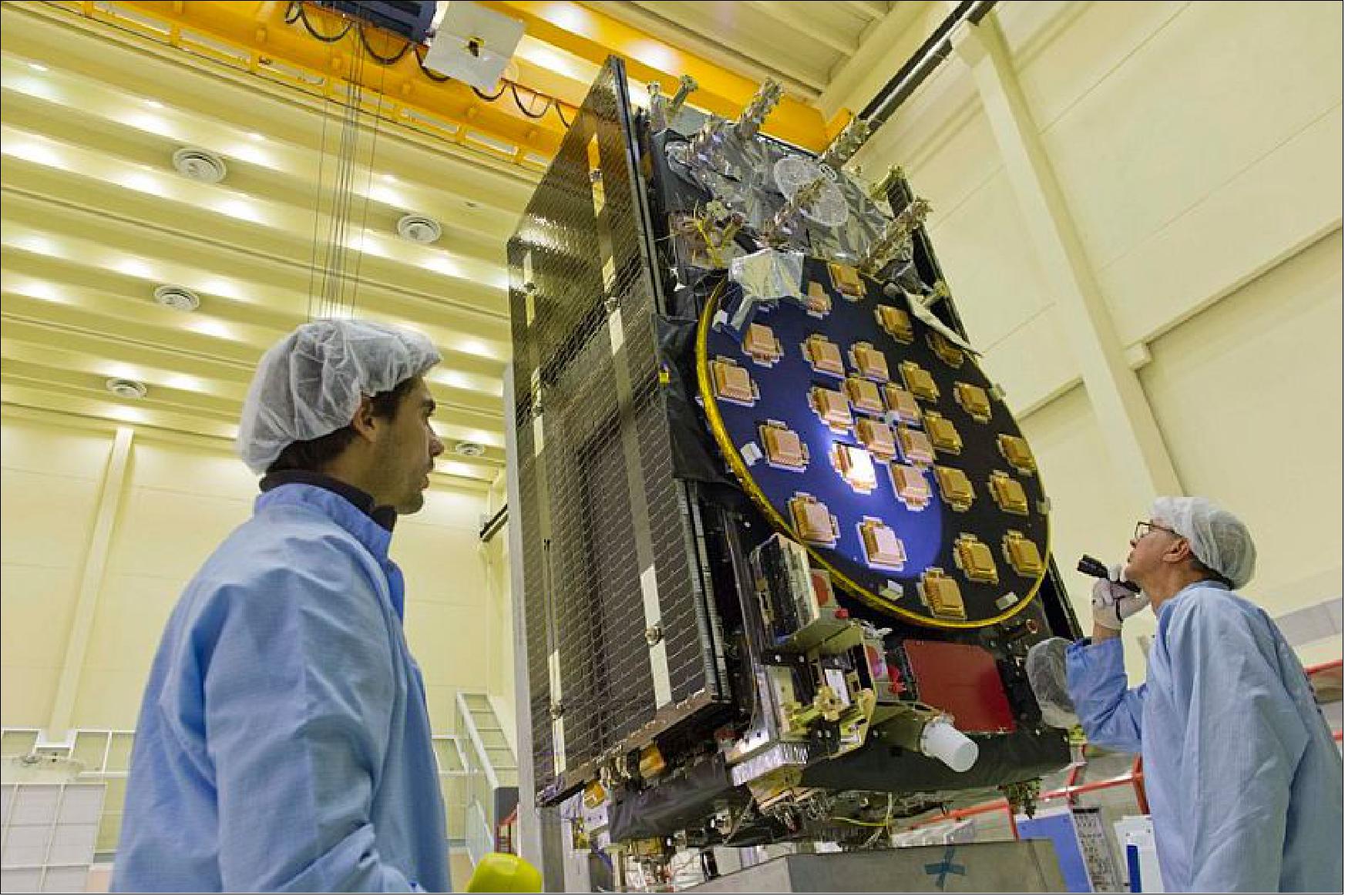
Nominal orbit of the Galileo constellation: The Galileo constellation is composed of a total of 30 MEO (Medium Earth Orbit) satellites, of which 6 are spares (Figure 1). Each satellite will broadcast precise time signals, ephemeris and other data. The Galileo satellite constellation has been optimized to the following nominal constellation specifications:
- Circular orbits (satellite altitude of 23,222 km), orbital inclination of 56°, three equally spaced orbital planes.
- Eight operational satellites, equally spaced in each plane, two spare satellite (also transmitting) in each plane.
Galileo Launches
• 20 October 2021: On 21 October 2011, the first pair of Galileo navigation satellites was launched by a Russian-built Soyuz rocket from Europe's Spaceport in French Guiana.
- The introduction of Russia's Soyuz 2 rocket to Europe's Spaceport was a milestone of strategic cooperation in the space transportation sector between Europe and the Russian Federation, and an exciting new opportunity for ESA.
- ESA's Ariane 5 rocket at the Spaceport met all requirements for launching large satellites, while ESA's Vega rocket – still under development at that time – would serve the small satellite market. It was found that the reliable Russian Soyuz would consolidate European access to space for medium-sized satellites, thereby complementing the ESA developed launch vehicles, Ariane 5 and Vega, increasing the flexibility of launch services from Europe's Spaceport.
- Russia's space program, meanwhile, would receive additional income through the launch of satellites and spacecraft from one of the world's most attractive and best-placed launch sites, Europe's Spaceport in French Guiana.
- Europe's Spaceport is located five degrees north of the equator enabling a wide range of missions launched eastwards to northwards. Rockets launched here benefit from the ‘slingshot effect', because of the speed of Earth's rotation when launched eastwards. This substantially improves the performance of the Soyuz rocket for launches from French Guiana compared to launches from the historic Baikonur Cosmodrome.
- In 2003, the ESA Ministerial Council in Paris approved the proposal to operate Soyuz from Europe's Spaceport. Seven Member States participated in the ESA program (Austria, Belgium, France, Germany, Italy, Spain, Switzerland), with further contributions from the European Union and Arianespace . This would cover both construction of the launch complex as well the adaptation of the Soyuz vehicle to enable it to operate from French Guiana.
- In February 2007, construction of a launch site for Soyuz some 13 km northwest of the Ariane launch complexes started at Europe's Spaceport. Russian staff arrived in French Guiana in mid-2008 to assemble the launch table, mobile gantry, fuelling systems and test benches.
- Most of the Soyuz launcher-dedicated installations were like those of Baikonur and minimal modifications had to be made to the Kourou versions of the vehicle, Soyuz-STA and Soyuz-STB, to preserve the overall coherence within Europe's Spaceport, conform to the safety regulations in force and to deal with environmental conditions.
- The main change made by Europe's Spaceport to the operational procedures developed in Baikonur was the integration process, with the introduction of a mobile gantry protecting the rocket from the weather in the lead up to launch and enabling vertical integration of the upper composite.
- The launch vehicle components for this inaugural flight were transported from St Petersburg to French Guiana by ship in November 2009 for the first simulated launch campaign in April and May 2011.
- The construction of the Soyuz launch site was officially completed on 7 May 2011 and Europe's Spaceport was ready for the first Soyuz liftoff from French Guiana.
- On 21 October 2011, Soyuz made its inaugural, three-hour 49-minute flight, successfully deploying two Galileo satellites and starting a new era of launch capability at Europe's Spaceport.
- To date there have been 25 Soyuz launches from Europe's Spaceport. Notable missions include ESA science, Earth observation and navigation satellites such as Gaia, Cheops, Sentinel-1 and Galileo satellites.
- The next Soyuz mission from Europe's Spaceport is planned for November and will carry the latest pair of Galileo satellites to a 23,222 km altitude medium-Earth orbit. These satellites will add to the 26-satellite Galileo constellation already in orbit and delivering Initial Services around the globe.
Launch 1: On 21 October 2011, Soyuz made its inaugural, three-hour 49-minute flight, successfully deploying two Galileo satellites (IOV-PFM and IOV-FM2) and starting a new era of launch capability at Europe's Spaceport. A Soyuz-ST-B/Fregat-MT vehicle lifted off on Oct. 21, 2011 at 10:30 UTC. Flight name: VS-01. — The legendary Russian launch vehicle started its mission after two decades of planning and construction of a brand-new launch complex in South America.
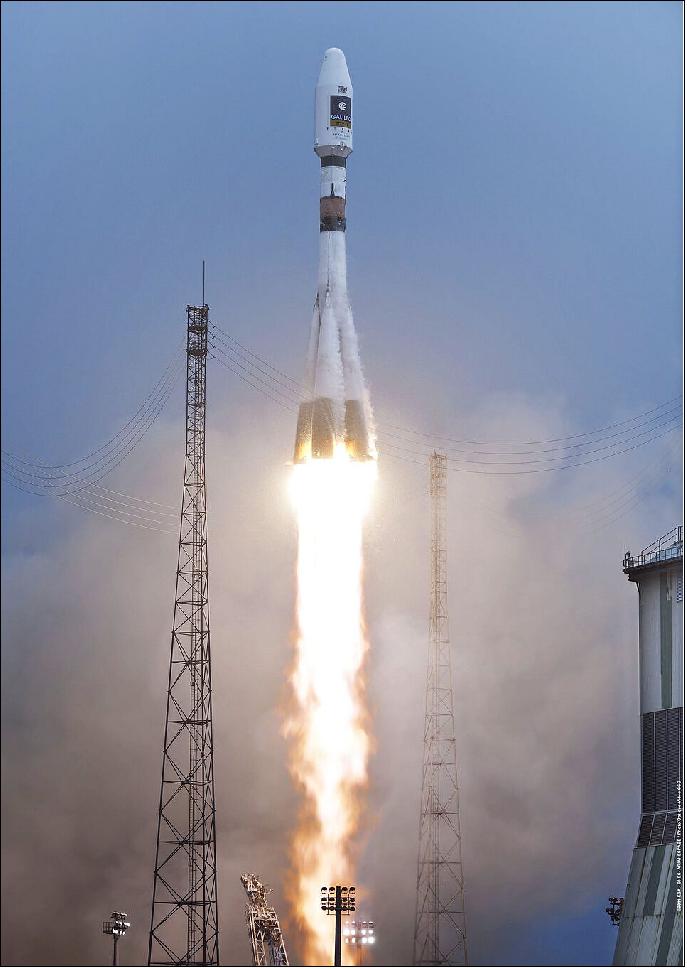
Launch 2: On 12 October 2012 at 18:15 UTC, Soyuz ST-B/Fregat-MT launched the Galileo satellites IOV-FM3 and IOV-FM4 from Kourou ELS. Flight name: VS-03.
Launch 3: On 22 August 2014 at 12:27 UTC, the first two Galileo FOC satellites,FOC- FM1 and FOC- FM2, were launched from Kourou on the Soyuz ST-B/Fregat-MT vehicle (flight name: VS-09), operated by Arianespace. 19)
Unfortunately, the orbit injection of the FOC spacecraft didn't occur as planned and the satellites did not reach their intended orbital position.
The liftoff and first part of the mission proceeded nominally, leading to the release of the satellites according to the planned timetable, and reception of signals from the satellites. It was only a certain time after the separation of the satellites that the ongoing analysis of the data provided by the telemetry stations, operated by ESA and the French space agency, CNES, showed that the satellites were not in the expected orbit.
The targeted orbit was circular, inclined at 56º with a semi major axis of 29,900 km. The satellites are now in an elliptical orbit, with an eccentricity of 0.23, a semi major axis of 26,200 km and inclined at 49.8º.
According to the initial analyses, an anomaly is thought to have occurred during the flight phase involving the Fregat upper stage, causing the satellites to be injected into a noncompliant orbit.

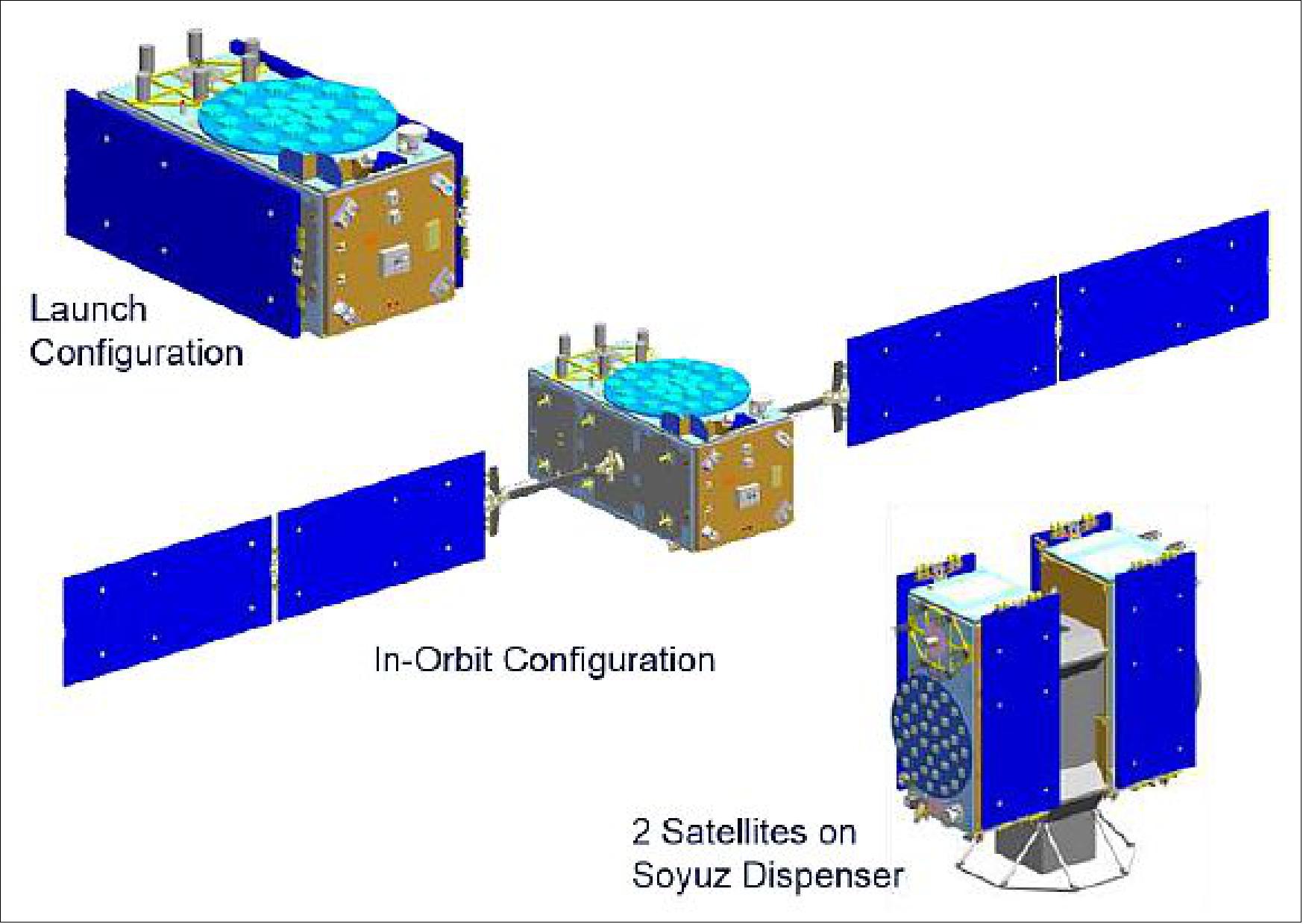
Launch 4: The seventh and eighth Galileo satellites (FOC-3 and FOC-4) were successfully launched together on 27 March 2015 (21:46 UTC) atop a Soyuz-STB/Fregat-MT vehicle (Flight name: VS-11) from Europe's Spaceport (Kourou, ELS) in French Guiana. 21) 22)
All the Soyuz stages performed as planned, with the Fregat upper stage releasing the satellites into their target orbit close to 23, 500 km altitude, around 3 hours 48 minutes after liftoff. Shortly thereafter, the two satellites sent their first signals from orbit, which were received by the CNES control center in Toulouse. 23)
Following initial checks, run jointly by ESA and France's CNES space agency from the CNES Toulouse center, the two satellites will be handed over to the Galileo Control Center in Oberpfaffenhofen, Germany and the Galileo in-orbit testing facility in Redu, Belgium for testing before they are commissioned for operational service. This is expected in mid-year.
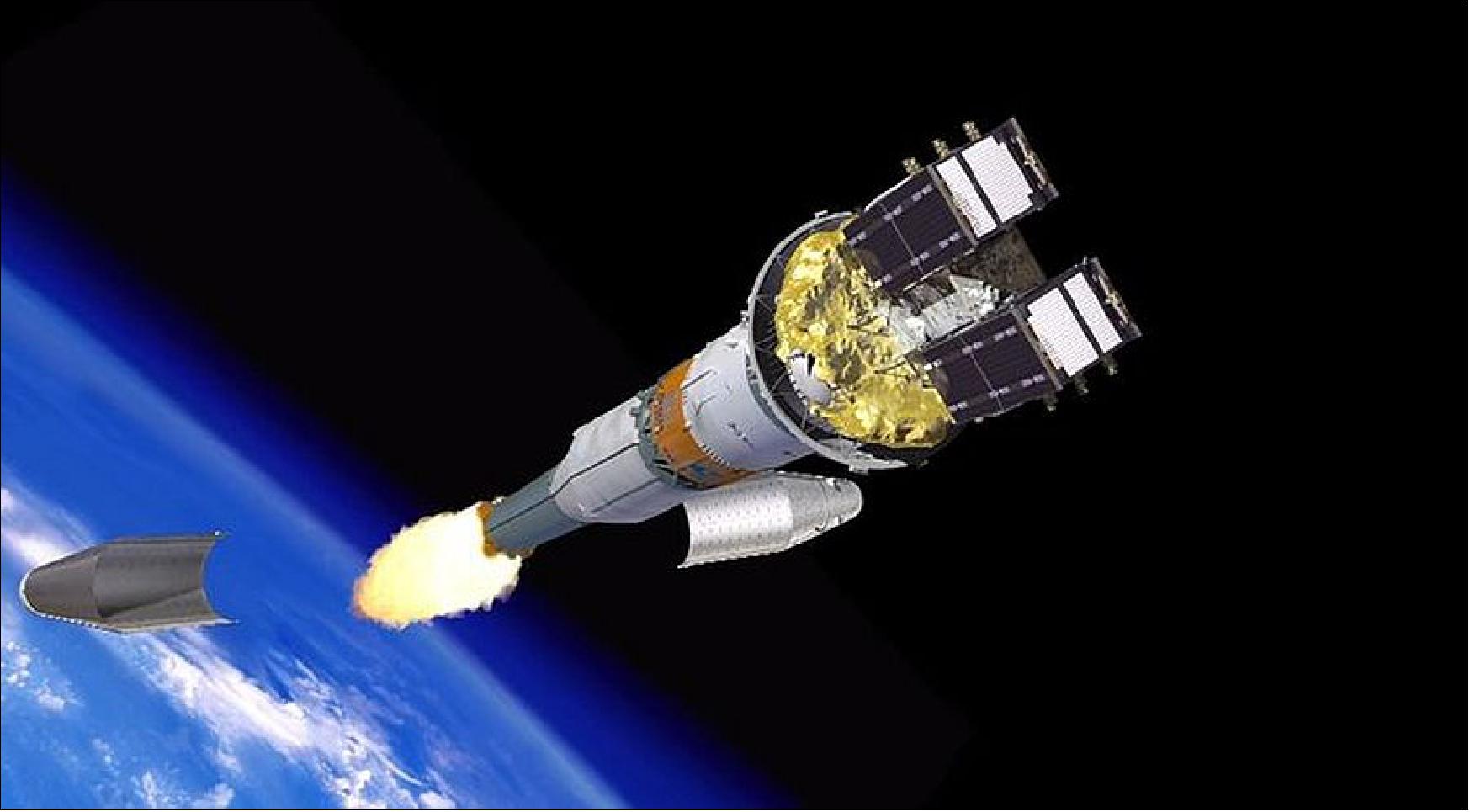
Launch 5: The Galileo-9 and -10 satellites (FOC-5 and FOC-6) were launched atop a Soyuz rocket at 02:08 GMT on 11 September 2015 at 02:08 UTC from Kourou ELS, Europe's Spaceport in French Guiana. Flight name: VS-12. 24) 25) 26)
All the Soyuz stages performed as planned, with the Fregat upper stage releasing the satellites into their target orbit close to 23,500 km altitude, around 3 hours and 48 minutes after liftoff. Shortly thereafter, they sent their first "sign of life" to ESOC (European Space Operation Center) in Darmstadt, Germany. Over the next few days, the two satellites will also be undergoing preliminary function testing.
Two further Galileo satellites are still scheduled for launch by end of 2015. These satellites have completed testing at ESA/ESTEC in Noordwijk, the Netherlands, with the next two satellites also undergoing their own test campaigns.
Next year the deployment of the Galileo system will be boosted by the entry into operation of a specially customized Ariane 5 launcher that can double, from two to four, the number of satellites that can be inserted into orbit with a single launch.
Launch 6: The Galileo-11 and -12 satellites (FOC-8 and FOC-9) were launched atop a Soyuz STB/Fregat-MT rocket on 17 December 17, 2015 at 11:51 UTC from Kourou ELS, Europe's Spaceport in French Guiana. Flight name: VS-13. 27)
Launch 7: The Galileo-13 and -14 satellites (FOC-10 and FOC-11) lifted off together at 08:48 GMT on 24 May 24 2016 atop a Soyuz/Fregat-MT rocket from French Guiana. Flight name: VS-15. The twin Galileo spacecraft were deployed into orbit close to 23,522 km altitude, at 3 hours and 48 minutes after liftoff. The coming days will see a careful sequence of orbital fine-tuning to bring them to their final working orbit, followed by a testing phase so that they can join the working constellation later this year. 28)
- "Today's launch brings Europe's Galileo constellation halfway to completion, in terms of numbers," remarked Paul Verhoef, ESA's Director of the Galileo Program and Navigation-related Activities. "It is also significant as Galileo's last flight by Soyuz this year before the first launch using a customized Ariane 5 to carry four rather than two satellites each time – which is set to occur this autumn."
- Known by their nicknames Danielè and Alizée, another two Galileo FOC satellites developed and built by OHB System AG, have been successfully launched on board a Soyuz launcher, which lifted off from the Kourou Space Center in French Guiana. 29)
Launch 8: On 17 November 2016 at 13:06 UTC, a quartet of Galileo satellites (FOC-7, FOC-12, FOC-13 and FOC-14), each with a mass between 715 kg and 717 kg, and a combined liftoff mass of 2,865 kg, was launched and deployed by Ariane 5 into a circular orbit during a mission lasting just under four hours. The Ariane 5 launch, designated Flight VA233 in Arianespace's numbering system, was from the Kourou Spaceport in French Guiana. 30) 31)
Flight VA233 marked Arianespace's first use of its heavy-lift Ariane 5 to loft Galileo satellites, following seven previous missions with the company's medium-lift Soyuz. The Soyuz vehicles carried a pair of Galileo spacecraft on each flight, delivering a total of 14 navigation satellites into orbit since 2011.
The Galileo satellites are at their target altitude, after a flawless release from the new dispenser designed to handle four satellites. Over the next few days, engineers will nudge the satellites into their final working orbits and begin tests to ensure they are ready to join the constellation. This is expected to take six months or so. This mission brings the Galileo system to 18 satellites.
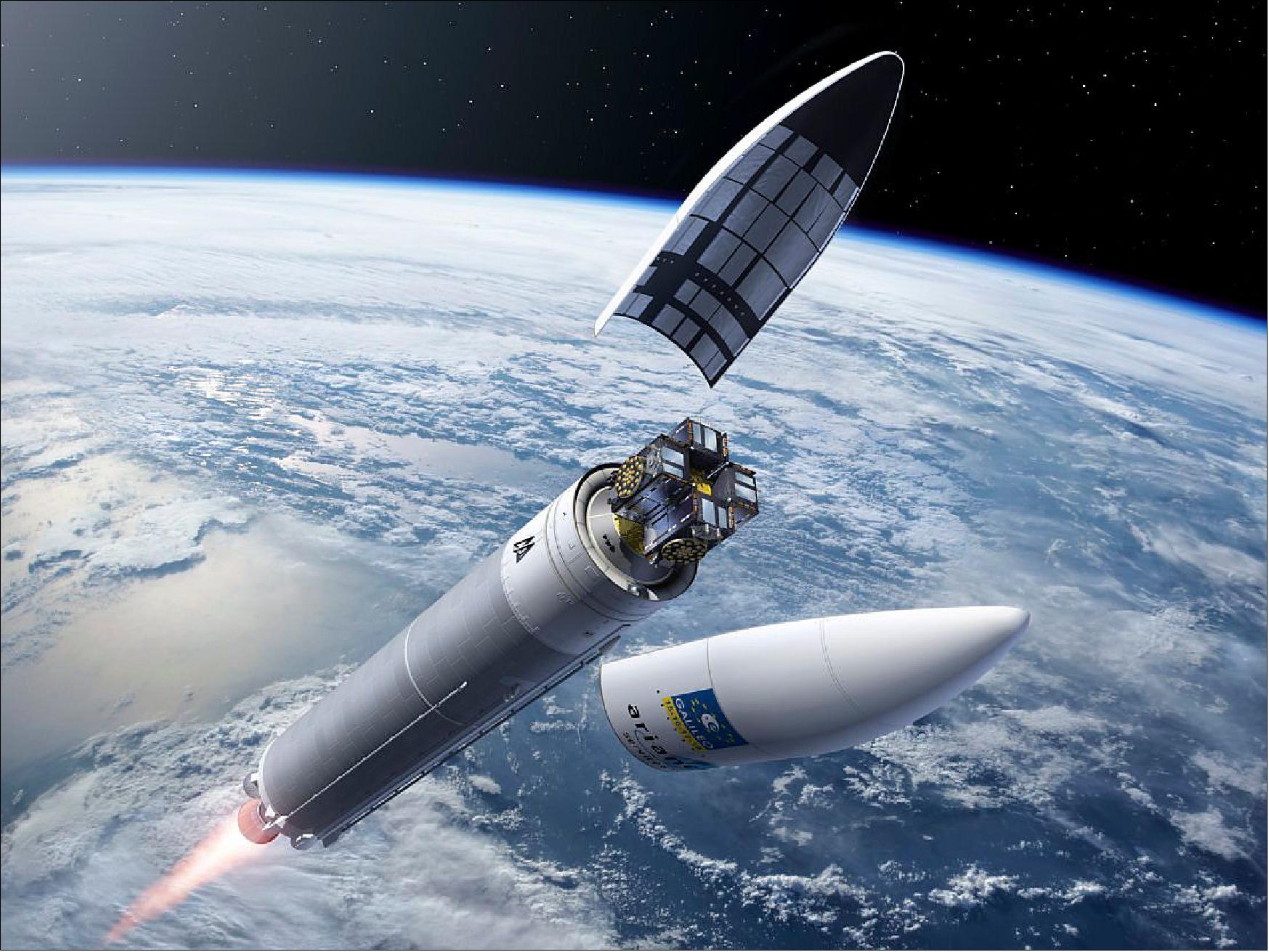
Launch 9 : On 12 December 2017, a quartet of Galileo satellites (FOC-15, FOC-16, FOC-17 and FOC18), each with a mass between 715 kg and 717 kg, were launched on Ariane-5 ES in Kourou at 18:36 UTC (flight name:VA-240). The first pair of satellites was released almost 3 hours 36 minutes after liftoff, while the second pair separated 20 minutes later. 33) 34)
- The satellites were released into their target 22,922 km altitude orbit by the dispenser atop the Ariane-5 upper stage. In the coming days, this quartet will be steered into their final working orbits. There, they will begin around six months of tests – performed by the European Global Navigation Satellite System Agency (GSA) – to check they are ready to join the working Galileo constellation.
- This mission brings the Galileo system to 22 satellites. Initial Services of the constellation began almost a year ago, on 15 December 2016.
- "Today's launch is another great achievement, taking us within one step of completing the constellation," remarked Jan Wörner, ESA's Director General. "It is a great achievement of our industrial partners OHB (DE) and SSTL (GB) for the satellites, as well as Thales Alenia Space (FR, IT) and Airbus Defense and Space (GB, FR) for the ground segment and all their subcontractors throughout Europe, that Europe now has a formidable global satellite navigation system with remarkable performance."
- Paul Verhoef, ESA's Director of Navigation, said: "ESA is the design agent, system engineer and procurement agent of Galileo on behalf of the European Commission. Galileo is now an operating reality, so, in July 2017, operational oversight of the system was passed to the GSA. Accordingly, GSA took control of these satellites as soon as they separated from their launcher, with ESA maintaining an advisory role. This productive partnership will continue with the next Galileo launch, by Ariane-5 in mid-2018."
- "Meanwhile, ESA is also working with the European Commission and GSA on dedicated research and development efforts and system design to begin the procurement of the Galileo Second Generation, along with other future navigation technologies."
- Next year's launch of another quartet will bring the 24-satellite Galileo constellation to the point of completion, plus two orbital spares.
Launch 10 : On 25 July 2018 at 11:25 UTC, a quartet of Galileo satellites (FOC-23, FOC-24, FOC-25 and FOC-26) was launched on an Ariane-5 ES vehicle (Flight VA244) of Arianespace from Kourou. The first pair of 715 kg satellites was released almost 3 hours 36 minutes after liftoff, while the second pair separated 20 minutes later. 35) 36)
They were released into their target 22,922 km-altitude orbit ( MEO, 56º inclination) by the dispenser atop the Ariane-5 upper stage. In the coming days, this quartet will be steered into their final working orbits by the French space agency CNES, under contract to the Galileo operator SpaceOpal for the European Global Navigation Satellite System Agency (GSA). There, they will begin around six months of tests by SpaceOpal to verify their operational readiness so they can join the working Galileo constellation.
In July 2017, ESA officially transferred the supervision of Galileo in-orbit operations to the European Global Navigation Satellite Systems Agency (GSA), on behalf of the European Union. After the VA-244 launch, the GSA will be responsible for operating the satellites as soon as they are separated from the launcher. These operations of setting up and operating the system will be done in collaboration with ESA.
The constellation will count 24 operational satellites plus in-orbit spares, of which 22 already have been put into orbit by Arianespace.
Launch 11: Europe's largest satellite constellation has grown even bigger, following the launch of two more Galileo navigation satellites by Soyuz launcher from Europe's Spaceport in French Guiana on 5 December 2021. Galileo satellites 27-28 add to an existing 26-satellite constellation in orbit, providing the world's most precise satnav positioning to more than 2.3 billion users around the globe. 37)
ESA Director of Navigation Paul Verhoef comments: "Today's liftoff marks the 11th Galileo launch of operational satellites in ten years: a decade of hard work by Europe's Galileo partners and European industry, over the course of which Galileo was first established as a working system then began Initial Services in 2016. With these satellites we are now increasing the robustness of the constellation so that a higher level of service guarantees can be provided."
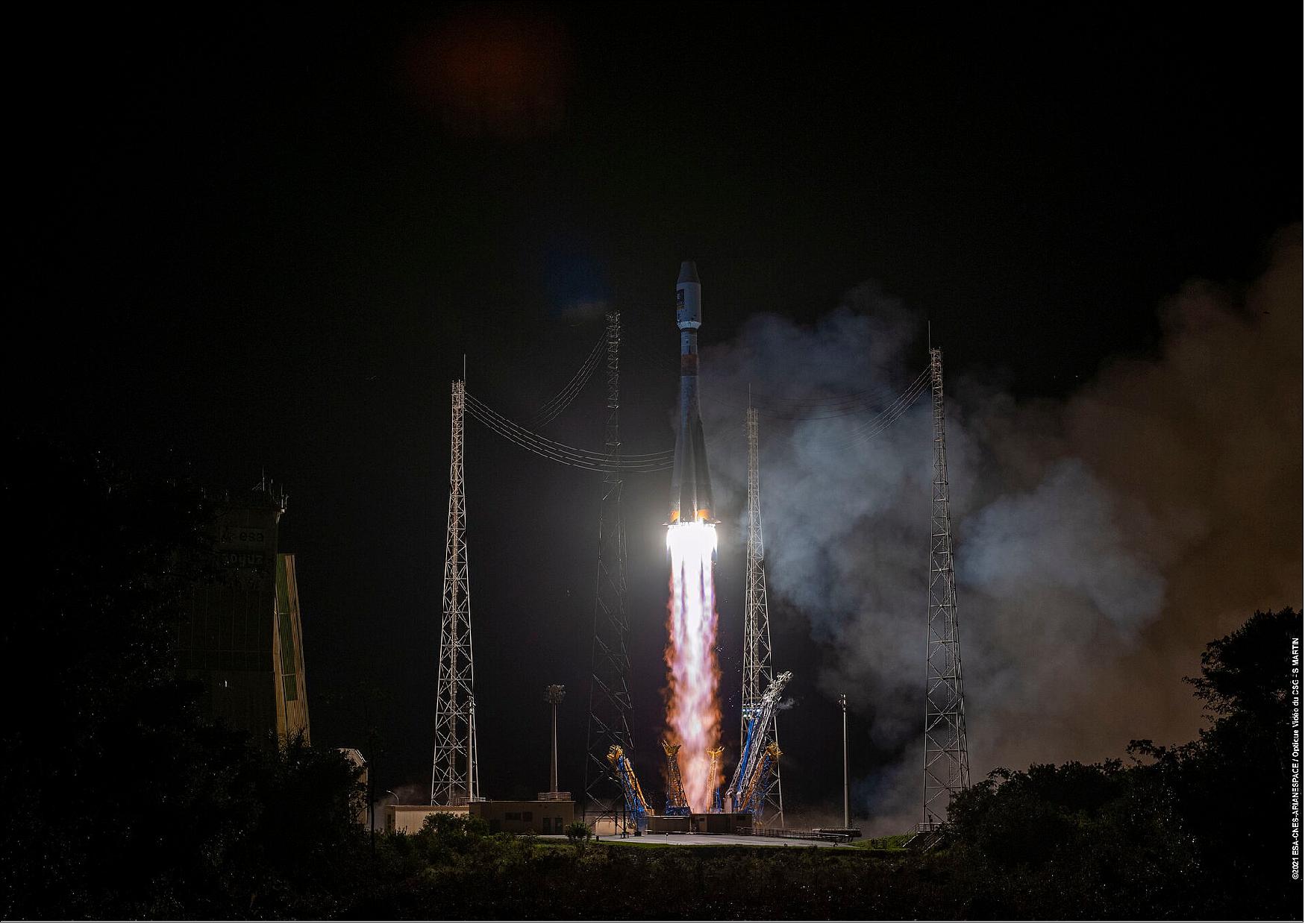
Soyuz launcher VS-26, operated by Arianespace and commissioned by ESA, lifted off with the pair of 715 kg satellites from French Guiana on 5 December at 01:19 CET (00:19 UTC, corresponding to 09:19 p.m. Kourou time on 4 December). All the Soyuz stages performed as planned, with the Fregat upper stage releasing the satellites into their target orbit close to 23,525 km altitude, around 3 hours and 54 minutes after liftoff.
"Congratulations Europe! With this 11th launch for Galileo, the constellation is now counting 28 satellites in orbit. Arianespace is proud to guarantee a secure and autonomous access to space with the deployment of Galileo, marking another step towards European independence in satellite navigation," said Stéphane Israël, CEO of Arianespace. "I would like to thank the European Union, especially the European Commission, as well as the European Space Agency, our direct customer for this launch, for continuing to trust us with their satellites." 38)
Mission Status
• May 17, 2022: The EU Agency for the Space Program celebrates its first anniversary with new services, a new satellite and even more end users. Time flies when you're busy getting things done. And in the first year of its existence, the EU Agency for the Space Program (EUSPA) of Prague has gotten a lot of things done. 39) 40)
- "EUSPA's launch one year ago today represented the start of a new era for the EU Space Program," says EUSPA Executive Director Rodrigo da Costa. "With an expanded mandate and new responsibilities, we are committed to helping the EU, its citizens and its businesses maximise the many social and economic benefits of space."
- "Today we celebrate EUSPA. It's also the opportunity to reflect and be proud of the milestones we achieved by working together. More users, more services, and satellites in space! Go Europe, go EUSPA!'' concludes EUSPA Administrative Board Chair, Vaclav Kobera.
- Building on the legacy of the European GNSS Agency (GSA), EUSPA's mandate includes not only overseeing the security, services and market uptake of Galileo and EGNOS, but also Copernicus, Europe's Earth Observation (EO) service - an area with significant commercial potential.
- According to the first ever EUSPA EO and GNSS Market Report, published earlier this year, SMEs and start-ups account for more than 93% of European Earth Observation companies. With revenues set to double from approximately EUR 2.8 billion to over EUR 5.5 billion within the next decade, the EO market is full of opportunities for EU businesses and entrepreneurs.
- To ensure companies take advantage of these opportunities, EUSPA has positioned itself as the go-to-source for all things related to Earth Observation. In addition to providing market intelligence, the Agency works directly with businesses to help them best leverage Copernicus data, information and services. EUSPA also launched several EO focused funding opportunities, including Horizon Calls and innovation competitions.
- But Copernicus doesn't exist in a vacuum. It also complements the other components of the EU Space Program, which is why EUSPA is constantly promoting the benefits of using Copernicus, Galileo and EGNOS together.
- "Galileo and EGNOS enable the determination of a precise position, anywhere and Copernicus provides information on the Earth's surface, atmosphere and oceans," adds da Costa. "When you put these programs together, you unleash an array of synergies that can have a powerful impact on society and the planet."
A New Pillar for the EU Space Program
- This list of space programs will soon add a new name. GOVSATCOM, the fourth pillar of the EU Space Program, is a user-centric program designed to meet the unique requirements of governmental applications, including those used for crisis management, surveillance and the management of key infrastructures.
- "While Copernicus and EGNOS provide the necessary data and positioning, European governments and institutions need a means of communication that is robustly protected against interference, interception, intrusion and other risks" explains da Costa. "Once operational, GOVSATCOM will bridge this gap between the need for assured and secure communication and the capabilities offered by Copernicus, Galileo and EGNOS."
- As part of its expanded mandate, EUSPA has been entrusted with the procurement of the secure ground segment, its operations and the coordination of the user-related aspects of GOVSATCOM.
The Mission Remains the Same
- EUSPA's first year also saw the development of new services and the launch of new satellites. As to the former, the Agency has been busy developing two new Galileo services: a High Accuracy Service (HAS) for high accuracy Precise Point Positioning (PPP) corrections and the Open Service Navigation Message Authentication (OSNMA), which will provide receivers with a first level of protection against falsifying and spoofing.
- The entry into service of a new additional satellite, GSAT 2203, has brought enhanced accuracy and more precise positioning to the Galileo service provision.
- But even with its expanded mandate and new responsibilities, EUSPA's mission remains the same: linking space to user needs. "I am extremely proud of everything EUSPA has achieved in a year, which is the direct result of our dedicated professionals, all of whom embrace a service-oriented mindset and are passionate about making space technology accessible to EU citizens and businesses," concludes da Costa.
- "It is an honour to serve as Chair of the Security Accreditation Board (SAB), the independent authority that provides accreditation to all of the EU Space Program's components. Thanks to SAB, EUSPA is at the front lines of cybersecurity, providing end-users with the confidence of knowing that the space-derived data they depend on is safe and secure," adds Bruno Vermeire.
• February 2, 2022: A small forest of antennas sprouts from the roof of ESA's Navigation Laboratory, based at the ESTEC technical centre in the Netherlands, which is among the most frequently satnav-fixed locations on Earth. This is also the site of the very first Galileo positioning fix, acquired back in 2014 using the first quartet of Galileo satellites. 41)
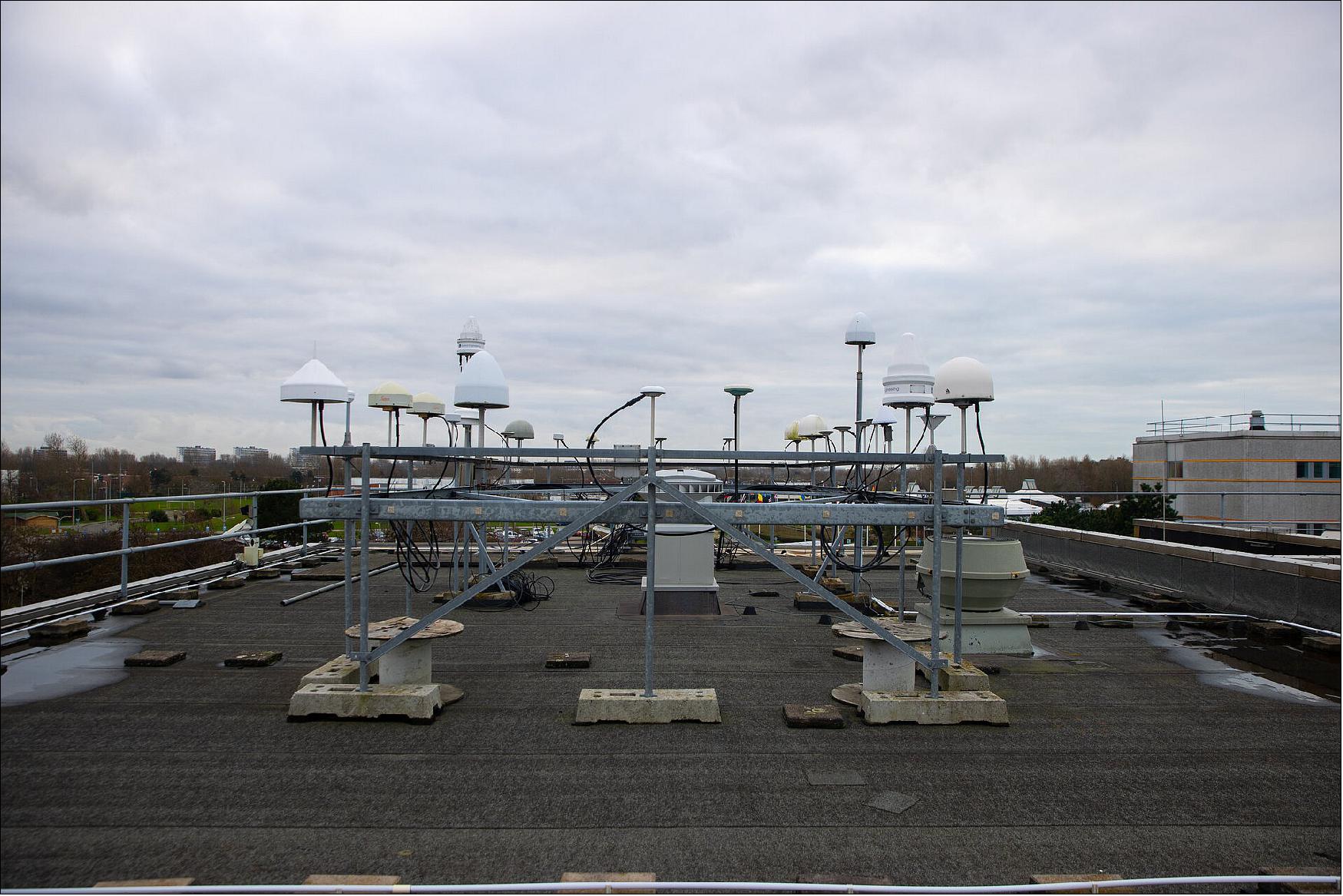
- "The antenna is a critical component of any Global Navigation Satellite System user segment, capturing power from the electromagnetic waves it receives, then converting it into electrical current to be processed by the rest of the receiver chain," explains Radio Navigation Engineer Michelangelo Albertazzi.
- "Up here we have a variety of antenna designs in place – such as omnidirectional, high gain and arrays – from leading world receiver manufacturers, which acquire signals from all major global GNSS constellations, including Galileo, GPS, the Russian Glonass and China's Beidou, as well as regional systems such as Europe's EGNOS."
- The NavLab is also equipped with state-of-the-art equipment to record, replay and analyze the RF signals picked up by these antennas, to help with its main goal of performing tests, analyses and characterisation of navigation systems for both ESA and external customers.
• January 3, 2022: A GSTP (General Support Technology Program ) activity with Syntony, France, has taken an existing product used to help signals from satellites reach underground and developed and improved it for navigation purposes. 42)
- The product, called SubWave, is for underground geolocation where GNSS signals from satellites cannot be received. It allows the reception of navigation signals with the normal user's smart phones underground, for example in metro or road tunnels. But there is currently a drawback, which can lead to significant errors in the position being shown.
- The improved system, called SubWave+, has significantly reduced these errors, developing this system into a marketable product. SubWave+ is a dramatic improvement in the system as it brings the accuracy from 10m down to few meters.
- It extends the location service to cover metro or subway stations and their tunnels, compared to the first release of the product, at an affordable price. Using SubWave+ in a tunnel offers a cost reduction compared to the installation of SubWave, since it doesn't require the system to have to split the area into many zones.
- This technological step is designed to be compliant with any GNSS receivers and enable a seamless transition between indoor and outdoor. The developed product is currently being actively sold to world wide customers. Further refinement in the engineering work for the recurrent production is performed by Syntony.
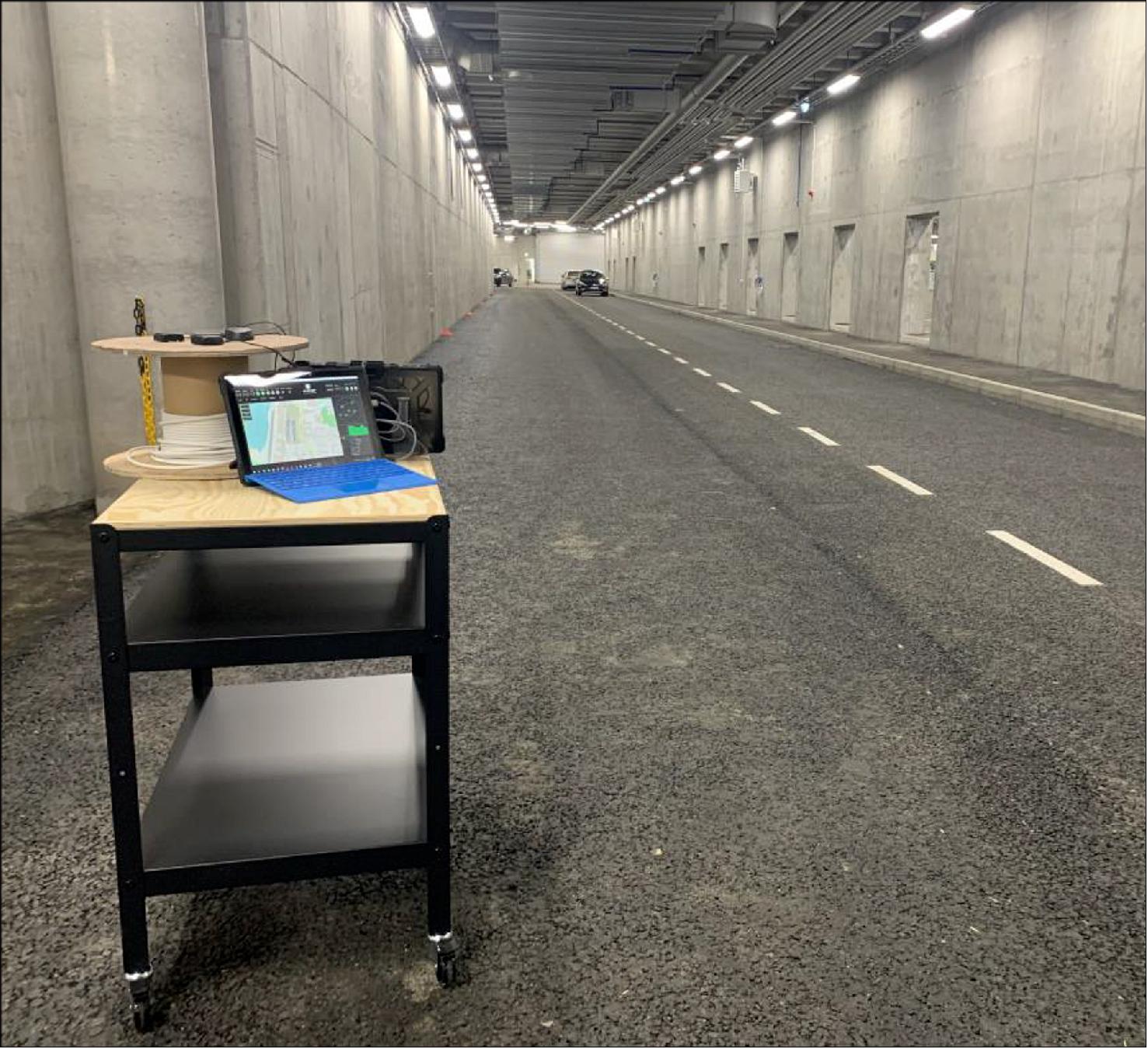
• November 24, 2021: Surrey Satellite Technology Ltd (SSTL) has successfully de-commissioned GIOVE-A, the pathfinder satellite for Europe's Galileo constellation, after 16 years of operations in Medium Earth Orbit (MEO). The decision to de-commission the satellite was made due to the obsolescence in computing systems required for the operation of GIOVE-A, and de-commissioning of the spacecraft took place on 24 November 2021. The procedure involved transitioning the satellite to Earth pointing mode , turning off the reaction wheels and setting the attitude and orbit control system to standby mode, before finally switching off the on board computer and transmitter. 43)
- GIOVE-A was designed, built and tested by SSTL in only 30 months for the European Space Agency (ESA) and was launched on 28 December 2005 with a mission to secure vital frequency filings, generate the first Galileo navigation signals in space, characterise a prototype rubidium atomic clock, and model the radiation environment of MEO for future Galileo spacecraft. GIOVE-A was the first European satellite launched into the demanding MEO radiation environment, where it greatly out-performed its 27 month design lifetime.
- Sir Martin Sweeting, SSTL's Executive Chairman, summed up GIOVE-A's achievements by commenting "GIOVE-A was a milestone mission for SSTL that demonstrated how our pragmatic approach and innovative, low cost, small satellites could deliver critical mission requirements for landmark space programmes, such as Galileo. GIOVE-A secured the vital frequency filings with the International Telecommunications Union (ITU) on the 12th January 2006 and completed its original mission for ESA in 2008. GIOVE-A also over-delivered on its original lifetime and mission goals, and hosted experimental SSTL hardware which provided additional valuable data about the MEO environment for more than ten years – an inspiring and game-changing mission on so many levels."
- "If not for GIOVE-A the 26 Galileo satellites in orbit today would not exist," comments Paul Verhoef, Director of ESA's Directorate of Navigation. "Its speedy development and launch opened the way for our working constellation to follow."
- After completion of its mission for ESA, GIOVE-A was manoeuvred into a higher "graveyard" orbit at 23,300km above the Earth to make way for the first fully operational capability Galileo satellites. In 2012 SSTL took over operations from ESA and GIOVE-A continued to provide valuable in-orbit data on the MEO environment. The Merlin radiation monitor on-board GIOVE-A collected a unique 10+ year record for the MEO orbit and data analysis at the Surrey Space Centre, supported by ESA, showed some interesting features such as the "electron desert" in 2008/9 during what was the lowest solar minimum of the space era, and one of the largest electron storm events on record in April 2010. Several scientific journal papers have been published from the radiation data generated by GIOVE-A and a new model of the outer Van Allen belt electron fluxes, ‘MOBE-DIC', has been produced to help improve future satellite designs.
- Monitoring of the rubidium clocks on board GIOVE-A, key data for the Galileo constellation that followed, revealed no issues during the 6.5 years that the navigation payload was operational.
- Also onboard GIOVE-A was an experimental SSTL GPS receiver, the SGR-GEO, which in 2012 achieved a GPS position fix at 23,300 km altitude - the first position fix above the GPS constellation on a civilian satellite. This demonstrated a new timing and orbital positioning solution for satellites operating in orbits higher than 20,000 km which can only receive a few of the weaker GPS signals that "spill over" from the far side of the Earth.
- The SGR-GEO was subsequently used to track many signals from GPS satellites, including the sidelobes not normally visible to ground-based systems. The performance of GNSS receivers at high altitudes is very sensitive to sidelobe strength, and data from the SGR-GEO helped to map out the antenna patterns of GPS satellites for use in planning navigation systems for future high altitude missions in geostationary orbit , lunar orbit, and beyond into deep space.
- In 2010 SSTL was awarded a contract to assemble, integrate and test the first navigation payloads for the full operational capability Galileo spacecraft, and over a period of 10 years SSTL supplied a total of 34 navigation payloads for Galileo, Europe's global navigation positioning constellation.
- GIOVE-A carries an engraved plaque in tribute to SSTL engineer, Tom Fairburn, who tragically lost his life in the 2004 Indian Ocean Boxing Day Tsunami. Tom worked as a payload mechanical engineer on GIOVE-A and is warmly remembered by colleagues at SSTL.
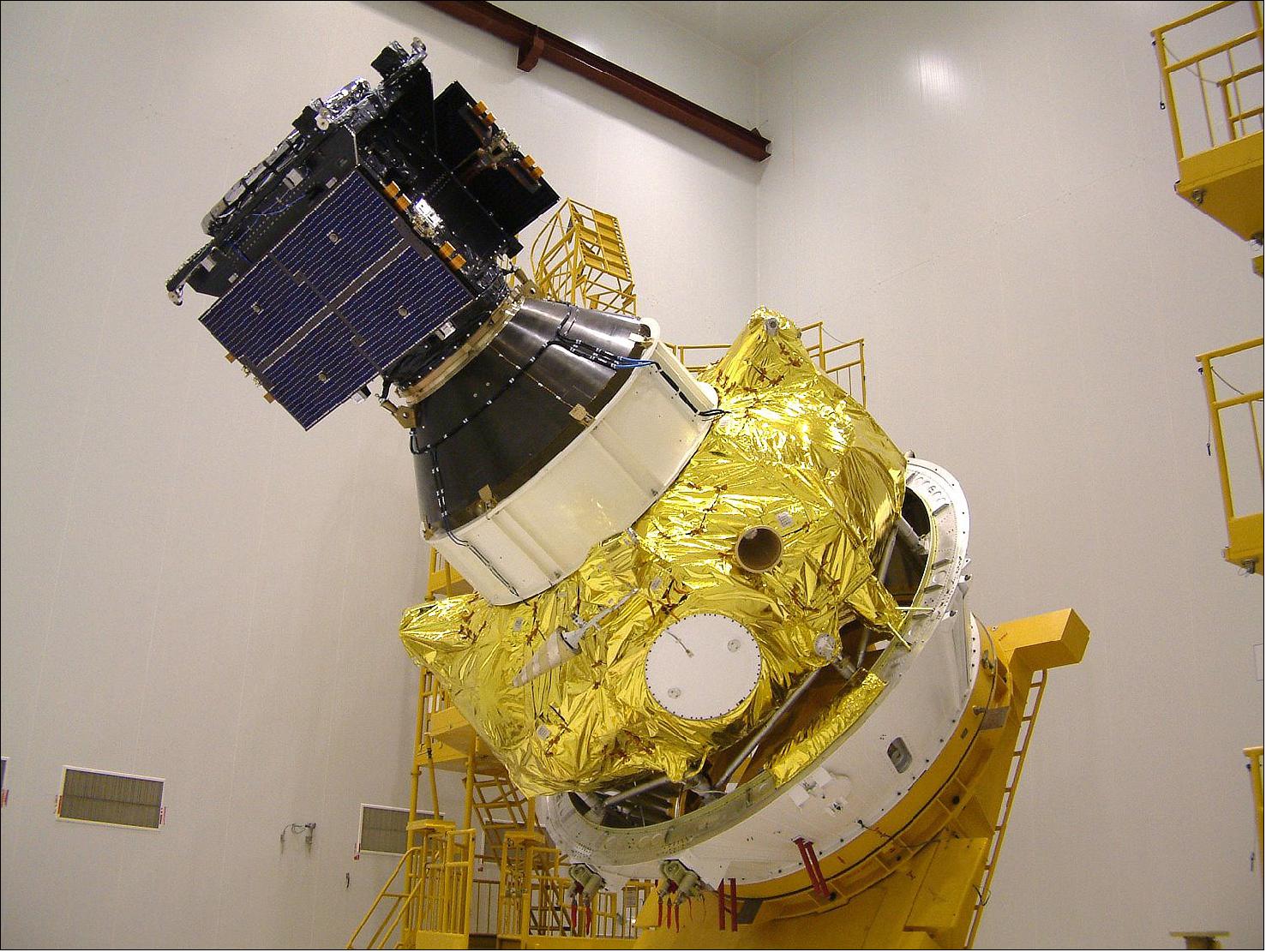
• September 8, 2021: An experimental satellite navigation receiver station high atop Spain's Mallorca island has opened up a novel view of the ever-changing face of the sea. By picking up satnav signals from the far horizon as they bounce off ocean waves, the receivers are able to measure sea surface height down to a scale of centimeters. 44)
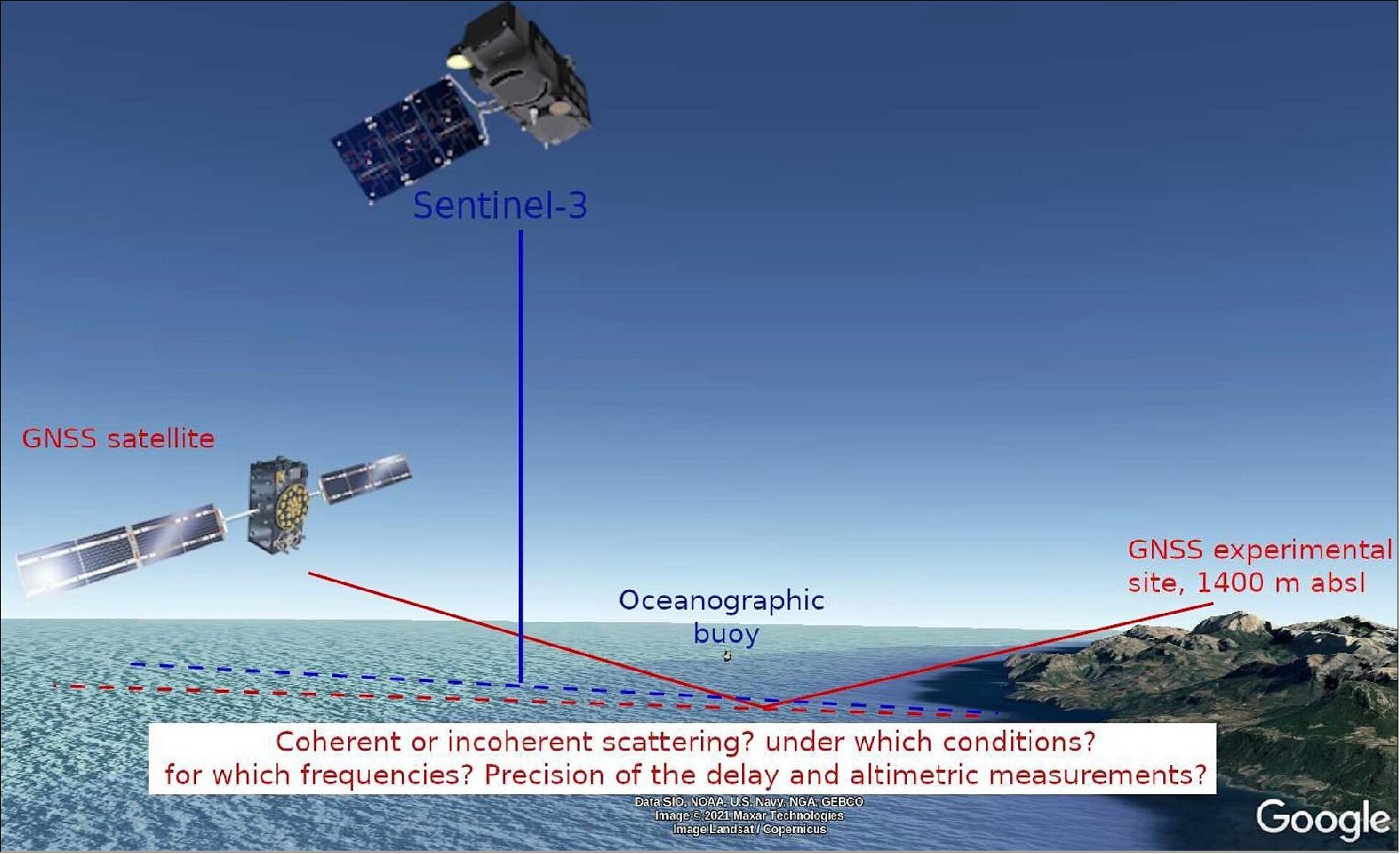
- "We set up a pair of satnav receivers in a near-horizontal orientation, 1400 m above sea level atop Mallorca's highest peak, 4 km from the coast," comments Estel Cardellach of the Institute for Space Studies of Catalonia.
- "Our aim was to receive signals from Galileo, GPS and other Global Navigation Satellite Systems (GNSS) in a way that isn't possible using standard commercial receivers. We pick up satnav signals that have reflected off the sea surface at very slanted, nearly horizontal geometries, then use these results to derive sea surface height and shape."
- "The basic idea behind GNSS ‘reflectometry' is not new," explains ESA microwave engineer Manuel Martín-Neira, who first devised the technique in the early 1990s.
- The concept grew out of the well-established practice of radar altimetry, where radar pulses get bounced down from satellites in orbit to measure the precise contours of Earth's surface. The Copernicus Sentinel-3 pair are the latest contributors to a global altimetry dataset that extends back three decades.
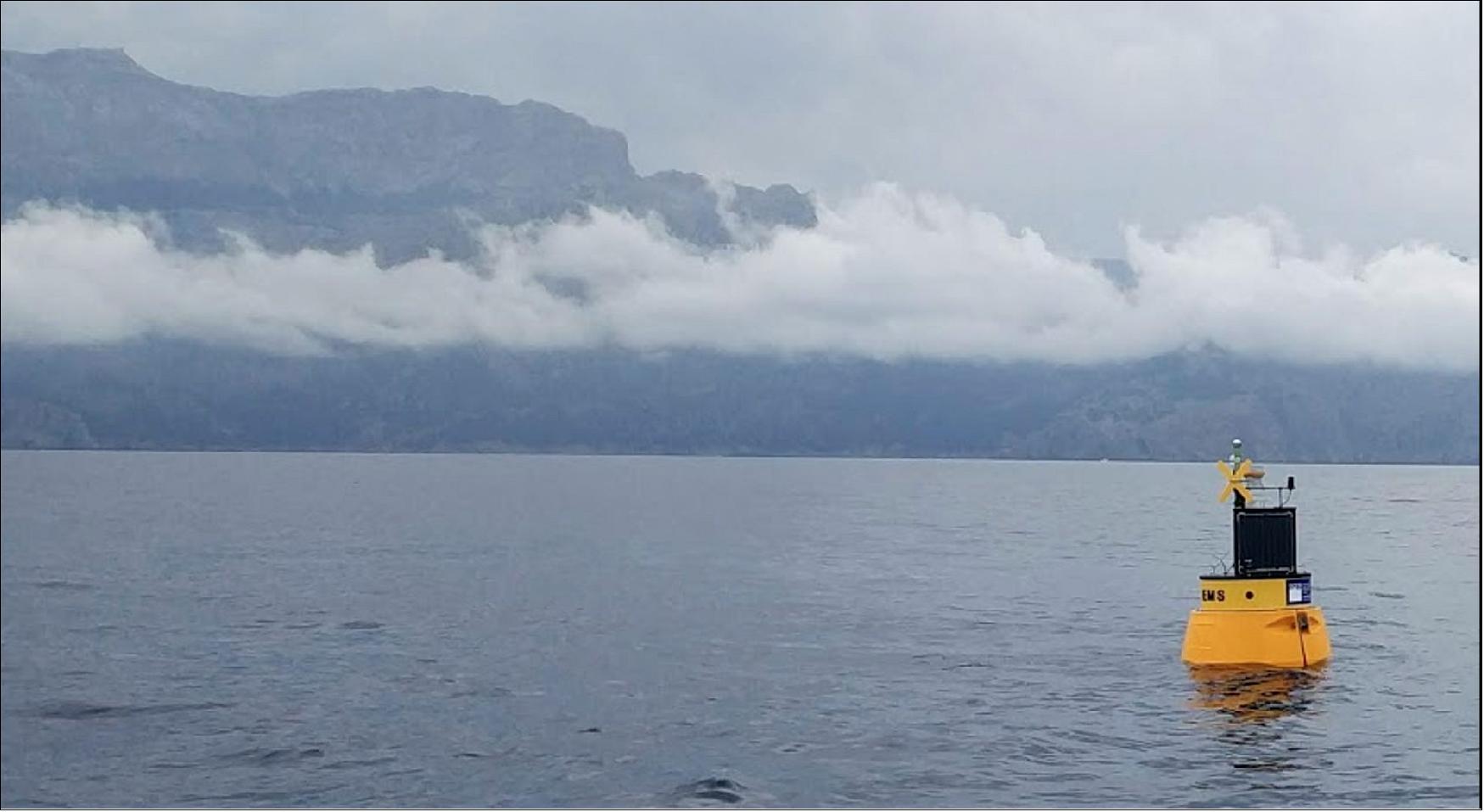
- Manuel had the idea that the satnav signals continuously raining down on Earth from multiple GNSS satellite constellations could be made use of in a comparable manner: comparing original and reflected satnav signals could yield altitude along with additional environmental information. Since then multiple space missions have proven the method.
- He notes: "Standard GNSS reflectometry works like radar altimetry, with orbital satellites receiving reflected signals from straight down, on a nearly vertical orientation. Instead this test campaign has employed a slant geometry, making use of shallow-angle reflected signals from GNSS satellites low on the far horizon.
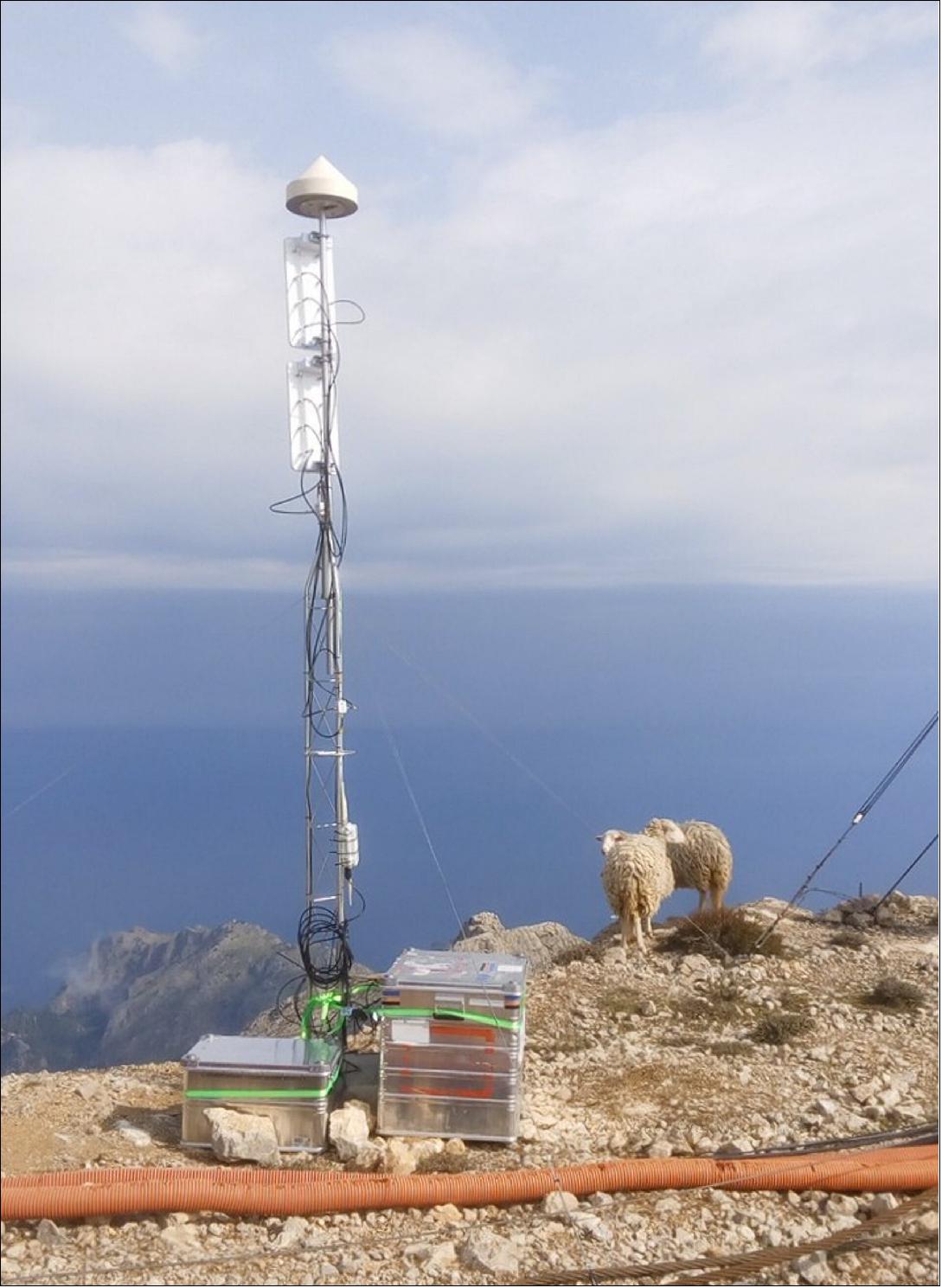
- "Why do this? Because while a vertical geometry gives a very rough sea surface, at shallow geometries the sea appears more like a mirror – think of the way Venetian blinds can seem variously open or closed depending on how you look at them. This surface smoothness means the reflected signals remain more coherent in turn, potentially allowing us to obtain much higher precision distance measurements."
- This approach is borrowed from a traditional satnav method to boost precision: instead of processing the pseudo-random codes embedded in satnav signals, so-called ‘carrier phase' processing utilizes the much higher-frequency satnav signals themselves, potentially increasing the resulting accuracy from a scale of several meters down to centimeters – although in practice atmospheric effects still need accounting for.
- Estel says: "Our test campaign was supported through ESA's Open Space Innovation Platform to help prepare for a new small reflectometry mission called PRETTY (Passive REflecTomeTry and dosimetry), which will use the same slant geometry in orbit. This miniature ESA CubeSat is being developed by RUAG in Austria and the University of Graz."
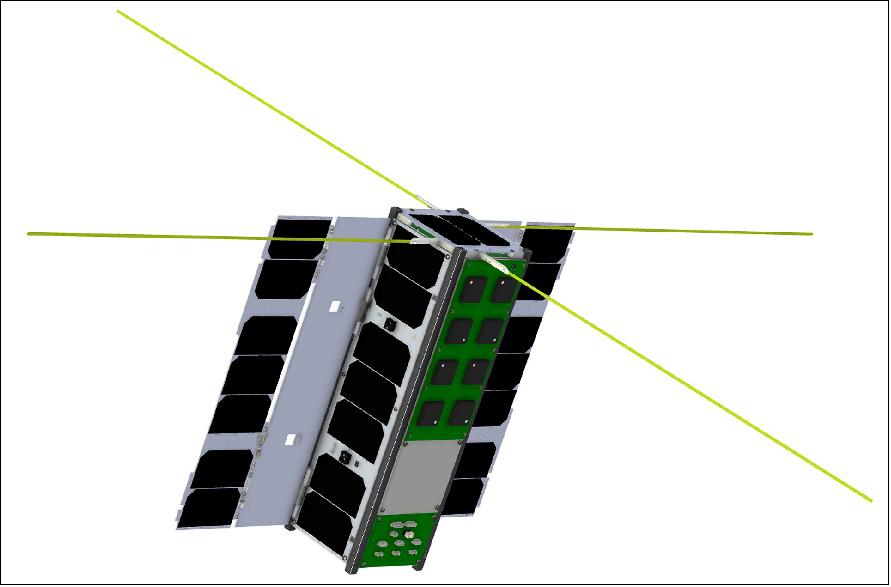
- Results from the reflectometry testing will be checked against Sentinel-3 altimetry data of the offshore test areas, along with an oceanographic buoy deployed specially to provide ‘ground-truth' results.
- The Institute for Space Studies of Catalonia's Institute of Space Science unit (IEEC/ICE-CSIC) led the campaign, with the Mediterranean Institute of Advanced Studies (IMEDEA-CSIC/UIB) and Balearic Islands Coastal Observing and Forecasting System (SOCIB) working on the buoy deployment, data recovery, archiving, dissemination and analysis. The German Aerospace Center's Institute for Solar-Terrestrial Physics (DLR-SO) is overseeing analysis of tropospheric and ionospheric interference.
- The receiver station was set up within the military zone of the 7th Aerial Surveillance Squadron of the Spanish Air Force, who also provided electrical power and logistical support.
- "Our test campaign is now over, having run from April to July," adds Estel. "The main reason we aren't observing for longer still is simply the sheer amount of raw data gathered by our receivers: 320 MB per second, adding up to more than a terabyte per hour. While our preliminary indications look promising, it is still going to take several months for us to properly process this gargantuan dataset."
- The testing has already had one significant outcome, explains Manuel: "The main goal of this campaign was to test out how to process data from the PRETTY mission. As we did so, using dual satnav frequencies, we realized the longer-wavelength L5 gives increased coherence compared to L1. So we have proposed switching the working frequency of the single-frequency PRETTY from L1 to L5. Such a change, subject to final technical approval, should greatly enhance the mission's performance."
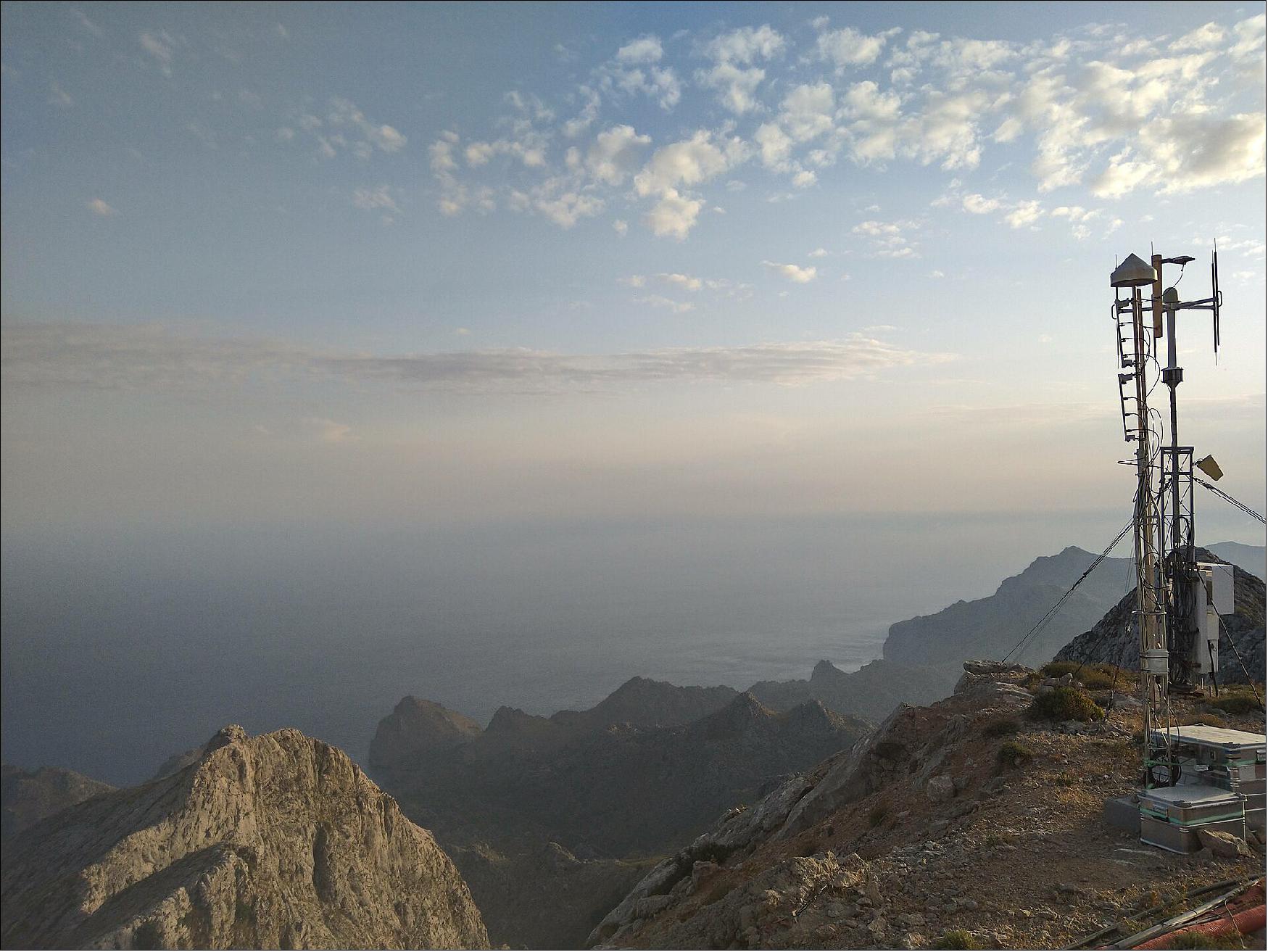
• June 24, 2021: Under the Advanced Shipborne Galileo Receiver Double Frequency (ASGARD) project the technology multinational GMV is collaborating with the defence and security company Saab, to develop a new civil, legislation-compliant, Galileo-signal-using maritime receiver. 45)
- Co-funded by EUSPA (former GSA), ASGARD aims to boost Galileo take up in maritime transport by developing shipborne e-GNSS (European GNSS) data-processing receivers. Ships operating under the International Convention for the Safety of Life at Sea (SOLAS) have to be fitted with a maritime GNSS receiver compliant to the international standards of the International Maritime Organization (IMO).
- GNSS technology is widely used both for ship navigation and positioning applications (traffic surveillance and management, search and rescue, control of fishery vessels, port operations or marine engineering). GNSS's higher capabilities in comparison with traditional maritime navigation methods have made it the preferred navigation resource in many maritime applications.
- In the transport sector as a whole a growing number of regulations enforce GNSS use. Maritime transport is no exception; it is now bound to fit a Positioning, Navigation and Timing (PNT) system that is interoperable in any part of the world. PNT systems are now an obligation in many maritime activities; countries are therefore bound to provide this service for the community and maritime traffic, as a navigation aid in keeping with international recommendations and regulations.
- Satellite navigation can therefore boost the efficiency, safety, and optimization of maritime transport. Galileo and EGNOS, the European Union satellite systems, are making priceless inputs here, with applications taking in all the following: port operations and navigation, localization of spills, improved control of maritime traffic, localization of catastrophes, maritime rescue, ship tracking, improved logistics, ship port approaches, automation, and more efficient port dredging.
- The development of shipborne multi-system radio-navigation receivers (MSR) is now taking a new approach, aiming to provide resilient PNT to improve safety and navigation efficiency. The MSR covers all the shipborne navigation systems and equipment that apply or provide PNT and associated integrity and state information. It calls for support of at least two independent radio-navigation systems; this offers a chance to encourage the use and take-up of e-GNSS (both Galileo and EGNOS) in maritime equipment.
- In this context GMV and Saab will be developing a double frequency multi-constellation maritime receiver navigation system (capable of receiving signals simultaneously from Galileo and other satellite positioning systems) complying with European and international legislation, with the unique ability to provide an additional layer of system safety using Galileo's Open Service-Network Message Authentication (OS-NMA).
- Galileo OS-NMA provides digital signatures of the Galileo Open Service Navigation Messages. It gives the mean for Galileo OS-MNA capable receivers to verify Galileo navigation data received is coming from a Galileo satellite and has not been falsified/spoofed. This verification method provides the Galileo constellation with strong protection, turning it into a more secure and solid GNSS.
- The new maritime receiver represents a new generation of GMV's Galileo receivers and will be integrated into a Saab navigation system in a format that is already well known by the maritime industry. The receiver will be tested according to the requirements of the European Maritime Equipment Directive for GNSS receivers.
- It will additionally be exposed to sophisticated spoofing tests, before being put through a shipborne field test campaign. In addition to coordinating the project GMV will also be responsible for the analysis and consolidation of ASGARD equipment requirements for maritime navigation and its design, implementation, and validation.
- "As with all ESA's main GNSS scientific test campaigns, ESA will archive this precious data at the GNSS Science Support Centre based at ESAC in Spain, a facility of ESA's Navigation Science Office," comments Javier Ventura-Traveset, Head of the Office. This will enable long-term dataset preservation in support of future GNSS reflectometry missions."
Open Space Innovation Platform: Opening ESA to New Ideas
- Leopold Summerer, heading ESA's Advanced Concepts and Studies Office adds: "This project is a good example of OSIP's core concept: that we receive good ideas from smart people outside ESA, then take rapid action. In this case the idea for the experiment was submitted last year, was quickly matured and judged excellent, then implemented in record time – in the service of one of our future missions."
• June 10, 2021: GMV has been awarded by the European Union Agency for the Space Program (EUSPA) with the contract for the implementation of the Galileo High Accuracy Data Generator (HADG), which will be the facility in charge of generating the high-accuracy corrections data to enable the provision of the Galileo High Accuracy Initial Service (HAS). 46)
- The objective of the HADG is to ensure the continuous provision of HAS data with a proper rate, accuracy, availability, continuity and latency. The data will encompass orbit and clock corrections, biases, quality indicators and service parameters.
- The HADG contract addresses a key infrastructure development under the Galileo program. The Galileo HAS, after all, together with the Open Service Authentication (OSNMA) and the Commercial Authentication Service (CAS), is one of Galileo's standout services, setting it apart from other GNSSs like GPS or GLONASS.
- As defined by the Galileo HAS Implementation Decision published by the European Commission, and further detailed in the HAS Information Note recently published by EUSPA, the HAS will be an open access service based on the provision of high accuracy corrections transmitted in the Galileo E6-B signal (E6, data component), at a rate of 448 bit/s per Galileo satellite connected to an uplink station. The data retrieved by the user from the different satellites offering the HAS will be reconstructed allowing the user to achieve an improved positioning performance.
- GMV, as leader of the project will be responsible for core project activities such as the provision of the algorithms for the computation of the high-accuracy corrections, which rely on GMV's MagicPPP SW suite for Precise Point Positioning. GMV is supported by SIDERTIA in the area of cybersecurity.
- The specification-, design- and development-phases have already been completed and the project is progressing towards the qualification of the system that will enable the execution of the necessary validation activities prior to the HAS initial service declaration (expected in 2022 according to the HAS information note published by EUSPA). This will be a significant accomplishment for Galileo and a new era for the provision of advanced GNSS services in Europe.
- GMV's leading role of in the Galileo High-Accuracy Service is the culmination of a long race and the result of R&D investment made by GMV in pursuit of cutting-edge GNSS high-accuracy solutions. GMV presented the first version of MagicGNSS in 2008, and it is now the core element selected to leverage Galileo HAS to the most advanced position within the public GNSS systems.
• May 12, 2021: Space is essential to the way we live, work and play. The core mission of EUSPA (European Union Agency for the Space Program) is to implement the EU Space Program and to provide reliable, safe and secure space-related services, maximizing their socio-economic benefits for European society and business. By fostering the development of innovative and competitive upstream and downstream sectors and engaging with the entire EU Space community, EUSPA is driving innovation-based growth in the European economy and contributing to the safety of EU citizens and the security of the Union and its Member States, while at the same time reinforcing the EU's strategic autonomy. 47)
EUSPA Mission Statement
The mission of EUSPA is defined by the EU Space Program Regulation. EUSPA's mission is to be the user-oriented operational Agency of the EU Space Program, contributing to sustainable growth, security and safety of the European Union.
Its goal is to:
- Provide long-term, state-of-the-art safe and secure Galileo and EGNOS positioning, navigation and timing services and cost-effective satellite communications services for GOVSATCOM, while ensuring service continuity and robustness;
- Communicate, promote, and develop the market for data, information and services offered by Galileo, EGNOS, Copernicus and GOVSATCOM;
- Provide space-based tools and services to enhance the safety of the Union and its Member States. In particular, to support PRS (Public Regulated Service) usage across the EU;
- Implement and monitor the security of the EU Space Program and to assist in and be the reference for the use of the secured services, enhancing the security of the Union and its Member States;
- Contribute to fostering a competitive European industry for Galileo, EGNOS, and GOVSATCOM, reinforcing the autonomy, including technological autonomy, of the Union and its Member States;
- Contribute to maximizing the socio-economic benefits of the EU Space Programme by fostering the development of a competitive and innovative downstream industry for Galileo, EGNOS, and Copernicus, leveraging also Horizon Europe, other EU funding mechanisms and innovative procurement mechanisms;
- Contribute to fostering the development of a wider European space ecosystem, with a particular focus on innovation, entrepreneurship and start-ups, and reinforcing know-how in Member States and Union regions.
Vision
- EUSPA is the operational European Union Agency for the Space Program. It adopts a user-oriented approach to promote sustainable growth and to improve the security and safety of the European Union.
- Over the past twenty years, the European Union has been committed to creating an EU Space Program and infrastructure that is competitive, innovative, and that delivers real benefits to citizens and business alike. Building on these foundations, the European Space Programme has made great leaps forward in recent years, delivering unique services in satellite navigation, Earth observation, and telecommunications, and strengthening both the upstream and downstream sectors.
- As a result, space technology, data and services are indispensable to the daily lives of Europeans. They also play an essential role in supporting the strategic interests of the Union. Space-based services are ubiquitous - we all use them when we use our mobile phones. In addition, a growing number of industries and entrepreneurs look to space to develop solutions to the challenges we face in society. Nevertheless, at EUSPA we believe that we have just scratched the surface of the benefits that space can deliver. We see a future that is very close, where business and society will increasingly look to space as the resource of the future.
- As the link between space and users, EUSPA's ambition is to become the reference point for all space-related needs in the EU. EUSPA brings all space stakeholders together, allowing them to leverage the synergies of the Space Program's individual components to deliver the greatest possible benefits to European citizens and business. EUSPA plays a leading role in the EU Space Programme implementation. It promotes space-based scientific and technical progress and supports the competitiveness and innovative capacity of space sector industries within the Union, with a particular focus on small and medium-sized enterprises (SMEs) and start-ups.
- The EU Space Program and the services and applications that it supports, help to advance the European Union's objectives and to achieve its key policy goals and priorities.
Values
Our values serve as a compass for all our actions and guide how we interact with the world.
- We care about each other and the people we work with; we believe in European values and take our corporate social responsibility seriously.
- We are respectful and diverse. We value and respect people, the environment, the EU institutions and their roles; we encourage diversity and provide equal opportunities for all.
- We are professional. We continuously develop and improve our knowledge, processes, skills and competencies to deliver high quality, cost effective services with integrity and high ethical standards.
- We are innovative. We continuously search for ways to stimulate innovation in our work and the work of our partners to improve our performance and excel in our mission.
- We are reliable. Together, as one team, we are trusted partners to our colleagues across the Agency and to our stakeholders.
- We are accountable. We take responsibility for our work and reach decisions based on due diligence.
History
- In 2021, in line with the new EU Space Regulation and the growing role of space in supporting EU priorities in terms of growth, competitiveness, sustainability, and security, the EU decided to expand the scope of the former European GNSS Agency (GSA) to include new responsibilities. This resulted in the creation of the EUSPA, which was officially launched on 12 May 2021.
- EUSPA builds on the proven track record of the GSA. In taking on responsibility for various new Space Programme components, EUSPA leverages the GSA's technical expertise, market intelligence, security know-how, and the extensive EU space-based community that it has built, to create synergies that will take EU space services and applications to a new level both in Europe and around the world.
- The EUSPA story begins with the Galileo Joint Undertaking (GJU) set up in May 2002 by the European Community and the European Space Agency to manage the development phase of the Galileo Program.
- Two years later, the European GNSS Supervisory Authority (GSA) - the GSA's predecessor - was initially established as a Community Agency on 12 July 2004, by Council Regulation (EC) 1321/2004, status amended in 2006 by Council Regulation (EC) No 1942/2006. The European Council took this important step because it recognized the strategic value of Europe having its own independent satellite positioning and navigation program, namely EGNOS and Galileo, and the need to ensure that essential public interests in this field are adequately defended and represented.
- The GSA officially took over all tasks previously assigned to the GJU on 1 January 2007.
- With Regulation (EU) No. 912/2010, which entered into force on 9 November 2010, and subsequently amended by Regulation (EU) No. 512/2014 of 16 April 2014, the GSA was restructured into an agency of the European Union named the European GNSS Agency (GSA).
The Regulatory Framework of the GSA
- The main legal framework currently applicable to the Agency is available in the Register of documents, which you can find here.
• May 01, 2021: Satellites provide crucial data on climate and environmental changes every day. The European Global Navigation Satellite System Agency GSA has now commissioned RUAG Space to conduct a study to increase the accuracy of real-time satellite navigation. 48)
- Satellites provide crucial data on climate and environmental changes every day. The European Global Navigation Satellite System Agency GSA has now commissioned RUAG Space to conduct a study to increase the accuracy of real-time satellite navigation.
- For climate and environmental research, satellites provide extremely important data every day, such as how high sea levels are rising or what effects global warming is having on glacier ice shrinkage in the Alps.
- A new study aims to further increase the accuracy of this space data from climate and environmental satellites. To make this possible, the Prague-based European Global Navigation Satellite System Agency (GSA) awarded a one-million-euro research contract to RUAG Space earlier this year. Headquartered in Zürich, the leading aerospace supplier in Europe is also one of Austria's largest space technology companies, with its headquarters in Vienna.
- To provide precise Earth observation data from space, the satellite's position in space must be known as accurately as possible. To determine the exact position of satellites, RUAG Space's navigation receivers today use the signals from the 22 European Galileo navigation satellites.
- "Currently, there is still untapped potential in the Galileo satellites. They transmit several signals. On one of these signals, a new service, the High Accuracy Service (HAS), will support significantly improved positioning from 2022," explains Martin Auer, who is leading the study at RUAG Space.
- "When this new service goes into operational use, it will need equipment that can do something with it. That's what we're working on." By the end of 2022, RUAG Space will develop a new product in Vienna that will be able to use the new Galileo HAS service.
- Quantum leap: five times more accurate positioning thanks to software update However, navigation receivers from RUAG Space that process Galileo signals already ensure precise positioning. These include the Sentinel-6 environmental satellite, which has been in space since November 2020. It measures the amount of sea level change and provides crucial data on coastal areas at risk from sea level rise.
- "The more accurate the satellite's position can be determined, the more precise the environmental data it collects and provides. With the more accurate data, for example, the danger to coastal cities such as Venice can be predicted more effectively" declared Fiammetta Diani, Head of Market Development at GSA.
- RUAG Space is developing a software update for navigation receivers of the current PODRIX receiver generation already in space, such as those used for Sentinel-6. This will enable these receivers to increase the accuracy of satellite positioning from the current level of about one meter to 20 centimeters. "This is a dramatic improvement - a quantum leap - in accurate satellite positioning that will contribute to much better climate and environmental data," says Heinz Reichinger, the product manager responsible at RUAG Space.
• April 28, 2021: The Agency welcomes the European Parliament's position expressed today, confirming the political agreement on the Space Regulation reached in December 2020 and the creation of the European Union Agency for the Space Program (EUSPA). The EU Space Program, with the largest budget ever for Space - €14.88 billion, encompasses all EU space activities under one roof and will allow for an effective and efficient contribution to the priorities of the European agenda. 49)
- The EU Space Program will ensure the continuity and evolution of the existing flagships Galileo/EGNOS and Copernicus. It will also support new initiatives, in particular the European Union Governmental Satellite Communications (GOVSATCOM), SSA (Space Situational Awareness), and potentially others follow.
- The regulation gives the means to the European Union to maintain its position as a global space power and lay the foundation for EU's new Space ambition. With the new setup, the European Union will scale up its promotion of innovative downstream applications/technologies, the user and market uptake and the unleash the huge potential of space data and services to develop value-adding applications and services. Moreover, the space data and services provided under the EU Space Programme will support the green and digital transformation, which is the cornerstone for the European recovery initiative.
- Rodrigo da Costa, GSA/EUSPA's Executive Director, stated: "EUSPA is ready to implement the EU Space Program and join hands with our partners to make the EU space ambitions a reality. We will boost our support to reinforce the dynamic and innovative downstream sector because we want society to benefit even more from space-based services. We will continue delivering and enhancing safe and secure navigation services for the EU citizens and the Member States. We are committed to getting the best out of the EU Space Program components, in particular Galileo, EGNOS, Copernicus and the upcoming GOVSATCOM, and are ready to contribute to new initiatives such as space-based secure connectivity."
- The EU Agency for the Space Program (EUSPA) replaces and expands on the European Agency for Global Navigation Satellite Systems (GSA) and evolve its mandate.
- In addition to the exploitation management and operational security of EGNOS and Galileo, EUSPA will be in charge of the security accreditation of all the components of the EU Space Program, and of the coordination of user-related aspects of GOVSATCOM, in close collaboration with Member States and other involved entities such as EU Agencies. The Agency will be responsible for promoting the commercial market uptake of Galileo, EGNOS, and now also Copernicus together with the Entrusted Entities of the European Earth Observation program, with a special focus on the synergies of all components of EU Space.
- The EU Space Program Regulation will provide the backbone for supporting the space industry and will foster Europe's space technological autonomy and resilience, to compete in the global race. It will also help the economy and society recover from the crisis resulting from the COVID-19 pandemic. Moreover, it will finance programs that leverage space for a stronger and more prosperous Europe in the years and decades to come for the EU citizens and businesses.
Next Steps
- The Regulation will be published in the Official Journal in the coming days, allowing it to enter into force the day of publication marking the first day of EUSPA. The Regulation will retroactively apply from 1 January 2021. Then, the Financial Framework Partnership Agreement (FFPA) and the relevant Contribution Agreements with the European Commission and ESA in order to implement the Regulation will be signed with the European Commission.
• April 18, 2021: Galileo: finding our way. 50)
• April 6, 2021: Today is 406 Day – the annual campaigning day to spread awareness of the importance of emergency beacons, and the satellites that pick up their signals, including Europe's Galileo constellation. As well as letting people across the world find their way, Galileo also serves to detect SOS messages and relay them to authorities, contributing to saving many lives. 51)
- Such detections can happen anytime, but one recent high-profile incident happened in the midst of the Vendée Globe solo round-the-world yacht race. Skipper Kevin Escoffier had his boat smashed to pieces by fierce waves in the Southern Ocean.
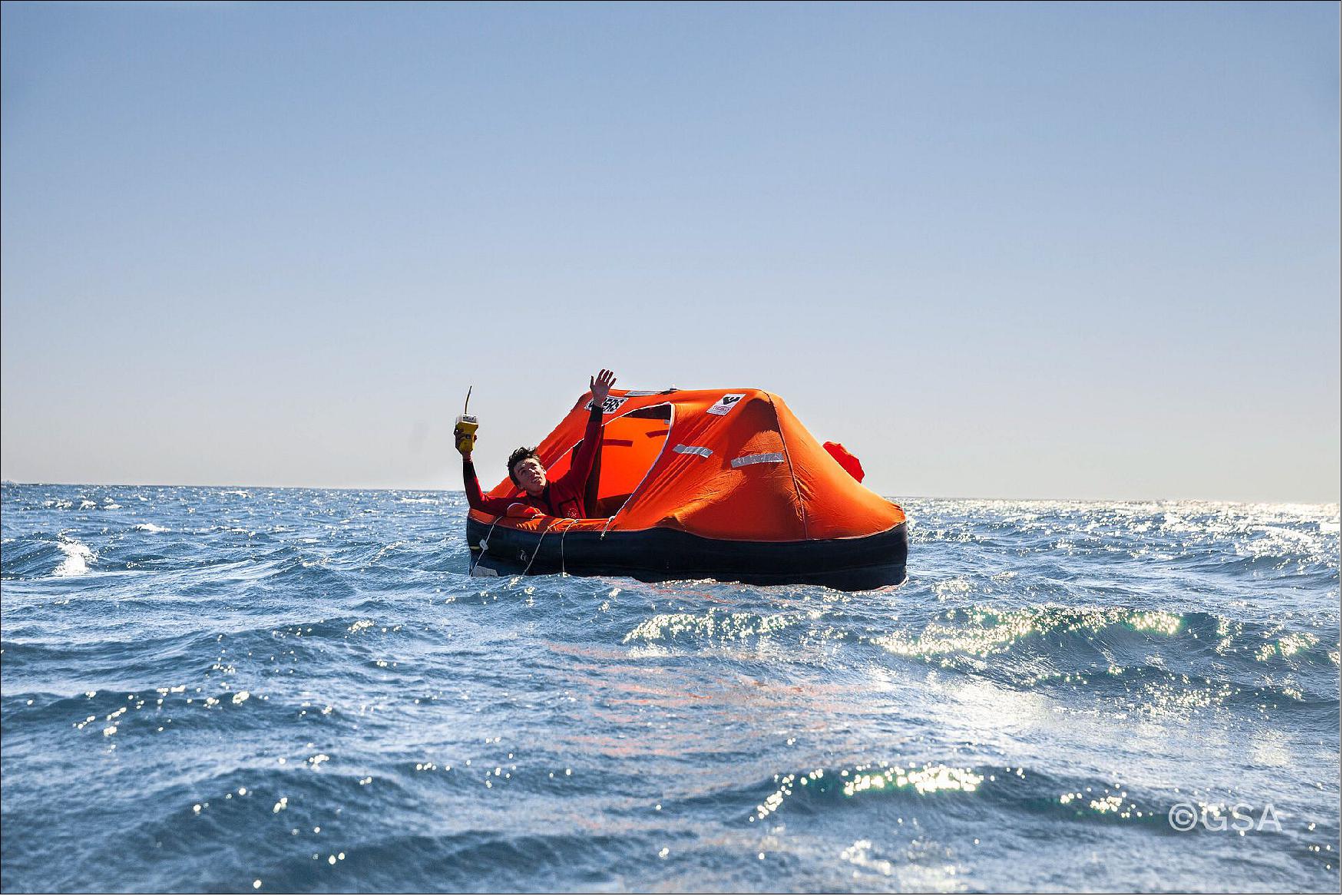
- He took to his life raft. As it hit the water it automatically activated his rescue beacon, transmitting a 406 MHz SOS signal for automatic pickup by participating satellites, courtesy of the Cospas-Sarsat satellite-based emergency detecting and locating system. The signal allowed the race authorities to localize Kevin's position within a matter of minutes and send nearby boats to the rescue.
- The only system that can independently locate a beacon anywhere on Earth's surface, Cospas-Sarsat has helped save thousands of people since it was first established in 1982. Originally the system operated through transponders hosted aboard either low-Earth orbit or geostationary satellites.
- In the last decade Galileo joined Cospas-Sarsat – supported by the European Commission, the system's owner – driving a significant increase in performance. Because they have such a high orbital altitude, at 23,222 km up, while still moving steadily through the sky, Galileo satellites combine broad views of Earth with the ability to facilitate quick determination of the position of a distress signal through a combination of time-based and Doppler ranging.
- International 406 Day – taking its name from the radio frequency used by Cospas-Sarsat beacons, and the US order of today's date – seeks to remind beacon users to take care to check their batteries and functionality. Such beacons are used aboard boats and ships, also aboard aircraft and are also carried by hikers in the wilderness – anywhere beyond the reach of standard phone-based emergency services.
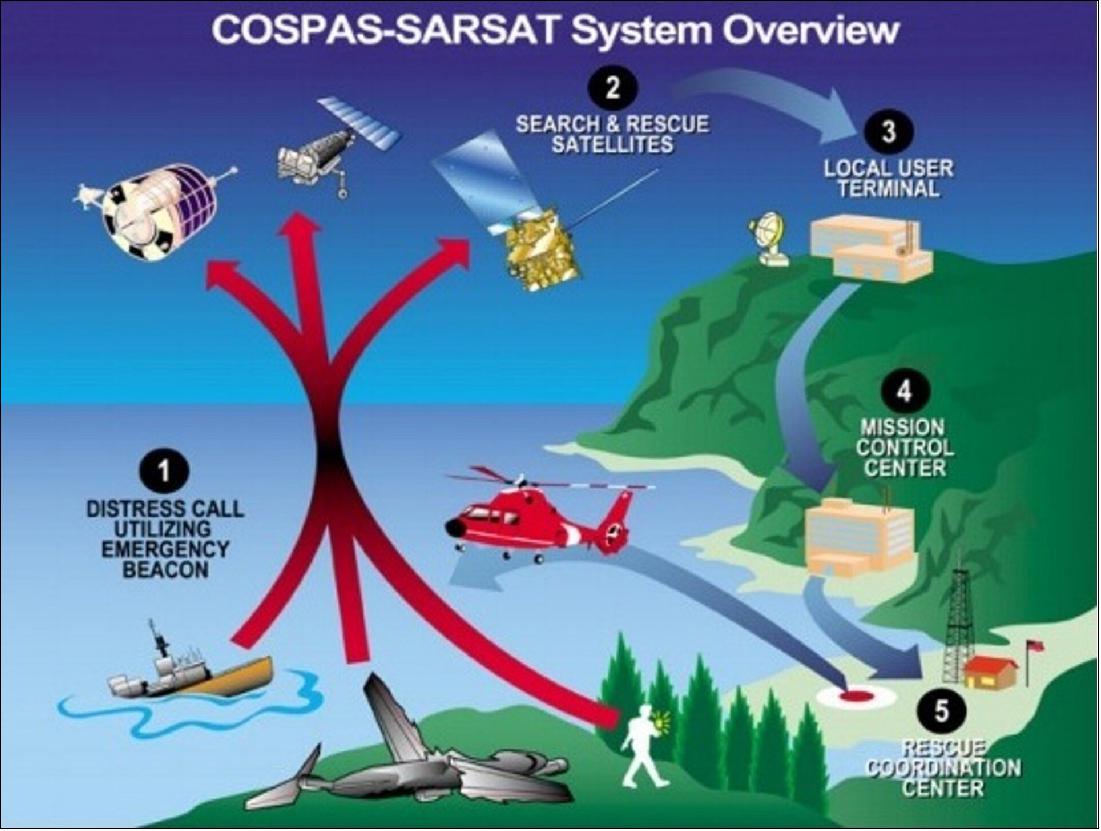
- All the same, an SOS signal can reach the authorities surprisingly swiftly, within a few minutes. First the signal from the beacon is detected automatically by the search and rescue payload aboard participating satellites – often more than one at once – then pinpoints its source on Earth's surface.
- Next, this information is relayed – via a set of stations on the corners of Europe, in the case of Galileo-detected signals – then passed to the nearest national rescue center, at which point the rescue can begin.
- The beacons themselves are surprisingly compact in size, typically the size of a medium-sized flashlight. But the search and rescue payloads carried aboard the Galileo satellites in orbit are similarly modest. At only 8 kg in mass, these life-saving payloads consume just 3% of onboard power, with their receive-transmit repeater housed next to the main navigation antenna.

- All but the first two of the 26 Galileo satellites in orbit carry these payloads, with two more satellites scheduled to add to their number later this year.
- Galileo's Search and Rescue service is Europe's contribution to Cospas-Sarsat, operated by the European Global Navigation Satellite System Agency, GSA, and designed and developed at ESA.
- The Cospas-Sarsat satellite repeaters are supplemented by a trio of ground stations at the corners of Europe, known as Medium-Earth Orbit Local User Terminals (MEOLUTs), based in Norway's Spitsbergen Islands, Cyprus and Spain's Canary Islands and coordinated from a control centre in Toulouse, France.
- This trio is soon to become a quartet, with a fourth station on France's La Reunion Island in the Indian Ocean.
- Galileo's participation in Cospas-Sarsat has led in turn to a service innovation – from last year, Galileo has been replying to SOS signals with ‘return link messages', assuring those in peril that their signals have been received and help is on the way.
• March 10, 2021: In a first for any satellite navigation system, Galileo has achieved a positioning fix based on open-service navigation signals carrying authenticated data. Intended as a way to combat malicious ‘spoofing' of satnav signals, this authentication testing began at ESA's Navigation Laboratory – the same site where the very first Galileo positioning fix took place back in 2013. 52)
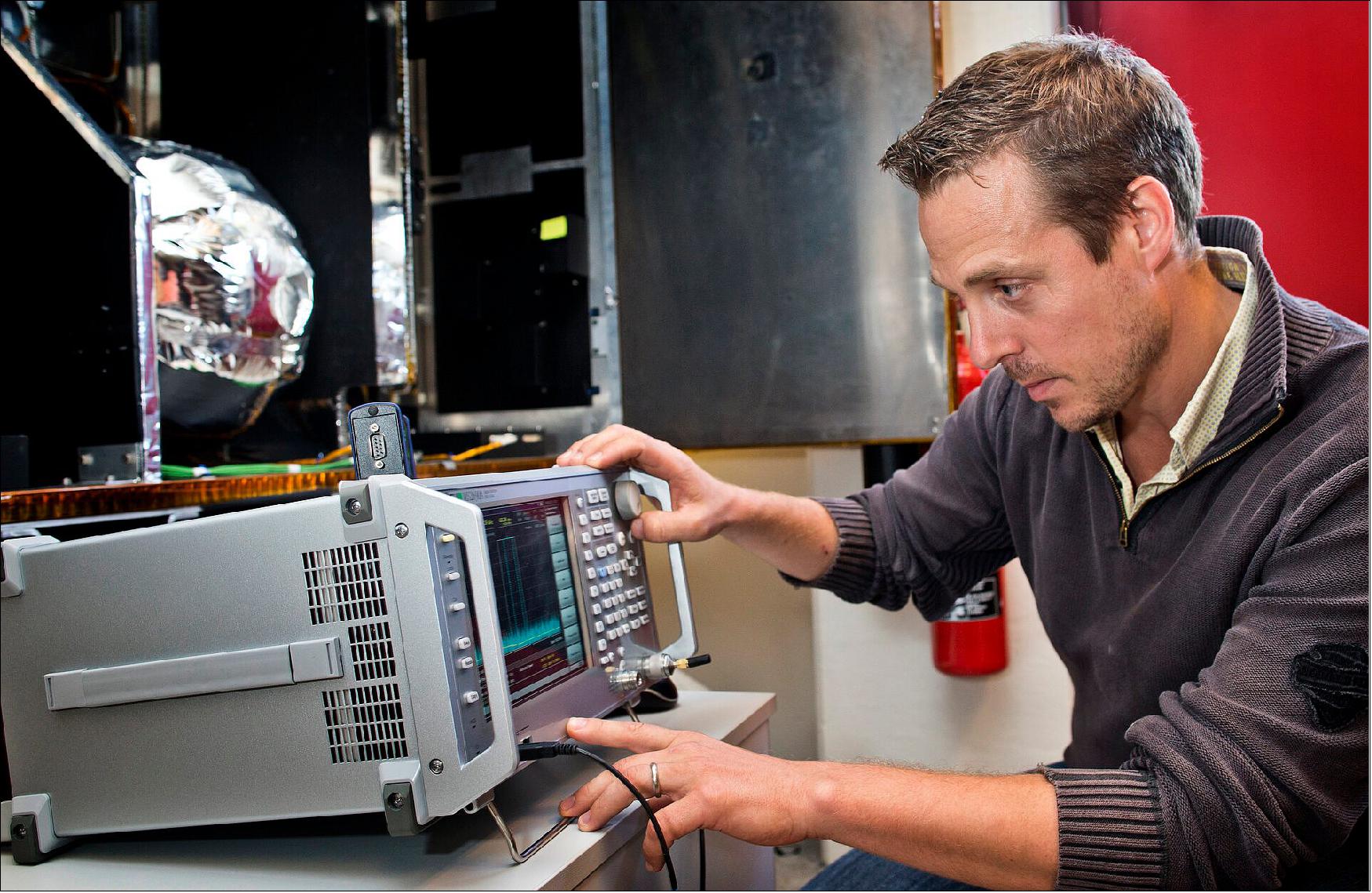
- These historic first authenticated signal ‘position, velocity, timing' fixes were made using a total of eight Galileo satellites for around two hours on 18 November 2020. The tests represent a first proof of concept for an eventual operational service offering positioning with authenticated data to users.
- Spoofing has, for instance, been demonstrated as a means of forcing down drones or redirecting ships, while some high security locations – as well as disrupted international borders – have become notorious for spoofing signals that prevent the reliable use of satnav in their vicinity.
- "When a receiver picks up a navigation signal from a satellite, up until now it has no way of confirming that was indeed its source," comments navigation engineer Stefano Binda, overseeing the project for ESA.
- "This can result in ‘spoofing' – malicious people and organisations using false signals to mislead users about their actual position. This authentication service offers a way to prevent such deception."
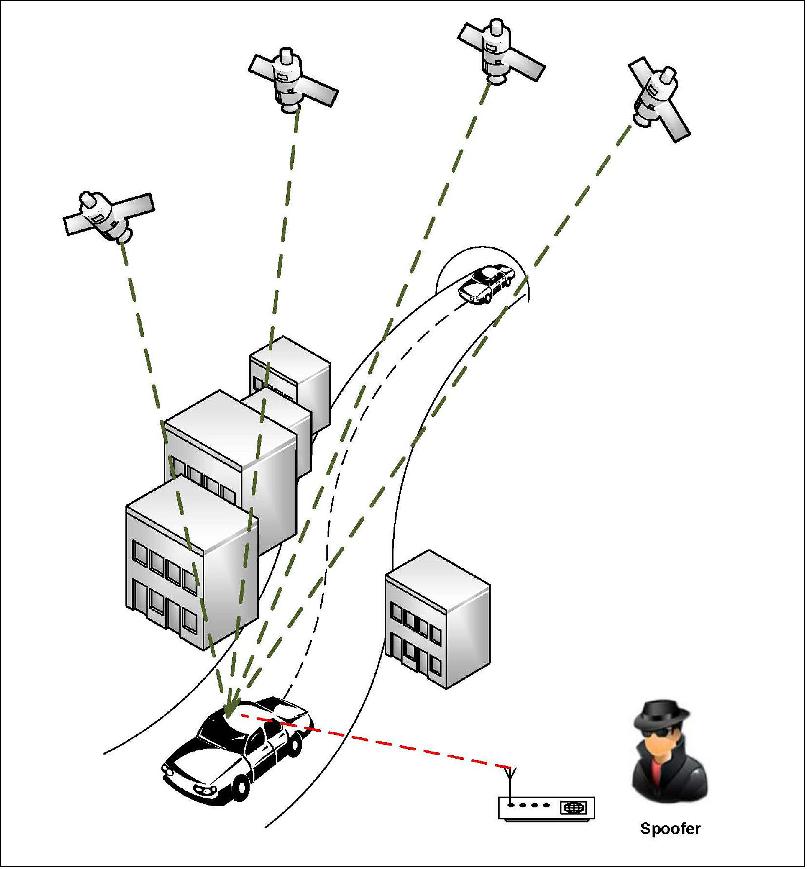
- Stefano notes: "In recent years this problem has become sufficiently pronounced as a weak point that the European Commission, ESA and European GNSS Agency (GSA) decided to develop signal authentication as a differentiator for Galileo."
- An ESA Navigation Directorate team at the Agency's ESTEC technical centre in the Netherlands worked with their GSA counterparts at the twin Galileo Control Centers (GCCs) in Italy and Germany and the Galileo Service Centre (GSC) in Spain.
- "In everyday authentication you might send a document that has been digitally signed, where both sender and recipient use compatible cryptographic keys to validate the document's source of origin," adds Stefano.
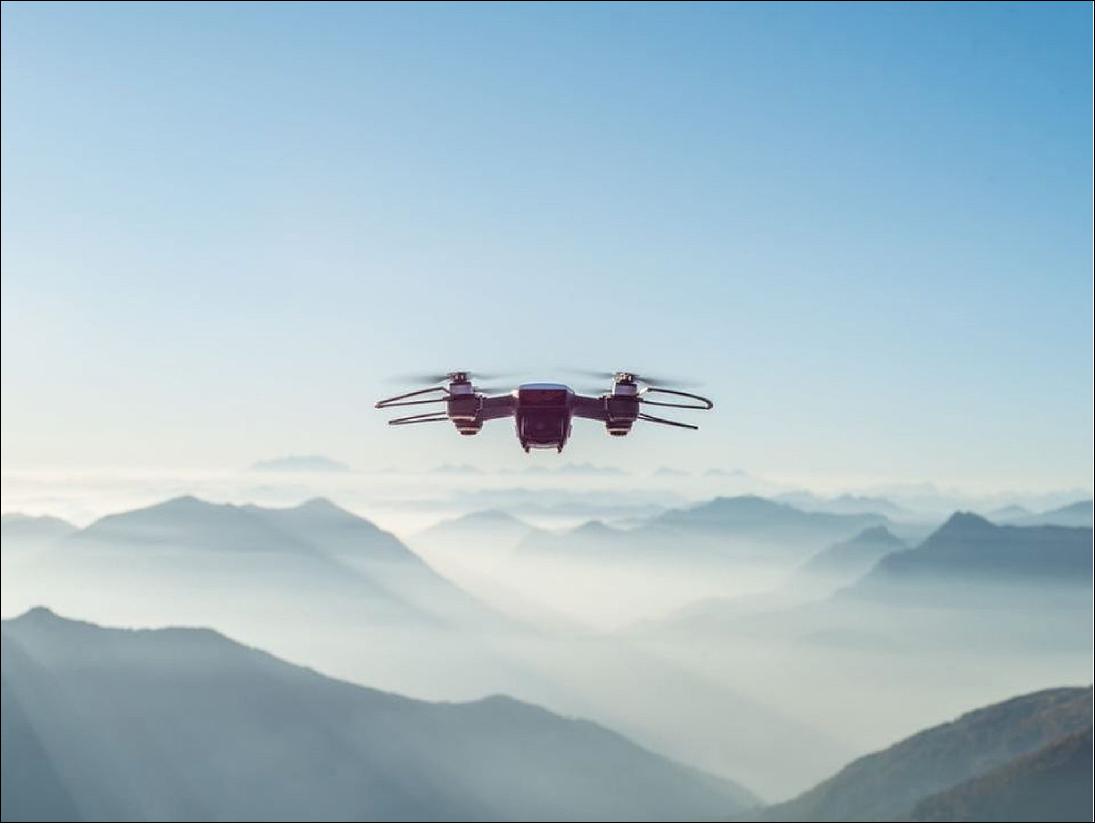
- "In everyday authentication you might send a document that has been digitally signed, where both sender and recipient use compatible cryptographic keys to validate the document's source of origin," adds Stefano.
- "In this case we were working with a constrained amount of bandwidth within the navigation signal, so instead opted for a ‘delayed key' approach. This means the initial data come along together a short tag which, within a short stretch of time usually not exceeding 30 seconds, is followed by a key, which is able to validate the tag and authenticate the data associated with it."
- During the test campaign, the Galileo Control Centers send the navigation signal to the GSC for the addition of the authentication code, which is then returned for uplink to the satellites, to be received and authenticated by the test receivers at ESTEC's Navigation Lab and elsewhere in Europe, in participating laboratories.
- To enable the authentication test campaign, Thales Alenia Space in France served as prime contractor to upgrade of the ‘Galileo Mission Segment' – the world-spanning system that determines and create the navigation messages broadcast by Galileo satellites. Thales Alenia Space in Italy was responsible for the system level integration. No modification of onboard satellite systems has been required to support Open Service Navigation Message Authentication (OS NMA), as spare bandwidth was made use of.
- "We used our standard laboratory Septentrio test user receivers with a software add-on," comments Stefano. "The beauty of this approach is that receivers will be able to make use of the future authenticated service without needing any new hardware, only software updates – apart from additional measures that might be mandated for operation in practice."
- ESA and GSA are continuing their authentication testing, with a view to introducing an operational Open Service Navigation Message Authentication service for users in the near future.
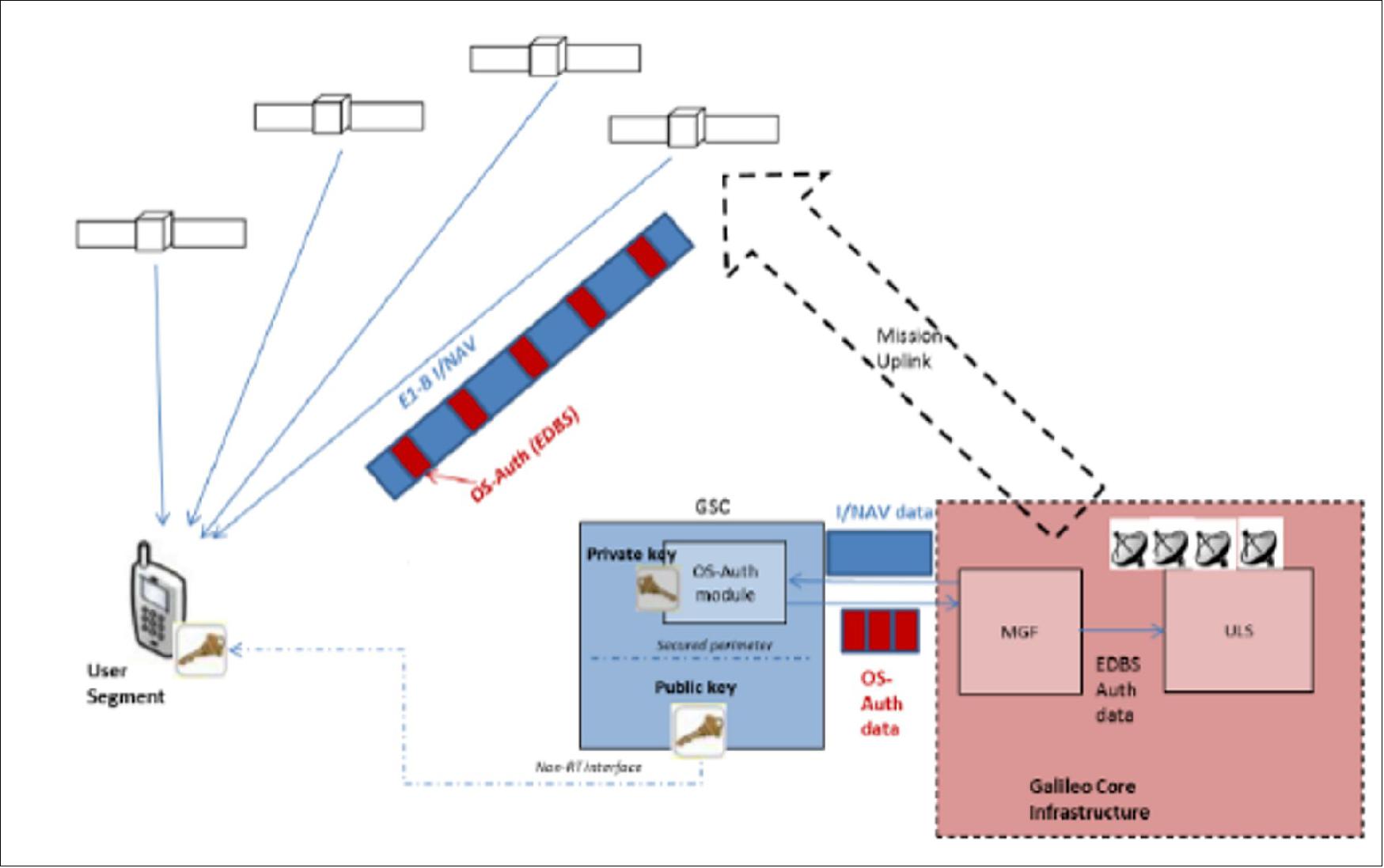
• January 11, 2021: The end of 2020 marked a notable milestone for Europe's Galileo First Generation, as the program chalked up its 500th ESA Engineering Board. 53)
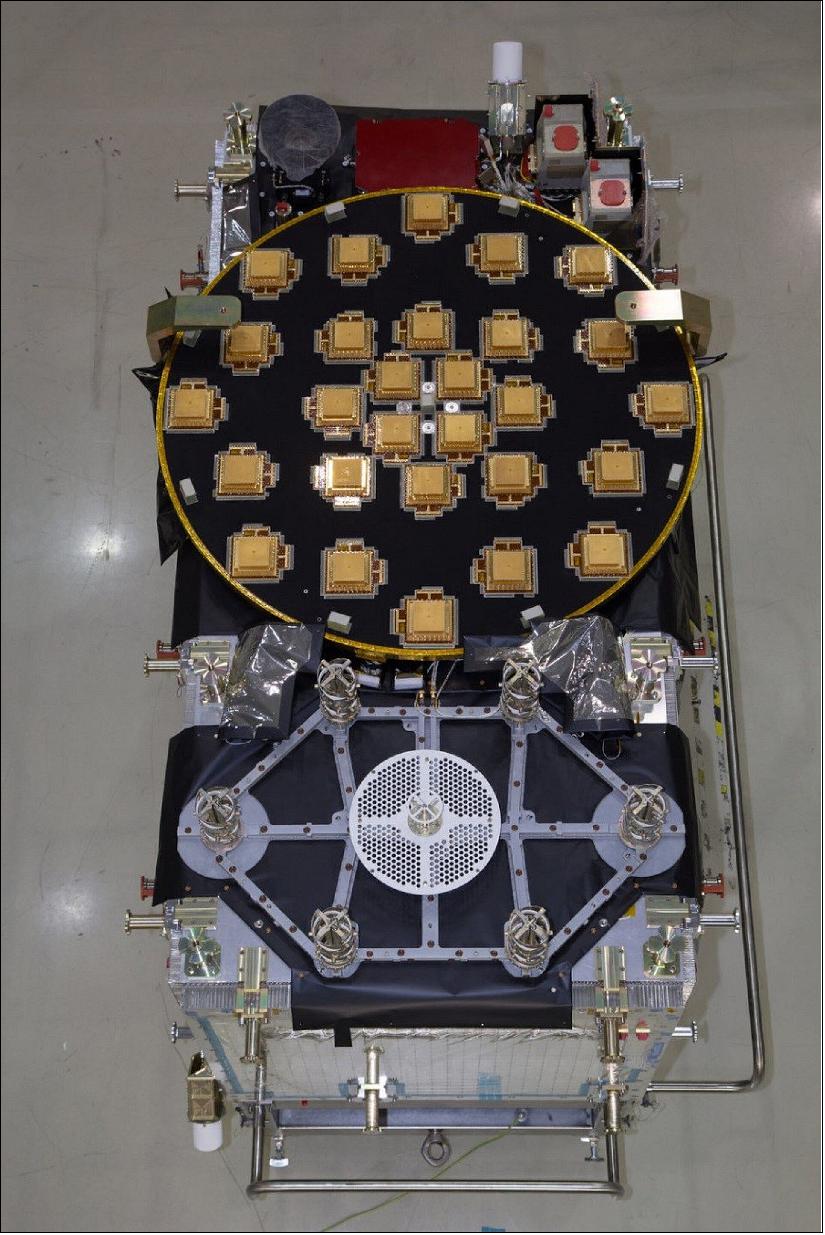
- Since the first such ‘G1' Engineering Board in 2008 a total of 26 Galileo satellites have been built, tested and flown, with a further 12 ‘Batch 3' satellites set to join them in orbit during the coming decade – these satellites are currently being finalized at OHB Systems in Bremen, Germany, then tested at ESA's ESTEC Test Centre in the Netherlands.
- The Galileo system's globe-spanning ground system has also been put in place and made operational. Galileo began initial operations in December 2016 and is today the world's single most accurate satellite navigation system, serving more than 1.5 billion smartphones and devices. But all that effort owes its origins to the regular sequence of G1 Engineering Boards.
- Much like a modern version of the Agora public square of ancient Greece, Galileo's ESA Engineering Board is the forum where technical experts regularly meet with a clear objective: maintaining, reviewing and updating the Galileo Project technical baseline, the STRB (System Technical Requirements Baseline).
- This STRB drives the implementation of the Galileo System and its infrastructure, namely the space and ground segments, along with associated interfaces and operations. All in all, the G1 system technical specification under ESA responsibility adds up to more than 22,000 separate requirements – both unclassified and classified in nature, with considerable interdependencies which all need to be controlled in configuration.
- The Galileo G1 Engineering Board is chaired by ESA in accordance with its role as Galileo System Design Authority, assigned to it by the European Commission.
- For more than 12 years now, ESA and industry engineers from all relevant disciplines – covering system, satellite, ground, signal, radio-navigation, RAMS (reliability, availability, maintainability and safety), security and infrastructure – have put their best skills at the disposal of this Board. It continues to be a crucial enabler for further robustness improvements and new service evolutions.
- The G1 Engineering Board meetings will continue into the future, complemented with the Engineering Boards for the new Galileo Second Generation (G2 satellites are planned for later this decade) which are already well underway.
• August 14, 2020: With 26 satellites now in orbit and over 1.5 billion smartphones and devices worldwide receiving highly accurate navigation signals, Europe's Galileo navigation system will soon become even better, ensuring quality services over the next decades. 54)
- Following the European Commission's decision to accelerate development of Galileo Next Generation, ESA has asked European satellite manufacturers to submit bids for the first batch of the Galileo Second Generation (G2) satellites. The new spacecraft are expected to be launched in about four years.
- The next-generation satellites will provide all the services and capabilities of the current first generation, together with a substantial number of improvements as well as new services and capabilities.
- "We want an ultra-flexible and mostly digital design," says Paul Verhoef, ESA Director of Navigation.
- "Developing the second generation is challenging for both industry and for ESA. In 2024, we need to launch the first satellites for this new state-of-the-art constellation."
Industry Steps Up
- Following almost 24 months of a competitive dialog procedure with the three large system integrators involved, ESA issued a so-called ‘Best and Final Offer' invitation to tender on 11 August to Airbus, OHB System AG and Thales Alenia Space.
- ESA is implementing a dual-sourcing approach, and two parallel contracts are expected to be signed around the end of 2020 amongst the current three bidders. Under the plan, each of the two selectees will build two satellites for development purposes, with options for up to 12 satellites in total.
- The first satellites of the new constellation are foreseen for launch before the end of 2024, together with updated ground systems to support the new satellites.
New, Improved and Revolutionary
- In addition to being more powerful, the second-generation Galileo satellites will be more flexible, able to be reconfigured in orbit in order to satisfy the expected evolution in end-user needs.
- A number of challenges exist for the bidders, as the goal of a digital and fully flexible design represents the cutting edge of industrial capability. Furthermore, the required navigation antennas, the ones that transmit the actual navigation signals to smartphones and other receivers on ground, have a very advanced design, and quite a lot of research and development work by ESA has been done and remains for industry.
- ESA has already built such an antenna as a proof of concept at the Agency's ESTEC technology center in the Netherlands to ensure feasibility, and the know-how has been shared with the three bidders.
- "Each bidder must determine how they can best manufacture the navigation antenna, and we'll have to see how each proposes to do it. Also, requiring a fully flexible payload is quite a challenge. No such navigation spacecraft of that type have flown yet," says Verhoef.
Transitioning into the Future
- The European Commission has decided that what was previously going to be called the ‘transition batch' of new satellites will now become, in fact, the Galileo Second Generation satellites. The European Commission and EU Member States have already made clear that they want to be very ambitious and further increase the technical capabilities of the Galileo system. The change of name recognizes the reality of how the current batch are actually shaping up.
- The transition satellites were initially foreseen as interim upgrades, to cater for the potential risk of late delivery of the later, completely new and very advanced G2 satellites.
- Based on constant measurements of the performance of the current satellites in orbit, their predicted lifetime has increased. So, together with a slight spreading out the launches of the so-called 'Batch 3' satellites, which are currently under construction by OHB and in testing at ESTEC, this will ensure service continuity before the new, advanced capabilities of Galileo come into operation.
- These second generation satellites will gradually take over from the current first generation satellites in the provision of Galileo services, and will therefore at a future date constitute a complete constellation plus the necessary in-orbit spares.
- ESA serves as the design, development and procurement agent for Galileo satellites on behalf of the European Commission, which funds the system overall.
GIDAS (GNSS Interference Detection and Analysis System)
• July 20, 2020: A new monitoring system developed through an ESA-backed project works like a ‘bodyguard' for satellite navigation in use at strategic or safety-critical sites. Known as GIDAS, the scalable system immediately detects, identifies and pinpoints satnav interference sources in its vicinity. 55)
It is estimated that there are currently the same number of satnav receivers on Earth as there are people. Positioning, navigation and timing signals from space-based constellations such as Galileo and GPS form an invisible, essential infrastructure, underpinning numerous modern aspects of modern life: communications, power and transportation.
Satellite navigation helps guide a growing number of aircraft, boats, trains and autonomous vehicles. Meanwhile satnav-based time-stamps authentic multi-billion euro financial transactions, and coordinate the synchronized running of power grids. Satellite navigation is always on, available everywhere on Earth, so it is easy to take its availability for granted. But as crucial as these signals from space are, they are also vulnerable to ground-based interference.
"It's simply a matter of output power," says Andreas Lesch of Austria-based OHB Digital Solutions. "A navigation signal on the ground is equivalent to the light from a 60 watt lamp aboard a satellite, some 23,222 km in altitude away in space in the case of Galileo. So these faint signals can be jammed by more powerful local radio signals, either accidentally or deliberately, or even misleading fake navigation signals, known as ‘spoofing'.
"The company initiated the project through NAVISP's second element, focused on strengthening European competitiveness in the navigation arena, proceeding on a co-funded basis,"says engineer Thomas Burger, overseeing GIDAS project for ESA. "The plan was to enable a commercially attractive business to get started, and I'm happy to say we made it."
![Figure 44: Surveying using satnav with EGNOS and Galileo satellites [image credit: GSA (GNSS Supervisory Agency), Europe]](https://www.eoportal.org/ftp/satellite-missions/g/GalileoFOC_130622/GalileoFOC_Auto47.jpeg)
Our new GIDAS (GNSS Interference Detection and Analysis System) is designed to safeguard critical infrastructure against jamming or spoofing, by performing continuous monitoring of key signal bands. By doing so, GIDAS can raise the alarm in realtime, identify the type of interference then pinpoint the location of these dangerous portable devices causing the interference so the authorities can take immediate remedial action."
GIDAS can provide interference detection and directionality with a single reporting station, although a minimum of three stations are required for pinpointing interference sources, linked to an overall monitoring center. Monitoring centers can also be connected together, making the GIDAS system easily scalable, from safeguarding an individual harbor, airport or system critical site up to an entire city or region.
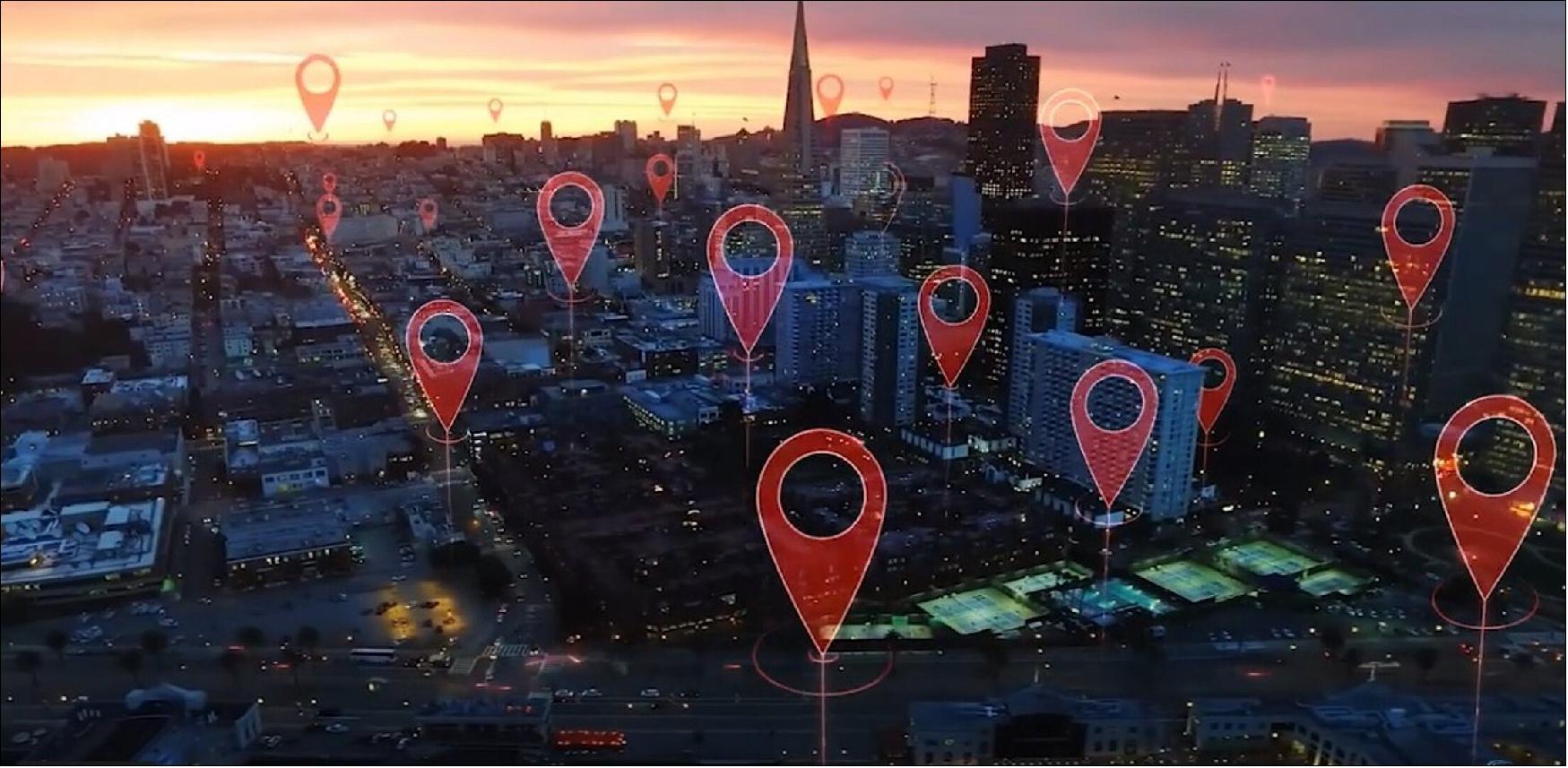
"People are only now catching up to the seriousness of this problem," adds Andreas. "Surveys of the highest-density parts of Europe surveys report around three to four jammers hourly.
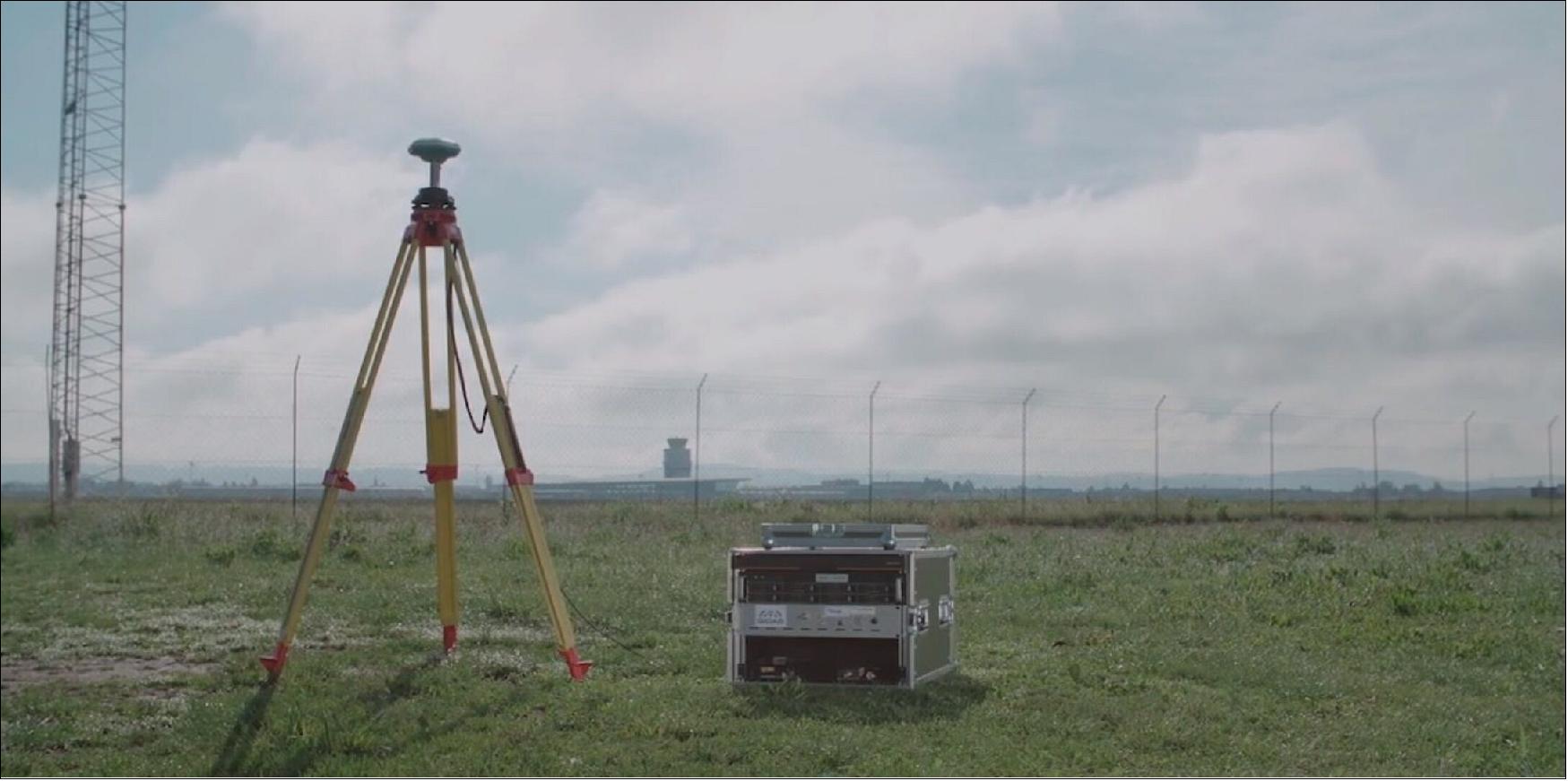
"These small devices are technically illegal but are easily available online for a few hundred euros or less, often marketed as ‘personal privacy devices'. Jammers are sold as having a range of only a few meters, but can turn out to have a practical range of dozens of meters or more – leading to unintentionally widespread interference, like the famous jammer-equipped US truck driver who shut down Newark Airport navigation systems whenever he drove past.
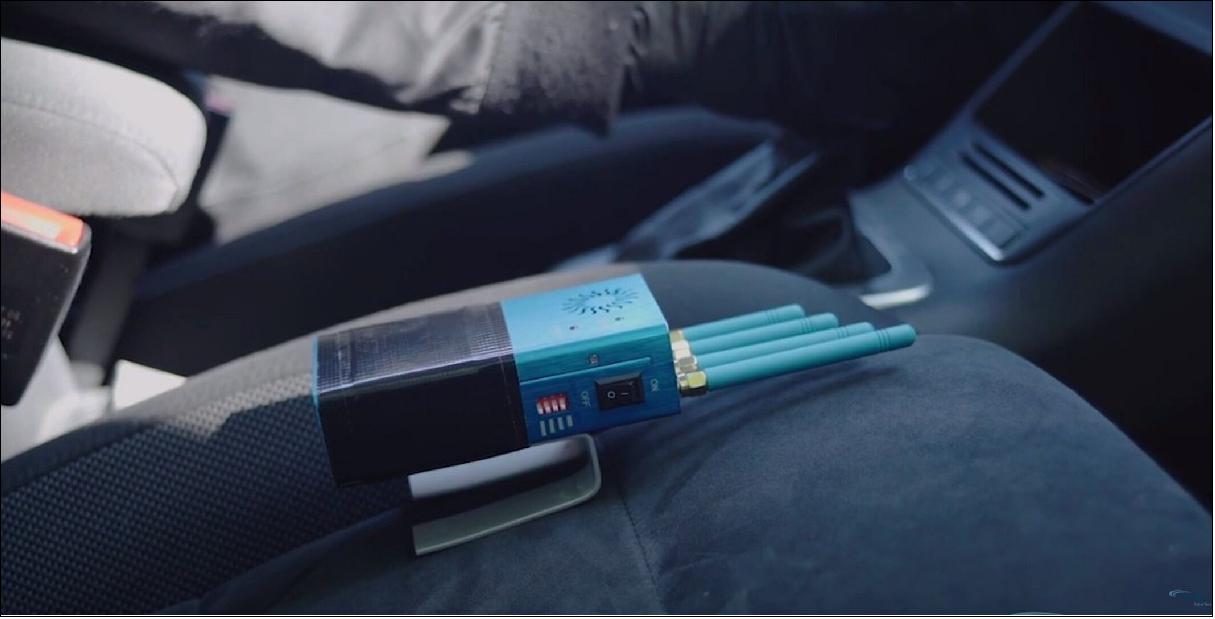
"Spoofing is more serious still, with a strong criminal element, where false satellite navigation signals replace real ones, to mislead receivers about their position, employed in the past to down put drones or divert boats.
"Working in this field for eight to nine years, we have seen a strong growth in interference, even as GNSS becomes ever more crucial. With our passion for GNSS and signal processing, we decided to something practical to combat this development, delivering rapid detection, classification and localization of interference to our customers."
GIDAS was developed by OHB Digital Solutions and Joanneum University through ESA's Navigation Innovation and Support Program (NAVISP), working with European industry and academia to develop innovative navigation technology.
"The company initiated the project through NAVISP's second element, focused on strengthening European competitiveness in the navigation arena, proceeding on a co-funded basis,"says engineer Thomas Burger, overseeing GIDAS project for ESA. "The plan was to enable a commercially attractive business to get started, and I'm happy to say we made it."
"Considering the budget, the project had a wide scope, including the development of a multi-constellation GNSS receiver with all processing stages, an extended digital front end for jamming and spoofing detection, processing blocks transferred to a parallel processor based on a customized fully programmable gate array.
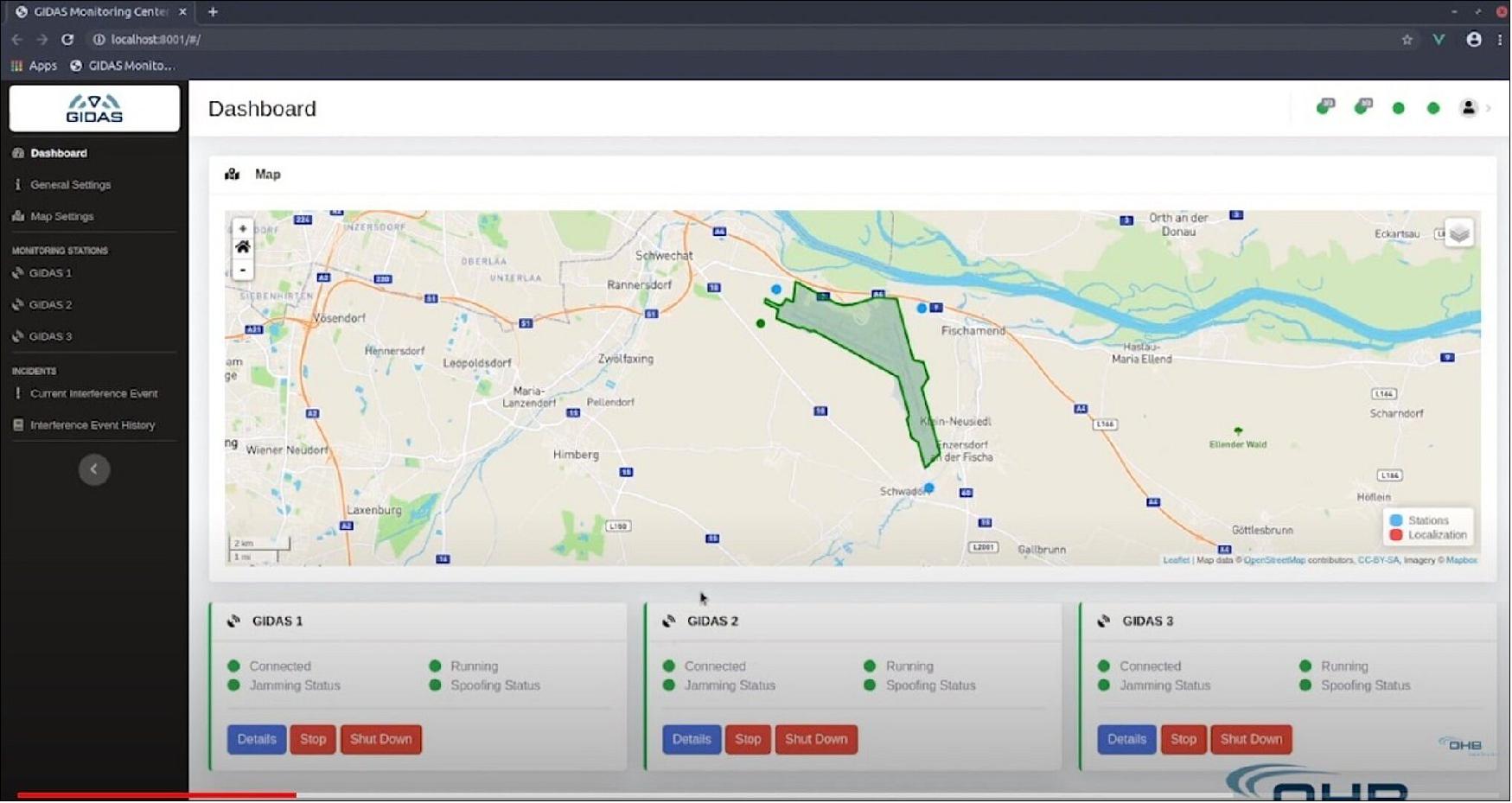
"And that was only one ingredient of the overall GIDAS system, also including the actual interference detection machinery, the interference locating subsystem, and all the communication, database, and graphical user interface elements needed to create a distributed, human-usable system – which is able to go on working autonomously, only asking for human involvement when events are detected."
Following the conclusion of the two-year NAVISP project, GIDAS is now in the process of being rolled out to several Europe-based governmental and private sector customers.
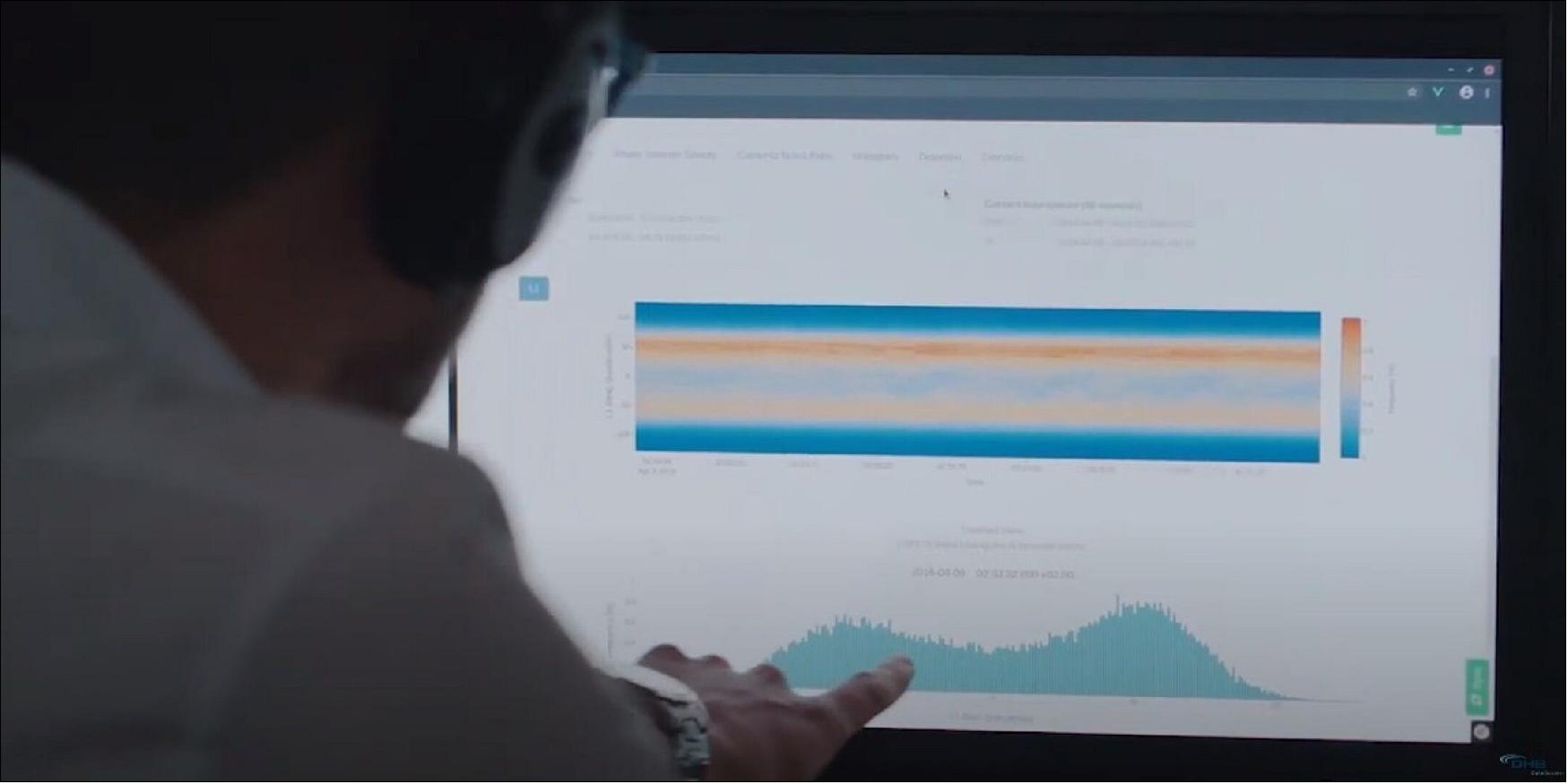
• April 29, 2020: As European governments plan their phased recoveries from the lockdown states triggered by the COVID-19 pandemic, the positioning delivered through satellite navigation is becoming more important than ever before. Location is a key requirement when attempting to monitor and map the spread of a disease and satnav is one of the main tools supporting this. 56)
- Since the outbreak of the coronavirus earlier this year, many apps have been developed that use satnav-based location data to monitor the global spread of the virus and to map outbreaks of the COVID-19 disease. Satnav based apps are also proving their usefulness by helping people to implement social distancing in queues and other public spaces.
- The Romanian company RISE has developed an app called CovTrack, which monitors people in your vicinity made identifiable via Bluetooth connections to your mobile phone and stores the identification data of these devices.
- By pressing a button you can access the database in which the unique identifiers of the mobile phones are registered (without having access to any personal data of these mobile phone users), to verify whether the persons with whom you came in contact have subsequently been confirmed with COVID-19. If you have identified a potential contact, you can refer to the relevant authorities whether that contact requires your inclusion among the monitored persons, or even testing for COVID-19.
- ESA's partner agency the GSA, European Global Navigation Satellite System Agency, working with the assistance of the European Commission, has put together a repository of such apps, available here.
- This list, based on apps that are already working and available in app stores, includes practical apps that facilitate the daily lives of citizens, such as by helping them to manage queues in supermarkets, pharmacies and public spaces or by facilitating the logistics of goods, which has become more complicated in the current situation.
- Europe's Galileo, currently embedded in over 1.3 billion smartphones and devices worldwide, is helping to increase satnav accuracy and availability, especially in urban areas. Is your own smartphone or device making use of Galileo, the most accurate satnav system? You can check here.
- The GSA is also developing its own Galileo-enabled application, Galileo for Green Lane, to monitor and ease the circulation of goods between EU Member States while identifying potential congestion at Green Lane border crossings, and thus ensuring that EU citizens can access the needed supplies of critical goods.
• February 14, 2020: Eutelsat Communications has informed all that the GEO-3 payload of the European Geostationary Navigation Overlay System (EGNOS), a hosted payload aboard the company's EUTELSAT 5 West B satellite, has successfully entered into service. 57)
- EUTELSAT 5 West B is hosting the Eutelsat-procured EGNOS payload under a 15-year agreement that was signed in 2017 with the European Global Navigation Satellite Systems Agency (GSA). The contract also includes technical services and a European ground infrastructure, including two gateways installed at Eutelsat's Rambouillet and Cagliari teleports.
- Yohann Leroy, Eutelsat's Deputy CEO and Chief Technical Officer, said that the firm is proud of the collaboration with customer GSA, its partners including the European Space Agency (ESA), and its suppliers, culminating in the entry into service of this next generation technology of EGNOS on EUTELSAT 5 West B. Eutelsat is delighted to host this payload, which will significantly enhance the performance of global navigation satellite systems across Europe, notably Galileo, in the coming years.
- Pascal Claudel, GSA Acting Executive Director and COO, added that with this new payload in service, EGNOS is moving toward the transition to its new generation. This has been done thanks to the constructive collaboration with Eutelsat. Delivery and continuity of satellite services are part of the company's mission as delegated by the European Commission. It is essential that the GSA ensures these services to support economic growth and that the European Union's citizens and companies can benefit from the latest GNSS technology.
• January 23, 2020: As well as providing global navigation services, Europe's Galileo satellite constellation is contributing to saving more than 2000 lives annually by relaying SOS messages to first responders. And from now on the satellites will reply to these messages, assuring people in danger that help is on the way. 58)
- This ESA-design ‘return link' system, unique to Galileo, was declared operational this week, during the 12th European Space Conference in Belgium. The delivery time for the return link acknowledgement messages from initial emergency beacon activation is expected to be a couple of minutes in the majority of cases, up to 30 minutes maximum, depending primarily on the time it takes to detect and locate the alert.
- "Anyone in trouble will now receive solid confirmation, through an indication on their activated beacon, informing them that search and rescue services have been informed of their alert and location," explains ESA's Galileo principal search and rescue engineer Igor Stojkovic. "For anyone in a tough situation, such knowledge could make a big difference."
- All but the first two out of 26 Galileo satellites carry a Cospas-Sarsat search and rescue package. At only 8 kg in mass, these life-saving payloads consume just 3% of onboard power, with their receive-transmit repeater housed next to the main navigation antenna.
- Founded by Canada, France, Russia and the US in 1979, Cospas-Sarsat began with payloads on LEO (Low Earth Orbiting) satellites, whose rapid orbital motion allows Doppler ranging of distress signals, to pinpoint their location. The drawback is these fly so close to Earth that their field of view is comparatively small.
- GEO (Geostationary Earth Orbiting) satellites went on to host Cospas-Sarsat payloads. These see much more of the planet, but because they are motionless relative to Earth's surface, Doppler ranging is not possible.
- MEO (Medium Earth Orbiting) satellites such as Galileo – orbiting at 23,222 km altitude – offer the best of both worlds, providing a wide ground view by multiple satellites combined with time-of-arrival and Doppler ranging techniques to localize SOS signals. This improves the maximum signal detection time from four hours to less than five minutes, down to 1 or 2 km (within a formal specification of 5 km within 10 minutes).
- Galileo's Search and Rescue service is Europe's contribution to Cospas-Sarsat, operated by the European GSA (Global Navigation Satellite System Agency), and designed and developed at ESA. As the overall Galileo system architect and design authority, ESA has been responsible for the interface between the core Galileo infrastructure to the Return Link Service Provider facility, procured by the European Commission and operated by French space agency CNES.
- The Cospas-Sarsat satellite repeaters are supplemented by a trio of ground stations at the corners of Europe, known as Medium-Earth Orbit Local User Terminals (MEOLUTs), based in Norway's Spitsbergen Islands, Cyprus and Spain's Canary Islands and coordinated from a control center in Toulouse, France. This trio is soon to become a quartet, with a fourth station on France's La Reunion Island in the Indian Ocean under development.
- The satellites relay distress messages to these MEOLUTs, which then relay them to local search and rescue authorities.
- The service's return link message capability was developed as an inherent part of the Galileo system. The messages are relayed to the individual beacons that sent the original distress call by being embedded within Galileo signals broadcast from satellites in their view.
- "The switching on of the return link service was enabled by a thorough test campaign carried out by ESA, with the support of the GSA and CNES," adds Igor. "We needed to be sure the service remains reliable even with multiple distress calls being replied to at once."
- A key milestone was a public demonstration of the return link service, performed at the Cospas-Sarsat Joint Committee Meeting in Doha in Qatar last summer.
- "The return link is a joint service of Cospas-Sarsat and Galileo and therefore agreement by Cospas-Sarsat was crucial," adds Igor.
- "This acceptance was achieved through long discussions led by the European Commission at the Cospas-Sarsat Council last November, supported by plentiful documentation of simulations and test results provided by ESA and CNES."
Note: This 'Mission Status' entry of January 23, 2020 is repeated below at Status of Galileo's SAR (Search & Rescue) Service.
• December 20, 2019: The Galileo satellite navigation system has been providing Initial Services for three years now. Meanwhile Europe's other satnav system has marked its tenth anniversary: EGNOS has been delivering enhanced positioning to users across our continent, including safety-critical services such as aircraft landings for a growing number of European airports. 59)
- The purpose of EGNOS (European Geostationary Navigation Overlay Service) is to monitor the real-time performance of US GPS satellites, then generate a correction message, containing information on the reliability and accuracy of their positioning data, which are then broadcast via EGNOS's geostationary satellites to all suitably equipped satnav receivers.
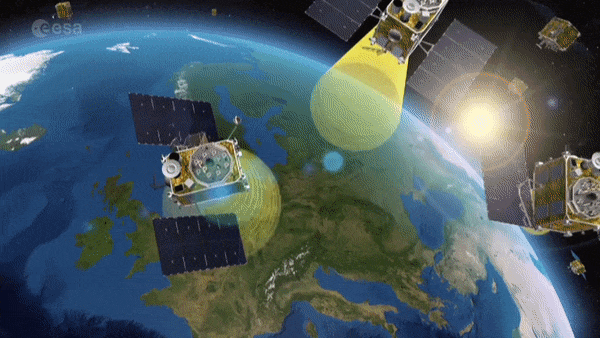
- The end result is a several-fold increase in positioning accuracy and reliability – which is expressed for aviation users through the notion of its ‘integrity' – how much can it relied upon at any given time. EGNOS typically allows users in Europe and beyond to determine their position to within 1.5 meters with a very high level of integrity, allowing aircraft to be safely guided down to airport runways.
- EGNOS consists of three geostationary satellites and a Europe-wide ground segment composed of two master control stations, six uplink stations and a network of 40 monitoring stations, all connected and communicating in real time.
- EGNOS was a joint project of ESA, the European Commission and Eurocontrol, the European Organisation for the Safety of Air Navigation. The system's Open Service began on 1 October 2009, after which EGNOS positioning data became freely available in Europe through satellite signals to anyone equipped with an EGNOS-enabled GPS receiver.
- The system is employed for accuracy and integrity-hungry satnav applications such as precision farming, surveying and transport. EGNOS is, for instance, used within the new eCall system, found in all new cars sold in the EU since March 2018. Whenever a serious accident occurs, eCall automatically passes the incident location to the emergency services, with EGNOS providing added accuracy and integrity.
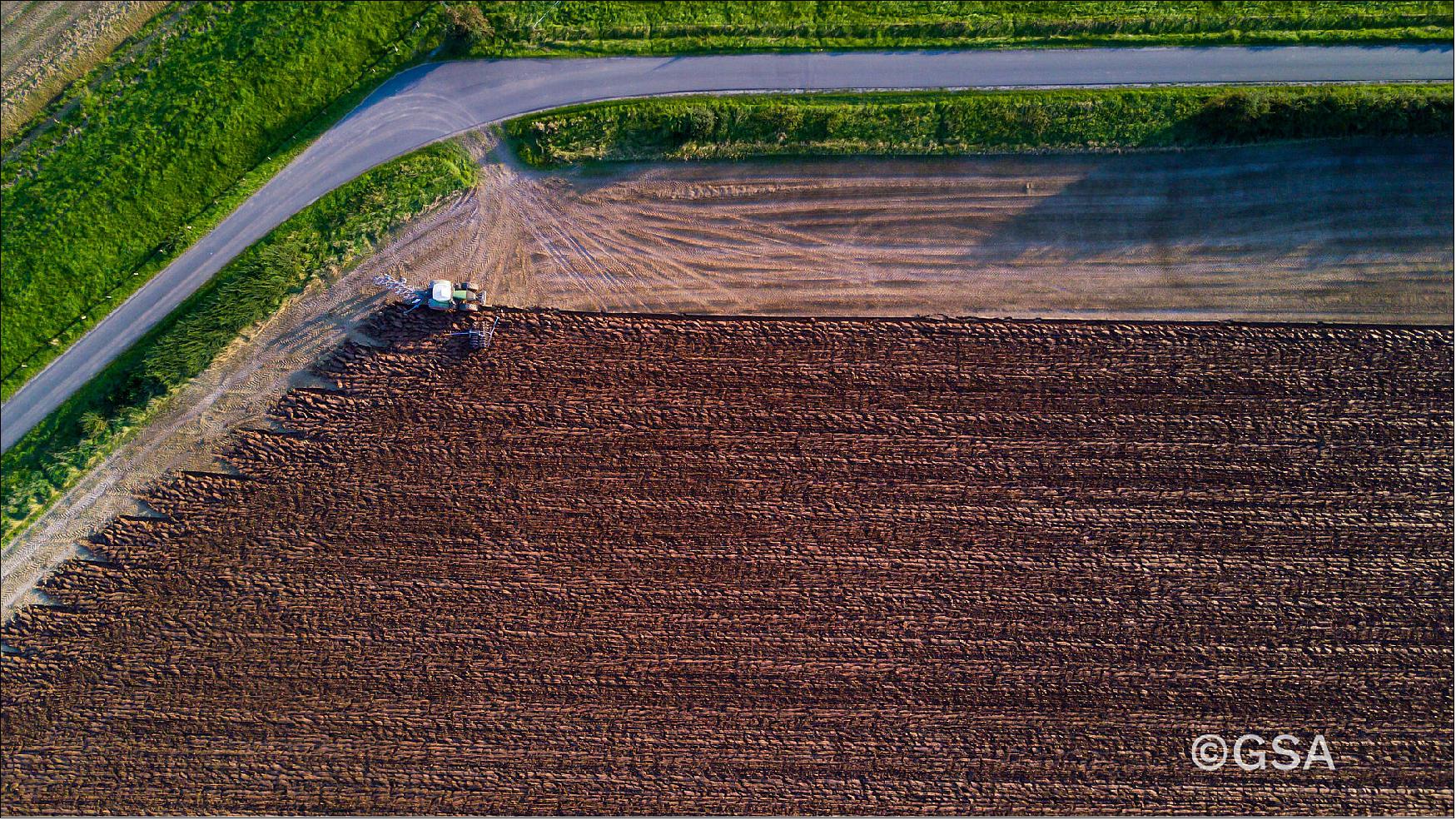
- But as the European equivalent of the US Wide Area Augmentation System WAAS, EGNOS was primarily designed to serve aviation, specifically for the safety-critical task of guiding down aircraft for landings. This became possible on 2 March 2011, when EGNOS's ‘Safety-of-Life' service began to operate.
- Today more than 350 airports - more than half of the total – across Europe employ EGNOS. To do so, they have been certified for what are known as ‘LPV-200 procedures' allowing pilots to take their aircraft down to 60 m (200 ft) above the ground for a final go/no-go decision on continued landing descent. LPV stands for ‘localizer performance with vertical guidance'.
- This certification allows airports to operate without costly ground-based Instrument Landing System ‘Cat-1' infrastructure. Major airports hubs such as Paris Charles de Gaulle, Frankfurt and Amsterdam Schiphol employ EGNOS for landing approaches. For smaller regional airports, EGNOS allows them to stay open in all weathers.
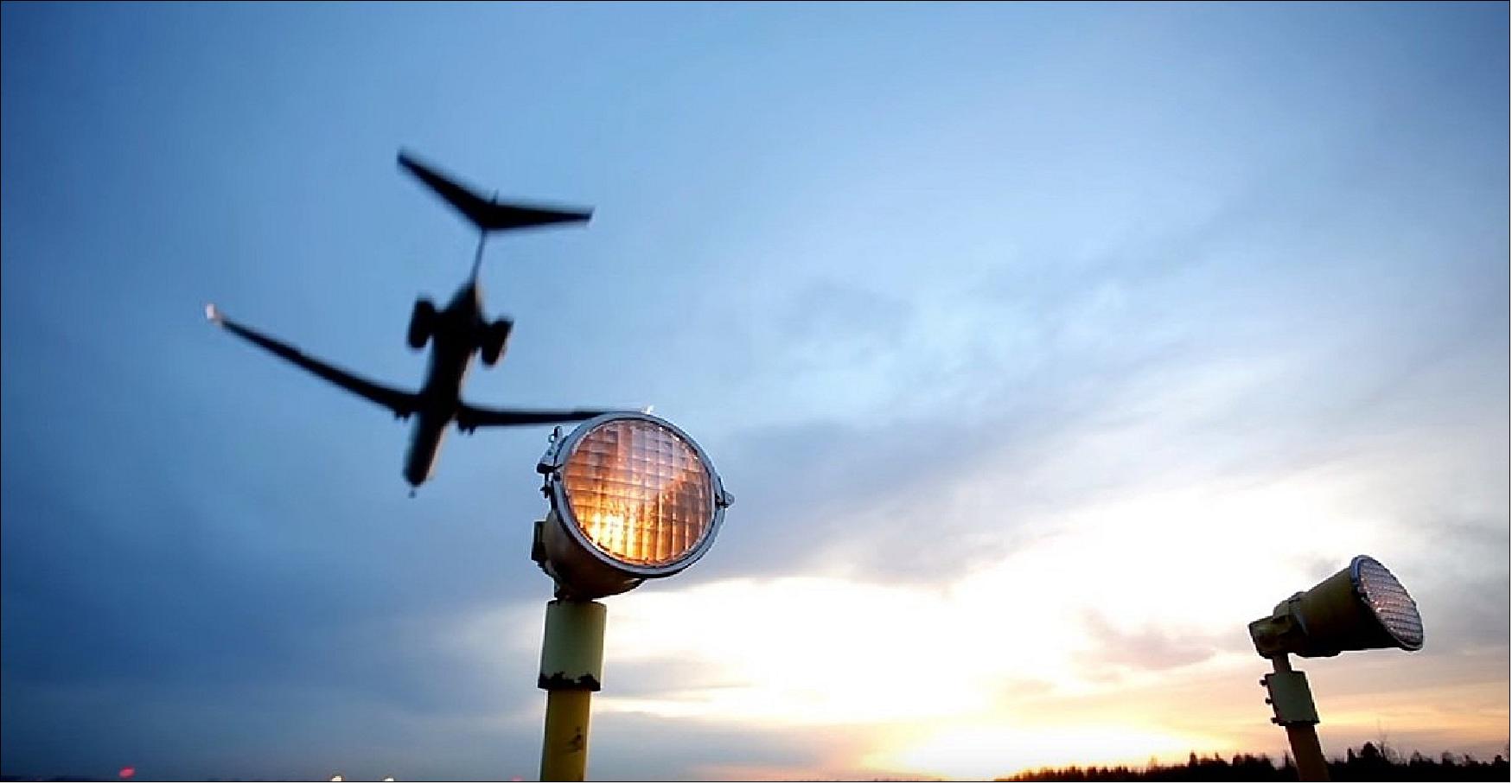
- The EGNOS Exploitation Program is managed by the European Global Navigation Satellite System Agency, GSA. ESA retains the role of developing its future System evolution, taking shape as ‘EGNOS V3' in the coming decade, which will augment signals from both GPS and Galileo satellites for added performance, reliability and extended coverage.
• July 22, 2019: The Initial Services provided by the European satellite navigation system - Galileo - have been successfully restored. Galileo was affected by a technical incident related to its ground infrastructure. This event led to a temporary interruption of the globally available Galileo navigation and timing services, with the exception of the Galileo Search and Rescue Service. 60)
- The Search and Rescue Service, which is used to locate and assist people in emergency situations, for example, at sea or in remote, mountainous areas, was not affected and remained operational.
- The navigation service impact was caused by a malfunction of some equipment in the Galileo control centers, which generate the system time and calculate orbit predictions; these data are used to produce the navigation messages. The disruption affected various elements at the control centers in Fucino (Italy) and at the DLR site in Oberpfaffenhofen.
- A team of experts from the Galileo Service Operator, led by Spaceopal GmbH, worked as quickly as possible and in close cooperation with the European GNSS Agency (GSA), as well as the industrial ground infrastructure providers together with the European Space Agency (ESA) to rectify the malfunction.
- Due to the high technical complexity of the system and the in-depth analysis of the fault dependencies, these efforts took several days before the resumption of Initial Services on 18 July 2018.
- An independent board of inquiry is now investigating the exact circumstances and root causes that led to the failure. The investigation is being conducted by the EU Commission and the GSA - the authorities that manage the program - in order to continuously improve the system during its initial service phase.
- Galileo has been offering its Initial Service since December 2016. During this initial 'pilot' phase, which precedes the 'full-operational services' phase, Galileo signals are being used also in combination with those from other satellite navigation systems, allowing testing and the detection of potential technical challenges during the commissioning of the system until full deployment and operational capability has been reached.
• July 18, 2019: Galileo Initial Services have now been restored. Commercial users can already see signs of recovery of the Galileo navigation and timing services, although some fluctuations may be experienced until further notice. 61)
- The technical incident originated by an equipment malfunction in the Galileo control centers that calculate time and orbit predictions, and which are used to compute the navigation message. The malfunction affected different elements on both centers.
- A team composed of GSA (Global Navigation Satellite Systems Agency) experts, industry, ESA and Commission, worked together 24/7 to address the incident. The team is monitoring the quality of Galileo services to restore Galileo timing and navigation services at their nominal levels.
- We will set an Independent Inquiry Board to identify the root causes of the major incident. This will allow the Commission, as the program manager, together with the EU Agency GSA to draw lessons for the management of an operational system with several millions of users worldwide.
- Galileo provides ‘initial services' since December 2016. During this initial ‘pilot' phase preceding the ‘full operational services' phase, Galileo signals are used in combination with other satellite navigation systems, which allows for the detection of technical issues before the system becomes fully operational. In the full operational phase, Galileo should function independently of other satellite navigation systems.
• July 17, 2019: A team of experts from the European GNSS Agency, industry, the European Space Agency and the European Commission is currently implementing and monitoring recovery actions for an incident related to the Galileo ground infrastructure that resulted in a temporary interruption of the Galileo Initial Services. The key objective is to restore the Galileo navigation and timing services for users as soon as possible. 62)
- On 12 July, Galileo initial navigation and timing services were interrupted temporarily. The Galileo Search and Rescue service remains operational.
- Galileo is widely used by most of the commercially available receivers. Multi-constellation GNSS receivers will remain unaffected and compute position and timing using other constellations. Galileo-only receivers will not produce any navigation message.
- As soon as the incident was declared, an Anomaly Review Board was convened and urgent recovery procedures were activated in the affected Galileo infrastructures. Operational teams are working on recovery actions 24/7 to restore the Galileo navigation and timing services as soon as possible.
- Based on the results of the troubleshooting activities, several elements of the ground infrastructure were re-initiated. The progress is being closely monitored; it is too early to confirm an exact service recovery date.
A Period for Testing and Perfecting
- The Galileo satellite navigation system launched its Initial Services in December 2016 and since then it has been providing high quality positioning, navigation and timing services to users worldwide. The aim of this Initial Services phase is to allow for the detection of technical issues before the system becomes fully operational.
- It was precisely to deal with issues of this nature that the EU opted for a progressive roll-out of the Galileo system. The evolution and planned upgrade of the ground infrastructure will reinforce redundancy of the system towards reaching the full operations phase.
- As soon as the outage occurred, the users were informed by the Galileo Service Center through technical notices on 11 and 13 July , as well as a news item on the GSA website on 14 July. Users will be regularly updated, including on the navigation and timing service recovery date, through notifications and information.
- The Galileo team would like to assure users that it is working hard to remedy the situation as soon as possible.
• July 14, 2019: Galileo, the EU's satellite navigation system, is currently affected by a technical incident related to its ground infrastructure. The incident has led to a temporary interruption of the Galileo initial navigation and timing services, with the exception of the Galileo Search and Rescue (SAR) service. The SAR service - used for locating and helping people in distress situations for example at sea or mountains - is unaffected and remains operational. 63)
- Galileo provides ‘initial services' since December 2016. During this initial "pilot" phase preceding the ‘full operational services' phase, Galileo signals are used in combination with other satellite navigation systems, which allows for the detection of technical issues before the system becomes fully operational.
- Experts are working to restore the situation as soon as possible. An Anomaly Review Board has been immediately set up to analyze the exact root cause and to implement recovery actions.
- As foreseen in case of technical incidents, information Notices to Galileo Users (NAGU) were already published on the Galileo Service Center website:
a) on 11 July 2019: https://www.gsc-europa.eu/notice-advisory-to-galileo-users-nagu-2019025
b) and on 13 July 2019 : https://www.gsc-europa.eu/notice-advisory-to-galileo-users-nagu-2019026
c) https://www.gsc-europa.eu/system/files/galileo_documents/Galileo-service-notice-02.pdf
- Users will be informed regularly, including on the service recovery date.
• June 11, 2019: Europe's students and young researchers were challenged to design a smartphone app to take advantage of Galileo's dual-frequency signals. Run by ESA in collaboration with the European Global Navigation Satellite Systems Agency – GSA – plus the European Commission with the support of Google, a total of five teams made it to the final of the Galileo smartphone app competition 2019 which took place at ESA's ESTEC technical heart in the Netherlands on Thursday 18 April. This event was preceded by testing the performance of the competing apps in static, pedestrian and driving use modes. 64)
• March 4, 2019: Global leader in emergency readiness and response, Orolia, is pleased to announce that its McMurdo FastFind 220 and Kannad SafeLink Solo PLBs (Personal Location Beacons) now operate with the Galileo GNSS system. 65)
- Continuing Orolia's innovation and leadership role in Safety Electronics, the PLBs have been upgraded to include Galileo Global Navigation Satellite System (GNSS), the European Union's global satellite constellation.
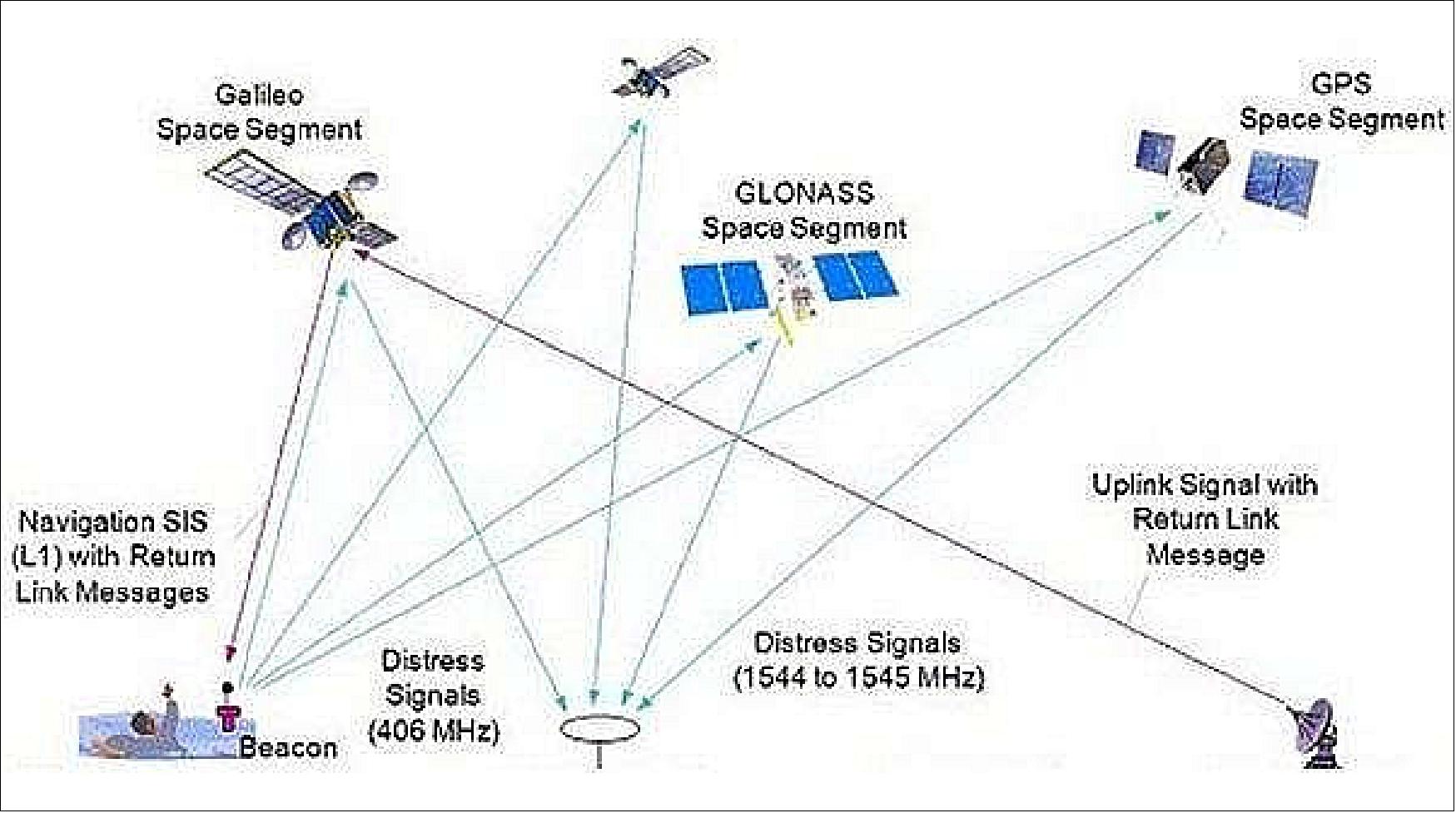
- The multi-constellation receivers work with a wider range of satellites, offering increased global coverage and supporting accelerated rescue missions.
- Location detection is enhanced and can be more precise due to the beacons receiving coordinates from the Galileo satellite network in addition to the tried and tested GPS network. Signals can even be detected in high sided locations, such as canyons.
- "We are thrilled to be launching our upgraded PLBs in the European and US markets," said Chris Loizou, Vice President of Maritime at Orolia.
- "The combination of both Galileo and GPS GNSS capability means that our customers will benefit from coverage that spans from the North to the South Pole. We work tirelessly to push the boundaries of product innovation and, ultimately, to give people the best chance of being rescued in an emergency situation."
- The McMurdo FastFind and Kannad SafeLink PLBs are part of Orolia's comprehensive search and rescue ecosystem and join the McMurdo SmartFind G8 and Kannad SafePro series EPIRBs (Emergency Position Indicating Radio Beacons) as the first Galileo capable rescue beacons.
- As the world's only provider of an end-to-end search and rescue ecosystem - including distress beacons, satellite ground stations, mission control and rescue coordination systems, and rescue response products - Orolia's McMurdo brand uniquely builds, integrates and tests products as part of a live search and rescue system.
- This ensures greater cohesion between distress signal transmission and reception so that beacon owners can feel confident that their signals will get to search and rescue authorities quickly.
• February 7, 2019: The latest four Galileo satellites, launched on 25 July 2018, have been given the green light to begin working alongside the rest of Europe's satellite navigation fleet, giving a further boost to worldwide Galileo service quality. 66)
- Galileo has grown to become Europe's single largest satellite constellation, built up over 10 launches over the course of this decade. The first of seven double-satellite Soyuz launches took place in 2011, with three sets of four-satellite Ariane-5 launches during the last three years. — The latest quartet of Galileo satellites were launched together by Ariane 5 on 25 July, bringing the number of satellites in orbit to 26.
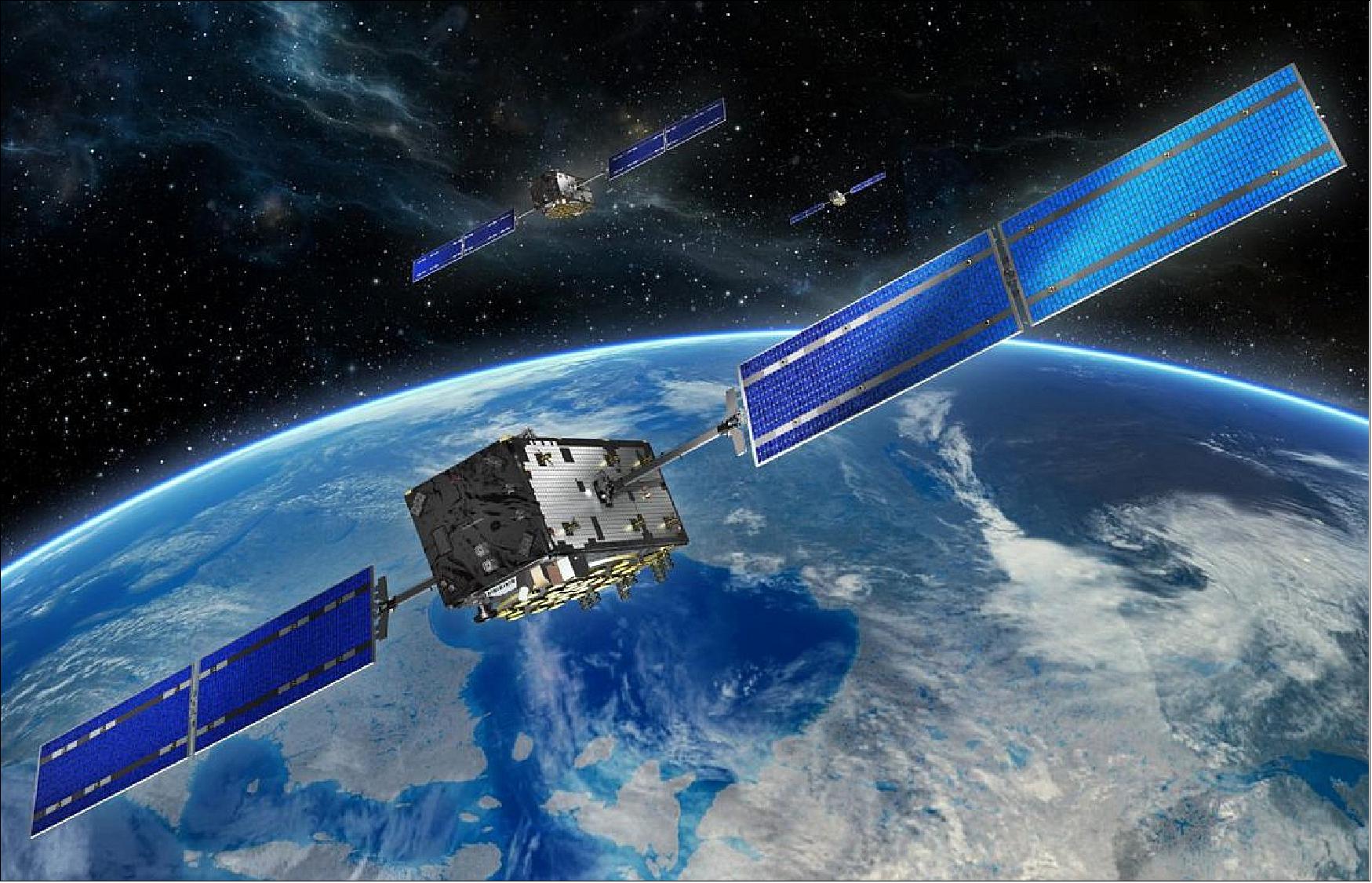
• December 17, 2018: Use Europe's satellite navigation system to seek treasure in virtual mazes or ‘see' Galileos as they cross the sky above you: two new Android smartphone apps based on Galileo are now available for general download, the results of a competition by ESA trainees. 67)
- With newer Android smartphones you can access the raw signal measurements used to compute position, opening the door to the development of applications where the user can indeed select which satellites to use. So ESA ran an internal competition for its trainees to develop an app capable of making positioning fixes using only Galileo satellites.
- The Callisto – Galileo's Spaceship app uses Galileo satnav signals to run a virtual maze game based on walking through a real world location.
- Looking down on Earth as if from a spaceship, players use a standard Google map display to traverse a rectangular area filled with randomly generated obstacles and collectibles. You play against the clock to grab prizes, with points deducted for running into virtual barriers.
- "It was fun for us to develop as a team, but one of the main purposes behind it was to spread the message about Galileo," explains ESA young graduate trainee Peter Vanik, part of the five-person ‘Chocolateam' that created the app.
- "Users can use signals from the Galileo constellation by itself, GPS by itself or GPS and Galileo in combination to get a sense of the different accuracy levels – the combination of constellations will work best, because that way the most satellites are available for use."
- The team used online tutorials and YouTube videos to learn how to develop for Android, with their satnav backend derived from GNSSCompare – the winning app from ESA's internal competition, offering to turn a smartphone in a ‘research lab in your pocket'.
- None of us are satnav specialists, so we played off not knowing all the nitty-gritty as an advantage rather than a weakness, in terms of targeting the general public," adds Matej Poliaček of the Callisto team.
- "The idea of a game came up early on, with a satnav-based gameplay loop," says the team's Cedric Ia. "Then Lionel Garcia, our designer, had the idea of making it spaceship-based, and that was where the design for our user interface came from."
- "Working together with GNSSCompare was a way to combine the best of both worlds," explains team member Emilie Udnæs. "They're stronger on the GNSS side of things while we took a user-centered approach.
- The Callisto app was designed on and for a Galaxy S8 smartphone, but the team is expanding the app to serve as many different phones as possible, to target a general public audience.
- Another app developed through the competition is also available for download from Google Play. GalileoPVT was created by ESA navigation engineer Paola Crosta and electrical engineer Tim Watterton to serve as a benchmark to judge competition entries. The duo went on to finalize and publish it.
- "GalileoPVT allows users to compare position fixes calculated from Galileo and GPS signals, and also to visualize Galileo satellites and signals live in the sky using augmented reality," explains Tim.
- "The raw signals can be saved for post-processing by users. There's also a fun hidden game, where the player has to maneuver their Galileo satellite to avoid increasingly bizarre items of space debris, aided by received Galileo signals that boost their satellite's health."
- "GalileoPVT can also be installed on devices that do not support Galileo signals. Although the user will not be able to receive the live Galileo signals or calculate a fix with Galileo, they can still see the predicted satellite positions on the augmented reality view, and play the hidden game."
- A current list of smartphones that support Galileo can be found here.
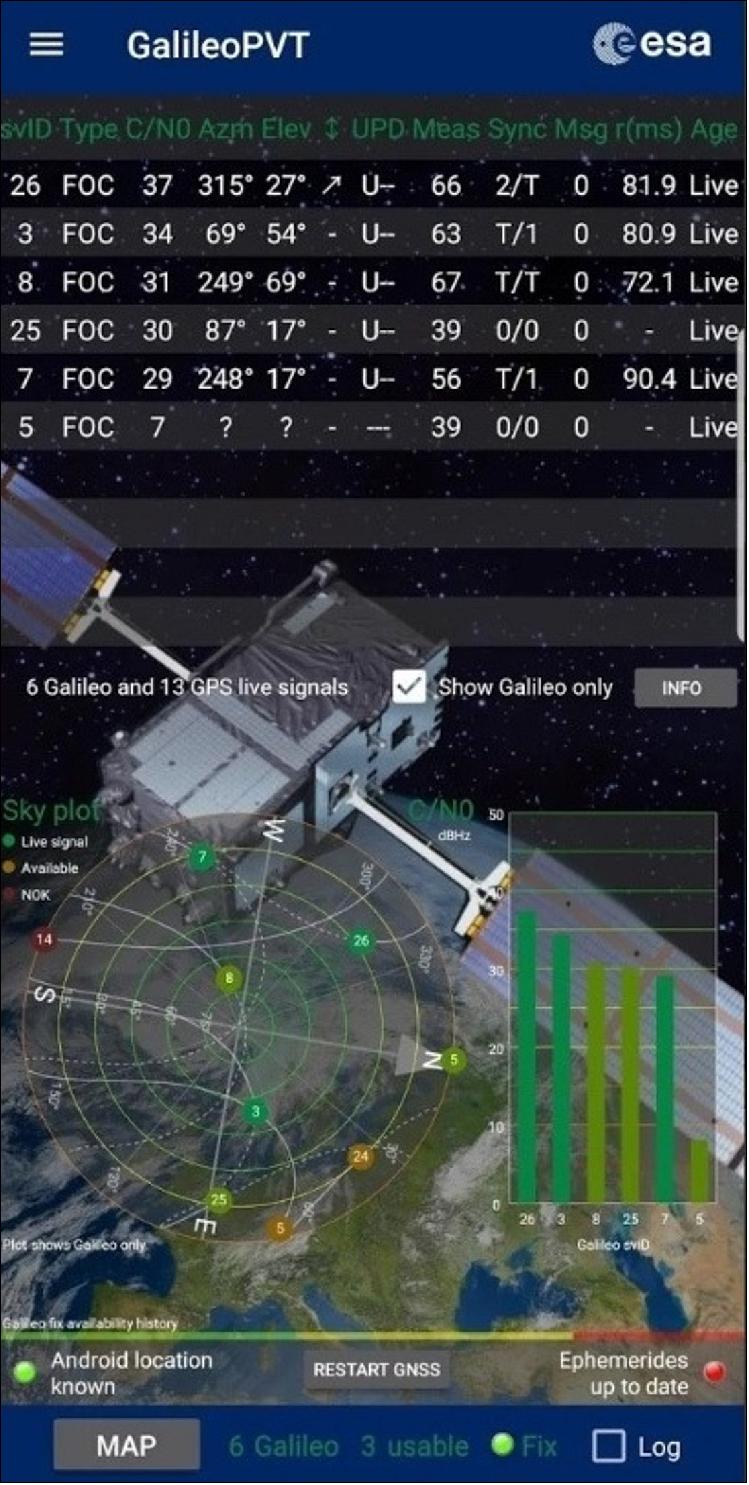
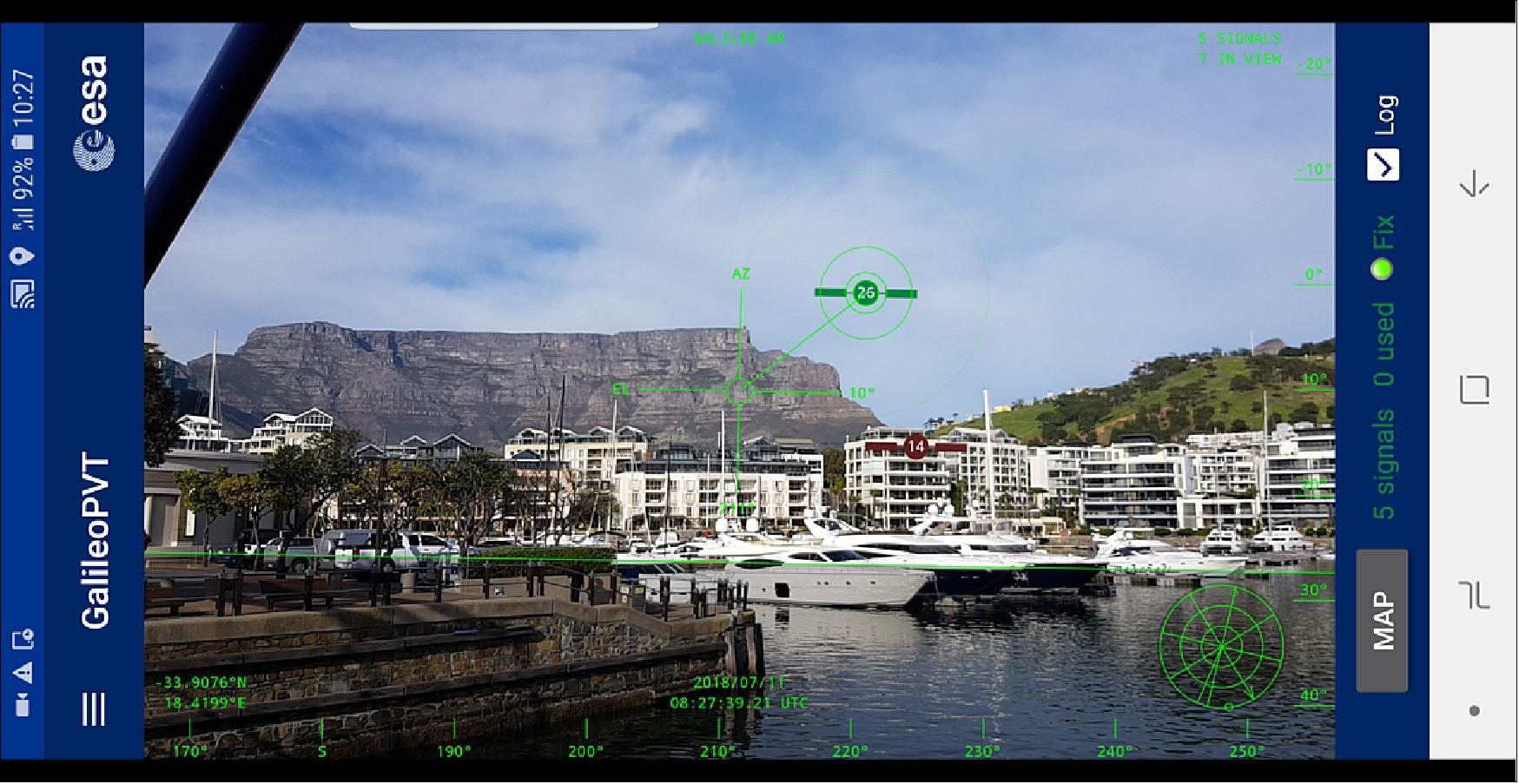
• December 4, 2018: Galileo satellites measure Einsteinian Time Dilation. Europe's Galileo satellite navigation system – already serving users globally – has now provided a historic service to the physics community worldwide, enabling the most accurate measurement ever made of how shifts in gravity alter the passing of time, a key element of Einstein's Theory of General Relativity. 68)
Two European fundamental physics teams working in parallel have independently achieved about a fivefold improvement in measuring accuracy of the gravity-driven time dilation effect known as ‘gravitational redshift'.
The prestigious Physical Review Letters journal has just published the independent results obtained from both consortiums, gathered from more than a thousand days of data obtained from the pair of Galileo satellites in elongated orbits. 69)
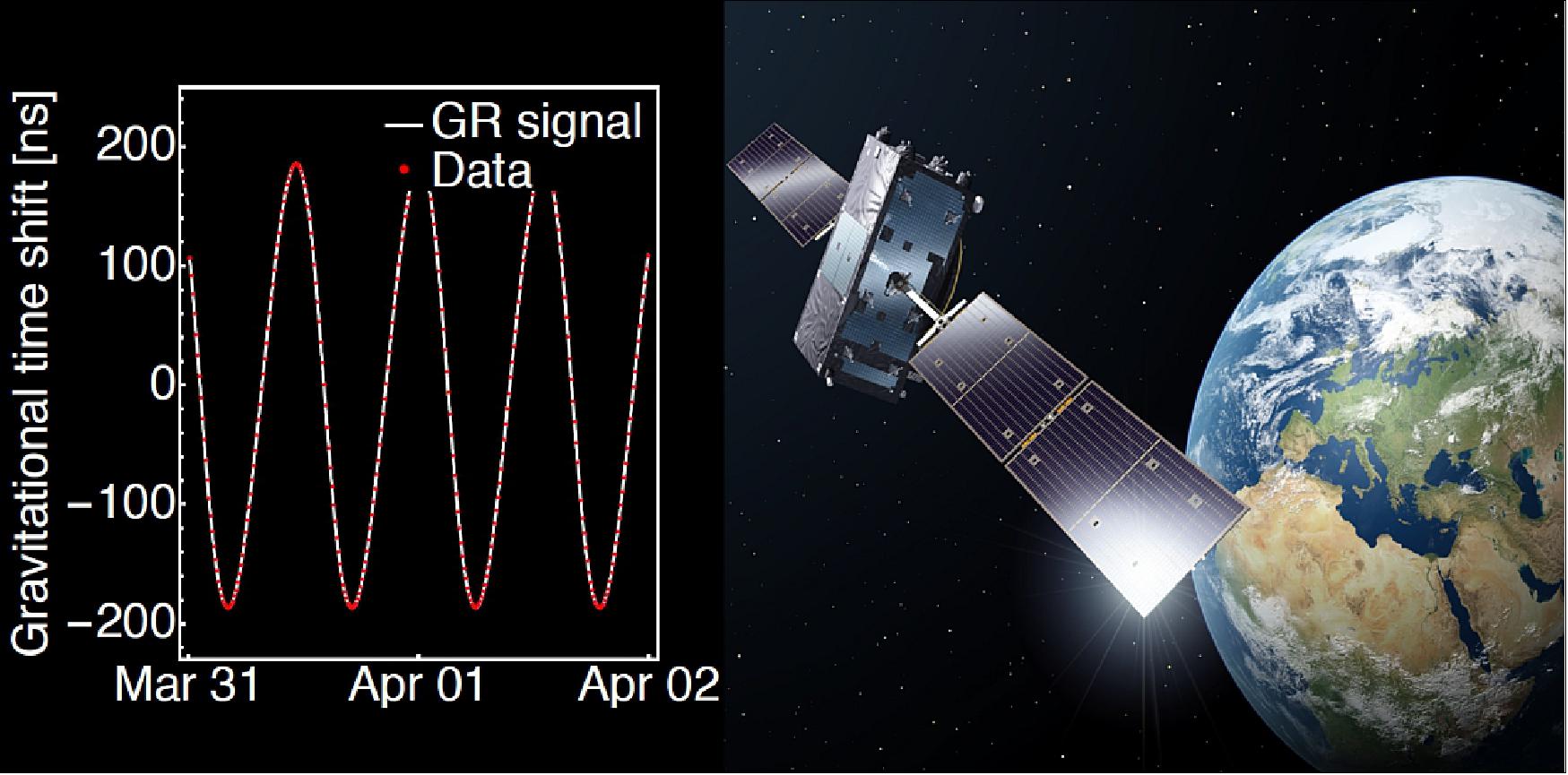
It is most satisfying for ESA to see that our original expectation that such results might be theoretically possible have now been borne out in practical terms, providing the first reported improvement of the gravitational redshift test for more than 40 years," comments Javier Ventura-Traveset, Head of ESA's Galileo Navigation Science Office.
"These extraordinary results have been made possible thanks to the unique features of the Galileo satellites, notably the very high stabilities of their onboard atomic clocks, the accuracies attainable in their orbit determination and the presence of laser-retroreflectors, which allow for the performance of independent and very precise orbit measurements from the ground, key to disentangle clock and orbit errors."
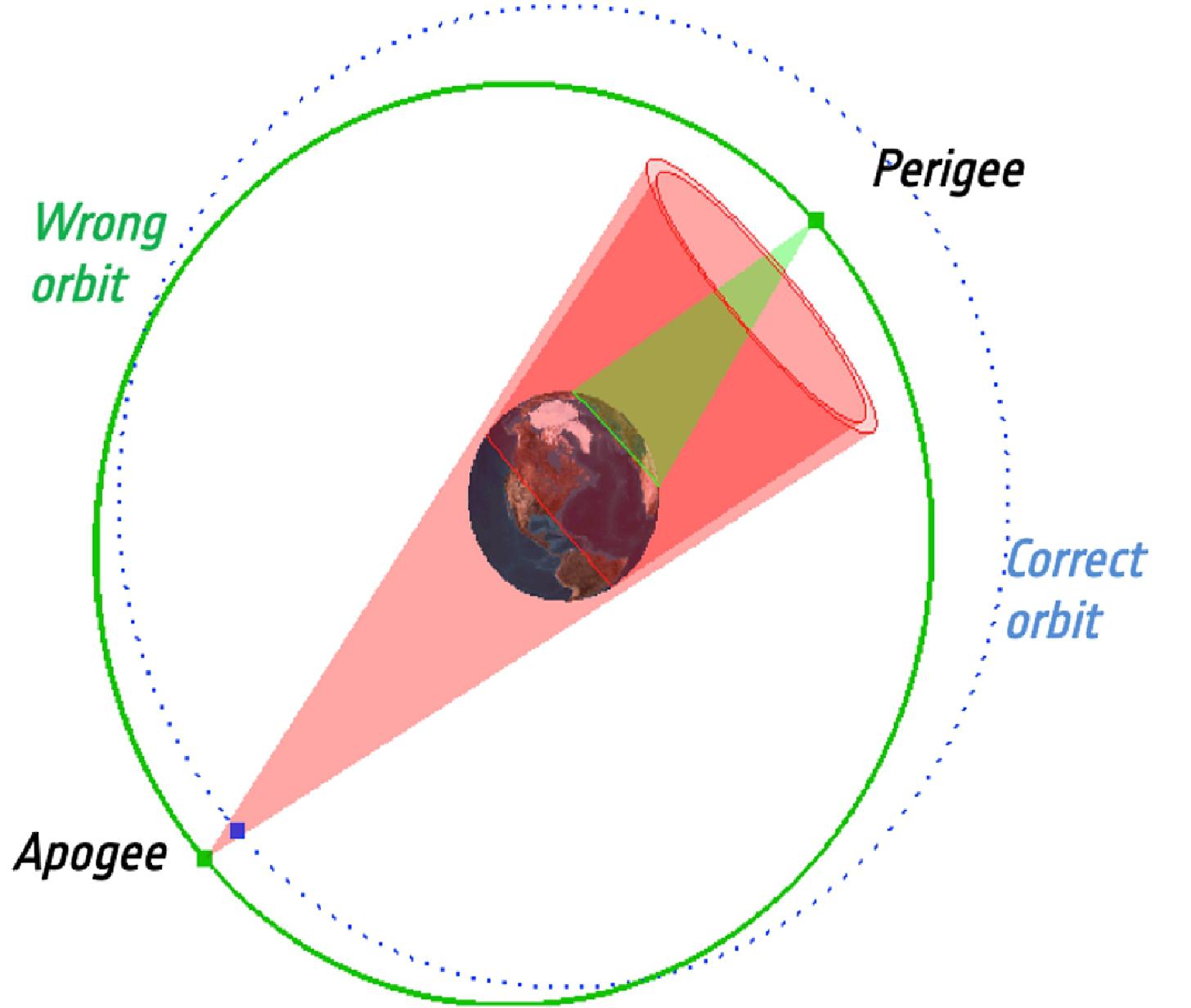
These parallel research activities, known as GREAT (Galileo gravitational Redshift Experiment with eccentric sATellites), were led respectively, by the SYRTE Observatoire de Paris in France and Germany's ZARM Center of Applied Space Technology and Microgravity in Bremen, coordinated by ESA's Galileo Navigation Science Office and supported through its Basic Activities.
Welcome Results from an Unhappy Accident
These findings are the happy outcome of an unhappy accident: back in 2014 Galileo satellites 5 and 6 were stranded in incorrect orbits by a malfunctioning Soyuz upper stage, blocking their use for navigation. ESA flight controllers moved into action, performing a daring salvage in space to raise the low points of the satellites' orbits and make them more circular.
Once the satellites achieved views of the whole Earth disc their antennas could be locked on their homeworld and their navigation payloads could indeed be switched on. The satellites are today in use as part of Galileo search and rescue services while their integration as part of nominal Galileo operations is currently under final assessment by ESA and the European Commission.
However, their orbits remain elliptical, with each satellite climbing and falling some 8500 km twice per day. It was these regular shifts in height, and therefore gravity levels, which made the satellites so valuable to the research teams.
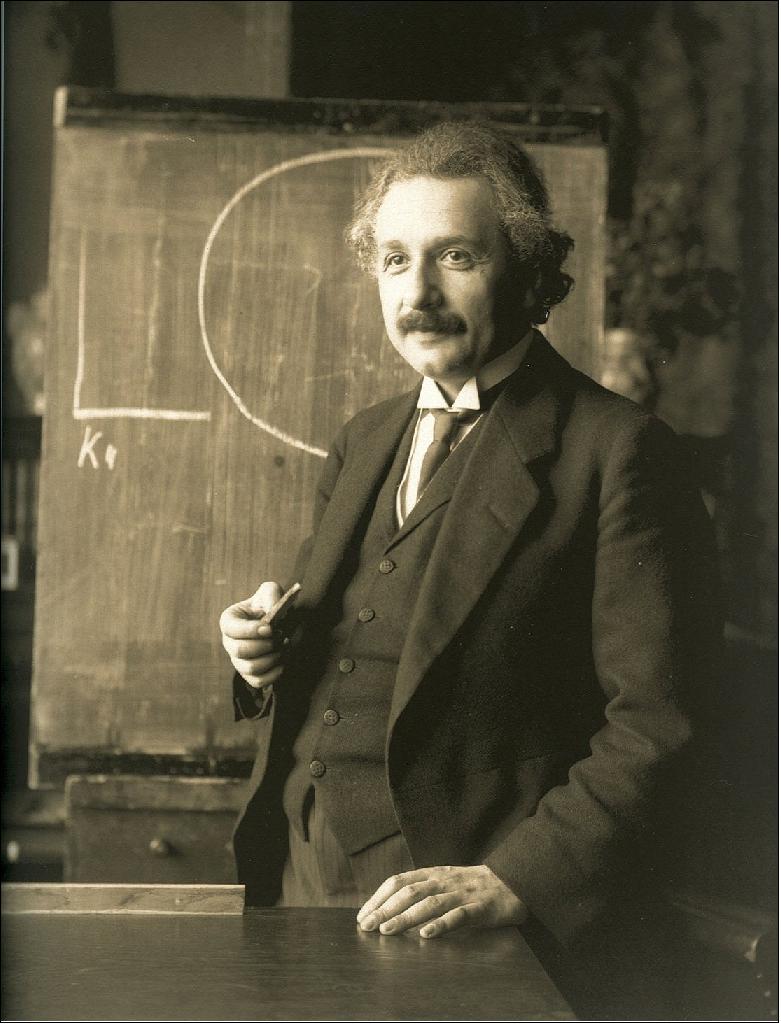
Reenacting Einstein's Prediction
Albert Einstein predicted a century ago that time would pass more slowly close to a massive object, a finding that has since been verified experimentally several times – most significantly in 1976 when a hydrogen maser atomic clock on the Gravity Probe-A suborbital rocket was launched 10,000 km into space, confirming Einstein's prediction to within 140 parts per million.
In fact, atomic clocks aboard navigation satellites must already take into account the fact that they run faster up in orbit than down on the ground – amounting to a few tenths of a microsecond per day, which would result in navigation errors of around 10 km daily, if uncorrected.
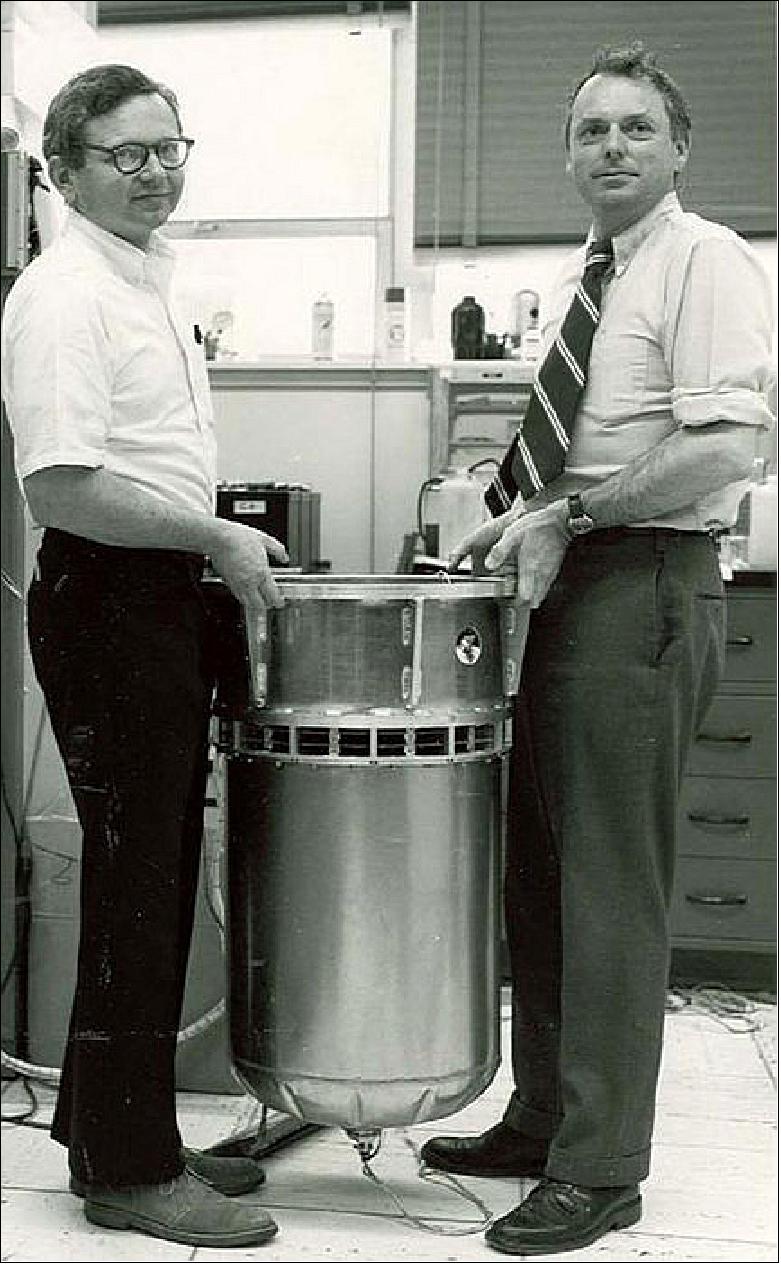
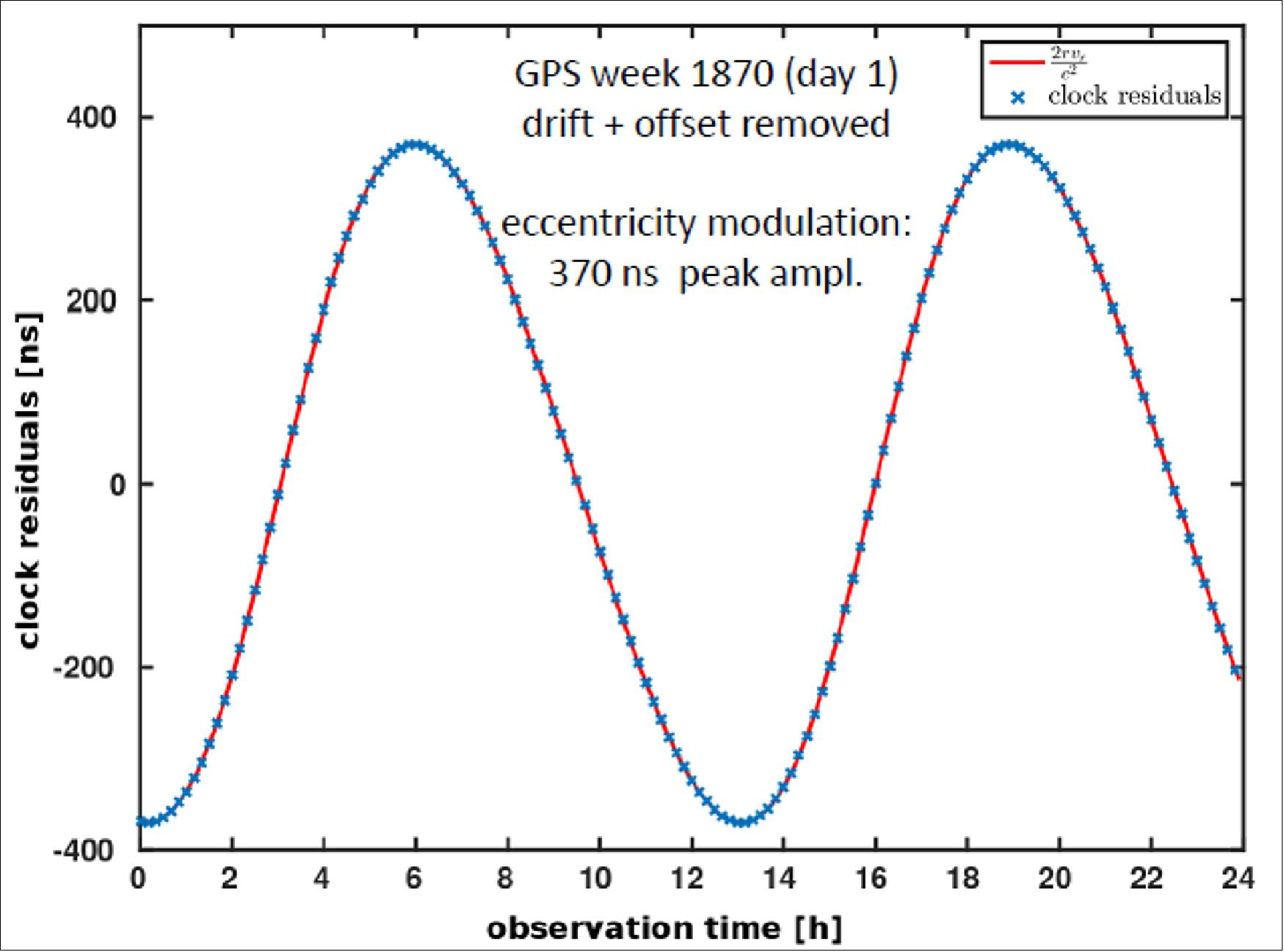
The two teams relied upon the stable timekeeping of the PHM (Passive Hydrogen Maser) clocks aboard each Galileo – stable to one second in three million years – and kept from drifting by the worldwide Galileo ground segment.
"The fact that the Galileo satellites carry passive hydrogen maser clocks, was essential for the attainable accuracy of these tests," noted Sven Hermann at the University of Bremen's ZARM Center of Applied Space Technology and Microgravity. "While every Galileo satellite carries two rubidium and two hydrogen maser clocks, only one of them is the active transmission clock. During our period of observation, we focus then on the periods of time when the satellites were transmitting with PHM clocks and assess the quality of these precious data very carefully. Ongoing improvements in the processing and in particular in the modelling of the clocks, might lead to tightened results in the future."
Refining the Results
A key challenge over three years of work was to refine the gravitational redshift measurements by eliminating systematic effects such as clock error and orbital drift due to factors such as Earth's equatorial bulge, the influence of Earth's magnetic field, temperature variations and even the subtle but persistent push of sunlight itself, known as ‘solar radiation pressure'.
"Careful and conservative modelling and control of these systematic errors has been essential, with stabilities down to four picoseconds over the 13 hours orbital period of the satellites; this is four millionth of one millionth of a second," Pacôme Delva of SYRTE Observatoire de Paris. "This required the support of many experts, with notably the expertise of ESA thanks to their knowledge of the Galileo system."
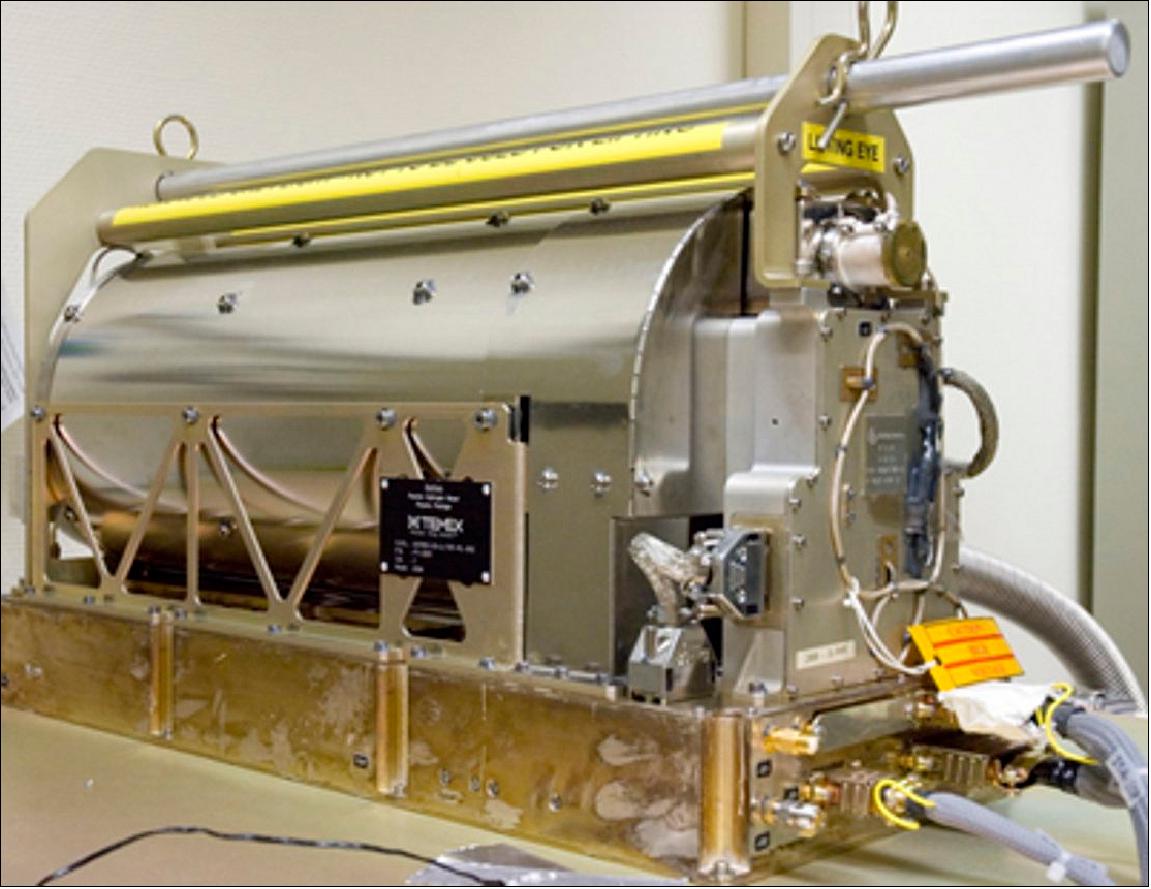
Precise satellite tracking was enabled by the International Laser Ranging Service, shining lasers up to the Galileos' retro-reflectors for centimeter-scale orbital checks.
Major support was also received from the Navigation Support Office based at ESA's ESOC operations center in Germany, whose experts generated the reference stable clock and orbit products for the two Galileo eccentric satellites and also determined the residual errors of the orbits after the laser measurements.
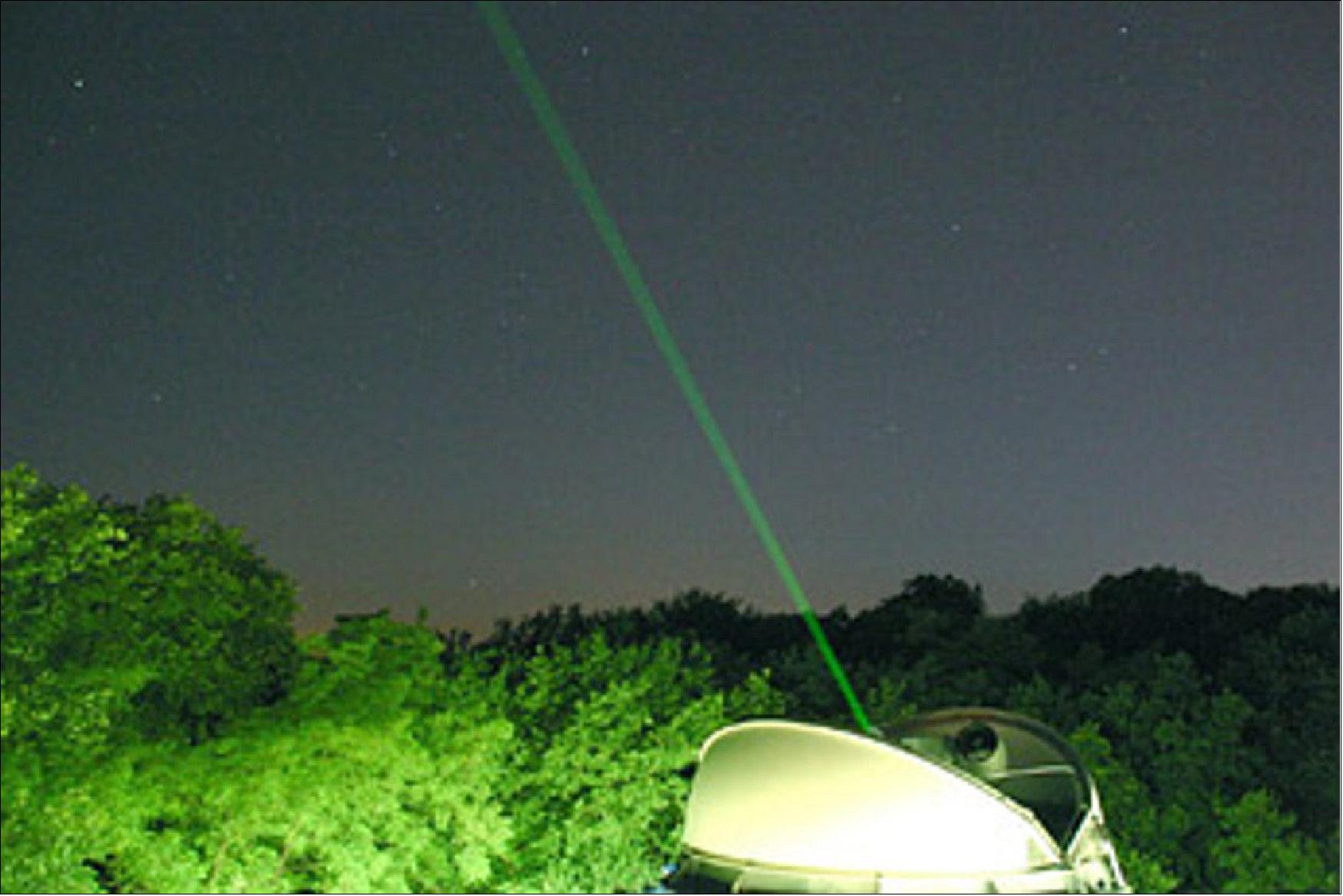
• November 9, 2018: ESA is setting up a new GSSC (GNSS Science Support Center) facility at ESA's ESAC (European Space Astronomy Center) near Madrid, Spain. Run by ESA's Galileo Science Office, the GSSC integrates IT and satnav infrastructure to deliver advanced data processing services to the scientific community. 70)
- Precisely timed to a few billionths of a second and highly stable, satnav signals can be used as a point of reference for many scientific sectors, including Earth and atmospheric sciences, astronomy, highly precise timing ‘metrology' as well as the study of relativity and other fundamental physics topics.
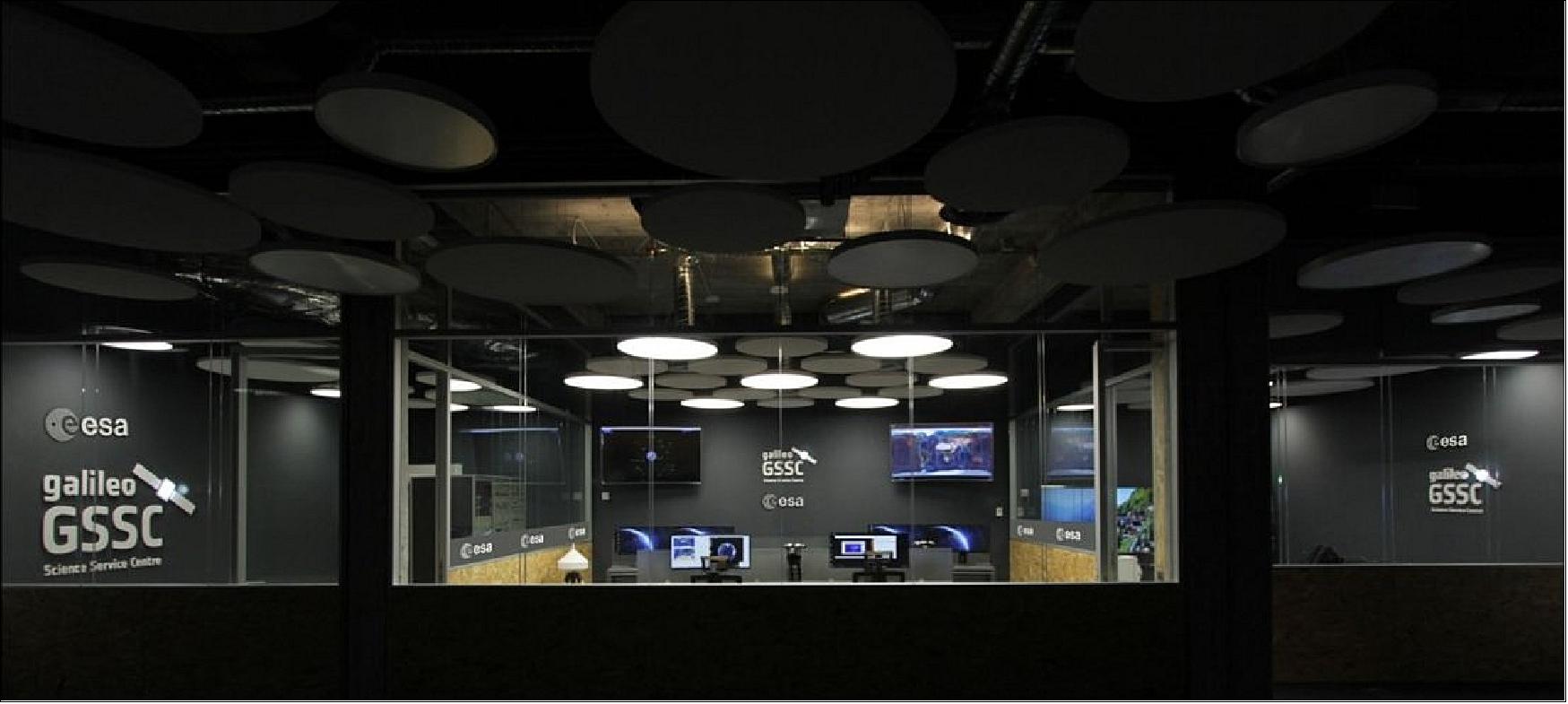
- Current satnav infrastructure plans worldwide should see more than 120 satnav satellites in orbit in coming years. This number includes Europe's own Galileo constellation – offering unique features such as its highly stable passive hydrogen maser atomic clocks, multiple transmission frequencies, robust modulation, wide bandwidth and onboard laser retro-reflectors, which permit exact pinpointing of the satellites' position in space down to a few tens of centimeters.
- "The potential of satnav for science has been recognized for a long time," explains Javier Ventura-Traveset, Head of ESA's Galileo Science Office. "The Galileo Science Office was set up in 2016 as a joint initiative between ESA's Science and Navigation Directorates, coordinating scientific opportunities through interaction with the scientific community and the independent GNSS Science Advisory Committee.
- "The opening of the new center is the next step. It is ESA's concrete answer to the need expressed by the scientific community for a ‘one-stop-shop' to offer researchers long-term GNSS data, products information, results of scientific experiments, plus services to enhance GNSS scientific research and collaboration.
- "The future evolution of the center will be driven by the interaction and feedback received from the scientific community, maximizing synergies with other GNSS data service providers from other institutions and research organization."
- Among the activities to be supported by the new GSSC are big data processing of large amounts of satnav data, crowdsourcing as a means of weather monitoring and a scientific assessment of satnav performance in Antarctica.
- It also supports the continuing measurements of general relativity using Galileo satellites 5 and 6 and serves as a global data center for the International GNSS Service. The long-established Navipedia website, giving technical information on satnav, is also hosted by the GSCC.
- One enthusiastic early adopter is ESA's Navigation Support Office, based at ESA's ESOC mission control center in Darmstadt, Germany, lending support to mission teams making use of satnav to steer satellites.
- "The GSSC is a welcome addition to ESA's activities in the science of satellite navigation," says Werner Enderle, heading ESOC's Navigation Support Office. "The GSSC already hosts GNSS products generated by the team at ESOC, including observations from our worldwide EGON GNSS Observation Network and precise satellite orbits generated by their state-of-the-art software. Our two teams look forward to this collaboration continuing for the benefit of ESA and the scientific community."
- The GSSC will roll out access to data, products and services over the coming months.
• October 18, 2018: Europe's 26 navigation satellites in orbit are providing Galileo Initial Services – available to users around the globe since 2016 – and a new ESA contract signing means these services will be delivered on a more accurate basis and more securely than ever. 71)
- ESA has awarded a new framework contract and two new work orders to Thales Alenia Space in France, to upgrade the Galileo Mission Segment – that element of the worldwide Galileo ground segment dedicated to delivering navigation services – and the Galileo Security Monitoring Center (GSMC) near Paris, as well as to implement a second GSMC in Spain, near Madrid.
- ESA Director of Navigation Paul Verhoef signed the contract with Thales Alenia Space Senior Vice President of Sales Martin van Schaik on 17 October 2018 at ESA/ESTEC in Noordwijk, the Netherlands.
- "Galileo has already proven to be the highest performing satellite navigation system in the world, even before the constellation is complete," the ESA Director commented. "This achievement is the result of the close collaboration between the public sector – the European Commission, the European GNSS Agency and ESA – and our industrial partners throughout Europe.
- "Today I am very happy to announce a continued relationship with Thales Alenia Space in one of the most complex parts of the system, namely the Ground Mission Segment, and thank them for their commitment to the program."
- The constellation in orbit is only one element of the overall satellite navigation system – the tip of the Galileo iceberg. At the same time as the satellites were being built, tested and launched, a global ground segment was put in place.
- Establishing Galileo's ground segment was among the most complex developments ever undertaken by ESA, having to fulfil strict levels of performance, security and safety. Last year responsibility for operating the Galileo ground segment was passed to ESA's partner organization, the European GNSS Agency (GSA). Nevertheless, ESA continues to be in charge of the maintenance, development and evolution of the ground segment, as well as the development of the space segment (see Figure 111).
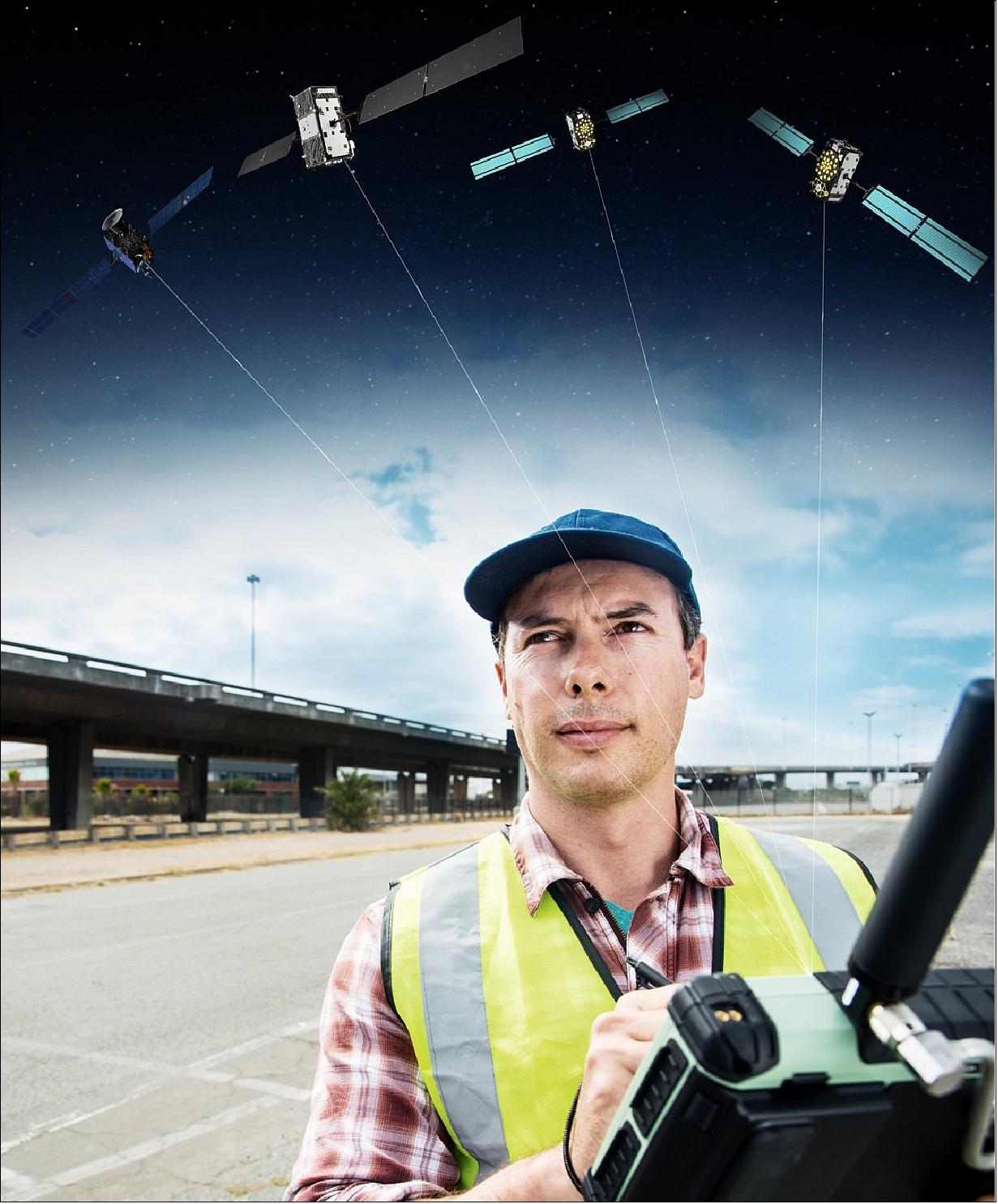
• October 2018: Galileo has made significant progress in recent years: twenty-six Galileo satellites are now orbiting the Earth, a significant part of the supporting ground station infrastructure has been deployed, and the European GSA (GNSS Supervisory Agency) has assumed the role of the Galileo Service Provider. 72)
- With the Declaration of Galileo Initial Services on the 15th of December 2016, the transition of Galileo from the testing and deployment phase to a system in service has started, and Galileo is now ready to be used. During this Initial Services provision phase, deployment activities towards Full Operational Capability continues in parallel. To support this service phase, the GSA has established a new service facility called the GRC (Galileo Reference Center) in Noordwijk, the Netherlands.
• September 21, 2018: Since the launch of Initial Services in December 2016, Galileo has been providing more and more users with global positioning, navigation and timing information. Behind this increase in use is the wide array of Galileo-enabled devices and services that have entered the market – including over 60 smartphone models in the past two years. Furthermore, as of April, all new types of cars sold in the EU must be equipped with Galileo as required by the eCall regulation. Galileo is also being increasingly used in drones to ensure smooth navigation and in Search and Rescue operations to save lives. 73)
- With this increased interest in Galileo, both the general public and industry want to know what devices are Galileo-capable.
- As new devices are constantly being added to the list, the GSA launched an enhanced version of its popular UseGalileo.eu website. The site allows users to easily search and keep track of Galileo-enabled devices as they become available.
- The enhanced site includes new categories covering applications in the timing, Internet of Things (IoT) and space application segments. Furthermore, other categories, such as aviation, emergency services and agriculture, now include a number of sub-categories. For example, within the aviation segment, users can narrow their search to Galileo-enabled devices and applications for avionics, airports and Unmanned Aerial Vehicles (UAVs). Flight operators can even search per their particular aircraft, whether that be a business jet, a helicopter or a commercial airliner.
- "We are proud to see how quickly Galileo is being embraced by European citizens and businesses," says GSA Executive Director Carlo des Dorides. "The enhanced UseGalileo site and its many segment-specific search functions is another example of how we keep the user at the center of European GNSS."
• September 18, 2018: An app that lets your smartphone work directly with Galileo and check performance from raw satellite signal measurements is now available for download from the Google Play Store. 74)
- Developed by ESA trainees in their spare time, the GNSS Compare app was the winner of an internal ESA competition this summer.
- "GNSS Compare is an open source tool making the lives of satnav developers and researchers easier," explains ESA young graduate trainee Mateusz Kraiński from Poland, who led the four-person ‘Galfins' development team. "We think of it as a research lab in your pocket."
- Mateusz explains that the new app shows details of which satellites your phone is using to perform its positioning, velocity and timing (PVT) calculations, along with their relative signal strength.
- "You can also choose between Galileo-only, GPS-only or Galileo plus GPS, as well as altering processing settings, to see how the positioning performance changes as a result – or else put your own prototype processing algorithms to the test. - In the past you would have to do this with expensive receivers or software-defined radios, but GNSS Compare lets users perform checks in a very simple way, using just the hardware in their pocket. It also has an educational aspect, because users can really ‘look under the hood' and see for themselves how the PVT process works in practice."
- The receiver chipsets inside smartphones compute positioning using multiple satellite constellations without regard for which satellites' signals are used, giving results but with no insight into how they are calculated, or the opportunity to choose which satellites to employ.
- The GNSS Compare app was made possible by the fact that newer Android smartphones can access the raw satellite signal measurements used to compute positioning.
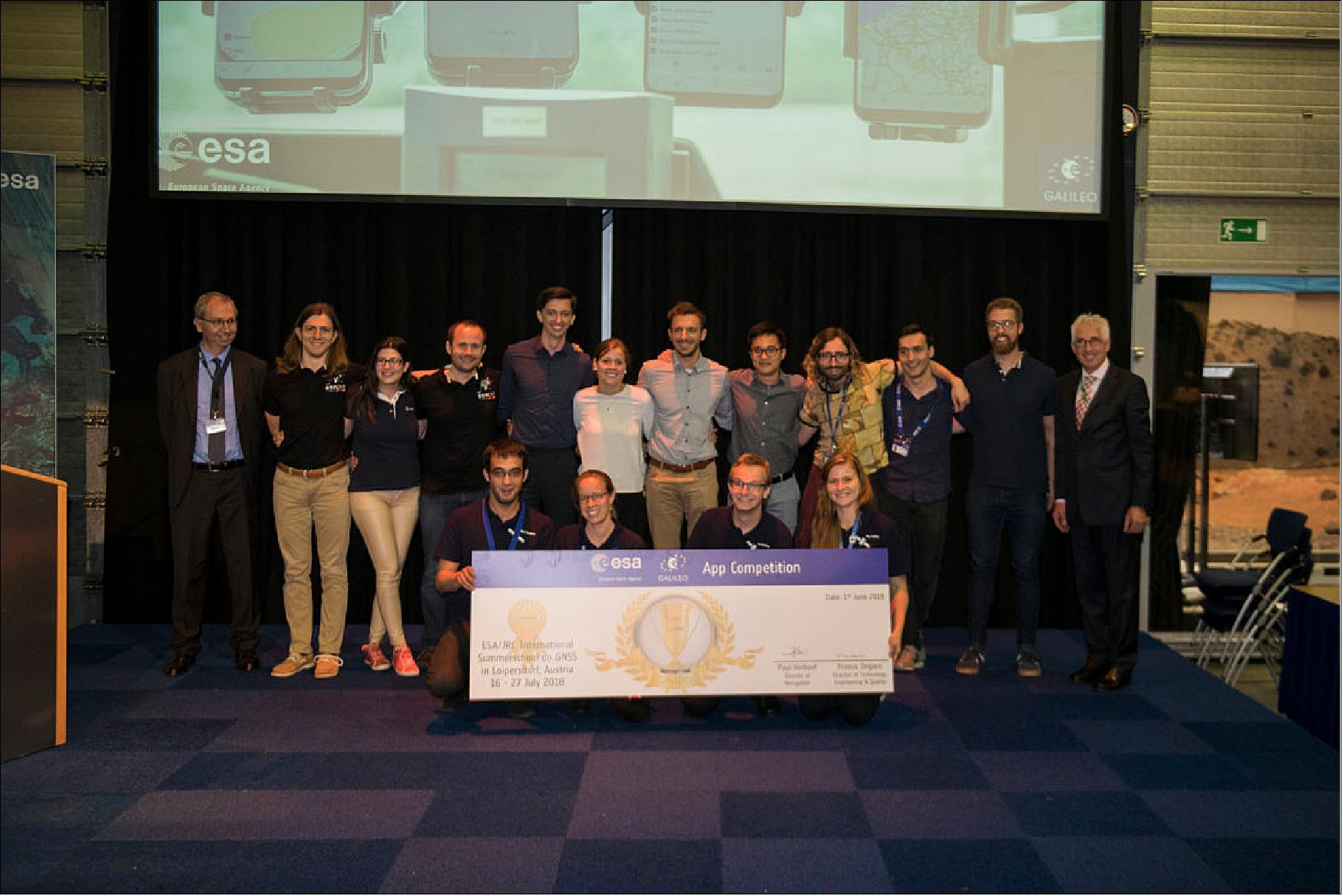
- "Last year, we took advantage of this change to introduce our inaugural Galileo Smartphone App Competition," says Nityaporn Sirikan of ESA's Navigation Directorate. We challenged ESA trainees to develop an app to perform satnav fixes using solely Galileo satellites," she explains. "Three teams developed apps in their spare time, each one targeting different user groups. They were judged by a jury of experts from the European Global Navigation Satellite Systems Agency – GSA – and Google as well as ESA. The response was very positive, and we are now planning a second competition."
- As a trainee at ESA/ESTEC in the Netherlands, Mateusz's dayjob has been focused on the European Robotic Arm, destined for the International Space Station. His fellow Galfins team trainees are Germany's Mareike Burba working on Earth observation, Romanian Sebastian Ciuban – the team's sole Navigation specialist – and Polish-born Dominika Perz, focused on satellite guidance, navigation and control.
- Their prize for winning was attending the ESA and European Commission-sponsored International Summer School on Global Navigation Satellite Systems in Austria.
• July 13, 2018: Europe's next Galileo satellites have been put in place on top of the Ariane 5 launcher due to lift them from Europe's Spaceport in Kourou, French Guiana on Wednesday 25 July (Figure 73). 75)
- "In preparation for their launch the four satellites were switched off, apart from their battery charging line and another maintenance power line to their PHM (Passive Hydrogen Maser) atomic clocks," reports Jean Verniolle, ESA's Galileo mission director for this launch.
- "Next Galileo satellites 23–26 were integrated one by one on four successive days onto the Galileo dispenser that will hold them securely in place for launch, and to form what we call the launch ‘stack'."
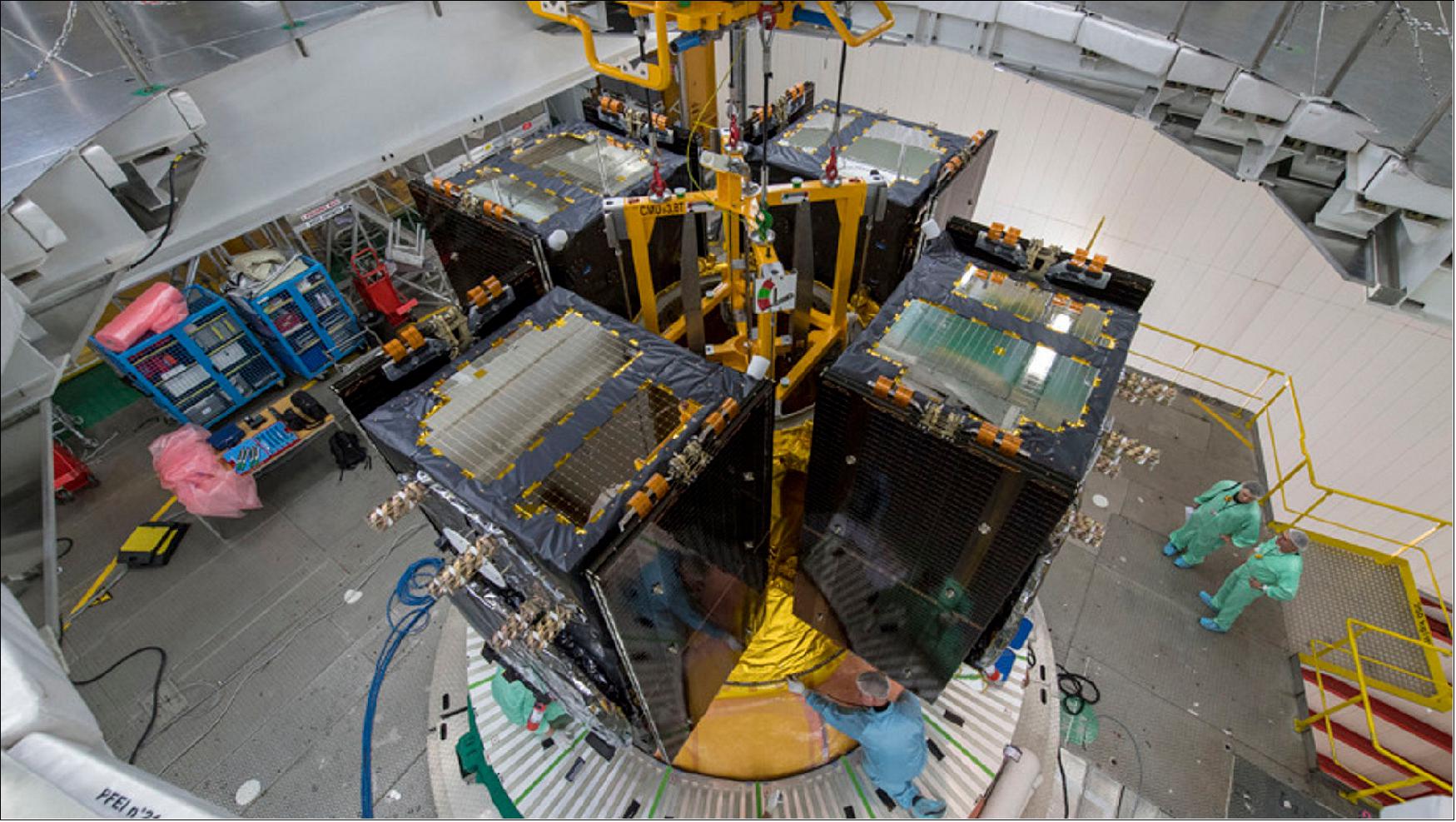
• July 11, 2018: An augmented reality view of Galileo satellites in the sky close to ESA's technical center in the Netherlands. It comes from a Galileo-focused satnav app for Android smartphones, developed by ESA engineers. 76)
- ESA ran an internal competition for its trainees to develop an app capable of making positioning fixes using only Galileo satellites.
- "As part of our support for the competition, we developed our own app on a voluntary basis to serve as a benchmark," explains Paolo Crosta of ESA's Radio Navigation Systems and Technology section. "We included this augmented reality view, so users can ‘see' the satellites their smartphone is using as they hold it up to the sky."
- The positioning calculations and assistance data functions for the app were developed by Paolo, with telecom engineer Tim Watterton contributing the main structure of the app, together with how it looks and its user interface.
- Tim adds: "The satellites are overlaid in real time on the camera view in their predicted positions in the sky, based on ‘ephemeris' information, assistance data that describes the current satellite orbits with high precision.
- "When a signal is being received, the satellite is shown in green, overlaying the predicted position. The satellite shown in red is one of the two placed in elongated orbits, but these satellites are expected to be used soon in the operational constellation. Satellites colored orange are transmitting, but the signal is not detected, which may be due to obstruction by terrain or buildings."
- Panning the phone around to position the crosshair over a green colored satellite adds additional information about it, such as its signal status, ‘pseudo-range' (the uncorrected distance the signal has travelled to reach the receiver) plus the satellite's manufacturer, launch date among other items. The reference app is now being tested with the hope of making it publicly available on the Android Play Store. The trainees are also testing their own apps following the competition with the goal of releasing them.
- There are 22 Galileo satellites in orbit, with four more satellites set for launch on 25 July.
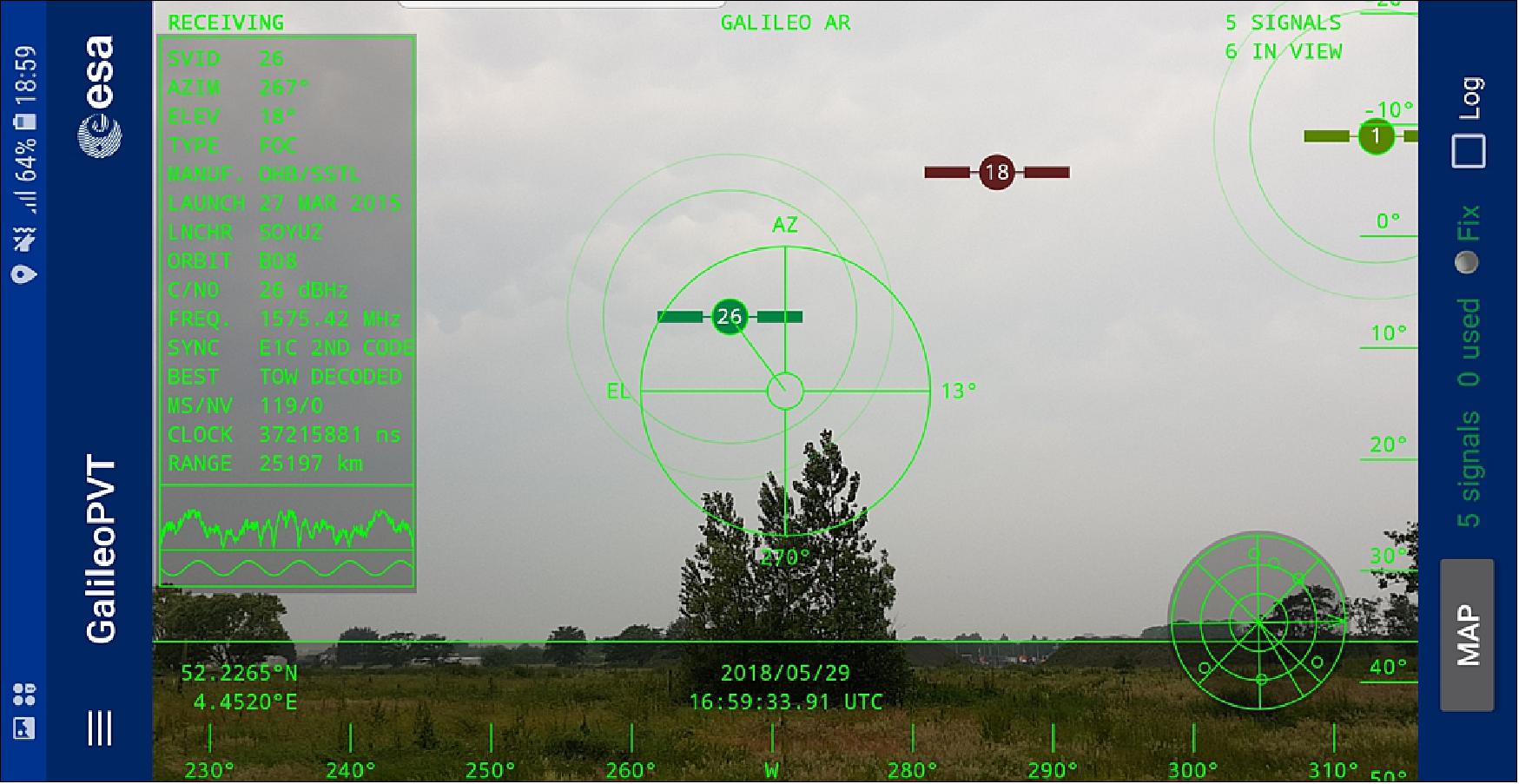
• July 2, 2018: Europe's satellite navigation system Galileo is already in use worldwide, usable by itself or in combination with the US Global Positioning System (GPS). Now a combined Galileo–GPS positioning fix has been achieved in space – aboard the International Space Station – through an ESA–NASA collaboration. 77)
- Low-Earth orbiting satellites routinely make use of satellite navigation signals to pinpoint their position in space and allow their paths through space to be fixed with extremely high accuracy, known as ‘precise orbit determination'.
- So far, such positioning has mainly been performed using GPS, but this new test proves it can also be achieved on a dual-constellation basis with both GPS and Galileo – as well as through the sole use of Galileo.
- The experiment is based on the use of a re-configurable NASA receiver called the Space Communications and Navigation Testbed, SCaN, attached to the exterior of the ISS.
- ESA's Navigation Support Office, based at its ESOC control center in Darmstadt, Germany, teamed up with its Radio Navigation Systems and Technology team, located at its ESTEC technical center in Noordwijk, the Netherlands, and Italy's NASCOM company to develop the techniques, software and firmware required for the experiment, which was passed to NASA's Glenn Research Center in Ohio for upload to the receiver.
- "SCaN is a versatile software-defined radio receiver in space for both telecommunications and navigation testing, delivered to the Station back in 2012," explains ESA radio-navigation engineer Pietro Giordano. "It made it possible, with suitable modifications, to demonstrate combined GPS-Galileo positioning determination of the ISS."
- The algorithm developed for the SCaN Testbed had to take account of the high dynamics involved, and resulting Doppler shifting of signals: not only are the Galileo and GPS satellites moving at orbital velocity, so is the ISS itself. Orbital information of all the satellites in both constellations was included in the algorithm, allowing SCaN to make a ‘warm start' – to search out signals in the correct segments of the sky.
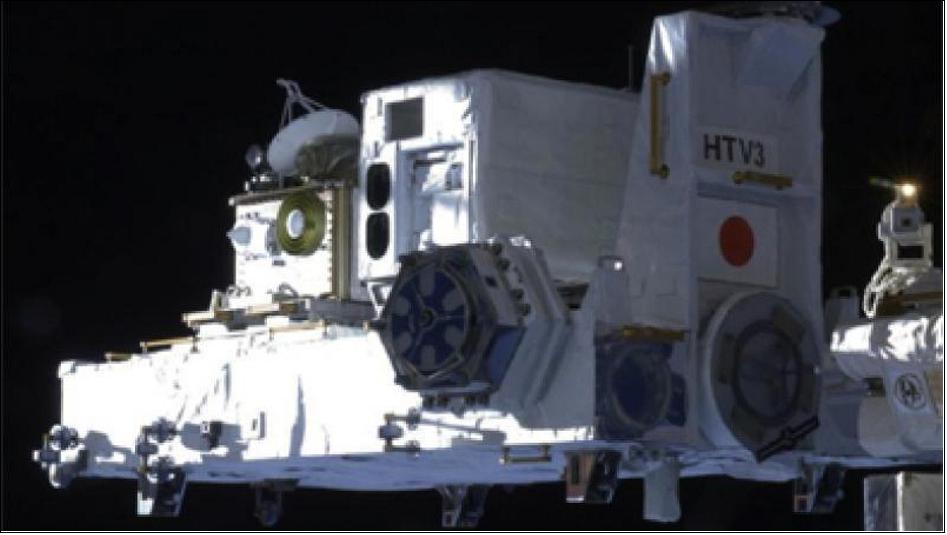
- "Dual constellation fixes offer many advantages for space, providing extremely robust and high-precision positioning," adds Pietro. "More signals become available overall, and the quality of the Galileo Open service and modernized GPS signals are extremely good."
- Werner Enderle, overseeing the project at the Navigation Support Office notes: "These excellent first results, coming out of great teamwork within ESA, collaboration with industry and with our NASA partners, mark just the beginning of our project data analysis. Many other exciting results are expected related to signal aspects, precise orbit determination and positioning based on optimized algorithms."
- James J. Miller, GPS Sr. Technologist within the SCaN program office at NASA Headquarters, comments: "We've been promoting interoperability of GPS and Galileo through a number of activities within the United Nation's International Committee on Global Navigation Satellite Systems (GNSS). In particular, NASA, with ESA and other national space agencies, has been identifying benefits to be gained for high altitude users in the multi-GNSS Space Service Volume under development. By further demonstrating multi-GNSS capabilities in low Earth orbit, the drive for additional utility at geostationary orbit and beyond is only strengthened".
- Europe's Galileo system began Initial Services for users in December 2016, and there are 22 Galileo satellites in orbit. The launch of four more Galileo satellites by Ariane 5 is scheduled for 25 July, bringing the constellation to 24 satellites plus two orbital spares.
- ESA is developing dual Galileo-GPS receivers for the next generation of Earth-observing Sentinel satellites. The more precise the orbit determination, the more accurate the environmental data that can be returned to Earth.
- Combined use of Galileo and GPS signals on an interoperable basis for positioning and precise orbit determination should bring significant advantages for space users in particular, set to provide a seamless navigation capability from low to high Earth orbits – and potentially beyond.
- Paul Verhoef, ESA's Director of Navigation, states: "This shows the versatility of the Galileo system and the use of the system for scientific and other purposes, way beyond traditional navigation services. We have also started work to determine whether we can use Galileo, in combination with GPS and other systems, for navigation to the Moon."
• June 7, 2018: ESA microwave engineers took apart an entire Galileo satellite to reassemble its navigation payload on a laboratory test bench to run it as though it were in orbit – available to investigate the lifetime performance of its component parts, recreate satellite anomalies, and test candidate technologies for Galileo's future evolution. 78)
- Located in the cleanroom environment of the Galileo Payload Laboratory – part of ESA's Microwave Lab based at its ESTEC technical center in the Netherlands – the new Galileo IOV Testbed Facility was inaugurated this week with a ceremony attended by Paul Verhoef, ESA Director of Navigation and Franco Ongaro, ESA Director of Technology, Engineering and Quality.
- Paul Verhoef congratulated the team and underlined the importance of ESA having these capabilities: "Such a navigation payload laboratory does not exist in industry. We foresee the testing and validation a number of very innovative ideas for the next series of Galileo satellites, before entering into discussions with industry in the context of the procurement of the Galileo Transition Satellites that has recently begun. This shows the added value of ESA as the design agent and system engineer of the Galileo system."
- "Our Lab has always been very responsive to the testing needs of the Navigation Directorate,' comments microwave engineer César Miquel España. Now this unique facility allows performance of end-to-end testing of a Galileo payload as representatively as possible, using actual Galileo hardware. We can also support investigations of any problems in orbit or plug in future payload hardware as needed. And because each item of equipment is separately temperature controlled we can see how environmental changes affect their performance."
- The Testbed began as an ‘engineering model' of a first-generation Galileo In-Orbit Validation (IOV) satellite, built by Thales Alenia Space in Italy for ground-based testing. It was delivered to ESTEC in August 2015, along with four truckloads of ground support equipment and other hardware.
- That began a long three-year odyssey to first take the satellite apart, then put it back together – akin at times to space archeology, since the satellite had been designed more than 15 years ago.
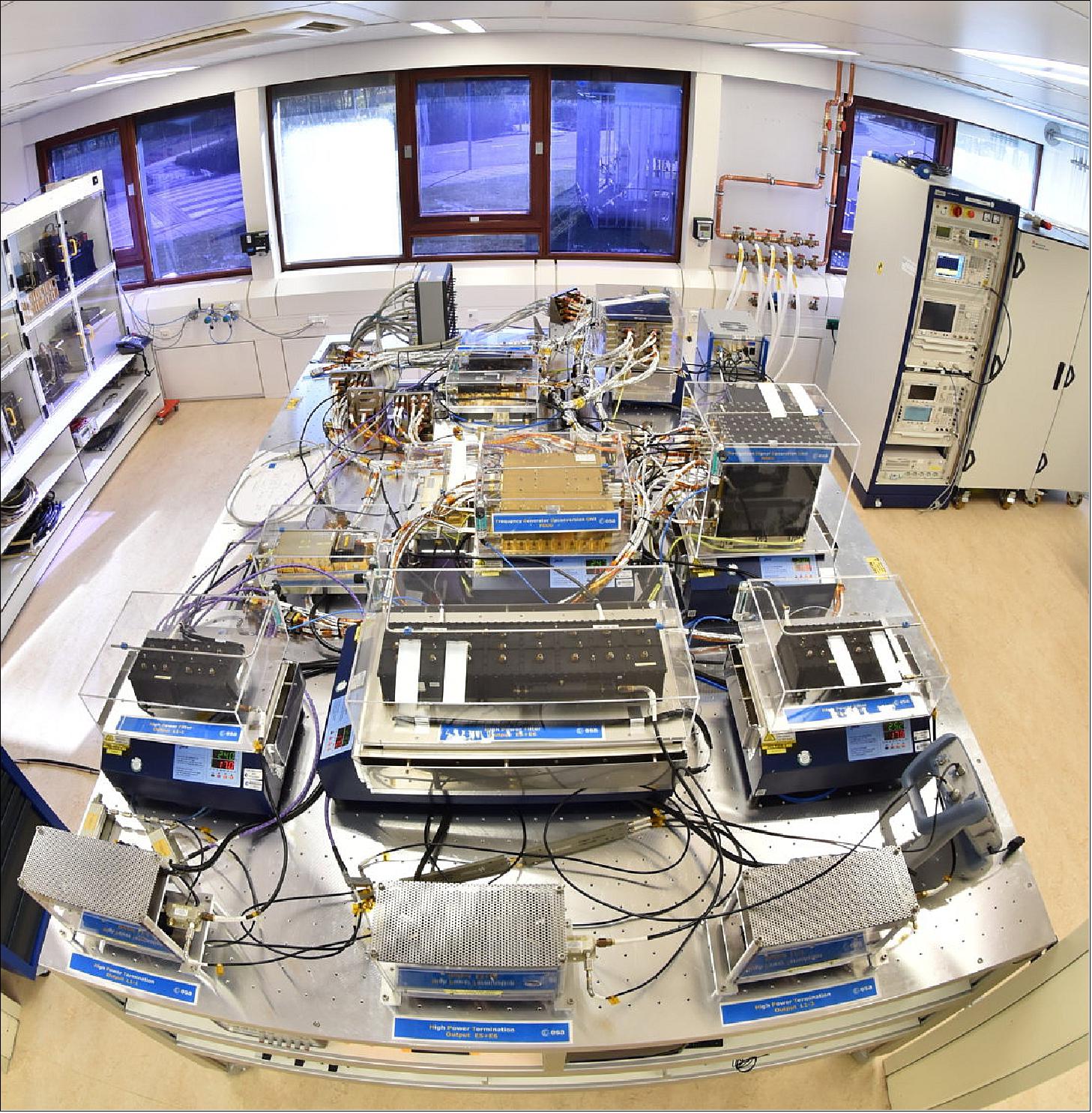
- "We found lots of documentation on how to integrate the satellite, but nothing on how to take it apart," adds technician Gearóid Loughnane. "We had to dismantle it very carefully over several weeks to remove the smaller items safely and take out the electrical harness, which ended up as a big spaghetti pile on the floor."
- The next step was to extricate the navigation payload from the satellite platform, and then begin to lay it out to connect it up again. A parallel effort tracked down supporting software from the companies involved, to be able to operate the payload once it was complete, as if it is orbiting in space.
- Valuable help came from Surrey Satellite Technology Limited in the UK, Dutch aerospace company Terma that developed Galileo software, and Rovsing in Denmark, supplying ground support equipment.
- "A big challenge was tailoring the spacecraft control and monitoring system to work only with the payload units while having to emulate the platform equipment" comments technician Andrew Allstaff.
- Comprising equipment produced by companies in seven separate European companies, the Testbed generates navigation signals using actually atomic clocks co-located in the lab, which are then upconverted, amplified and filtered as if for transmission down to Earth.
- The idea came from a GIOVE Payload Testbed already in the Lab, which simulates the performance of a test satellite that prepared the way for Galileo. As a next step the team hopes they can one day produce a Galileo ‘Full Operational Capability' Payload Testbed – the current follow-on to the first-generation IOV satellites.
• June 5, 2018: Galileo satellites 25 and 26 have landed at Europe's Spaceport in Kourou, French Guiana, joining their two predecessors ahead of their 25 July launch by Ariane 5. 79)
- The quartet of Galileo satellites, numbers 23, 24, 25 and 26 will be launched together on a customized Ariane 5 on 25 July – designated Flight VA244 by Arianespace. The vehicle will deploy its satellite passengers at a targeted orbital altitude of 23,222 km.
• May 9, 2018: The next two satellites in Europe's Galileo satellite navigation system have arrived at Europe's Spaceport in Kourou, French Guiana, ahead of their planned launch from the jungle space base in July. Galileo satellites 23 and 24 left Luxembourg Airport on a Boeing 747 cargo jet on the morning of 4 May, arriving at Cayenne – Félix Eboué Airport in French Guiana that evening. 80)
- They were then unloaded, still in their protective air-conditioned containers, and transported by truck to the cleanroom environment of the preparation building within Europe's Spaceport.
- This pair will be launched along with another two Galileo satellites, which are due to be transported to French Guiana later this month.
• March 15, 2018: Indra Sistemas of Madrid, Spain, has been awarded a contract for implementing four new ULS (Uplink Stations), thus expanding the ground segment of the European global positioning system, Galileo. Awarded by the company Thales Alenia Space (France), this contract also includes maintenance and upgrades for all Uplink stations. 81) 82)
- The Uplink Stations provide satellites with messages containing navigation data generated after verifying their onboard clocks and orbital positioning, which could be affected by solar winds or the gravitational fields of the Earth or Moon.
- Satellites can use these messages to send precise data to the growing number of mobile devices and positioning systems used by companies and individuals. A deviation in the data sent by merely one billionth of a second would amount to a positioning error of 30 cm on Earth. The data messages that these stations send therefore have a vital role in achieving the precision of the entire system.
- In addition to deploying the entire ULS network, Indra has also implemented all the Telemetry, Tracking and Control (TT&C) stations managing Galileo satellites. These stations are distributed at different points around the globe to ensure that satellites remain in permanent contact with at least one at all times for monitoring their positions and sending control orders.
- Indra engineers have implemented them in places such as Kourou (French Guiana), Kiruna (Sweden), Noumea (New Caledonia), Reunion Island (overseas department of France), Svalbard (Norway) and Papeete (French Polynesia).
- Galileo provides critical services that depend on the perfect operation of this system, including search and rescue operations at sea, which was one of the first services activated when the system was commissioned back in December 2016. Additional capabilities have gradually been included to address situations related to emergency and crisis response and management, shipping, navigation, construction, etc.
- Together with the control centers in Germany and Italy, the ULS and TT&C stations deployed by Indra are the key components in Galileo's ground segment.
- One of the planet's most precise systems: In addition to deploying these stations, Indra has also worked on the supply and deployment of Time and Geodetic Validation Facilities (TGVF) within the framework of the Galileo project. This component independently runs performance assessments on the Galileo system to ensure that it supplies correct information. The company handles this element of the Mission Center in Fucino (Italy). Indra also developed the mainframe computer's processing systems for the sensor station network (GSS) supporting the center.
- Indra is also co-leading the development of the EU's GNSS Service Center, which will be Galileo's point of contact with the end users of the system's open and commercial services, providing them with expertise, knowledge, and support. The center is set to be based at the National Institute of Aerospace Technologies (INTA) facilities at Torrejón de Ardoz (Madrid).
- To date, Galileo is the most ambitious space initiative promoted by the European Commission and the European Space Agency. Indra has participated in developing the entire ground infrastructure since the project's early phases.
• February 1, 2018: The Galileo satellite navigation system, Europe's rival to the United States' GPS, has nearly 100 million users after its first year of operation, the French space agency CNES said on 1 Feb. 2018. 83)
- The system, seen as strategically important to Europe, went live in December 2016, having taken 17 years at more than triple the original budget to get there.
- Initial services offered only a weak signal, and some of the atomic timekeepers on the satellites failed while two satellites were placed in the wrong orbit.
- But additional satellites have been added since, and by 2020 Galileo is supposed to offer much greater accuracy than GPS, pinpointing a location to within a meter, instead of several meters.
- Apple's latest iPhones as well as Samsung devices are Galileo-compatible, as are cars and other connected objects.
- CNES said airlines including Air France and Easyjet also plan to adopt the system.
- The Galileo program is funded and owned by the European Union, which no longer wants to rely on the military-owned competitors—GPS and Russia's GLONASS.
- Starting this year all new cars sold in Europe will be fitted with Galileo for navigation and emergency calls.
- Clients of a paying service will be able to receive even more accurate readings of down to just centimeters, aiding search-and-rescue operations and improving the safety of driverless cars.
• January 29, 2018: With Europe's Galileo satellite navigation system only one launch away from full global coverage, representatives of European industry gathered at ESA/ESTEC in the Netherlands to discuss the transition towards the future Galileo Second Generation. 84)
- Galileo Initial Services began on 15 December 2016, while the constellation in orbit has grown to 22 satellites. An Ariane 5 launch later this year of another quartet will bring the constellation to the point of completion with 24 satellites, plus two orbital spares.
- A steady stream of orbital spares, ready to replace satellites reaching the end of their operational lives, is necessary to ensure Galileo continues operating seamlessly. A further 12 satellites were therefore ordered from industry in June 2017.
- Looking further ahead, with the aim of keeping Galileo services as a permanent part of the European and global landscape, a replacement set of Galileo satellites will be required post-2020, serving as transition to a future generation.
- The Galileo Second Generation is foreseen to offer improved performance and added features. This is why the EC (European Commission) has decided on a Transition Program, with ESA in charge of its technical definition and implementation.
- Together with the EC and the European Global Navigation Satellite System Agency, ESA invited leading European space companies to its technical center in Noordwijk to discuss Galileo's future and present short-term plans in relation to this transition program.
- Having started with the ESA European Global Navigation Satellite System Evolutions Program (EGEP), the system and technology development of the Galileo Second Generation is being supported through the EU's GNSS and Horizon 2020 HSNAV Programs, with ESA being delegated its technical definition and management of its related implementation.
- Eleven Phase-B contracts were signed at the meeting for the Design Phase for both the Galileo Second Generation and the Transition Program, complementing the more than 50 technology contracts signed in 2017 to prepare for Galileo's future.
- In recent years, innovations have been analyzed and predevelopments performed in various technology fields (system, ground, space, receiver technologies) in order to assess their suitability for future Galileo activities, while ensuring backward compatibility and continuity of Galileo Services.
- In the next eight months, all major public and private stakeholders will be involved in the detailed assessment of the different evolution scenarios and associated technologies, in order to come to decisions on the Transition Program baseline for the evolution towards Galileo Second Generation.
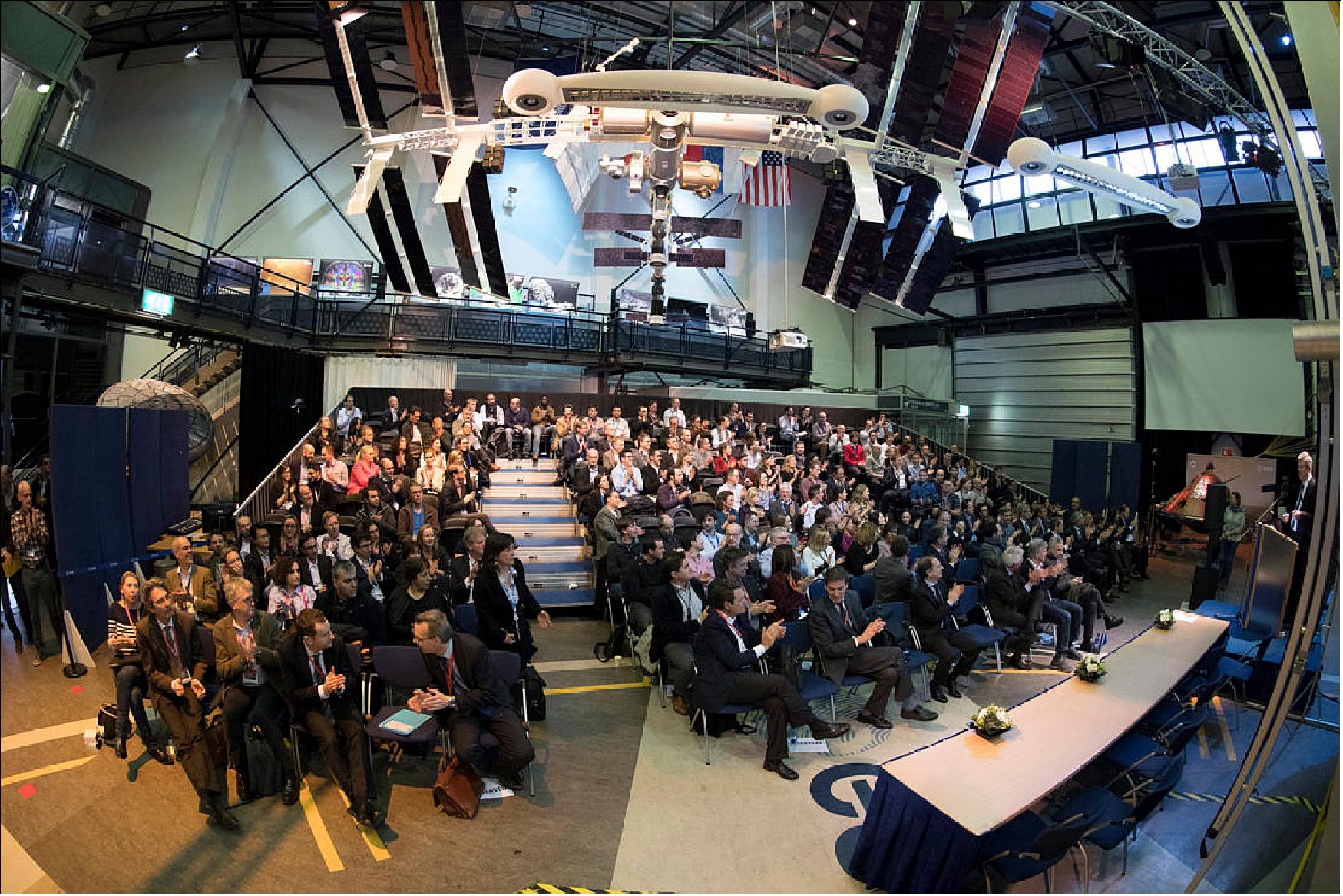
• July 4, 2017: Investigators have uncovered the problems behind the failure of atomic clocks onboard satellites belonging to the beleaguered Galileo satnav system, the European Commission said on July 2. 85)
- For months, the European Space Agency — which runs the program — has been investigating the reasons behind failing clocks onboard some of the 18 navigation satellites it has launched for Galileo, Europe's alternative to America's GPS system.
- Each Galileo satellite has four ultra-accurate atomic timekeepers, two that use rubidium and two hydrogen maser. But a satellite needs just one working clock for the satnav to work — the rest are spares.
- Three rubidium and six hydrogen maser clocks were not working, with one satellite sporting two failed timekeepers.
- "The main causes of the malfunctions have been identified and measures have been put in place to reduce the possibility of further malfunctions of the satellites already in space," commission spokeswoman Lucia Caudet said.
- ESA found after an investigation that its rubidium clocks had a faulty component that could cause a short circuit, according to European sources. The investigation also found that operations involving hydrogen maser clocks need to be controlled and closely monitored, the same sources said.
- The agency has taken measures to correct both sets of problems, the sources added, with the agency set to replace the faulty component in rubidium clocks on satellites not yet in orbit and improve hydrogen maser clocks as well.
- "The supply of the first Galileo services has not and will not be affected by the malfunctioning of the atomic clocks or by other corrective measures," Caudet said, and that the malfunctions have not affected service performance.
• June 22, 2017: Europe's Galileo navigation constellation will gain an additional eight satellites, bringing it to completion, thanks to a contract signed today at the Paris Air and Space Show. - The contract to build and test another eight Galileo satellites was awarded to a consortium led by prime contractor OHB, with Surrey Satellite Technology Ltd overseeing their navigation platforms. 86)
- This is the third such satellite signing: the first four In Orbit Validation satellites were built by a consortium led by Airbus Defence and Space, while production of the next 22 FOC (Full Operational Capability) satellites was led by OHB.
- These new batch satellites are based on the already qualified design of the previous Galileo FOC satellites, except for changes on the unit level – such as improvements based on lessons learned and reacting to obsolescence of parts.
- ESA's Director of the Galileo Program and Navigation-related Activities, Paul Verhoef, signed the contract with the CEO of OHB, Marco Fuchs and OHB Navigation Director Wolfgang Paetsch, in the presence of ESA Director General Jan Woerner and the EC's Deputy Director-General for Internal Market, Industry, Entrepreneurship and SMEs, Pierre Delsaux.
• June 8, 2017: Two further satellites have formally become part of Europe's Galileo satnav system, broadcasting timing and navigation signals worldwide while also picking up distress calls across the planet. These are the 15th and 16th satellites to join the network, two of the four Galileos that were launched together by Ariane 5 on 17 November, and the first additions to the working constellation since the start of Galileo Initial Services on 15 December. 87)
- The growing number of Galileo users around the world will draw immediate benefit from the enhanced service availability and accuracy brought by these extra satellites.
- The launch into space and the maneuvers to reach their final orbits still left a lot of rigorous testing before the satellites could join the operational constellation.
- Their navigation and search and rescue payloads had to be switched on, checked and the performance of the different Galileo signals assessed methodically in relation to the rest of the worldwide system.
- This lengthy testing saw the satellites being run from the second Galileo Control Center in Oberpfaffenhofen, Germany, while their signals were assessed from ESA's Redu center in Belgium, with its specialized antennas. The tests measured the accuracy and stability of the satellites' atomic clocks – essential for the timing precision to within a billionth of a second as the basis of satellite navigation – as well as assessing the quality of the navigation signals.
- Oberpfaffenhofen and Redu were linked for the entire campaign, allowing the team to compare Galileo signals with satellite telemetry in near-real time. — Making the tests even more complicated, the satellites were visible for only three to nine hours a day from each site.
- The satellites are now broadcasting working navigation signals and are ready to relay any Cospas–Sarsat distress calls to regional emergency services.
- Now that these two satellites are part of the constellation, the remaining pair from the Ariane 5 launch is similarly being checked to prepare them for service.
• June 02, 2017: Europe's Galileo satellite navigation system has undergone its first performance report since it started work at the end of last year – passing with flying colors. The European GNSS Agency, GSA, through its GNSS Service Centre, has published the first of its regular quarterly performance reports on Galileo. This ‘European GNSS (Galileo) Initial Services Open Service' report, now available online, covers the first three months of 2017, and documents the good performance of Galileo Initial Services to date. 88)
- The report shows the 11 satellites then operating in the Galileo constellation were able to provide healthy signals 97.33% of the time on a per satellite basis, with a ranging accuracy better than 1.07 m and disseminating global UTC time within its signal to within 30 billionths of a second on a 95 percentile monthly basis.
Satellite Code | SV ID (PRN) | CCSDS ID [hex] | Orbital Slot | Status |
GSAT-0101 | 11 | 3A5 | B05 | Available |
GSAT-0102 | 12 | 3A6 | B06 | Available |
GSAT-0103 | 19 | 3A7 | C04 | Available |
GSAT-0203 | 26 | 263 | B08 | Available |
GSAT-0204 | 22 | 264 | B03 | Available |
GSAT-0205 | 24 | 265 | A08 | Available |
GSAT-0206 | 30 | 266 | A05 | Available |
GSAT-0208 | 8 | 268 | C07 | Available |
GSAT-0209 | 9 | 269 | C02 | Available |
GSAT-0210 | 1 | 26A | A02 | Available |
GSAT-0211 | 2 | 26B | A06 | Available |
- "Galileo Initial Services were declared by the European Commission on 15 December 2016," comments Joerg Hahn of ESA's Galileo System Office. "It was thanks to the tremendous effort of ESA's Galileo team working closely together with colleagues from the Commission and GSA that this milestone could be achieved: the key pillars for reaching are the currently deployed Galileo satellites in combination with the global Galileo ground segment infrastructure, defined and implemented by the ESA team with their respective industry partners."
- The Initial Service performance levels (Figure 78) achieved by the system are monitored using two complementary monitoring platforms: the Time and Geodetic Validation Facility, an independent precision time-measuring system accurate to a billionth of a second – using an ensemble of atomic clocks located at ESA/ESTEC in Noordwijk, the Netherlands – and the GALSEE (Galileo System Evaluation Equipment), based in Rome, Italy.
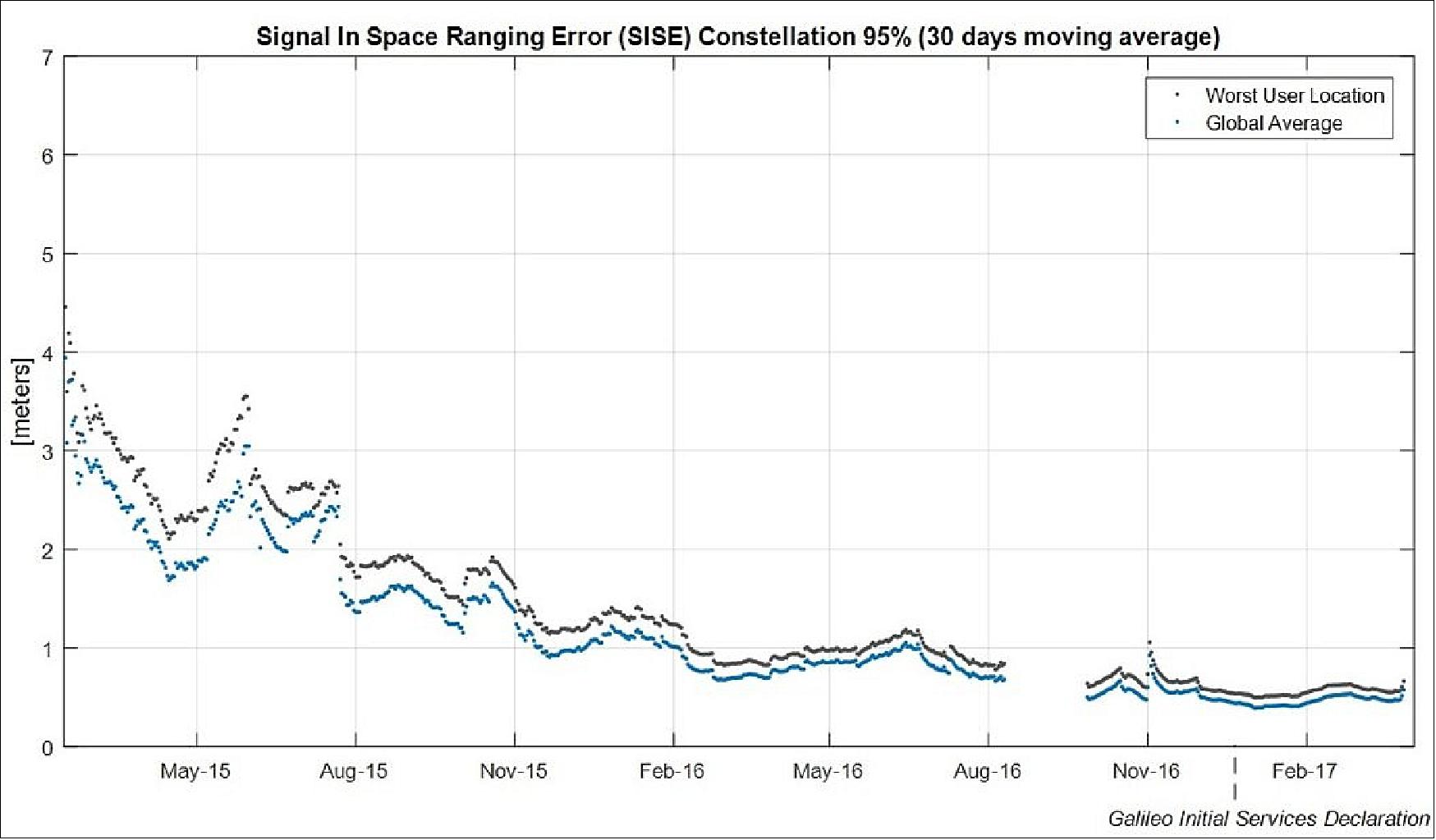
- In the future, the independent monitoring of the services will be carried out by GSA's Galileo Reference Centre, currently taking shape beside ESTEC in Noordwijk. The results for the first quarter of 2017 show the measured performances are generally far better than the minimum performance levels identified in the Service Definition Documents.
- "Looking back over the ranging accuracy of the Galileo constellation from the time of the very first positioning fix in 2014 to the present, the overall performance trend for the Open Service is very positive," adds Joerg Hahn. "It has reached values of less than 1 m in recent months, being already competitive with other satellite navigation systems. The high-quality ranging service enables user level positioning with a typical accuracy of around 3 m on the ground and 5 m in altitude during periods when four satellites are visible. With the limited infrastructure so far deployed, current horizontal position fixes can be achieved during more than 80% of the time with accuracies better than 10 m. This user level performance is expected to improve with the launch of more satellites making the provided Galileo services more accurate, more available and more robust for end users."
• March 28, 2017: Eutelsat and GSA (GNSS Agency) Europe signed an 18-year contract covering the preparation and service provision phases for the EGNOS (European Geostationary Navigation Overlay Service) GEO-3 payload that will be hosted on the Eutelsat 5 West B satellite that is due for launch late in 2018. The new payload marks a replenishment of current EGNOS capacity and is scheduled to start service in 2019 for 15 years. 89)
- EGNOS V3, the second generation of the EGNOS System, will implement a second protected frequency (L5) to offer to the dual frequency safety of life users a more robust and accurate vertical guidance service (increased robustness with respect to the ionosphere), according to the ESA's EGNOS V3 Phases C/D - Summary Statement of Work. Version 3 of EGNOS will add a second frequency (L5) and a second GNSS constellation (Galileo) to the GPS L1 corrections currently being provided by EGNOS.
- With the deployment of Galileo and the introduction of new capabilities in GPS, EGNOS V3 will offer improved SoL (Safety of Life) services to the civil aviation community as well as potential new applications for maritime or land users, thus showcasing the system's increased potential to become a leading edge GNSS system in the future.
- EGNOS operational messages are currently broadcast via navigation payloads on-board two GEO satellites, including an Inmarsat-3F2 satellite that is fast approaching end-of-life. The GEO-3 services will replenish the EGNOS SBAS payloads, guaranteeing EGNOS SIS availability and supporting the transition to the dual-frequency multi-constellation-capable EGNOS V3.
• February 28, 2017: Vidal Ashkenazi, a leading authority and advocate of Europe's Galileo satellite navigation system has been named as an Officer of the Order of the British Empire by Her Majesty Queen Elizabeth II for services to science. 90) 91)
- Vidal Ashkenazi is an expert in geodesy, the science of Earth measurement, as well as satellite navigation, with a 33 year academic career at the University of Nottingham in the UK.
- As the founding Director of the Institute of Engineering Surveying and Space Geodesy, Prof. Ashkenazi has supervised about 50 PhD students, most of whom occupy senior positions in industry and academia worldwide. In 1998 he left the University to found Nottingham Scientific Ltd, a company that specializes in Global Navigation Satellite System critical applications, involving safety, security and national policy.
- In 1976 he was invited by the US National Academy of Science to come to the US National Geodetic Survey to help develop a standardized coordinate system for mapping and satellite navigation. He contributed to the development of a standard geodetic coordinate system for satellites, known as WGS84 (World Geodetic System 1984), today in common global use.
- In the late 1990s this led to the resurveying of all the major airports around the world to the WGS84 standard. At the request of Eurocontrol, he was directly involved in carrying out this task across the UK and in continental Europe.
- Prof. Ashkenazi also played an important role as Galileo began to take shape, for example by leading the group of academic experts in the European Commission's GNSS-2 Forum in 1998, gathering together all the major European experts in the field. His direct advocacy proved influential, when in 2003 he addressed the European Parliament's Industry, External Trade, Research and Energy Committee on why Europe needed its own satellite navigation system.
- Drawing on his transatlantic contacts, he was invited to the US Department of Commerce to address a senior US government and industrial audience on Galileo. He did this by giving a presentation entitled "Galileo: Friend or Foe?" promoting an approach of partnership rather than competition between GPS and Galileo that has indeed come to pass.
- In 2005, the then Director of Navigation at ESA invited Prof. Ashkenazi and his company to make the first study on Galileo evolution, known today as the post-2020 Galileo Second Generation.
• January 19, 2017: ESA is reporting that anomalies have been noted in the atomic clocks serving Europe's Galileo satellites. Anomalies have occurred on five out of 18 Galileo satellites in orbit, although all satellites continue to operate well and the provision of Galileo Initial Services has not been affected. 92)
- Highly accurate timing is core to satellite navigation. Each Galileo carries four atomic clocks to ensure strong, quadruple redundancy of the timing subsystem: two RAFS (Rubidium Atomic Frequency Standard) clocks and two PHM (Passive Hydrogen Maser) clocks. - The current Galileo constellation consists of 18 satellites in orbit, adding up to a total of 36 RAFS clocks and 36 PHM clocks.
- RAFS clocks: In recent months a total of three RAFS clocks unexpectedly failed on Galileo satellites – all on FOC (Full Operational Capability) satellites, the latest Galileo model. These failures all seem to have a consistent signature, linked to probable short circuits, and possibly a particular test procedure performed on the ground, with investigations continuing to identify a root cause.
- No RAFS clock failures have occurred aboard the four Galileo IOV (In Orbit Validation) satellites, the original Galileo model. In addition the RAFS clock on ESA's very first test navigation satellite, GIOVE-A launched in 2005, has been checked, and was reactivated successfully.
- Continuing investigations on the ground have identified potential weaknesses in the RAFS clock design, but no root cause has yet been yet established.
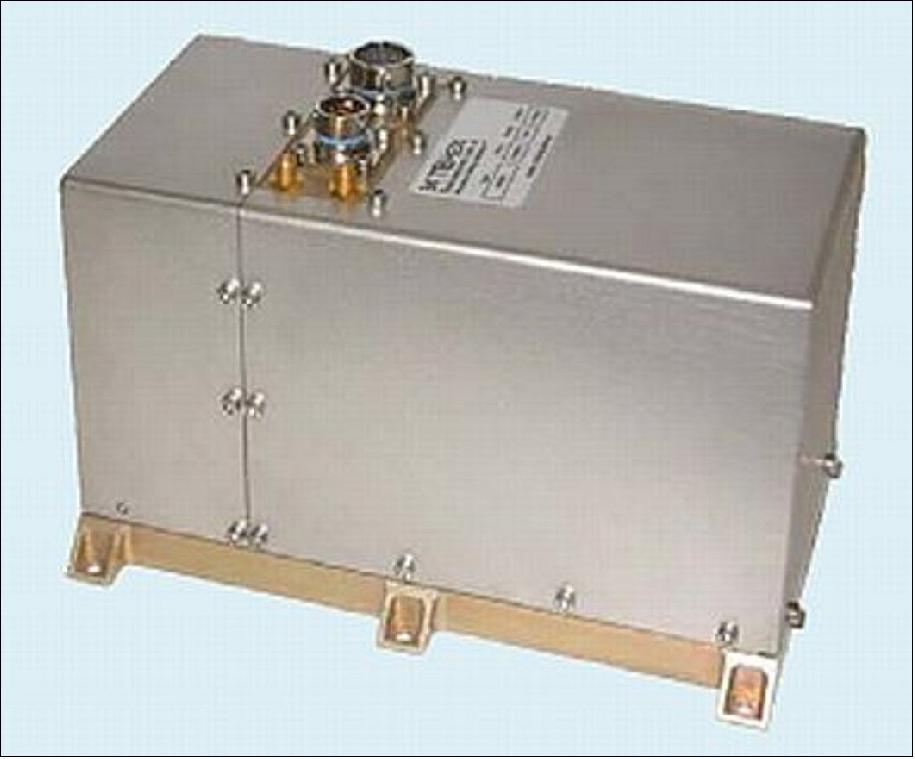
- PHM clocks: In the past two years, there have been five PHM clock failures on the IOV satellites and one PHM failure on the FOC satellites. These failures are better understood, linked to two apparent causes. One is a low margin on a particular parameter that leads, on some units, to a failure. The second is related to the fact that when some healthy PHM clocks are turned off for long periods, they do not restart because of a change in clock characteristics in orbit. To date, two PHM clocks have failed owing to the first mechanism, and four to the second.
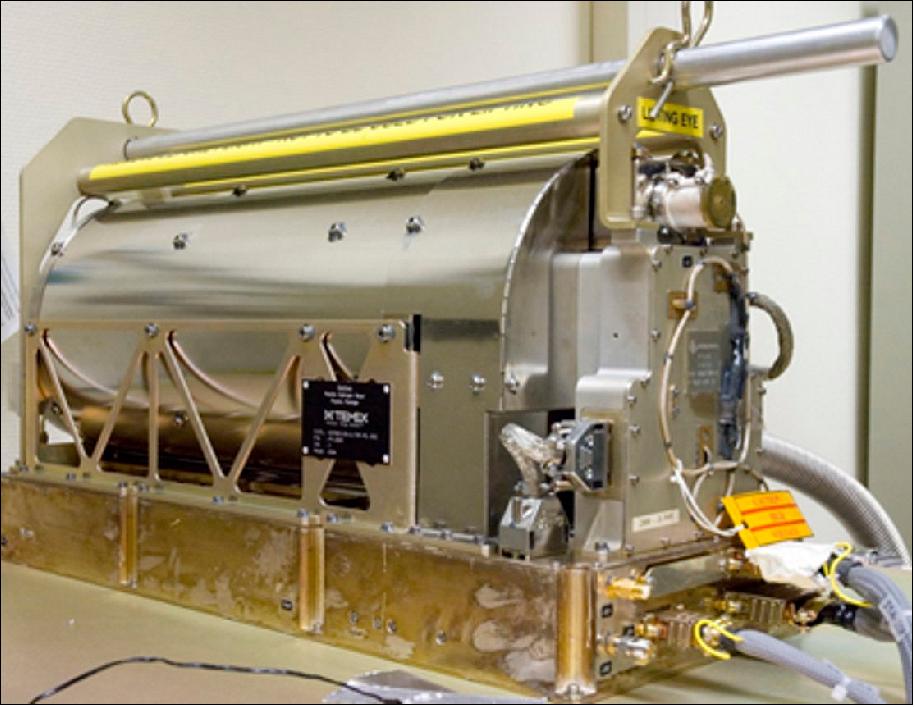
- Corrective actions: For the remaining 33 RAFS clocks in orbit, the risk of failure is believed to be lower owing to different testing procedures on the ground before launch. In addition, new operational measures have been put in place to further mitigate the risk. All these measures have no effect on Galileo's overall performance.
- While investigations by ESA and its industrial partners are continuing, there is consensus that some refurbishment is required on the remaining RAFS clocks still to be launched on the eight Galileo satellites being constructed or tested, and awaiting launch.
- For the remaining 30 PHM clocks working in orbit, operational procedures are being studied to significantly reduce the risk of future failure. These measures are being validated, ahead of their planned introduction in a few weeks.
- Looking forward: Overall, three out of four IOV satellites have experienced clock anomalies, and two out of 14 FOC satellites. — As ESA Director General Jan Woerner commented during his 18 January press briefing, no individual Galileo satellite has experienced more than two clock failures, so the robust quadruple redundancy designed into the system means all 18 members of the constellation remain operational. This includes one satellite that supports only the Open Service for mass market applications, and two satellites in elliptical orbits that are nevertheless expected to be reintegrated into the full constellation for use from these orbits.
- Similarly, Galileo's Initial Services, which began on 16 December, have been unaffected by these anomalies.
- The impact of RAFS and PHM clock refurbishment on Galileo's launch schedule is under study, but ESA is confident that the clock issues will be resolved and remains committed to launch the next four Galileo FOC satellites before the end of this year.
• January 17, 2017: Brad Parkinson, hailed as the father of GPS, has visited ESA's technical heart to meet the team behind Europe's Galileo satellite navigation system. — Brad Parkinson was awarded the 2016 Marconi Prize for his part in developing satellite navigation. In 1972, then a US Air Force Colonel, he was put in charge of ‘Program 621B', which became the Global Positioning System. Over one long September weekend in 1973 he and his team decided all key GPS elements. The first satellite was launched in February 1978. 93)
- Paul Verhoef, ESA's Director of the Galileo Program and Navigation-related Activities, invited Prof. Parkinson to ESA's facility in the Netherlands to address the Directorate's annual gathering on 11 January. Also present were members of the European Global Navigation Satellite System Agency – set to oversee newly operational Galileo services – and the European Commission.
- Brad Parkinson congratulated the Galileo team on their achievement: "Back around the turn of the century, there were elements in the US government who were extremely opposed to Galileo. I didn't see it that way. Instead, I regarded it as largely inevitable, and that another constellation of reliable navigation satellites would be of enormous value to users across the entire world. That's really the noble goal behind all this, not GPS or Galileo individually, but PNT – providing position, navigation and timing services to everyone.
- "I was privy to some early discussion on Galileo, and there were some Europeans saying they didn't want anything like GPS. But there were a number of experts pointing out all the time and effort that had gone into defining GPS and frankly they responded that the GPS system was pretty near optimal. — Today, all four current constellations work much the same way. Even the Russians, with GLONASS, who went with a different signal structure – using FDMA (Frequency Division Multiple Access) with separate satellites using different frequencies – are moving towards the CDMA (Code Division Multiple Access) used by the other systems, meaning different satellites use the same frequencies with coding to differentiate them."
- GPS and Galileo utilize complementary signal modulations to enable seamless combined use. Negotiations are under way to provide the US government with access to Galileo's PRS (Public Regulated Service), the most precise and secure class of the Galileo signal.
- Satellite navigation has come far from its military origin: there are billions of satnav receivers in use today. Brad Parkinson is not surprised: as a Professor at California's Stanford University, he and his students pioneered many applications, including the first GPS-steered tractor for precision agriculture, and a blind GPS-guided aircraft landing back in 1992.
- "There are misapprehensions on this, but from day one GPS was conceived as a military/civil system – I testified to Congress accordingly back in 1975."
- "The sheer diversity of uses has been surprising. Surveyors were early adopters, with land surveying that used to take days or weeks being performed within hours, while geologists have gained enormous understanding of earthquakes and the like by measuring ground motion of a few millimeters annually."
- "Looking ahead, within 15 years many human-operated vehicles – automobiles, trucks, aircraft and ships – will be self-driving, with one essential element being satellite navigation." - One pleasant surprise has been the extremely precise ranging achieved through ‘realtime kinematics' and other advanced signal processing methods.
- But Brad Parkinson warned that such achievements will be at risk if adjacent radio frequencies are turned over to terrestrial users, potentially leading to overlapping interference several billion times stronger than the faint satellite signals.
- "It's a creeping obligation, internationally, to defend the radio spectrum in order to assure PNT (Position Navigation and Timing) to users worldwide, in order to nurture and support new uses of satellite navigation."
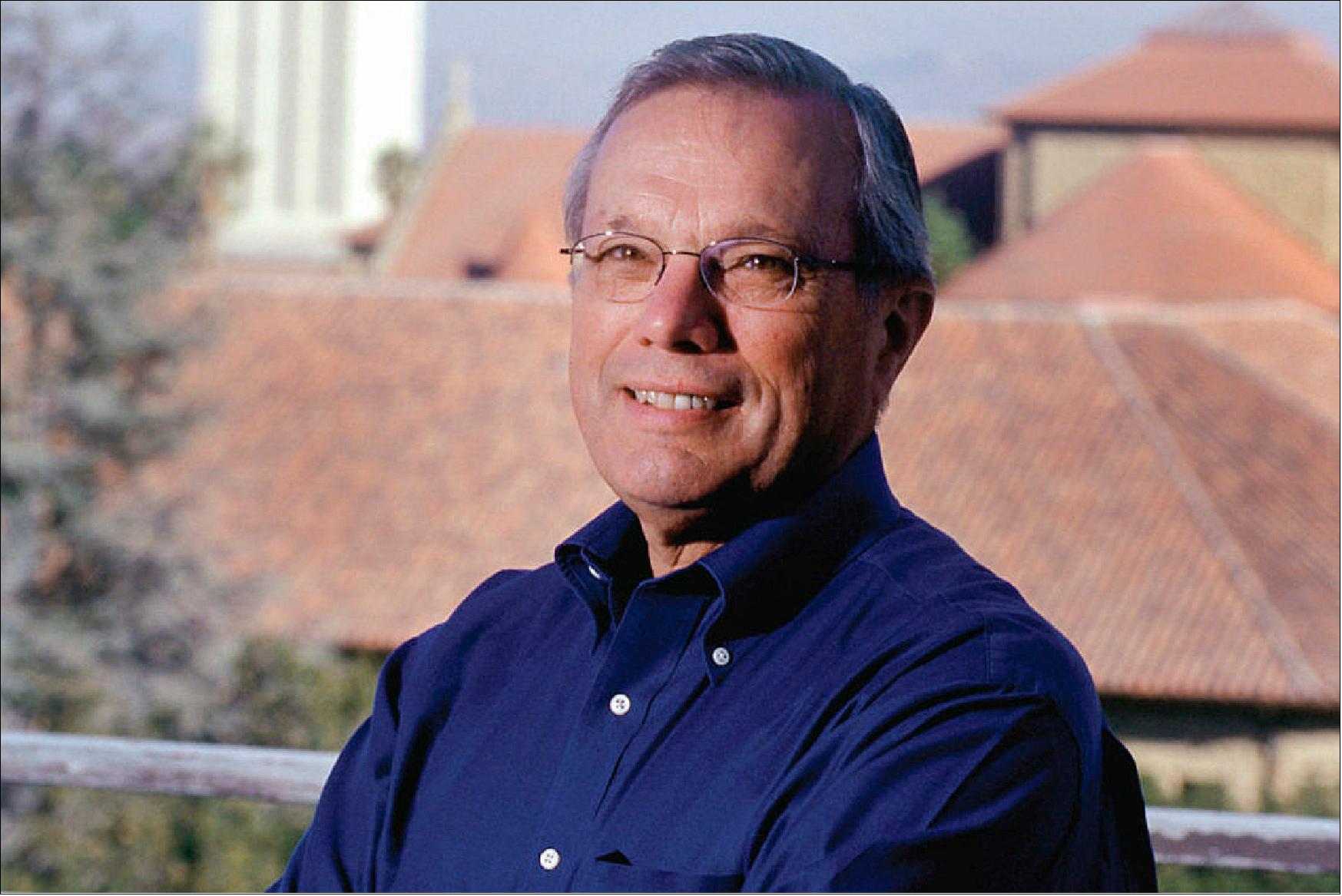
• December 15, 2016: Europe's Galileo satellite navigation system has entered its initial operational phase, offering positioning, velocity and timing services to suitably equipped users around the globe. Today, the European Commission, owner of the system, formally announced the start of Galileo Initial Services, the first step towards full operational capability. 94)
- After five years of launches there are now 18 satellites in orbit. The most recent four, launched last month, are undergoing testing ahead of joining the constellation next spring. The full Galileo constellation will consist of 24 satellites plus orbital spares, intended to prevent any interruption in service.
- ESA Director general Jan Woerner noted, "For ESA, this is a very important moment in the program. We know that the performance of the system is excellent. The announcement of Initial Services is the recognition that the effort, time and money invested by ESA and the Commission has succeeded, that the work of our engineers and other staff has paid off, that European industry can be proud of having delivered this fantastic system."
- Paul Verhoef, ESA's Director of the Galileo Program and Navigation-related Activities, added, "Today's announcement marks the transition from a test system to one that is operational. We are proud to be a partner in the Galileo program. Still, much work remains to be done. The entire constellation needs to be deployed, the ground infrastructure needs to be completed and the overall system needs to be tested and verified. In addition, together with the Commission we have started work on the second generation, and this is likely to be a long but rewarding adventure."
- Initial Services: Galileo is now providing three service types, the availability of which will continue to be improved. Galileo Initial Services are a result of cooperation between the EC (European Commission), GSA (GNSS Supervisory Agency, Europe), and ESA (European Space Agency).
1) The Open Service is a free mass-market service for users with enabled chipsets in, for instance, smartphones and car navigation systems. Fully interoperable with GPS, combined coverage will deliver more accurate and reliable positioning for users.
2) Galileo's PRS (Public Regulated Service) is an encrypted, robust service for government-authorized users such as civil protection, fire brigades and the police.
3) The SAR (Search and Rescue) Service is Europe's contribution to the long-running COSPAS–SARSAT international emergency beacon location. The time between someone locating a distress beacon when lost at sea or in the wilderness will be reduced from up to three hours to just 10 minutes, with its location determined to within 5 km, rather than the previous 10 km.
- Finding your way: Like all satnav systems, Galileo operations rely on the extremely precise measurement of time – around 10 billionths of a second on average. Because all electromagnetic waves, including radio, travel at a fixed speed – just under 30 cm each billionth of a second – the time it takes for Galileo signals to reach a user receiver yields distance measurements. All the receiver has to do is multiply the travel time by the speed of light. — A minimum of four satellites must be visible to pinpoint position: one each to fix latitude, longitude and altitude, with another to ensure synchronized timings. More satellites provide a greater level of service coverage and precision.
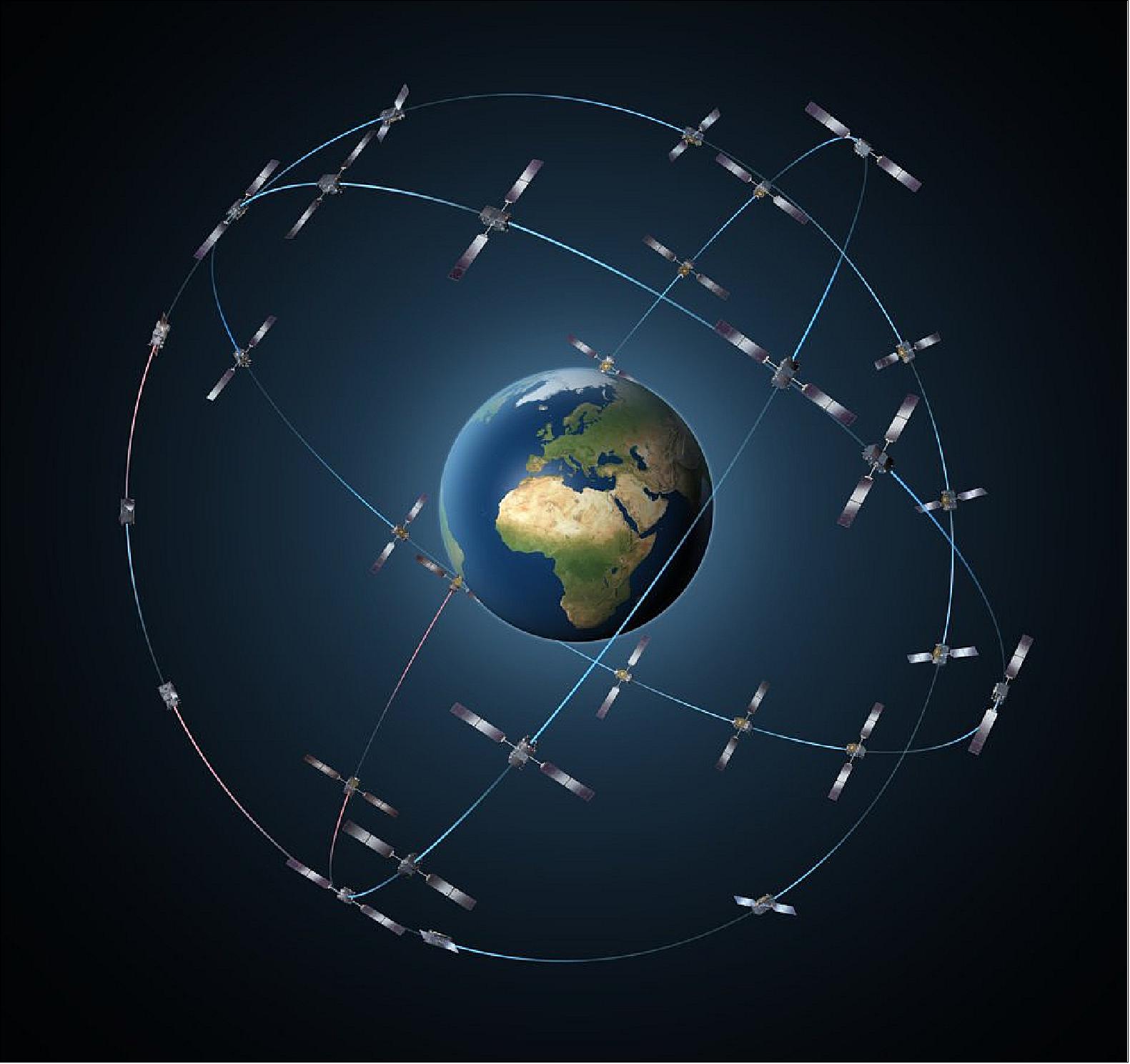
• December 8, 2016: Galileo satellites 13 and 14 have begun transmitting navigation signals as fully operational members of Europe's satnav constellation. The two satellites were launched together from Europe's Spaceport in French Guiana on 24 May. Their flight into space, and subsequent maneuvers to reach their final orbital altitude, was only the start of their quest to join the operational constellation. 95)
- Next, their navigation and search and rescue payloads were methodically switched on, checked out and their performance assessed in relation to the rest of the worldwide Galileo system. This lengthy test phase saw the satellites being run from the second Galileo Control Center in Oberpfaffenhofen, Germany, while their payloads' output was assessed from ESA's Redu center in Belgium, equipped for the tests with specialized antennas for receiving and uplinking signals. The test campaign measured the accuracy and stability of the satellites' atomic clocks – essential for the timing precision to within a billionth of a second as the basis of satellite navigation – as well as assessing the quality of the navigation signals.
- Oberpfaffenhofen and Redu were linked for the entire campaign, allowing the team to compare Galileo signals with satellite telemetry in near-real time. These two satellites were visible in the sky above Redu for a limited time each day, ranging from three to nine hours, so tests were scheduled accordingly. Now that in-orbit testing is completed, the satellites are transmitting working navigation signals and are ready to relay any Cospas-Sarsat distress calls to emergency services.
- The next four satellites, launched together on 17 November, are beginning the same in-orbit testing activity, with the aim of joining the network next spring.
• December 5, 2016: With Europe's Galileo satnav constellation soon to provide initial services, ESA is looking further ahead: its next-stage navigation research program received strong backing during last week's Council at Ministerial level. 96)
- In partnership with the EU (European Union), ESA has overseen the creation of two satnav systems: first EGNOS, which improves the precision of US GPS signals over most European territory, in general operation since 2009 and for ‘safety of life' uses since 2011; and now Galileo, with initial services due to be declared soon. Both program are on a steady footing, with their future construction and evolution being supported through the EU's Global Navigation Satellite System and Horizon 2020 Programs.
- Meanwhile, ESA's Directorate of the Galileo Program and Navigation-related Activities has put together NAVISP (Navigation Innovation and Support Program), which will apply ESA's hard-won expertise from Galileo and EGNOS to new satellite navigation and, more widely, positioning, navigation and timing challenges. — ESA Director General Jan Woerner won strong Member State backing for the optional NAVISP during last week's Ministerial Council in Lucerne, Switzerland.
- NAVISP will boost Member State industrial competitiveness and innovation priorities in the upstream and downstream navigation sector and it will include investigating the integration of satellite navigation with non-space technologies and complementary positioning and communication techniques.
- NAVISP is structured into three elements, with the first developing new satnav technologies and concepts, the second focused on industrial competitiveness and the third offering support to Member State national programs and activities.
- In a world where satnav-based positioning, navigation and timing services are becoming ubiquitous – underpinning everything from automated drones to precision farming to electricity grids and financial networks – NAVISP will investigate novel ways of making these services more robust and reliable, to facilitate the emergence of competitive European actors.
• November 23, 2016: On 17 November, an Ariane 5 rocket launched four new Galileo satellites (Galileo satellites 15–18), accelerating deployment of the new satellite navigation system. The first pair was released 3 hours 36 minutes later, while the second separated 20 minutes later at the target altitude. 97)
- At the Toulouse space center of France's CNES space agency, a joint ESA–CNES team is now working around the clock to shepherd the four through the critical early orbits, lasting nine days for one pair and 13 days for the other.
• August 9, 2016: Europe's fifth and sixth Galileo satellites, which were salvaged from their faulty launch into working orbits, are set to begin broadcasting working navigation signals for test purposes. This activation will allow satnav receiver manufacturers, service providers and scientific researchers to make use of these test signals. A decision on whether these satellites will become part of the operational Galileo constellation is due to be taken by the European Commission. 98)
- A malfunction in their Soyuz-Fregat upper stage during their 22 August 2014 launch placed the Galileo-5 and -6 into highly elliptical – or elongated orbits – instead of their planned circular medium-Earth orbits. — A team based at ESA/ESOC in Darmstadt, Germany, then performed a complex series of maneuvers to raise and circularize their orbits.
- The satellites lacked sufficient fuel to reach their originally envisaged orbits, but the salvage meant that their navigation payloads could then be operated on an ongoing basis; their initial orbits dipped the satellites too close to Earth to keep their antennas properly locked on the planet. "Once their orbits were modified, their navigation payloads could be turned on and in-orbit testing could take place," explains Marco Falcone, Head of the Galileo System Office "The good news was their performance was excellent." For the corrected orbits see Figure 86.
- Now they will be tested on a more sustained basis, along with the rest of the Galileo satellites. A pair of ‘Notice Advisory to Galileo Users' (NAGUs) informing the user community of their availability for testing purposes have been published on the European Global Navigation Satellite System Service Center website. Users are welcome to provide feedback on their usage of GSAT0201 and GSAT0202 by contacting the GSC helpdesk.
- The navigation signals will include a signal health status reading that ‘signal component currently in test' and its navigation data validity status will be ‘working without guarantee'. In this way, these signals will not disturb the performance of any receivers using the Galileo signals coming from the other satellites.
• June 22, 2016: A sea-based test is demonstrating the potential of extending satnav augmentation coverage into north polar regions, offering a safety-of-life standard of navigation performance to users including shipping or aircraft in flight. The Norwegian research vessel Gunnerus, owned by the Norwegian University of Science and Technology, is equipped to pick up satnav signals from GPS and GLONASS as well as augmentation signals specially generated for the test, modelled on Europe's existing EGNOS (European Geostationary Navigation Overlay System). 99)
- Gunnerus is making use of the signals during five days of sailing off Trondheim. The demonstration is part of the Arctic Test Bed project, conducted within the European Global Navigation Satellite System Evolutions Program (EGEP) of ESA. The ESA-designed EGNOS improves the precision of US GPS signals over most European territory, while also providing continuous and reliable updates on their ‘integrity'.
- A 40-strong network of ground monitoring stations perform an independent measurement of GPS signals, so that corrections can be calculated and then passed to users immediately via a trio of geostationary satellites. The result is a several-fold increase in precision.
- "Simply due to Earth's curvature, EGNOS signals are not visible above about 70º north, but they are needed to support polar routing," explains Marco Porretta, overseeing the Arctic Test Bed project.
- To investigate possible methods for improving SBAS ( Satellite-Based Augmentation System) performance in this Arctic region, the test campaign will assess the benefits of augmentation for various types of satnav signals: single-frequency GPS; dual-frequency GPS; and dual-constellation dual-frequency, where GPS signals are combined with those of its Russian counterpart, thus increasing the number of observations.
- "The planned next-decade upgrade of EGNOS, along with other augmentation systems operated over other continents (such as the US equivalent WAAS (Wide Area Augmentation System), will perform multi-constellation augmentation as standard," adds Marco. "That means data from this test case should be especially valuable to support interoperability between future augmentation systems."
- The Arctic Test Bed makes use of some EGNOS reference stations along the north of Europe, along with additional stations in locations including Greenland, Jan Mayen Island, Spitsbergen and Norway.
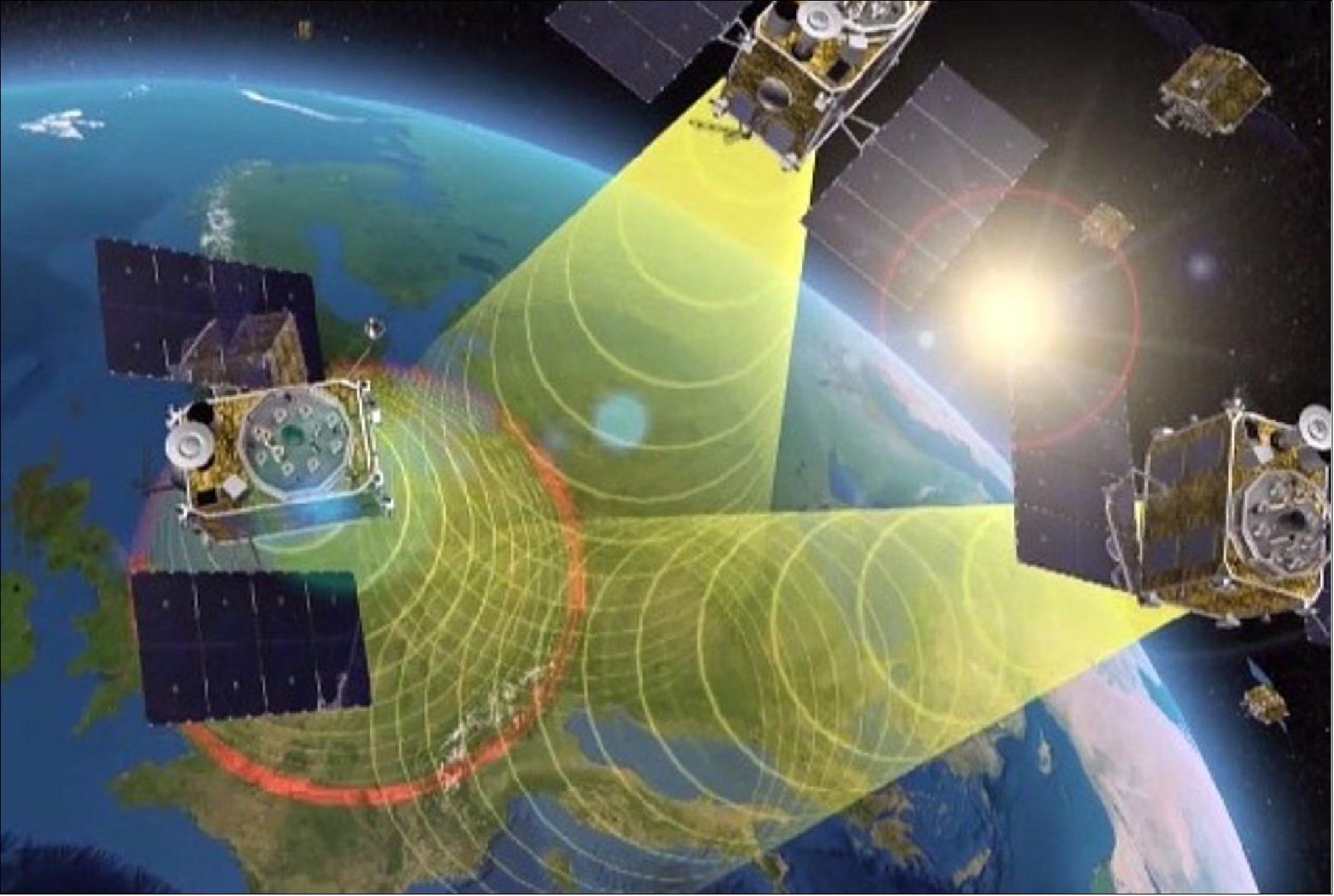
• April 29, 2016: The Galileo-11 and -12 satellites, launched on Dec. 17, 2015, have been officially commissioned into the Galileo constellation, and are now broadcasting working navigation signals. The satellites' navigation payloads were submitted to a gamut of tests, centered on ESA's Redu center in Belgium, which possesses a 20 m-diameter antenna to analyze the satellites' signals in great detail. 100)
- The satellites' onboard atomic clocks – while the most precise ever flown for navigation purposes – must be kept synched by Galileo's global ground segment, which also keeps track of the satellites' exact positions in space. The tests were therefore essential to ensure these latest additions to the fleet met their performance targets while also meshing with the global Galileo system.
- Coordinated from the Galileo Control Centers in Oberpfaffenhofen in Germany (which controls the satellite platforms) and Fucino in Italy (which oversees the provision of navigation services to users), the success of these tests mean these satellites have now been integrated into the Galileo constellation.
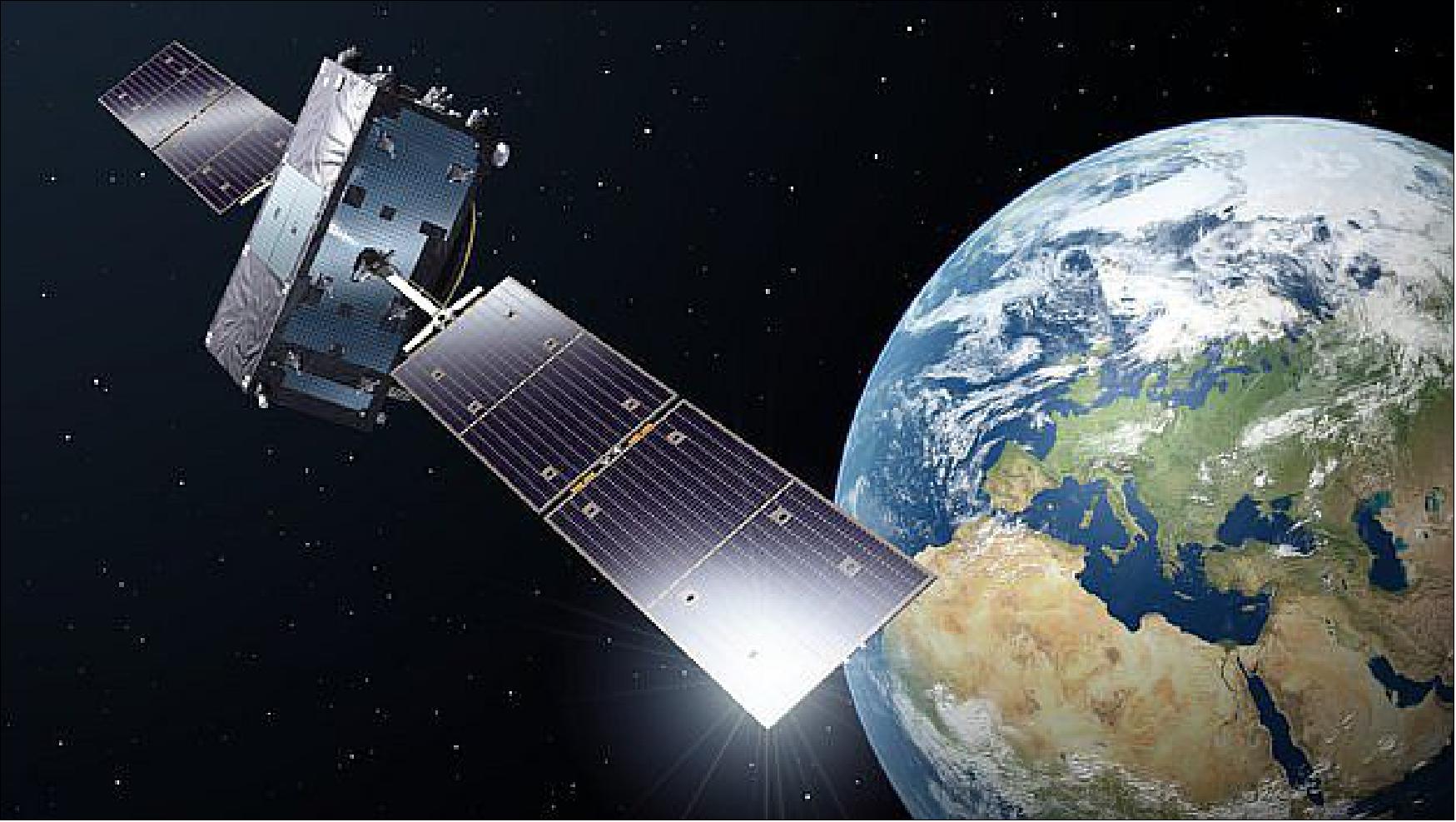
• February 2, 2016: The Galileo-9 and -10 satellites, launched on Sept. 11,2015, have started broadcasting working navigation messages. 101)
- Once safely in orbit and their systems activated, their navigation payloads and search and rescue transponders were subjected to a rigorous process of in-orbit testing, to ensure their performance reached the necessary specifications to become part of the Galileo system. Radio-frequency measurements of the Galileo signals were made from ESA's Redu Center in Belgium. The site boasts a 20 m diameter dish to analyze their signal shape in high resolution.
- Along with assessing that the satellites themselves were functioning as planned, the test campaign also confirmed they could mesh properly with the worldwide Galileo ground network.
- The testing was coordinated from the Galileo Control Centers in Oberpfaffenhofen in Germany – performing the command and control of the satellites – and Fucino in Italy – overseeing the provision of navigation messages to users.
- The operations team, successfully led by SpaceOpal GmbH, completed the testing campaign few days ahead of schedule, with the satellites beginning to broadcast valid navigation signals on 29 January, 2016.
• December 1, 2015: The Galileo-7 and -8 satellites (FOC-3 and FOC-4), launched on March 27, 2015, completed their commissioning activities and were declared operational, broadcasting navigation signals and, from today, relaying search and rescue messages from across the globe. 102)
- The RF (Radio Frequency) measurements were made from ESA's Redu center in Belgium. The site boasts a 20 m diameter dish to analyze Galileo signals in great detail. Last but not least, security testing has ensured that Galileo's PRS (Public Regulated Service) – a maximum precision service restricted to authorized users – is as secure as required.
- The checks carried out from the Galileo Control Centers in Oberpfaffenhofen in Germany and Fucino in Italy, as well as from Redu, prove the performance of these two satellites is excellent for navigation purposes. New onboard features such as seamlessly swapping between the different atomic clocks – a unique feature in global satnav systems – has been verified, which translates into more robust navigation services.
• November 9, 2015: Europe's fifth and sixth Galileo satellites – subject to complex salvage maneuvers following their launch last year into incorrect orbits – will help to perform an ambitious year-long test of Einstein's most famous theory. 103)
- The Galileo-5 and -6 satellites (also referred to as FOC-1 and FOC-2) were launched together by a Soyuz rocket on 22 August 2014. But the faulty upper stage stranded them in elongated orbits that blocked their use for navigation. ESA's specialists moved into action and oversaw a demanding set of maneuvers to raise the low points of their orbits and make them more circular.
- "The satellites can now reliably operate their navigation payloads continuously, and the European Commission, with the support of ESA, is assessing their eventual operational use," explains ESA's senior satnav advisor Javier Ventura-Traveset.
- "In the meantime, the satellites have accidentally become extremely useful scientifically, as tools to test Einstein's General Theory of Relativity by measuring more accurately than ever before the way that gravity affects the passing of time."
- Although the satellites' orbits have been adjusted, they remain elliptical, with each satellite climbing and falling some 8500 km twice per day. It is those regular shifts in height, and therefore gravity levels, that are valuable to researchers.
- Albert Einstein predicted a century ago that time would pass more slowly close to a massive object. It has been verified experimentally, most significantly in June 1976, when a hydrogen maser atomic clock on GP-A (Gravity Probe A) of NASA and SAO (Smithsonian Astrophysical Observatory) was launched 10,000 km into space, confirming the prediction to within 140 parts in a million.
- Atomic clocks on navigation satellites have to take into account they run faster in orbit than on the ground – a few tenths of a microsecond per day, which would give us navigation errors of around 10 km per day. "Now, for the first time since GP-A, we have the opportunity to improve the precision and confirm Einstein's theory to a higher degree," comments Javier.
- This new effort takes advantage of the passive hydrogen maser atomic clock aboard each Galileo, the elongated orbits creating varying time dilation, and the continuous monitoring thanks to the global network of ground stations. "Moreover, while the GP-A experiment involved a single orbit of Earth, ESA will be able to monitor hundreds of orbits over the course of a year," explains Javier.
• October 2015: Preliminary in-orbit payload performance results: A look is taken at at the initial results of navigation and search and rescue payload operation in orbit of the satellites FOC-1 (FM01) and FOC-2 (FM02) and compared with the predictions and performance in ground tests. Operations for Galileo FOC are supported by OHB experts from early on in the design and development process (Ref. 16).
- Initial Measurements (Output power modulated): The FM01 PL IOT sequence started with slowly increasing the modulated output power of the E1 / E5 / E6 signals. At each output power level the output power was verified against the predictions based on the on-ground measurements of the spacecraft - as measured in TVAC (Thermal Vacuum) and of the antenna as measured both by the supplier and after the integration onto the S/C. These predictions shown against the measured output power in the nominal operating point as provided by the IOT (In-Orbit Testing) station in REDU are shown in the following table.
Band | Az: 46.22º; EL: 10.23º | Az: 23.08º; EL: 9.00º | Az: 332.00º; El: 7.53º |
E5 | 31.87 | 32.20 | 32.12 |
E6 | 33.36 | 33.48 | 33.48 |
E1 | 34.56 | 34.78 | 34.77 |
- Timing Subsystem performance : A key feature of the FOC satellite is the so-called seamless switching capability between the prime PHM (Passive Hydrogen Maser) and the hot redundant clock RAFS (Rubidium Atomic Frequency Standard). The CMCU (Clock Monitoring and Control Unit) gives the ground segment the capability to adjust the frequency and the phase of the 10.23 MHz reference frequency (used inside the navigation payload and the spacecraft) derived from either of the two clocks (nominally PHM) by measuring the relative phase between these two frequencies over time (phase meter). This allows to iteratively align the frequencies and finally the phase of the two reference frequencies (if successful resulting in a zero phase difference). Then, the reference clock can be swapped without affecting the quality of the navigation signal, i.e. with minimum impact on both the code and the carrier phase. A seamless switch from RAFS to PHM as seen by the users (in this case the test receivers) on ground is shown in Figure 85. The Galileo receivers were continuously tracing the signals; the clock swap resulted in a position ‘jump' of less than 3 cm.
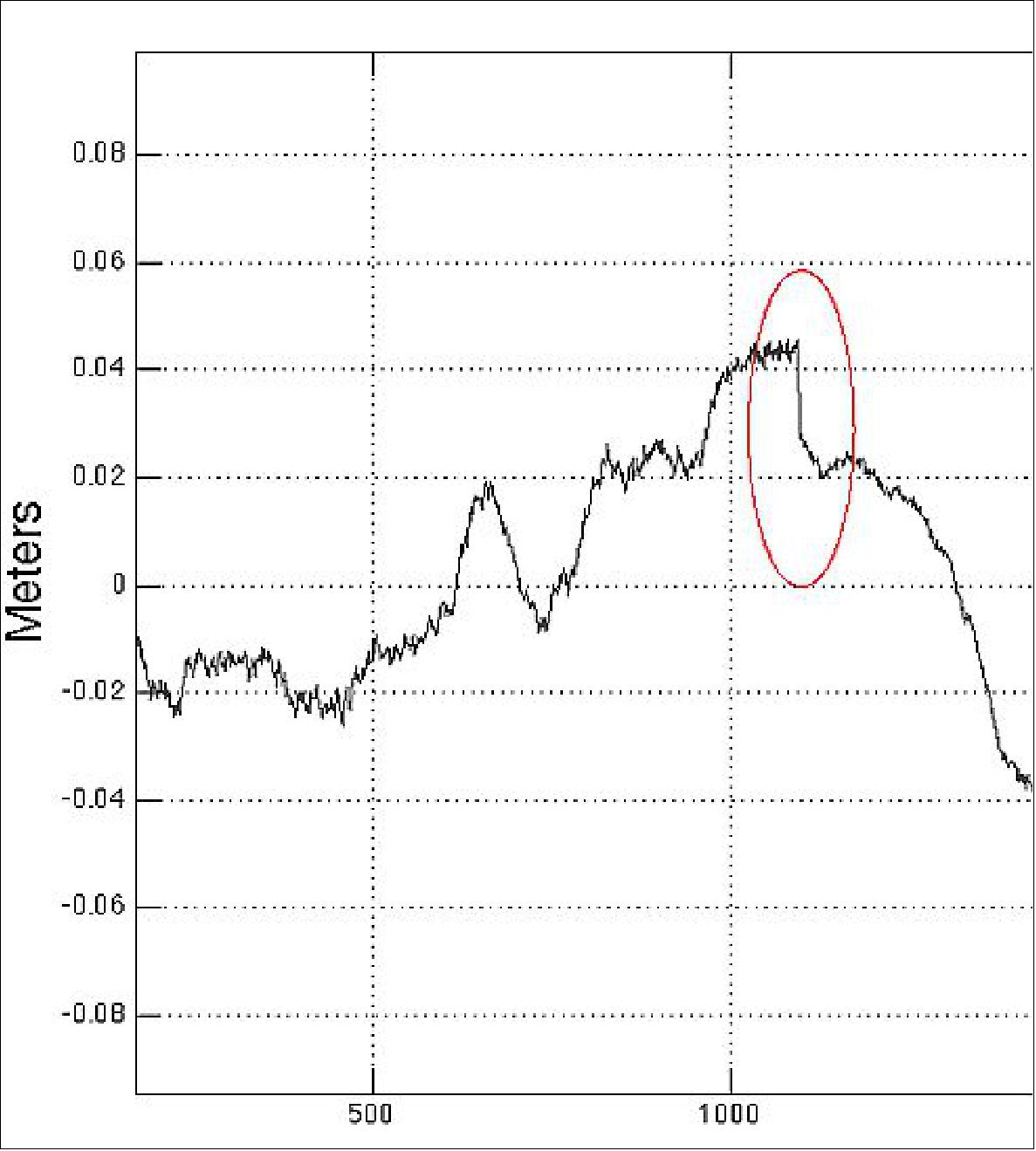
- Initial measurements of SART (Search and Rescue Transponder): The objective of this (secondary) payload is to receive distress signals transmitted in UHF (406.1 MHz) and upconvert them to L-band and forward them to the earth stations from which then the rescue is organized. The results of the SART measurement have been affected by interference, especially the group delay measurement and the gain measurement in fixed gain mode. The main results of the SART testing are summarized in Table 6. Considering the impact of the interferers on the measurements, the SART showed very similar performance to the on-ground test results.
Test parameter | Test outcome |
EIRP (Effective Isotropic Radiated Power) | 19.5 dBW |
G/T (receiver) Gain / (noise) Temperature | -13 dB/K at 12º elevation |
Group delay | In line with on ground data |
Gain versus frequency | < 1 dB ripple |
Axial ratio | 0.9 dB |
Intermodulation ratio | Better than 28 dBc |
- The first six FOC satellites have been deployed in orbit, and are all in perfect health, despite the anomalous orbit of satellites FOC-1 (also called FM01) and FOC-2 (FM02) due to an injection failure of the upper stage of the launch vehicle. Further satellites are delivered in the months to come, with the next pair of satellites to be launched in December 2015 (Ref. 16).
• Sept. 25, 2015: Europe’s latest pair of Galileo satellites, Galileo-9 and -10, launched on Sept. 11, 2015, have passed its initial check out in space, allowing control to be handed over to the main control center and join the growing fleet. 104)
- The satellites fired their thrusters to drift towards their target orbital positions at around 23, 222 km altitude – helped along in this case by a near-perfect orbital injection to begin with. Firings will resume around the end of October to stop the drift and achieve fine positioning in orbit, guided by ESOC’s specialist flight dynamics team.
- Once on their way, the satellites were handed over on 19 and 20 September, respectively, to the Galileo Control Center in Oberpfaffenhofen, Germany managed by SpaceOpal. The navigation payloads on Galileo-9 and -10 still need to undergo detailed testing, led from ESA’s Redu center in Belgium with the support of both Oberpfaffenhofen and the second Galileo Control Center in Fucino, Italy, which has oversight of Galileo’s navigation mission.
• March 13, 2015: ESA is reporting that the sixth Galileo satellite of Europe’s navigation system has now entered its corrected target orbit, which will allow detailed testing to assess the performance of its navigation payload. 105)
Launched with the fifth Galileo last August, its initial elongated orbit saw it travelling as high as 25 ,900 km above Earth and down to a low point of 13,713 km – confusing the Earth sensor used to point its navigation antennas at the ground.
A recovery plan was devised between ESA’s Galileo team, flight dynamics specialists at ESA’s ESOC operations center and France’s CNES space agency, as well as satellite operator SpaceOpal and manufacturer OHB.
This involved gradually raising the lowest point of the satellites’ orbits more than 3500 km while also making them more circular.
The fifth Galileo entered its corrected orbit at the end of November 2014. Both its navigation and search and rescue payloads were switched on the following month to begin testing. — Now the sixth satellite has reached the same orbit, too. This latest salvage operation began in mid-January and concluded six weeks later, with some 14 maneuvers performed in total.
Its corrected position is effectively a mirror image of the fifth satellite’s, placing the pair on opposite sides of the planet. The exposure of the two to the harmful Van Allen Belt radiation has been greatly reduced, helping to ensure future reliability.
Significantly, the corrected orbit means they will overfly the same location on the ground every 20 days. This compares with a standard Galileo repeat pattern of every 10 days, helping to synchronize their ground tracks with the rest of the constellation.
The test results from Galileo 5 proved positive, with the same test campaign for the sixth satellite due to begin shortly, overseen by ESA’s Redu center in Belgium. A 20 m diameter antenna will study the strength and shape of the navigation signals at high resolution.
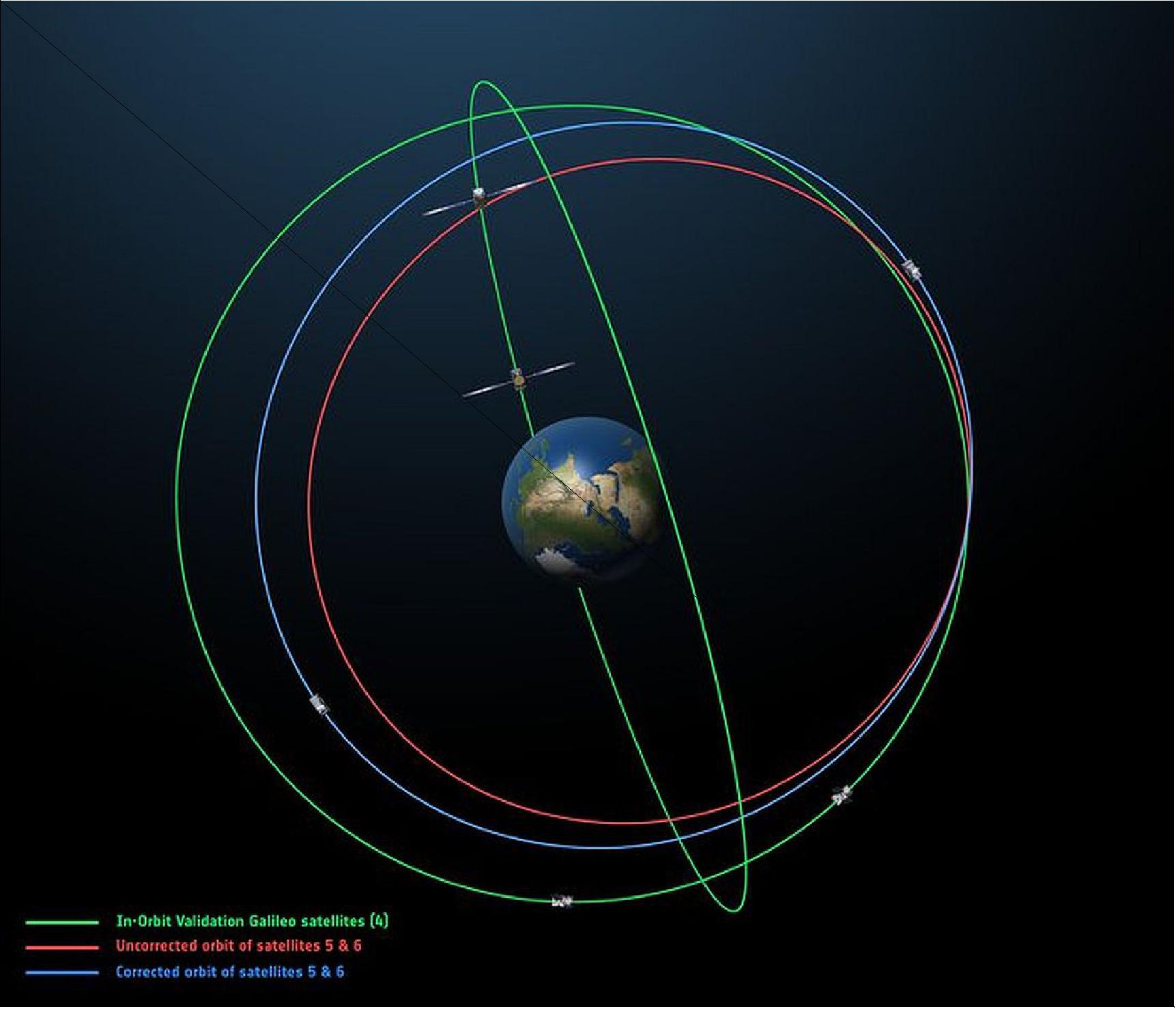
Legend to Figure 86: The original (in red) and corrected (in blue) orbits of the fifth and sixth Galileo satellites, along with that of the first four satellites (green). The first four satellites, launched in pairs in 2011 and 2012, were released into circular 23,222 km altitude orbits in two planes. The fifth and sixth satellites, launched by Soyuz–Fregat on 22 August 2014, ended up in an incorrect orbit because of a problem with the upper stage. This elongated orbit took them up to 25 ,900 km above Earth and back down to 13,713 km – too low for their navigation payloads to operate throughout. So, during November 2014 and January–February 2015, the satellites respectively underwent a series of maneuvers to raise the low point of their orbits by 3500 km while also making their orbits more circular. So now their navigation payloads are operable, and undergoing testing, while the European Commission – the Galileo system owner – prepares to decide whether the salvaged satellites will be incorporated into the constellation.
• Dec. 03.2014: Europe’s fifth Galileo satellite, one of two delivered into a wrong orbit by VS09 Soyuz-Fregat launcher on August 22, has transmitted its first navigation signal in space on Saturday, 29 November 2014. It has reached its new target orbit and its navigation payload has been successfully switched on. A detailed test campaign is under way now the satellite has reached a more suitable orbit for navigation purposes. 106)
- The fifth and sixth Galileo satellites, launched together on 22 August, ended up in an elongated orbit of 25,900 km x 13,713 km. A total of 11 maneuvers were performed across 17 days, gradually nudging the fifth satellite upwards at the lowest point of its orbit. As a result, it has risen more than 3500 km and its elliptical orbit has become more circular.
- The commands were issued from the Galileo Control Center by Space Opal, the Galileo operator, at Oberpfaffenhofen in Germany, guided by calculations from a combined flight dynamics team of ESA/ESOC, in Darmstadt, Germany and France’s CNES space agency. The commands were uploaded to the satellite via an extended network of ground stations, made up of Galileo stations and additional sites coordinated by CNES. Satellite manufacturer OHB also provided expertise throughout the recovery, helping to adapt the flight procedures.
- In the new orbit, the satellite’s radiation exposure has also been greatly reduced, ensuring reliable performance for the long term.
- The revised, more circular orbit means the fifth satellite’s Earth sensor can be used continuously, keeping its main antenna oriented towards Earth and allowing its navigation payload to be switched on. Significantly, the orbit means that it will now overfly the same location on the ground every 20 days. This compares to a normal Galileo repeat pattern of every 10 days, effectively synchronizing its ground track with the rest of the Galileo constellation.
- Navigation test campaign: The satellite’s navigation payload was activated on 29 November, to begin the full ‘In-Orbit Test’ campaign. This is being performed from ESA’s Redu center in Belgium, where a 20 m diameter antenna can study the strength and shape of the navigation signals at high resolution.
- The first Galileo FOC navigation signal-in-space transmitting in the three Galileo frequency bands (E5/E6/L1) was tracked by Galileo Test User Receivers deployed at various locations in Europe, namely at Redu (B), ESTEC (NL), Weilheim (D) and Rome (I). The quality of the signal is good and in line with expectations.
- The SAR (Search And Rescue) payload will be switched on in few days in order to complement the in-orbit test campaign.
• Nov. 10, 2014: ESA’s fifth Galileo navigation satellite, one of two left in the wrong orbit this summer, will make a series of maneuvers this month as a prelude to its health being confirmed. The aim is to raise the lowest point of its orbit – its perigee – to reduce the radiation exposure from the Van Allen radiation belts surrounding Earth, as well as to put it into a more useful orbit for navigation purposes. - Should the two-week operation prove successful then the sixth Galileo satellite will follow the same route. 107)
- The Galileo pair, launched together on a Soyuz rocket on August 22, 2014, ended up in an elongated orbit travelling out to 25,900 km above Earth and back down to 13,713 km. The target orbit was a purely circular one at an altitude of 23,222 km. In addition, the orbits are inclined at 49.8º while the nominal inclination should be 56.
- The two satellites have only enough fuel to lift their altitude by about 4000 km – insufficient to correct their orbits entirely. But the move will take the fifth satellite into a more circular orbit than before, with a higher perigee of 17,339 km.
- The recovery is being overseen from the Galileo Control Center in Oberpfaffenhofen, Germany, with the assistance of ESA/ESOC, in Darmstadt, Germany.
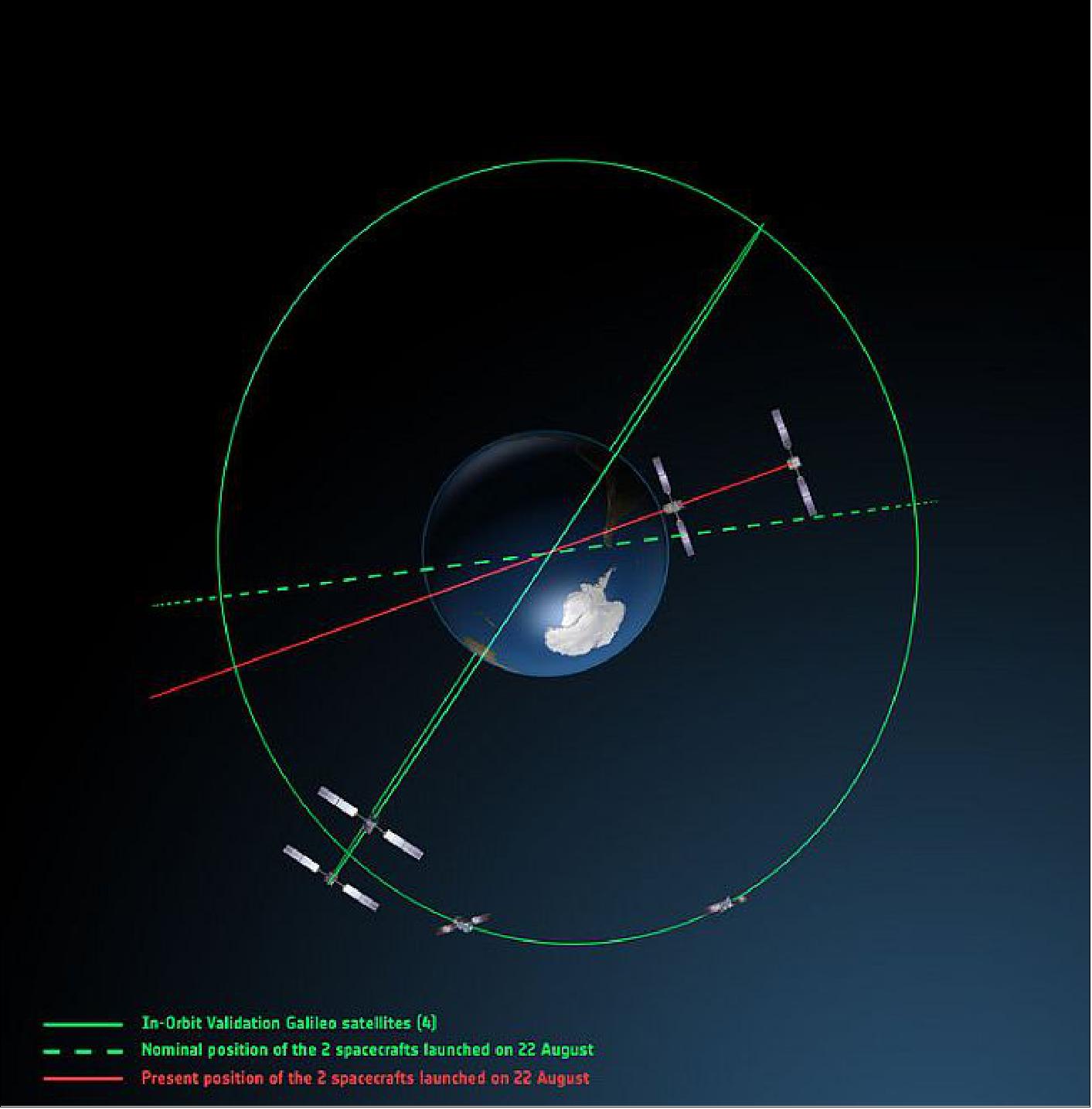
• Oct. 8, 2014: The Independent Inquiry Board, formed to analyze the causes of the launch anomaly, came up with the following conclusion: The root cause of the anomaly on flight VS09 is a shortcoming in the system thermal analysis performed during stage design, and not an operator error during stage assembly. 109)
The system thermal analyses have been reexamined in depth to identify all areas concerned by this issue. Given this identified and perfectly understood design fault, the Board has chosen the following corrective actions for the return to flight:
- Revamp of the system thermal analysis.
- Associated corrections in the design documents.
- Modification of the documents for the manufacture, assembly, integration and inspection procedures of the supply lines.
These measures can easily and immediately be applied by NPO Lavochkin to the stages already produced, meaning that the Soyuz launcher could be available for its next mission from the Guiana Space Center as from December 2014. - Beyond theses corrective actions, sufficient for return to flight, NPO Lavochkin will provide Arianespace with all useful information regarding Fregat’s design robustness, which is proven by 45 successful consecutive missions before this anomaly.
• Oct. 6, 2014: EU Government and officials are debating how to proceed now. The options are to continue, as scheduled, with the December launch of two more Galileo satellites aboard a Soyuz Fregat rocket, or to wait until next spring or summer and launch four Galileo satellites on a heavy-lift Ariane 5 vehicle. - One argument for waiting until mid-2015 for the next launch is that it would give ESA and OHB additional time to put the satellites through a rigorous in-orbit test campaign to debug them before launching additional satellites. 110)
• On September 27-28, 2014, the two satellites, FM1 and FM2, launched on 22 August were handed over from ESA/ESOC, in Darmstadt, Germany, to the Galileo Control Center, Oberpfaffenhofen, which will care for them pending a final decision on their use. 111)
Fregat Injection Anomaly and LEOP (Launch and Early Operations Phase)
While the lower stages of the Soyuz worked flawlessly, soon it became clear that some time after the first of two firings of the final stage of the launcher, an anomaly occurred aboard the Fregat. While the second of these two firings was apparently with nominal thrust and nominal duration, the attitude of the Fregat during the second firing was significantly off the mark. While the exact reasons for the anomaly are subject to ongoing investigations of both ESA and Arianespace, the impact on the deployment orbit where identified within a few hours (Ref. 4).
The OHB support team present at ESOC together with their ESA/ESOC colleagues spent the next five days stabilizing the satellites despite their unexpected environment. At the end of these intense days, both satellites were thermally stable with a stable attitude pointing, solar arrays deployed, and reaction wheels run-in completed.
Both satellites – despite the different environment with different orbit period, harsher radiation environment, and in an unforeseen highly elliptical orbit - are in perfect health, no redundancy in any unit or subsystem was lost so far.
Mission Recovery and Re-definition
The current assessment of the situation is as follows: While the satellites are operating in perfect health, the orbit is significantly different compared to what was anticipated. The FOC satellites do carry substantially more propellant with them than they would need for a nominal mission. The reason are the ESA requirements: the satellite design shall be identical for nominal and spare satellites. Spare satellites must – on top of what nominal satellites have to achieve in terms of ΔV – be able to quickly transition from the spare position into the position of the satellite that they are supposed to replace.
None of the “Work Package 1” satellites is likely to ever carry out this task (all satellites are to be nominal satellites, the spare role is reserved for latter satellites); however, their design must allow for this role as per requirements and they are fuelled accordingly. While this is good news for the recovery at first look, a second look reveals that even with this large propellant margin aboard, the satellites cannot correct the major injection failure that altered both eccentricity and inclination of the orbit. But navigation can be made possible from a variety of different orbits, including highly elliptical orbits (as e.g. also investigated currently in the scope of ESA's Galileo 2nd Generation studies) and lower-than-MEO orbits. Hence being in a different-than-expected orbit – quite contrary to e.g. communication satellites that do not inject properly into their geostationary orbit – does not mean the end of the mission.
The two most urgent problems that FM1 and FM2 are currently facing are identified as:
• Earth sensor field of view
• Radiation environment
The first issue is a result of simple geometry: the Earth sensors aboard are designed for missions in orbits in or above MEO. However, in the part close to the orbit's perigee, the Earth appears too large in the sensor's field of view, which means that it will lose track. The current onboard software is designed to interpret this as a severe issue / potential failure in the AOCS (Attitude and Orbit Control System). It reacts as its designers: by ending AOCS normal mode and entering an AOCS safe mode. While this approach made sense for the intended circular MEO orbit, it means that in the current orbit continuous normal mode is not possible. This again means that also continuous payload operation is not possible.
The second issue is a result of the fact that the current orbit transfers through parts of the Earth's Van Allen belts which feature higher levels of radiation than the originally foreseen MEO for Galileo. This means that on average per week, the satellites now endure the radiation dose they should have received in the course of one average month. While these elevated radiation risks do not pose an immediate risk, experts do agree that these levels should be decreased in the not too distant future.
With this background in mind, the following tasks are currently being investigated by OHB for ESA to support the re-definition and recovery of the first FOC mission from its injection anomaly caused by Fregat:
• Firstly, in order to allow the onboard Earth sensors to become fully operative, it is planned to invest most of the propellant onboard of FM1 and FM2 to raise the orbit's perigee. In this way, the Earth will be small enough in the sensors' field of view to enable uninterrupted normal mode of the AOCS. This task is not as straightforward, as the orbit change mode required, for this maneuver normally already would require the Earth sensor to be part of the AOCS control loop. Hence a work-around is needed and will be developed.
• Raising the perigee will also decrease the radiation levels, thereby addressing also the second problem identified. The inclination will likely not be changed (at least not significantly).
• Even with a raised perigee, the Earth will still appear larger in the Earth sensor's FOV than anticipated. Hence, the AOCS controller and the failure detection, identification and recovery algorithms need to be updated. This will be achieved through a combination of parameter setting changes and onboard software changes.
• Once the perigee is raised and the AOCS normal mode is stable in the “repaired” orbit, payload commissioning can commence. Impacts of the altered, but still other than originally designed for orbit onto payload operation needs also to be assessed.
• While currently the satellites are working fine, over-the-lifetime effects of the different environment (e.g. thermal, radiation, etc.) need to be analyzed. This must take into account the time in the original flawed orbit as well as the remainder of the mission in the altered orbit.
• Flight control procedures, satellite user manuals, as well as other documentation need to be updated accordingly.
• The impact on other segments needs to be analyzed as well, by their respective primes and ESA.
All these activities will be carried out in the coming weeks (rather than months), which could bring the perigee raising maneuver forward as early as the end of September 2014. With all of the above-mentioned activities successfully implemented, current analyses indicate that the two satellites could still carry out over 90% of their navigation services, which would turn this near-disaster into a great success for Europe.
Navigation Payload
SSTL’s role in the OHB contract covers all phases from design through to support to in-orbit operations. The key deliverables under SSTL responsibility are 2 EM (Engineering Model) payloads, 22 FM (Flight Model) payloads and the associated EGSE (Electrical Ground Support Equipment).
The starting point for the SSTL payload design was the GIOVE-A payload but with major enhancements to meet the Galileo FOC requirements which are far more stringent than those for the GIOVE-A mission (Ref. 14).
The main driving requirements are:
• Lifetime: 12 years in MEO for FOC (whereas GIOVE-A was a 27 month mission)
• Launch scenario: Dual launch on Soyuz or 4 x launch on Ariane-5 with an effective mass limit of ~730 kg/spacecraft.
• Services: The FOC satellites must offer all five Galileo services – Open, Commercial, Safety-of-Life, Public Regulated, and Search & Rescue
• Capability: The FOC satellites carry the highly performant clocks: PHM (Passive Hydrogen Maser) in addition to the RAFS (Rubidium Atomic Frequency Standard). Each spacecraft carries a hydrazine propulsion system for constellation maintenance which was not a requirement on the test bed.
• Interfaces: The FOC satellites must comply to the operational interfaces with the GCS (Galileo Control Segment) in S-band and the GMS (Galileo Mission Segment) in C-band.
• Security: The FOC satellites must comply with the on-board bus and payload security requirements as well as those of the main ground-space segment interfaces.
• Production & industrialization: In order to minimize the recurring costs of production and generate satellites at the required cadence, the payload procurement and AIT (Assembly, Integration and Test) processes have been designed with production optimization as a key driver.
Payload design: The design consists of the following subsystems:
1) Timing subsystem: The timing subsystem is the heart of the navigation payload – it generates the master timing reference. The reference signal is generated at 10.23 MHz by one of 4 clocks – a redundant pair of RAFS (Rubidium Atomic Frquency Standard) with excellent short term stability and a redundant pair of PHMs (Passive Hydrogen Masers) with excellent short and long term stability. The nominal 10.23 MHz reference frequency can be offset with a small correction in-orbit to take account of relativistic effects and clock drift. The satellite design ensures that the temperatures of these clocks are maintained within a narrow band to further improve their stability. The control and monitoring of the clocks is provided by a CMCU (Clock Monitoring & Control Unit) with internal redundancy.
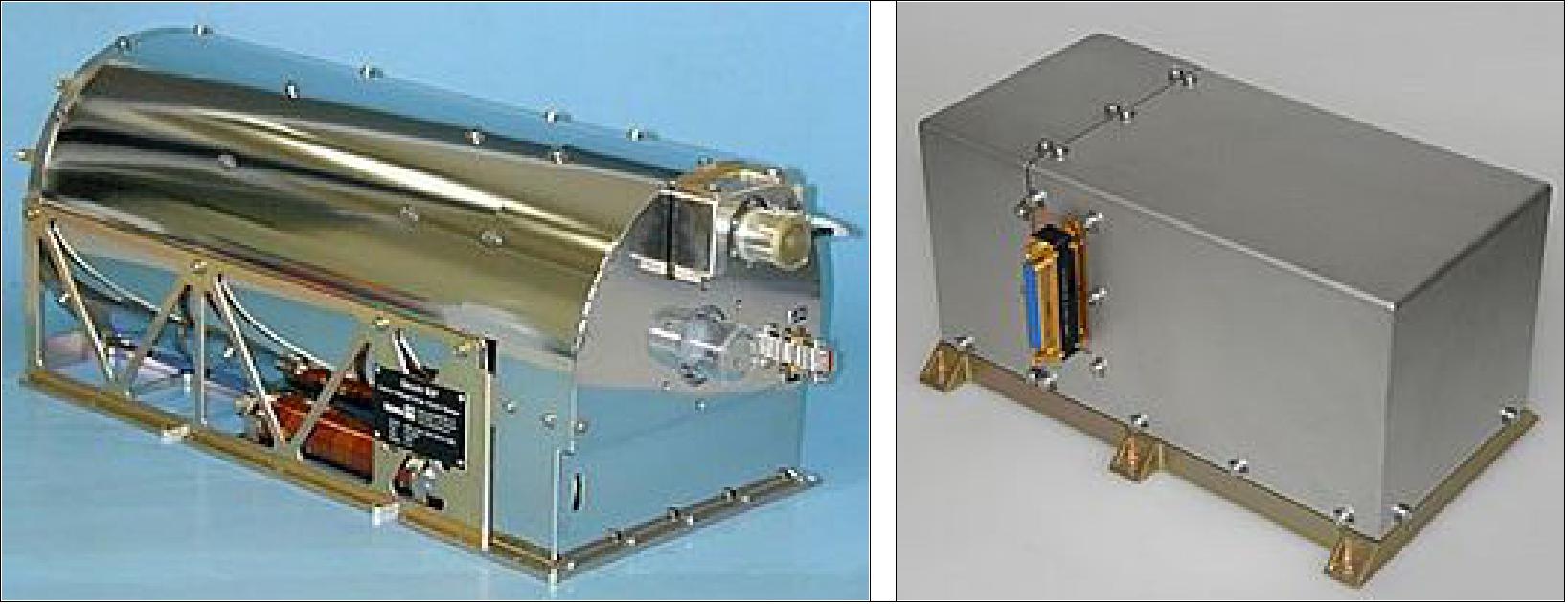
2) Mission uplink subsystem: The MSU (Mission Uplink Subsystem) receives the encrypted data messages coming from the ERIS (External Regional Integrity System) and the Galileo GMS (Ground Mission Segment). The uplink signals are a multiplex of a maximum of 6 simultaneous CDMA channels received by the receive-only antenna and demodulated by the receiver. The data messages are then passed on to the CSU (Common Security Unit) for decryption.
3) Signal generation subsystem: The SGS (Signal Generator Subsystem) is responsible for the generation of ranging and spreading codes, storage and buffering of navigation data obtained from the mission receiver through the CSU and generating the appropriate modulated L-band signals. The navigation signals supported by the payload will be compliant with the latest signal agreements between the EU and the US. The binary signal components of the navigation signals are modulated with the relevant subcarriers according to the Galileo Navigation Signal in Space ICD to create the three complex navigation signals by the NSGU (Navigation Signal Generation Unit). They are then upconverted to the E5, E6, and L1-bands, respectively.
Kongsberg Norspace of Norway is the supplier of two key elements within the satellites: the FGUUs (Frequency Generator and Upconverter Units) and SARTs (Search and Rescue Transponders). The redundant shoebox-sized FGUU takes the outputs of the satellite’s adjacent NSGU (Navigation Signal Generator Unit) and converts them into L-band signals across Galileo’s three spectral bands. It is these signals that end up guiding Galileo users through their receivers.
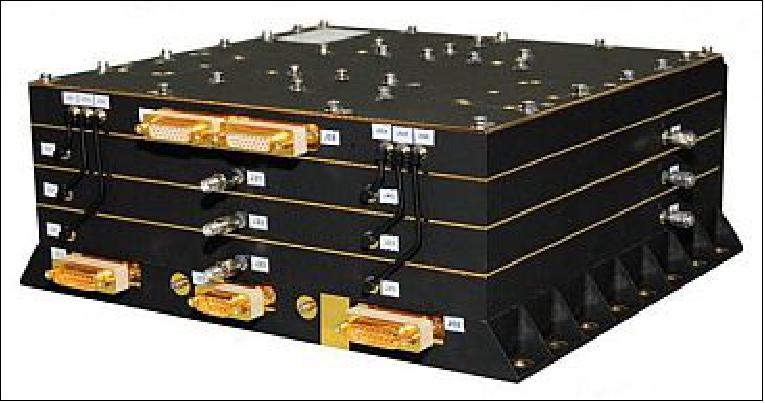
4) RF amplification subsystem: The RAS (RF Amplification Subsystem) is designed to meet the following requirements:
• Meet the EIRP requirements specified for the Galileo FOC navigation mission
• Operate three L-band channels with center frequencies at 1191.795 MHz, 1278.75 MHz and 1575.42 MHz.
• Comply with the out-of-band spurious emissions requirements of the Galileo FOC navigation mission
• Comply with 2:1 redundancy requirement
• Comply to the gain and phase variation requirements of the Galileo FOC navigation mission.
The objective of the RAS is to transmit the navigation signals to the ground at a quality and power level high enough for the receiver to track them and prevent interference with the radio astronomy bands and other existing navigation systems. The RF amplification subsystem contains 3 redundant pairs of MPM (Microwave Power Module) LCs (L-band Channels), with one of each pair in cold standby per band, switches, output filters for the L1-channel and an OMUX (Output Multiplexer) for the E5/E6 channels. The RF signal is transmitted through a phased array antenna mounted on the Earth-facing panel of the satellite.
5) Search & rescue subsystem: The SAR (Search and Rescue) payload’s key function is to receive distress beacon signals at 406.05 MHz, band limit the signal, control its dynamics, convert it to L-band at 1544.10 MHz, and amplify it up to a 5 W output signal. The key design challenge is to overcome external interfering signals, combined with any internally generated spurs, in combination with large in-band signal dynamics to maintain the payload gain stability. The SAR payload system will include a transponder that translates the UHF distress beacon signal to the SAR payload output at L-band, for transmission to the MEO system local user terminals, in conjunction with the Galileo SAR antennas and two test couplers.
6) Laser retroreflector array: The laser retroreflector array consists of fused silica corner cubes, which have the geometrical property of turning incoming light rays through 180 degrees so that they return to their source. The ground portion of the ranging system consists of a highly calibrated pulse laser, a telescope and associated timing electronics.
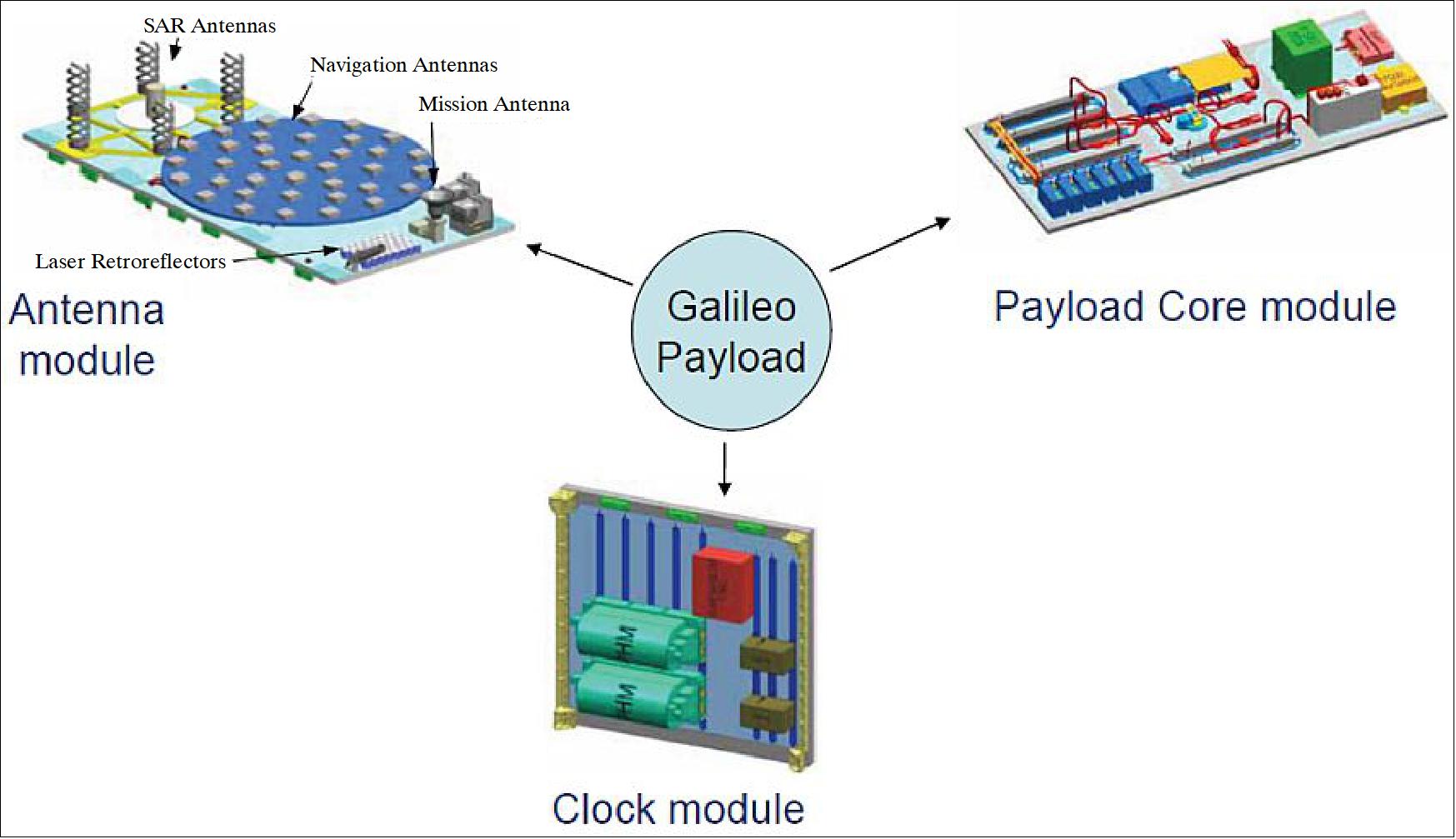
Status of Galileo FOC Satellite Payloads
• In late August 2013, the FM2 main L-band antenna, used for broadcasting navigation messages, was prepared for a mass property test at the ESA/ESTEC Test Center (Figure 91). 114)
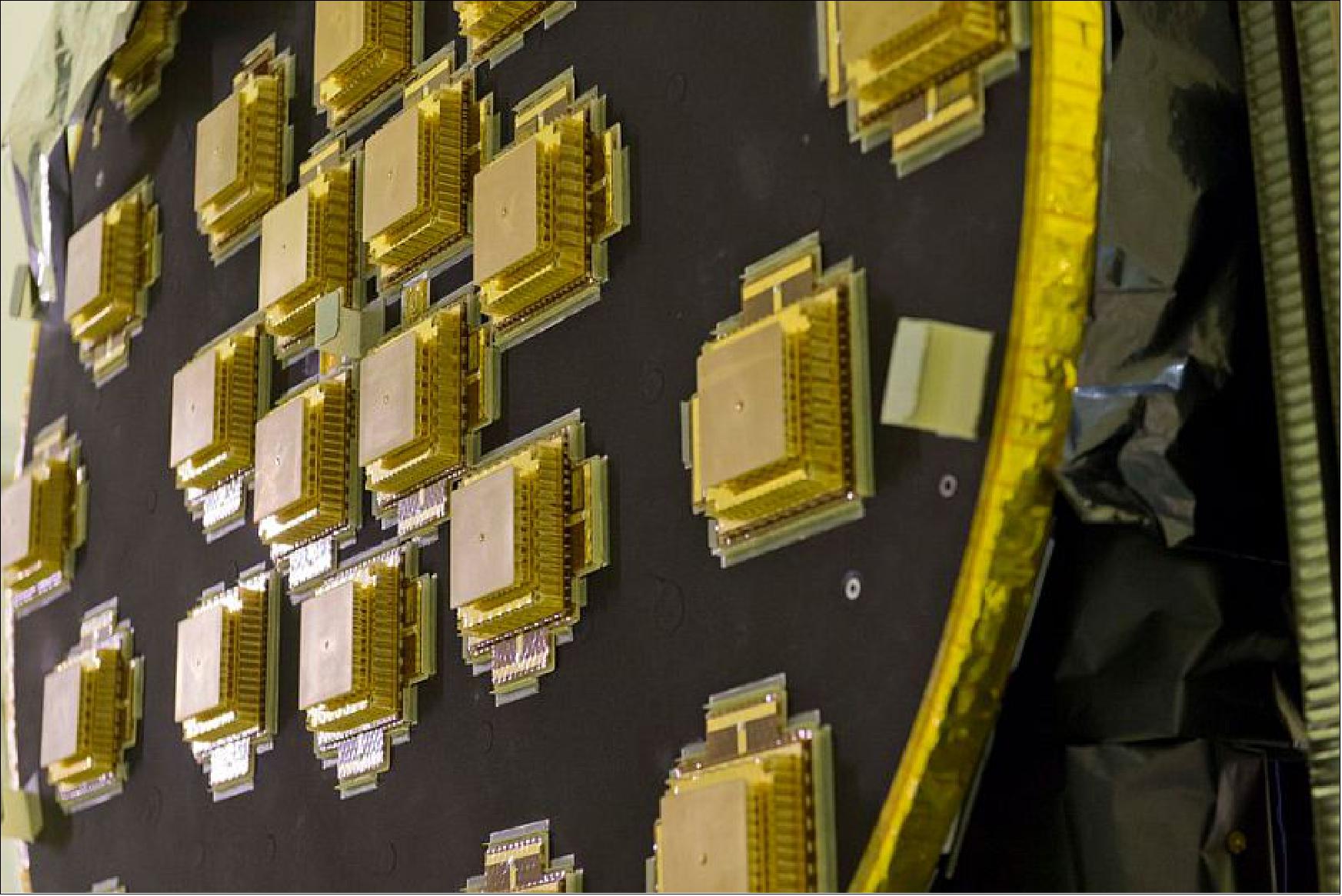
• On June 2013, SSTL delivered the first four Galileo FOC navigation payloads to the Galileo GNSS system to prime contractor OHB System AG. The payloads were shipped to OHB in Bremen, Germany for integration of the payload to platform and the start of the satellite integration and test activities. 115)
SAR/Galileo (Search And Rescue) Payload
Background: The LEOSAR system, developed by the International COSPAR-SARSAT Program, currently provides accurate and reliable distress alert and location data to help search and rescue (SAR) authorities to assist persons in distress. In 2000, consultations started between the COSPAS-SARSAT Program and the European Commission on the feasibility to install 406 MHz SAR instruments on the Medium Orbit navigation satellites systems in order to develop a 406 MHz MEOSAR component to the COSPAS-SARSAT system. The main benefits of the MEOSAR system will be the near instantaneous global coverage with accurate independent location capability (in opposition with the current LEO system which has a higher latency to provide location information).
The USA MEOSAR program, based on GPS-III, is called the DASS (Distress Alerting Satellite System), the European System based on Galileo is called SAR/Galileo, and the Russian program based on GLONASS, is referred to as SAR/GLONASS. This has a direct impact on the probability of survival of the person in distress at sea or on land. 116)
The inclusion of a SAR (Search And Rescue) payload in the Galileo satellites represents a major opportunity to dramatically enhance the performance provided by this system, it marks a significant expansion of the COSPAS-SARSAT program, a satellite-based network designed to bring help to air and sea vessels in distress. The international COSPAS–SARSAT satellite relay system has been making air and sea travel safer for 30 years, saving 24,000 lives along the way. 117) 118)
• The first Galileo SAR demonstration payload has been successfully tested. The second pair of Galileo IOV (In-Orbit Validation) satellites, launched aboard a Soyuz rocket from Kourou on October 12, 2012, are the first of the European Galileo constellation of navigation satellites to host a SAR payload. Both IOV satellites carry a search and rescue repeater, consisting of a SAR transponder and a combined UHF receiving and an L-band transmitting antenna.
SAR repeaters on the satellites can acquire UHF signals emitted from emergency beacons aboard ships, aircraft, or even carried by individuals. Ground stations, known as Local User Terminals, locate the source of distress calls using signals relayed by participating satellites and then alert local authorities for rescue. 119)
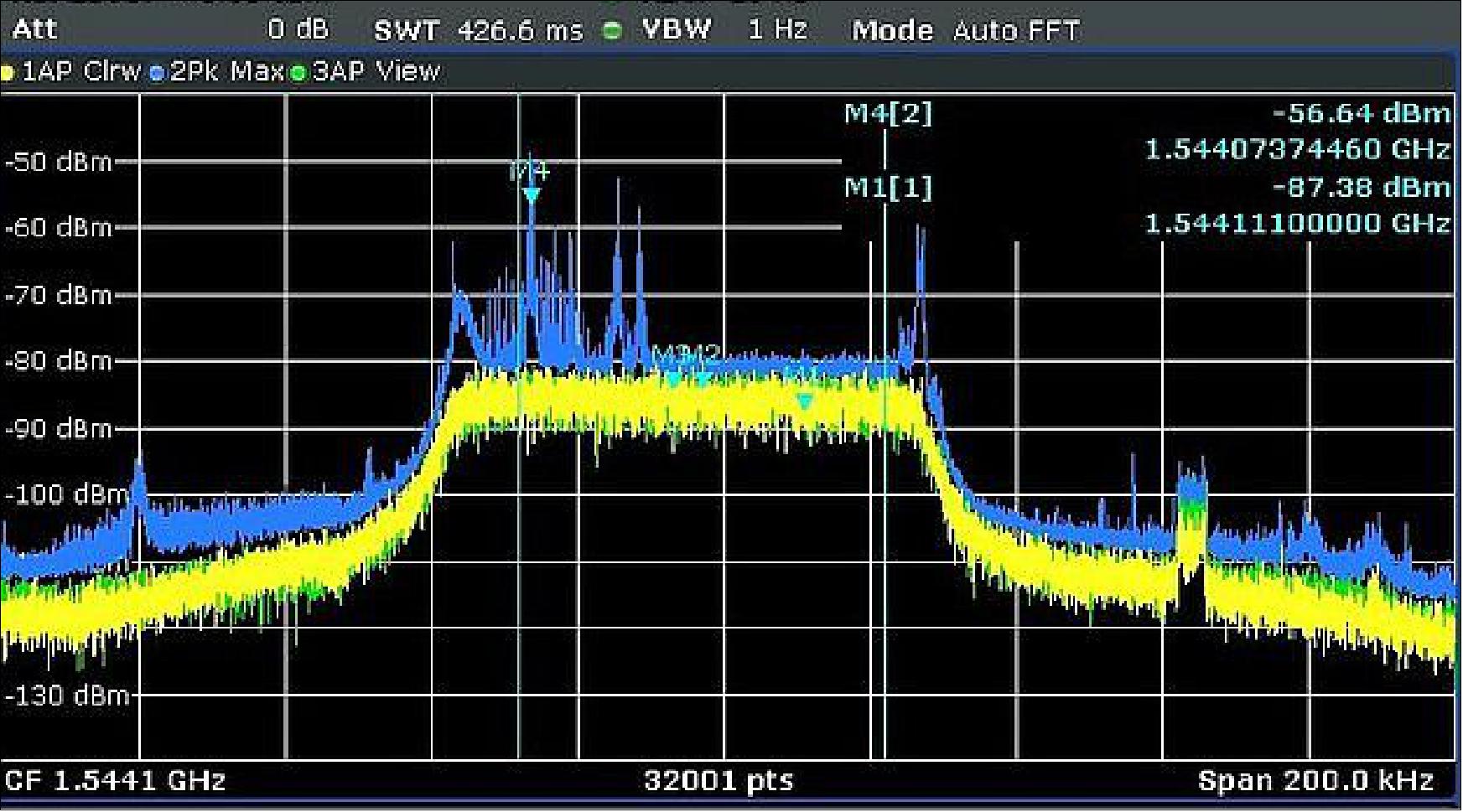
The SAR repeaters on these two Galileo satellites are the first of a new class of ‘MEOSAR’ repeaters, combining broad field of views with the ability to quickly determine positions. Galileo’s satellites are also the first with the capability to despatch return link messages via their navigation signals, assuring those in distress that help is on the way.
An additional advantage of this new MEOSAR system is that less ground infrastructure is required – just three to four terminals are sufficient to serve all European territory.
This initial SAR unit's transponder was built by Mier Comunicaciones in Spain, with its combined receiving and transmitting antenna developed by Spain’s Rymsa company. 120)
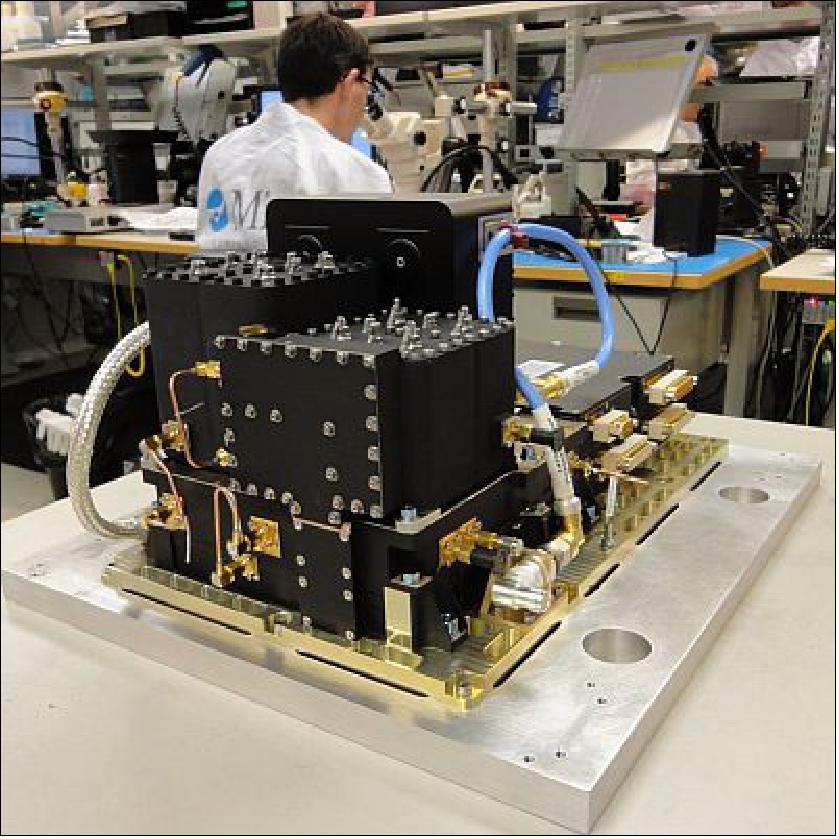
• The first two Galileo-FOC satellites,FOC-1 (FM1) and FOC-2 (FM2), launched on August 22, 2014, are also equipped with a SAR payload — as will be all future Galileo-FOC satellites.
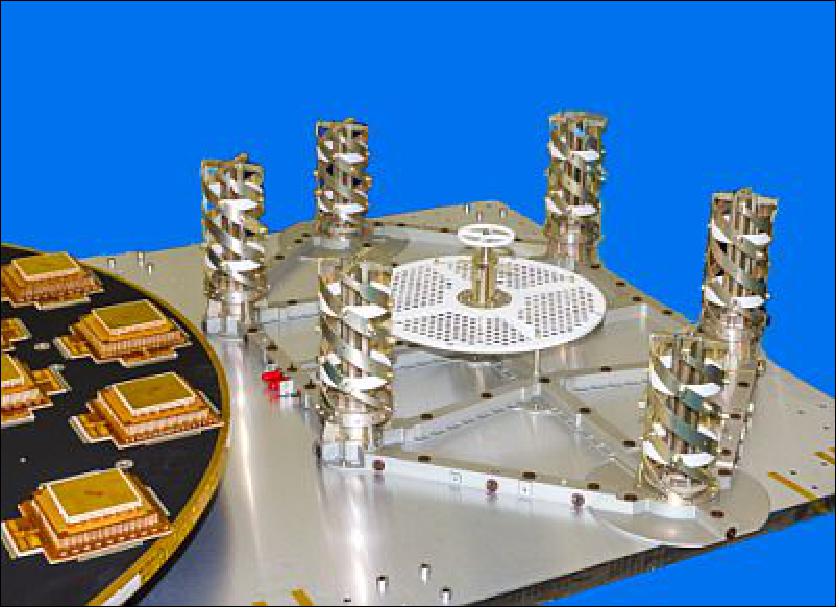
Note: Galileo’s UHF search and rescue antenna is located next to the satellite’s main circular navigation antenna.
Mier Comunicaciones and Rymsa, both of Spain, provided the hardware on the SAR-equipped IOV satellite pair now in orbit, with Kongsberg Norspace of Norway selected to provide the SARTs (SAR Transponders) on the follow-on Galileo-FOC satellites. 122)
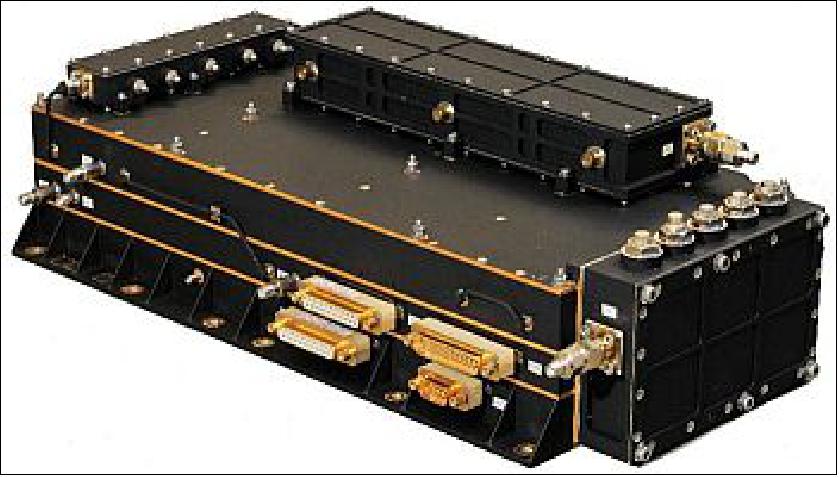
The shoebox-sized SART picks up emergency distress calls from the ground or sea and relays them to the nearest rescue center, while also sending a return-link message that help is on the way. Galileo’s search and rescue capability marks a significant enlargement of the international COSPAS-SARSAT system. 123)
The search and rescue package on each Galileo satellite, with its receive–transmit antenna housed next to the larger navigation antenna, is only 8 kg and consumes just 3% of satellite power.
Founded by Canada, France, Russia and the US, Cospas–Sarsat began with payloads on LEO (Low Earth Orbit) satellites, whose rapid orbital motion allowed Doppler ranging of distress signals, to pinpoint their source. - The drawback is that they fly so close to Earth that their field of view is comparatively small.
Now Galileo satellites, along with two other constellations orbiting at MEO (Medium Earth Orbit) altitudes, have joined Cospas–Sarsat. Because Galileo satellites fly at heights of 23,222 km, they combine broad views of Earth with the ability to quickly determine the position of a distress signal.
Status of Galileo's SAR (Search & Rescue) Service
• April 6, 2022: Today is the annual 406 Day, celebrating the life-saving importance of emergency beacons, named for the radio frequency they operate on, as well as the satellites that relay their signals – with Europe’s own Galileo constellation prominent among them. While Galileo’s main purpose is satellite navigation, the system also picks up distress messages from across the globe and relays them to regional search and rescue authorities. 124)
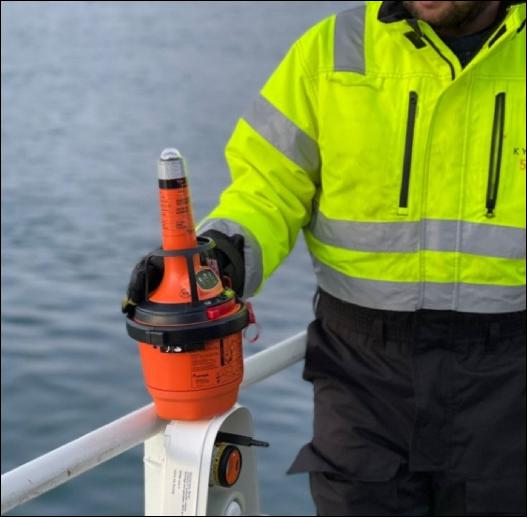
- Anytime you venture beyond mobile phone network coverage, such as hiking in wilderness, sailing out to sea or taking to the air, you are stepping into a riskier environment, out of easy contact with local emergency services. This is why 406 Day encourages you to take a flashlight-sized emergency beacon along. Run into trouble and the beacon transmits a 406 MHz SOS signal that will be picked up automatically by participating satellites, then relayed to the international Cospas-Sarsat system to pass on to rescuers.
- The only system that can independently locate a beacon anywhere on Earth, Cospas-Sarsat has saved thousands of people since it was founded in 1982. Originally its transponders were hosted aboard low-Earth orbit and geostationary satellites, with a significant extension to medium Earth orbit spearheaded by Galileo joining the system.
- Because Galileo satellites have such a high orbital altitude, at 23,222 km up while still moving steadily through the sky, they provide wide views of Earth with the ability to quickly source a distress signal through a combination of time-based and Doppler ranging.
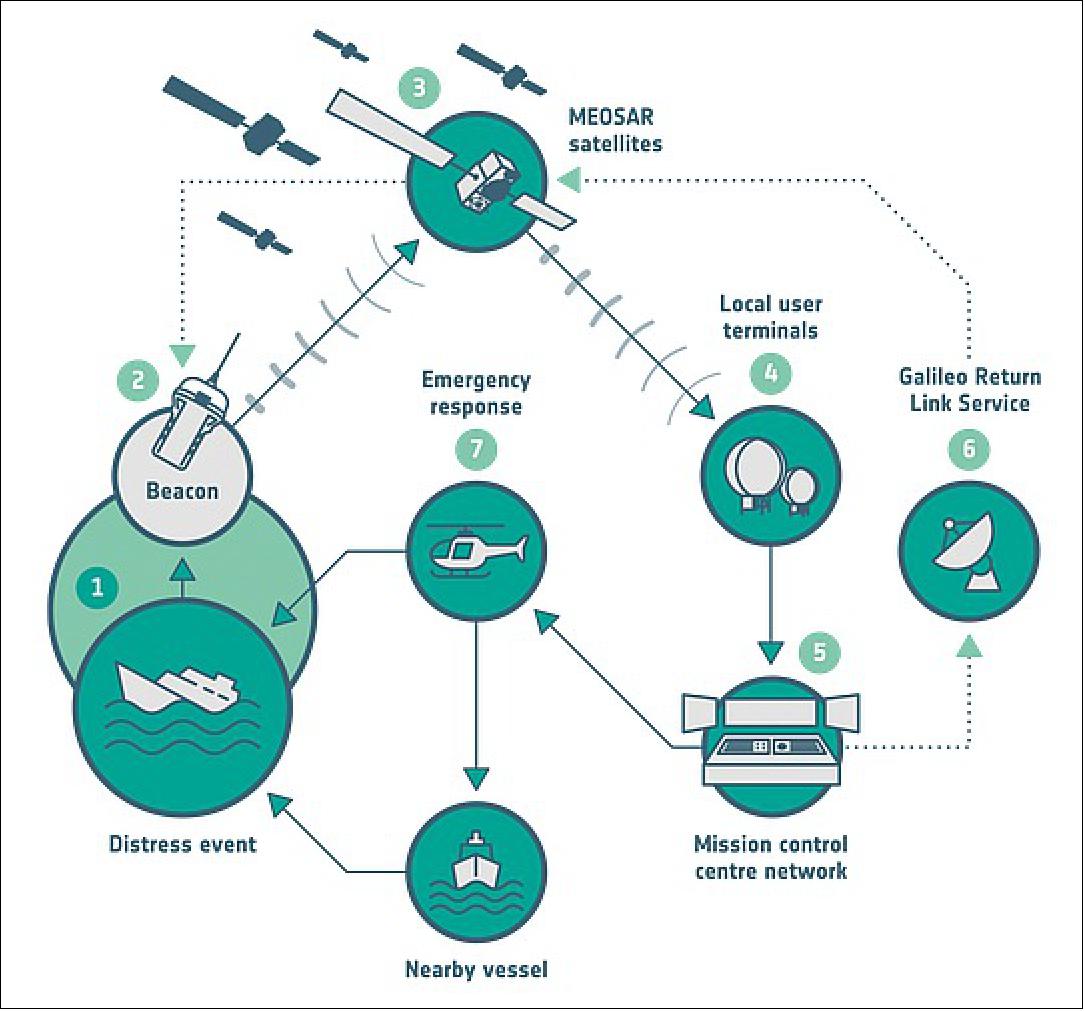
- “Galileo is the biggest contributor to this satellite-based system, which assisted search and rescue teams to save more than 2200 people in 2020 alone,” explains ESA Galileo Search and Rescue engineer Eric Bouton.
- “Galileo has also introduced a new search and rescue function, the Return Link Service, informing beacon users that their SOS message has been received and help is on the way. In March 2021 the Service reached Full Operational Capability to enter routine use, becoming the first Galileo service to reach this milestone.”
- The performance of Galileo’s Search and Rescue Service is monitored on an ongoing basis by the EU Agency for the Space Programme, EUSPA, Galileo’s service provider. In December 2021 the service achieved its best ever ‘quality of location service’ – assessing the probability of success of finding any emergency location to an error better than 2 km and 10 minutes – to a figure of 98.12%.
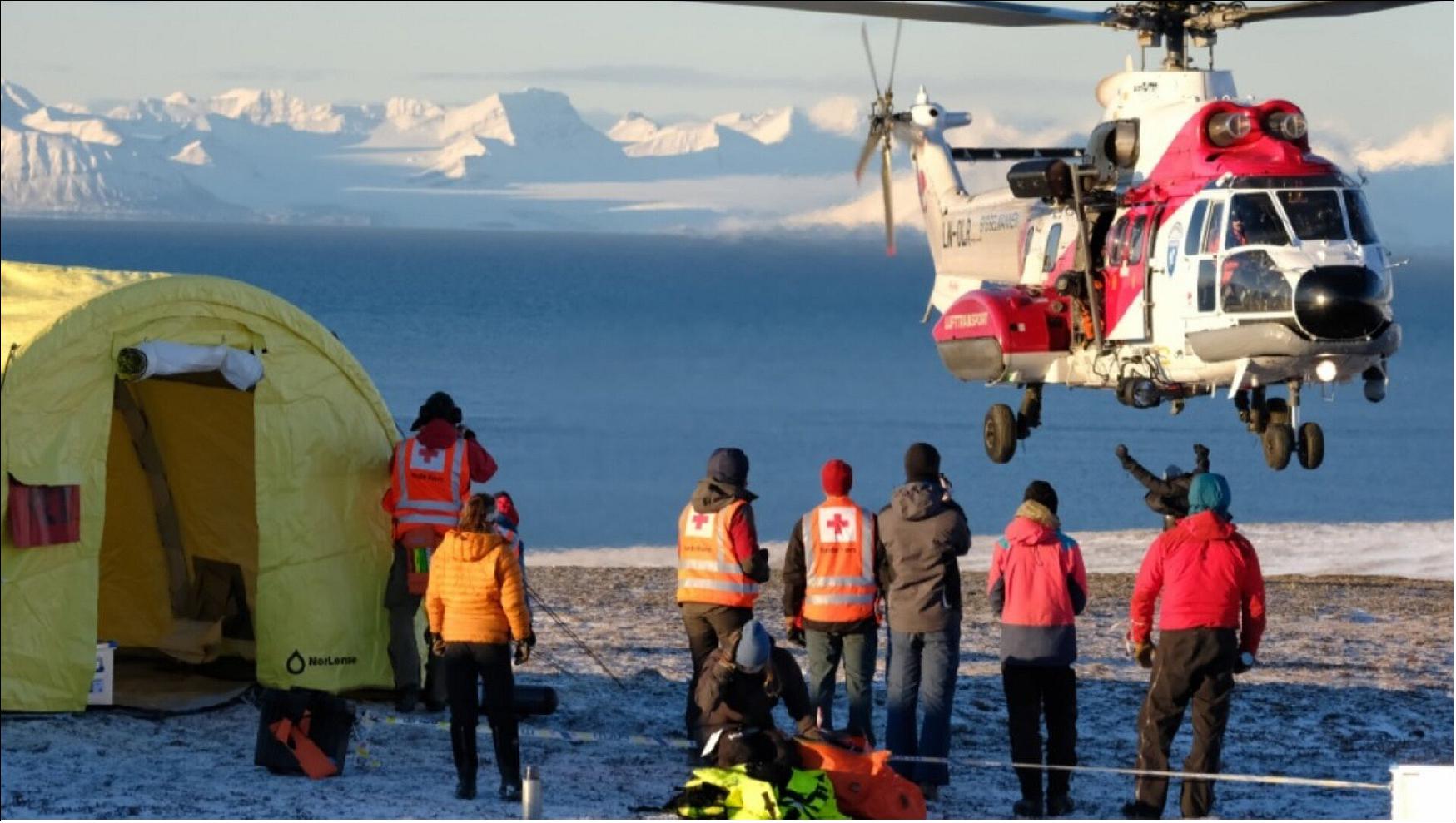
- The satellite transponders are supplemented by a trio of ground stations at the corners of Europe, known as Medium-Earth Orbit Local User Terminals (MEOLUTs), based in Norway’s Spitsbergen Islands, Cyprus and Spain’s Canary Islands and coordinated from a control centre in Toulouse, France, along with a fourth station on France’s La Reunion Island in preparation, for Indian Ocean coverage.
- “Last October EUSPA led a search and rescue exercise at the edge of European coverage area, in freezing waters off Svalbard in the Norwegian Arctic,” adds Eric. “A couple of hundred people were rescued from a ship by Norwegian authorities. Upon beacon activation it took only 2 minutes 20 seconds for Galileo to track down the vessel to a precision of 730 m, guiding helicopters and a coast guard vessel to begin the practice evacuation.”
- Galileo’s Search and Rescue service is operated by EUSPA, while ESA is responsible for its design, development and future evolution.
- The Galileo search and rescue antenna is shown in Figure 94.
• April 6, 2021: Today, we are celebrating the #406Day2021. What is “406 Day”? It is the 6th day of the 4th month, April, expressed as it might be in the United States and many other countries: “406”. The “International Search and Rescue Beacon” day. 125)
- What is “406 Day”?
- It is the 6th day of the 4th month, April, expressed as it might be in the United States and many other countries: “406”. This is a reference to the 406 Megahertz radio frequency that is monitored globally for signals from distress-alert beacons by the International Cospas-Sarsat Programme, a cooperation of 45 governments and agencies that helps save an average of seven lives a day, worldwide.
- The 406 Day is globally celebrated as the “International Search and Rescue Beacon” day.
- The European Commission, together with its partners (the European GNSS Agency (GSA), the European Space Agency (ESA) and France’s Centre National d'Etudes Spatiales (CNES), amongst others) is proud to have brought a European contribution to this international effort by installing distress-alert receivers onboard the Galileo satellites, delivering unprecedented speed of detection of the distress signals and accuracy in locating the position of the person in distress.
- The Galileo program provides today more satellites for distress-alert detection and location than any other constellation. Galileo also provides an exclusive function: the “Return Link Service” (RLS).
- This unique feature provides the user with an acknowledgement indication on the beacon that a distress signal from the beacon was received and its position located – a major morale booster for the people in life-threatening situations!
- In just over a year since its first introduction, the Return Link functionality of Galileo has been endorsed by the Cospas-Sarsat Council in March 2021 as having achieved the transition to Full Operational Capacity, available globally.
- The Search And Rescue Service of Galileo is a fantastic tool, but we shall not forget that rescue operations can only be successful thanks to the amazing people involved in the rescue operations. People who put their comfort – and sometimes their lives – at risk to help and assist those in danger.
- Today is a great day to recognize their actions, and pay tribute to their courage and dedication.
- We remain committed to provide them with the best and most adapted tools as possible.
- Therefore, we have sent invitations today to more than 250 operational Search And Rescue units to collect their views and their expectations, so that the Next Developments of Galileo/SAR will match their operational needs as closely as possible, to save even more lives in the future.
• January 23, 2020: As well as providing global navigation services, Europe’s Galileo satellite constellation is contributing to saving more than 2000 lives annually by relaying SOS messages to first responders. And from now on the satellites will reply to these messages, assuring people in danger that help is on the way. 126)
- This ESA-design ‘return link’ system, unique to Galileo, was declared operational this week, during the 12th European Space Conference in Belgium. The delivery time for the return link acknowledgement messages from initial emergency beacon activation is expected to be a couple of minutes in the majority of cases, up to 30 minutes maximum, depending primarily on the time it takes to detect and locate the alert.
- “Anyone in trouble will now receive solid confirmation, through an indication on their activated beacon, informing them that search and rescue services have been informed of their alert and location,” explains ESA’s Galileo principal search and rescue engineer Igor Stojkovic. “For anyone in a tough situation, such knowledge could make a big difference.”
- All but the first two out of 26 Galileo satellites carry a Cospas-Sarsat search and rescue package. At only 8 kg in mass, these life-saving payloads consume just 3% of onboard power, with their receive-transmit repeater housed next to the main navigation antenna.
- Founded by Canada, France, Russia and the US in 1979, Cospas-Sarsat began with payloads on LEO (Low Earth Orbiting) satellites, whose rapid orbital motion allows Doppler ranging of distress signals, to pinpoint their location. The drawback is these fly so close to Earth that their field of view is comparatively small.
- GEO (Geostationary Earth Orbiting) satellites went on to host Cospas-Sarsat payloads. These see much more of the planet, but because they are motionless relative to Earth’s surface, Doppler ranging is not possible.
- MEO (Medium Earth Orbiting) satellites such as Galileo – orbiting at 23,222 km altitude – offer the best of both worlds, providing a wide ground view by multiple satellites combined with time-of-arrival and Doppler ranging techniques to localize SOS signals. This improves the maximum signal detection time from four hours to less than five minutes, down to 1 or 2 km (within a formal specification of 5 km within 10 minutes).
- Galileo’s Search and Rescue service is Europe’s contribution to Cospas-Sarsat, operated by the European GSA (Global Navigation Satellite System Agency), and designed and developed at ESA. As the overall Galileo system architect and design authority, ESA has been responsible for the interface between the core Galileo infrastructure to the Return Link Service Provider facility, procured by the European Commission and operated by French space agency CNES.
- The Cospas-Sarsat satellite repeaters are supplemented by a trio of ground stations at the corners of Europe, known as Medium-Earth Orbit Local User Terminals (MEOLUTs), based in Norway’s Spitsbergen Islands, Cyprus and Spain’s Canary Islands and coordinated from a control center in Toulouse, France. This trio is soon to become a quartet, with a fourth station on France's La Reunion Island in the Indian Ocean under development.
- The satellites relay distress messages to these MEOLUTs, which then relay them to local search and rescue authorities.
- The service’s return link message capability was developed as an inherent part of the Galileo system. The messages are relayed to the individual beacons that sent the original distress call by being embedded within Galileo signals broadcast from satellites in their view.
- “The switching on of the return link service was enabled by a thorough test campaign carried out by ESA, with the support of the GSA and CNES,” adds Igor. “We needed to be sure the service remains reliable even with multiple distress calls being replied to at once.”
- A key milestone was a public demonstration of the return link service, performed at the Cospas-Sarsat Joint Committee Meeting in Doha in Qatar last summer.
- “The return link is a joint service of Cospas-Sarsat and Galileo and therefore agreement by Cospas-Sarsat was crucial,” adds Igor.
- “This acceptance was achieved through long discussions led by the European Commission at the Cospas-Sarsat Council last November, supported by plentiful documentation of simulations and test results provided by ESA and CNES.”
• April 6, 2017: Europe’s Galileo satnav network does more than let us find our way – it is also helping to save lives. Today sees a spotlight cast on Galileo’s Search and Rescue service, which pinpoints people in distress on land or sea. 127)
- The service is Europe’s contribution to the COSPAS–SARSAT international satellite-based locating system that has helped to rescue more than 42,000 people since 1982 – the only system that can independently locate a distress beacon wherever it is activated on Earth.
- The Galileo SAR service is being formally premiered today (April 6, 2017), a date chosen to highlight the COSPAS–SARSAT 406 MHz signal.
- This new system has already proven its worth, as Tore Wangsfjord, Chief of Operations at Norway’s Joint Rescue Coordination Center recounted to a satnav meeting in Munich, Germany, last month. His center’s responsibility extends from 55ºN to the North Pole: “The results with Galileo have been good so far, and will improve with more satellites.”
- A recent rescue was triggered by a distress signal from a crashed helicopter in the far north of Norway. The distress signal via Galileo arrived at his center 46 minutes before the alert from the existing COSPAS–SARSAT, and the identified position proved to be within 100 m of the crash, rather than the current system’s 1.5 km. — “This is just one of several real-life distress situations where it has already shown improved accuracy and timing. Galileo will undoubtedly contribute to saving lives.”
- As Xavier Maufroid of the European Commission told the Munich summit: “The service represented just 1% of total Galileo program costs, but should result in thousands of lives being saved.” 128)
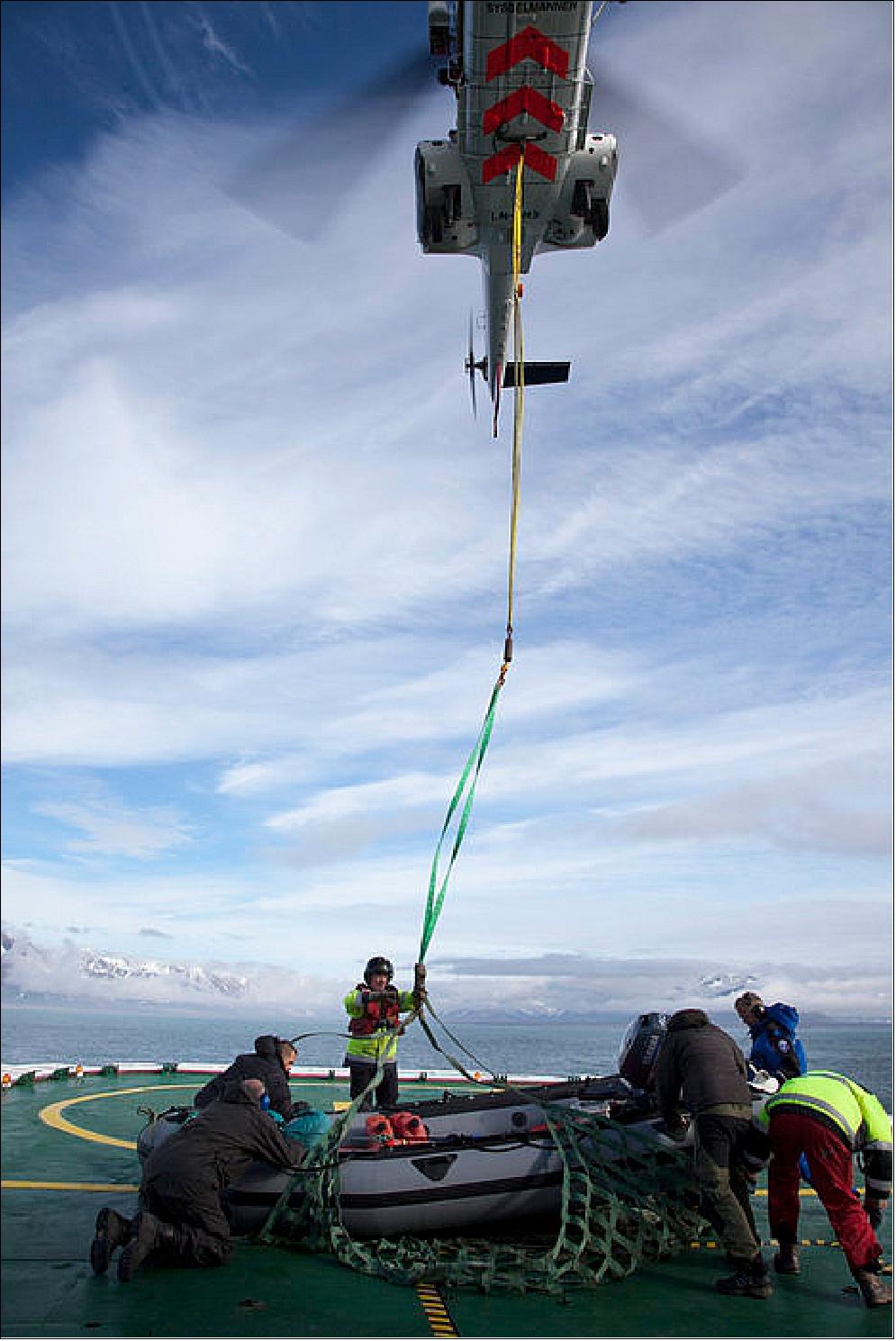
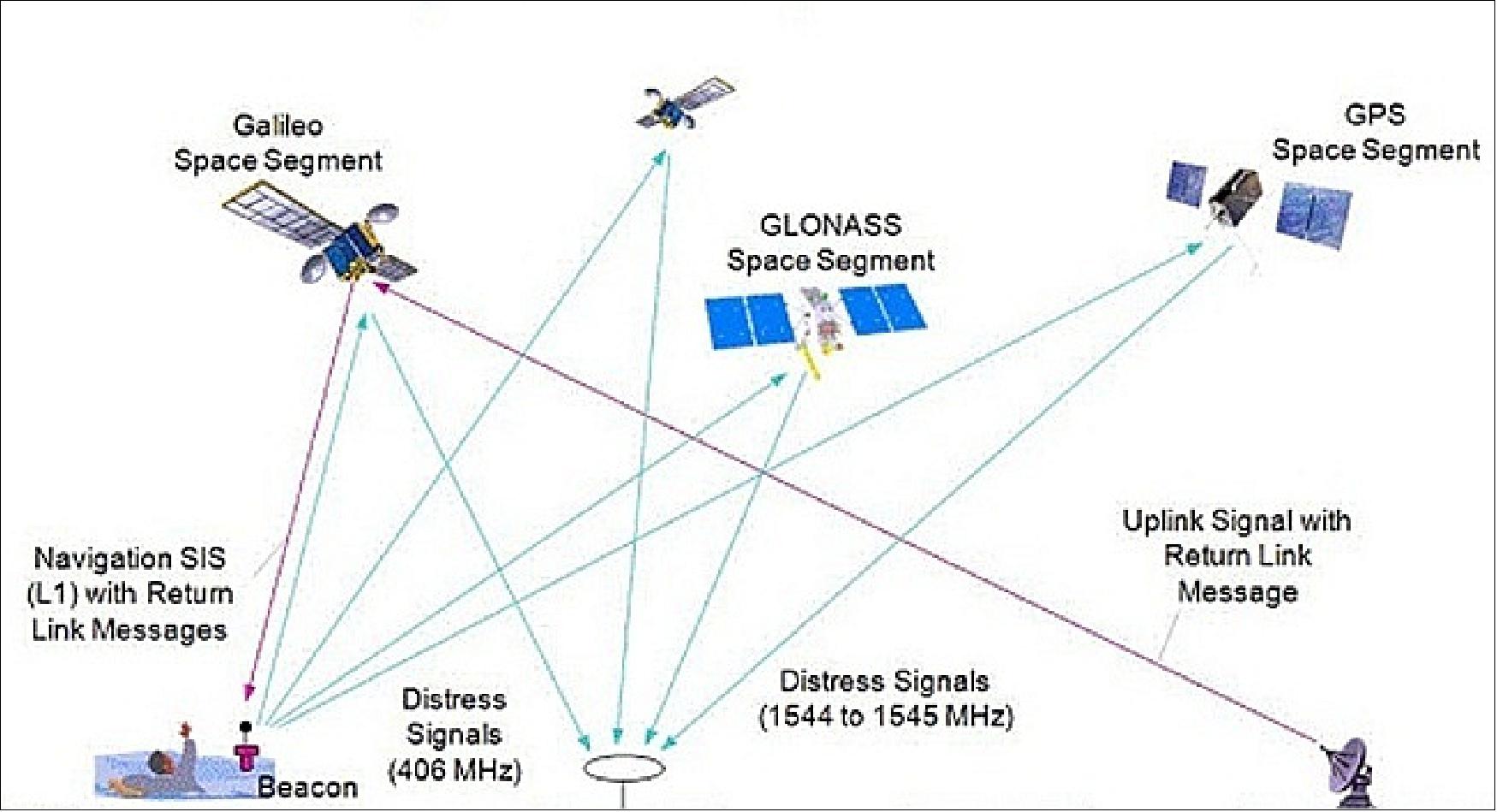
Galileo's Ground Segment
The Galileo Ground Segment necessary is one of the most complicated developments undertaken by Europe, having to fulfil strict levels of performance, security and safety: 131) 132)
• GMS (Ground Mission Segment): The GMS must provide cutting-edge navigation performance at high speed around the clock, processing data from a worldwide network of stations. GMS has two million lines of software code, 500 internal functions, 400 messages and 600 signals circulating through 14 different elements.
The GMS is responsible for the determination and uplink of navigation data messages needed to provide the navigation and UTC time transfer service. For this purpose, it will use a global network of GSS (Galileo Sensor Stations) to monitor the navigation signals of all satellites on a continuous basis, through a comprehensive communications network using commercial satellites as well as cable connections in which each link will be duplicated for redundancy. The prime element of the GSS is the Reference Receiver.
The GMS communicates with the Galileo satellites through a global network of mission ULS (UpLink Stations), installed at five sites, each of which will host a number of 3 m antennas. The ULSs will operate in the 5 GHz Radionavigation Satellite (Earth-to-space) band.
The GMS will use the GSS network in two independent ways. The first is the OD&TS (Orbitography Determination and Time Synchronization) function, which will provide batch processing every 10 minutes of all the observations of all satellites over an extended period and calculates the precise orbit and clock offset of each satellite, including a forecast of predicted variations, SISA (Signal-in-Space Accuracy), valid for the next hours. The results of these computations for each satellite will be up-loaded into that satellite nominally every 100 minutes using a scheduled contact via a mission ULS. The OD&TS operation thus monitors the long-term parameters due to gravitational, thermal, ageing and other degradations.
• GCS (Ground Control Segment): The GCS monitors and controls the constellation with a high degree of automation.
(During the IOV phase the GMS is located in the Fucino Control Centre in Italy and the GCS in the Oberpfaffenhofen Control Center in Germany. In the future, the two centers will host equivalent facilities, working together as hot backups with realtime data synchronization. In the event of the loss of one centre, the other will be able to continue operations in a seamless way.)
The GCS s responsible for satellite constellation control and management of Galileo satellites. It provides the telemetry, telecommand and control function for the whole Galileo satellite constellation. Its functional elements are deployed within the Galileo Control Centers (GCC) and the five globally distributed Telemetry Tracking and Control (TT&C) stations. To manage this, the GCS will use a global network of nominally five TTC stations to communicate with each satellite on a scheme combining regular, scheduled contacts, long-term test campaigns and contingency contacts.
A hybrid Communication Network interconnects the remote stations (ULS, GSS, and TTC stations) with the GCC by different means of standard and special radio, wired data and voice communication links, assuring the communication between all the sites. The two Ground Control Centres (GCCs) constitute the core of the Ground Segment. There are two redundant elements located at Fucino (Italy) and Oberpfaffenhofen (Germany).
• TTC (Telemetry, Tracking and Command Stations): There are two, at Kiruna in Sweden and Kourou in French Guiana. The TTC Stations will include 13 m antennas operating in the 2 GHz space operations frequency bands. During normal operations, spread-spectrum modulation, similar to that used for TDRSS (Tracking and Data Relay Satellite System), and ARTEMIS data relay applications, will be used, to provide robust, interference free operation. However, when the navigation system of a satellite is not in operation (during launch and early orbit operations or during a contingency) use of the common standard TTC modulation will allow non-ESA TTC stations to be used.
The TTC facility element comprises a number of unique subsystems that perform the necessary uplink, downlink, ranging, calibration and control and monitor processing functions for the TTC management of the Galileo constellation of satellites. During the IOV phase there will be 2 TTC stations, while in the FOC configuration the number of stations will be 5.
Each TTC station is composed of the following subsystems:
- Antenna and tracking
- RF transmission
- RF reception
- Timing and frequency references generation and distribution
- Baseband units (including TM, TC and ranging functions)
- Monitor and control subsystem
- Communications subsystem
- Calibration and testing
- Meteo
- Simulators.
• ULS (Uplink Stations): These consist of a network of stations to uplink the navigation and integrity data. The ULS nominally comprises 9 ULS sites deployed all over the world, with capability to expand to regional ULS for additonal services. Five ULS for the IOV phase with two Uplink Chains and the additional ones for the FOC. 133)
Each ULS encompases 4 independent uplink chains. Each one inlcudes:
- 3.5 m full motion X/Y pedestal antenna transmitting antenna
- An outdoor 30 W solid state power amplifier
- A frqeuency converter set, with U/C and test D/C
- A spread spectrum baseband unit with doppler compensation capabilities
- A mission message processor in charge of message coding and assembly
- A monitoring and control system to manage the chain and the external interfaces
- A set of two shelters for field deployment
- A GALILEO system time receiver for frequency and time synchronization.
• GSS (Galileo Sensor Stations): a global network providing coverage for clock synchronization and orbit measurements.
• DDN (Data Dissemination Network): The DDN is interconnecting all Galileo ground facilities.
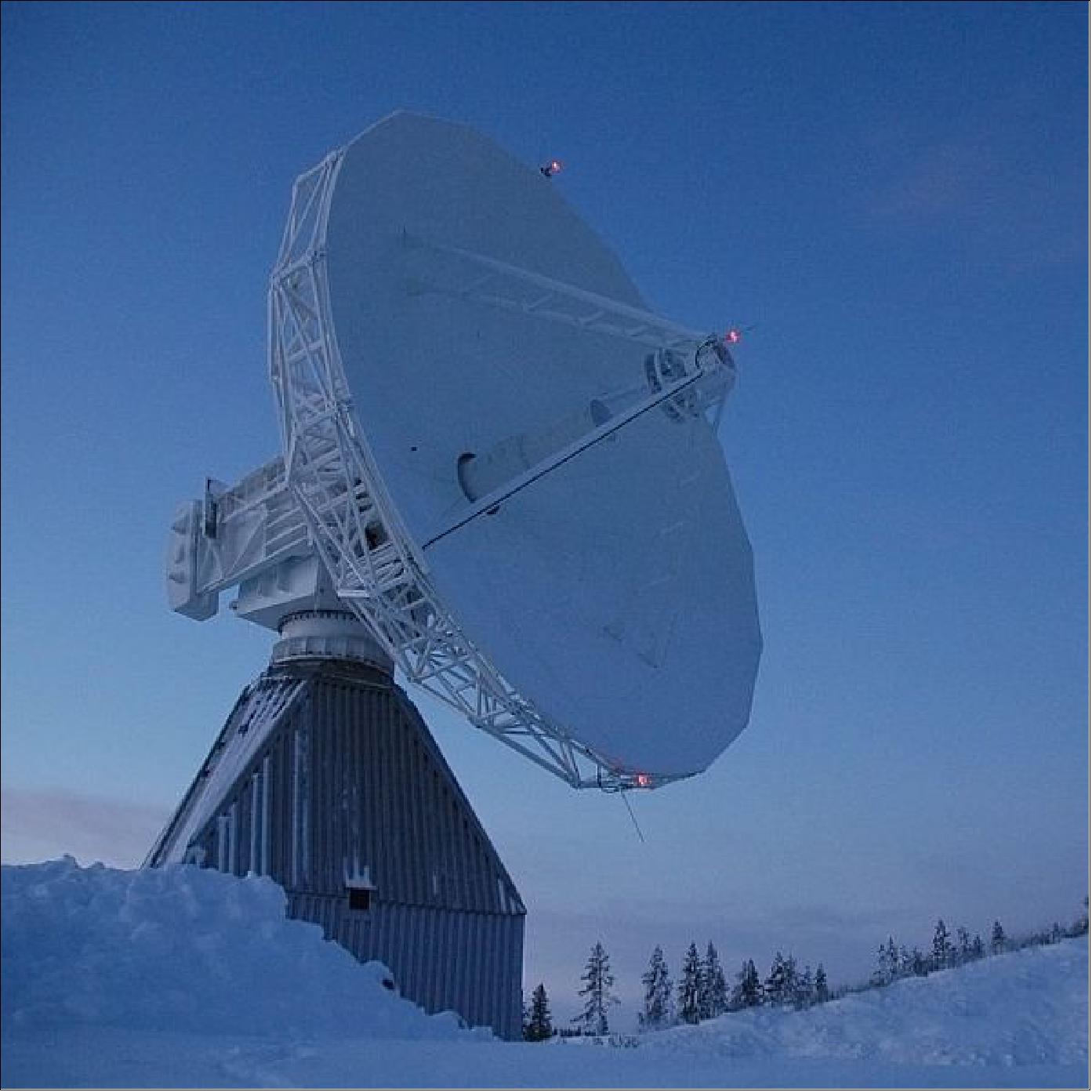
World of Galileo (Status of ground segment)
• October 25, 2021: A significant first for next month’s 11th Galileo launch: thanks to an upgrade of the world-spanning Galileo Control Segment, this will be the first launch where the satellites ‘ first steps into space will be overseen from an existing Galileo Control Centre, rather than requiring an external mission control site. 135)
- For all Galileo launches up until this one, the satellites’ post-liftoff ‘Launch and Early Operations Phase’ (LEOP) have been overseen from either ESA’s ESOC control center in Darmstadt, Germany, or French space agency CNES’s site in Toulouse, France.
- This is no longer the case thanks to the update of the Galileo Control Segment to Version 3.0. Encompassing the two Galileo Control Centers in Oberpfaffenhofen in Germany and Fucino in Italy, as well as six Telemetry, Tracking and Control (TT&C) ground stations used to monitor and command the 26 Galileo satellites currently in orbit, the hugely demanding upgrade was performed by an industrial consortium led by GMV in Spain.
- Over the last three years a complete technological refresh of the GCS (Ground Control Segment) software and hardware, including the porting of software modules corresponding to several million lines of code, the deployment of equipment at many Galileo sites and the execution of a rigorous level of testing throughout all elements comprising the system.
- Commencing in mid-2018, the upgrade had to contend with the worldwide COVID-19 pandemic midway through its lifetime, but the team pushed on to finally conclude at the end of July. Since the 4 August 2021 it has been used to nominally operate all the satellites in the constellation.
- The project was overseen by ESA in its System Prime role managing Galileo’s design, development, qualification and deployment of future upgrades on behalf of the European Commission, Galileo’s owner.
- Galileo’s worldwide ground segment has been described as the most complex system ever developed by ESA. It is operated by the Spaceopal company – a joint undertaking between Italian company Telespazio and German firm Gesellschaft für Raumfahrtanwendungen mbH, set up especially for this purpose – under contract to EUSPA, the EU Agency for the Space Program. The ground segment is divided into two segments: the Galileo Mission Segment, which oversees the functioning of the satellites’ navigation payloads including the generation of their signal messages, and the GCS which oversees the functioning of the satellites themselves.
- The purpose of the GCS is to monitor and control the satellites in the Galileo constellation employing the Galileo TT&C stations spread around the world. In order to do this, telemetry is gathered and analyzed to monitor satellites’ overall health as well as to identify and correct, via telecommands uplinked to the satellites, any orbital drift that might degrade Galileo accuracy or any other contingency detected on-board.
- “The original Galileo Control Segment design was initiated in the early 2000s (see Figure 107) and has consistently evolved to cope with the rate of Galileo launches but it was the time for a complete refresh,” explains Pedro Rodríguez de Andrés, GCS System Engineer.
- “So part of the purpose of this upgrade was to deal with obsolescence, eliminate anomalies and enhance overall reliability through introducing state-of-the-art technologies that would also pave the way to future expansions. The upgrade also adds significantly to the system’s cybersecurity and security monitoring, making the satellites more secure than ever.”
- “The deployment of the Galileo Control Segment v 3.0 is completed and now it is possible to perform all satellite activities, including LEOP, entirely from Galileo ground segment infrastructure.”
- For next month’s launch of Galileo satellites 27-28, their LEOP will be overseen from Galileo’s Control Centre in Oberpfaffenhofen.
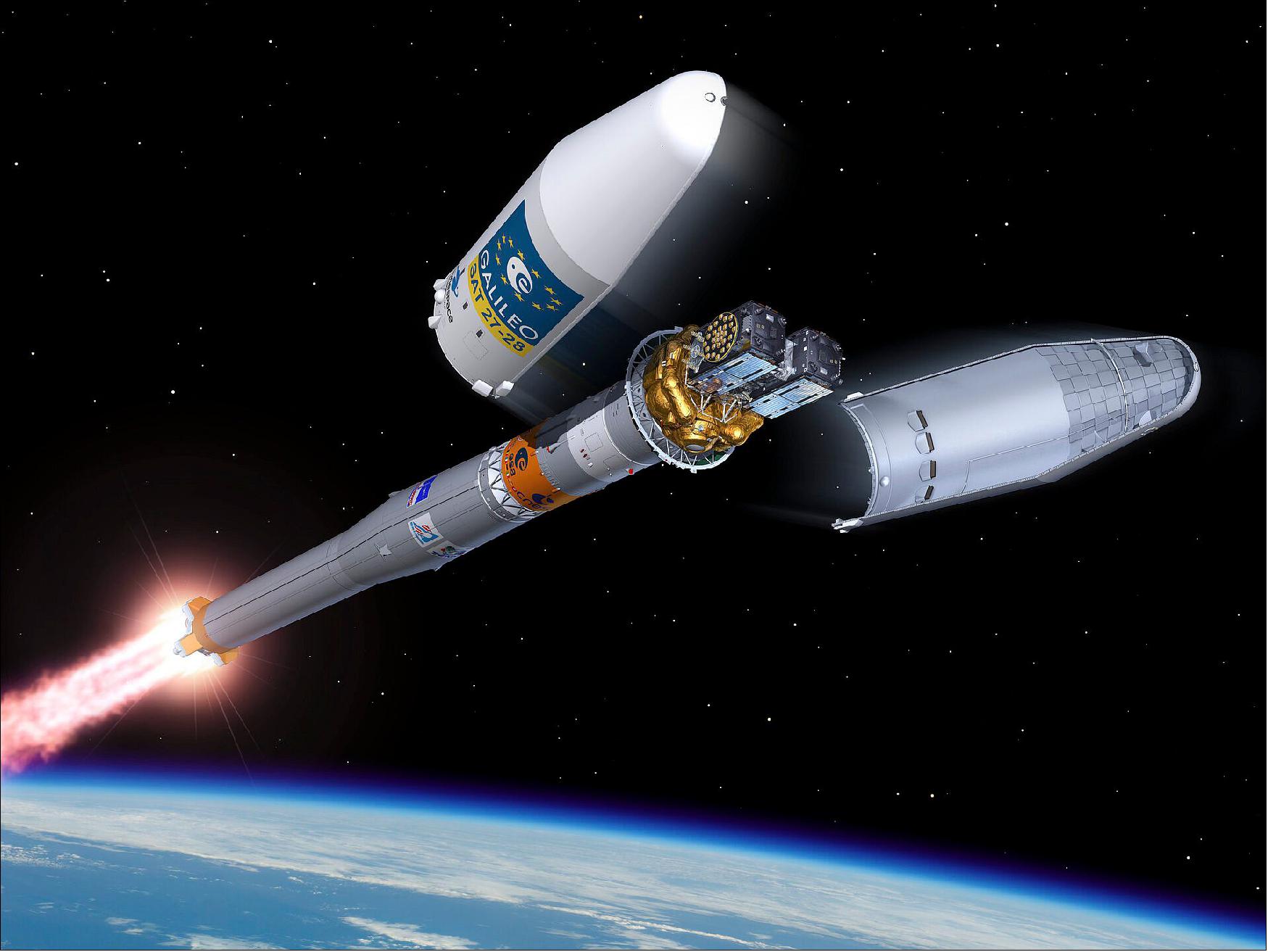
- As well as increasing overall reliability and cybersecurity, this new upgrade also opens the way to significant expansion of the Galileo constellation, which at 26 satellites already equals Europe’s largest satellite constellation. This updated Galileo Control Segment (GCS) is designed to enable oversight of up to 38 satellites, harnessing state-of-the-art technology using the latest solutions on the market.
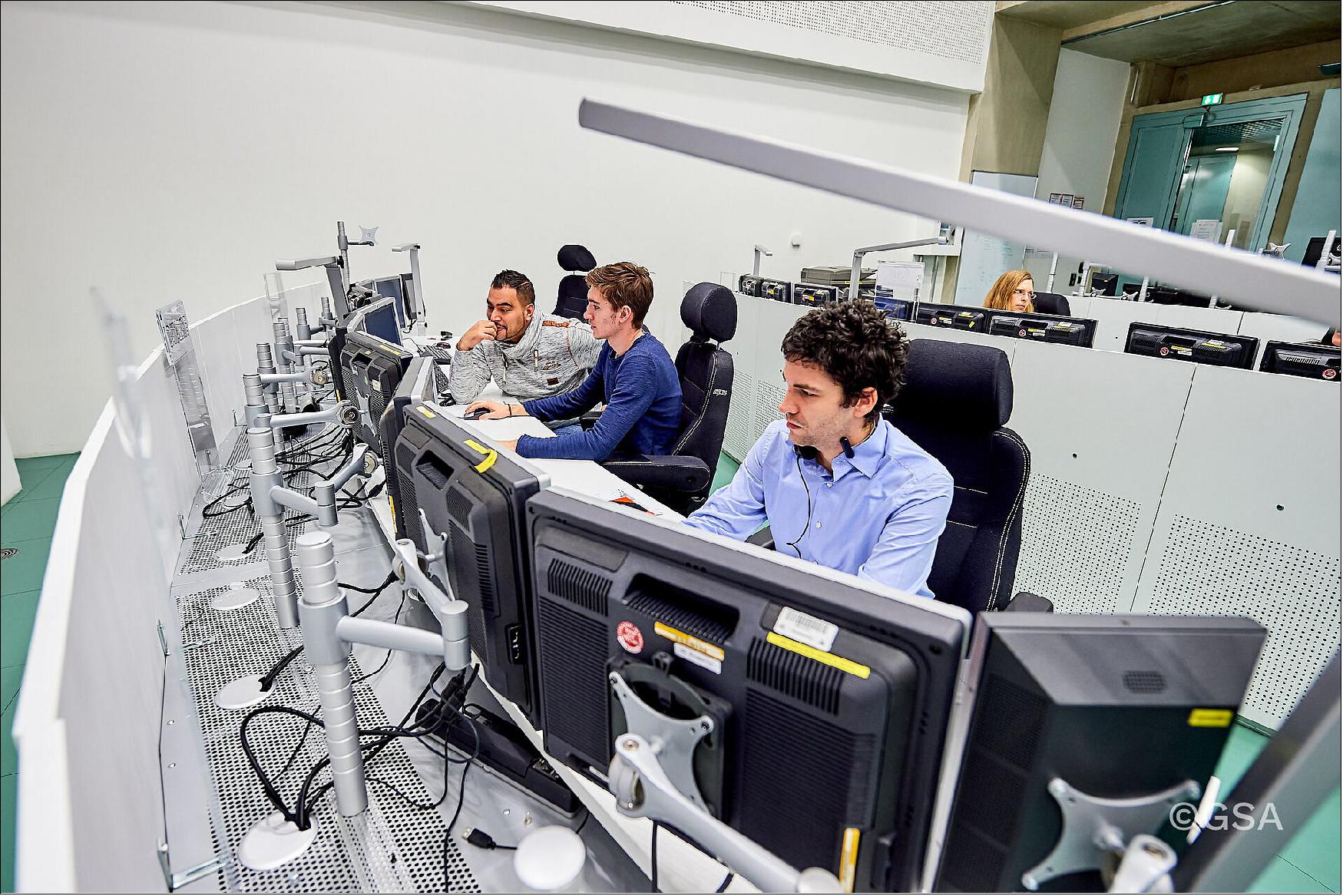
About Galileo
- Galileo is currently the world’s most precise satellite navigation system, serving more than two billion users around the globe.
- The Full Operational Capability (FOC) phase of the Galileo program is managed and funded by the European Union. The European Commission, ESA and EUSPA (EU Agency for the Space Program) have signed an agreement by which ESA acts as design authority and system development prime on behalf of the Commission and EUSPA as the exploitation and operation manager of Galileo/EGNOS. “Galileo” is registered as a trademark in the database of the European Union Intellectual Property Office (n° 002742237).
• October 21, 2021: Using the best navigation technologies to bring the greatest benefit to their users – this is the what the Galileo Competence Center at the German Aerospace Center (Deutsches Zentrum für Luft- und Raumfahrt; DLR) is working towards. Together with DLR's institutes, facilities and partners, products are being developed to ensure the continuous improvement of the European Galileo satellite navigation system. The Galileo Competence Center is now officially open. 136)
- "Global satellite navigation systems such as Galileo have developed over decades into a central element of the infrastructure of the modern world and mobile society. They will only continue to gain in importance," says Anke Kaysser-Pyzalla, Chair of the DLR Executive Board. "The Galileo Competence Center was founded to continue successfully shaping the future of satellite navigation and to promote its benefits for business and industry."
- At the Galileo Competence Center, users, ground facilities and satellites are all given equal consideration. The aim is to implement future-oriented concepts and technologies for the European satellite navigation system and to contribute to the further development of Galileo.
The Galileo Competence Center plans for 150 staff
- The Galileo Competence Center has been under development since 2019. There are currently 35 staff at the site in Oberpfaffenhofen and, in the future, approximately 150 people will work towards its core objectives.
- "It is impossible to imagine everyday life without satellite navigation and it is the backbone of an industrial society. It enables precise positioning in air, road, rail and maritime transport and is thus the basis for automated driving and the modernization of our transport systems," says Thomas Jarzombek, Federal Government Coordinator of German Aerospace Policy. "It enables reliable timing in international communications, energy supply and bank transfer systems, as well as electronic stock exchange trading. It will also determine the establishment of universal time standards in the future. And, last but not least, many apps that we all use every day would not work without it. With Galileo, Europe has a navigation system at its disposal that is of strategic importance for its sovereignty. With quantum technologies, Galileo can realize major improvements in the measurement accuracy of distances, positions and times, and thus an enormous increase in the performance of satellite-navigation-based applications can be expected. We must modernize Europe's satellite infrastructure quickly and consistently in order to secure technological sovereignty in this field and avoid dependence on other systems. DLR’s Galileo Competence Center will make a significant contribution here."
Iodine Laser Clock – Tested on the ISS
- One of the major ongoing projects at the Galileo Competence Center is COMPASSO, which is testing optical technologies on the International Space Station (ISS). Specifically, this project involves an iodine laser clock developed at DLR, a laser terminal and an optical frequency comb. For use in space, all components must be particularly small, robust and durable. The iodine laser clock, in combination with the other components, enables a significant improvement in position determination on Earth. Further systems are in development and will be mounted on the ISS Bartolomeo platform. When these technologies have proven themselves in the test environment, they will be deployed for use on Galileo satellites.
- The Robust Precise Timing Facility (RPTF) for Galileo combines the output of clocks on the ground and those on board the satellites into a common system-wide time measurement, which is continuously aligned with universal time. Accurate timekeeping that is extremely robust and can correct itself is not only important for navigation, but also for financial transactions, the energy sector and agriculture.
- "Bavaria is at the heart of German aerospace research. With our planned special funding of 25 million euros, we want to ensure that this remains the case," says Bavaria's State Minister for Economic Affairs, Regional Development and Energy, Hubert Aiwanger. "I am convinced that this is very good investment. With these funds, new office and laboratory space will be created at the Galileo Competence Center here in Oberpfaffenhofen for research into new technologies and applications. In addition, together with the German Federal Government, we are contributing to the financing of ongoing operations. I wish all those involved in the Galileo Competence Center every success."
Scientific and Technical Expertise from DLR Institutes and Facilities
- The Galileo Competence Center cooperates closely with DLR institutes and facilities, including the Institute of Communications and Navigation, the Institute of Quantum Technologies, the Institute for Software Technology, the Institute of Space Systems, the Institute of Optical Sensor Systems, the Institute for Solar-Terrestrial Physics and the Space Operations and Astronaut Training facility. The Galileo Competence Center draws on established scientific and technical expertise and comprehensive experience with the requirements of various user groups. Another focus is the use and promotion of quantum technologies. With its expertise, the Center will serve as a point of contact between government, researchers, industry, the European Commission and other partners.
• November 24, 2020: The Galileo Second Generation will phase in of new services, improve existing services and increase security. The technology multinational GMV (Madrid, Spain) is playing a key role in the Galileo Second Generation (G2G) ground segment. 137)
- G2G’s main objectives are to phase in new services, improve existing services, and boost system robustness and security while cutting both operating and maintenance costs, to cement Galileo’s position as one the future’s top GNSS.
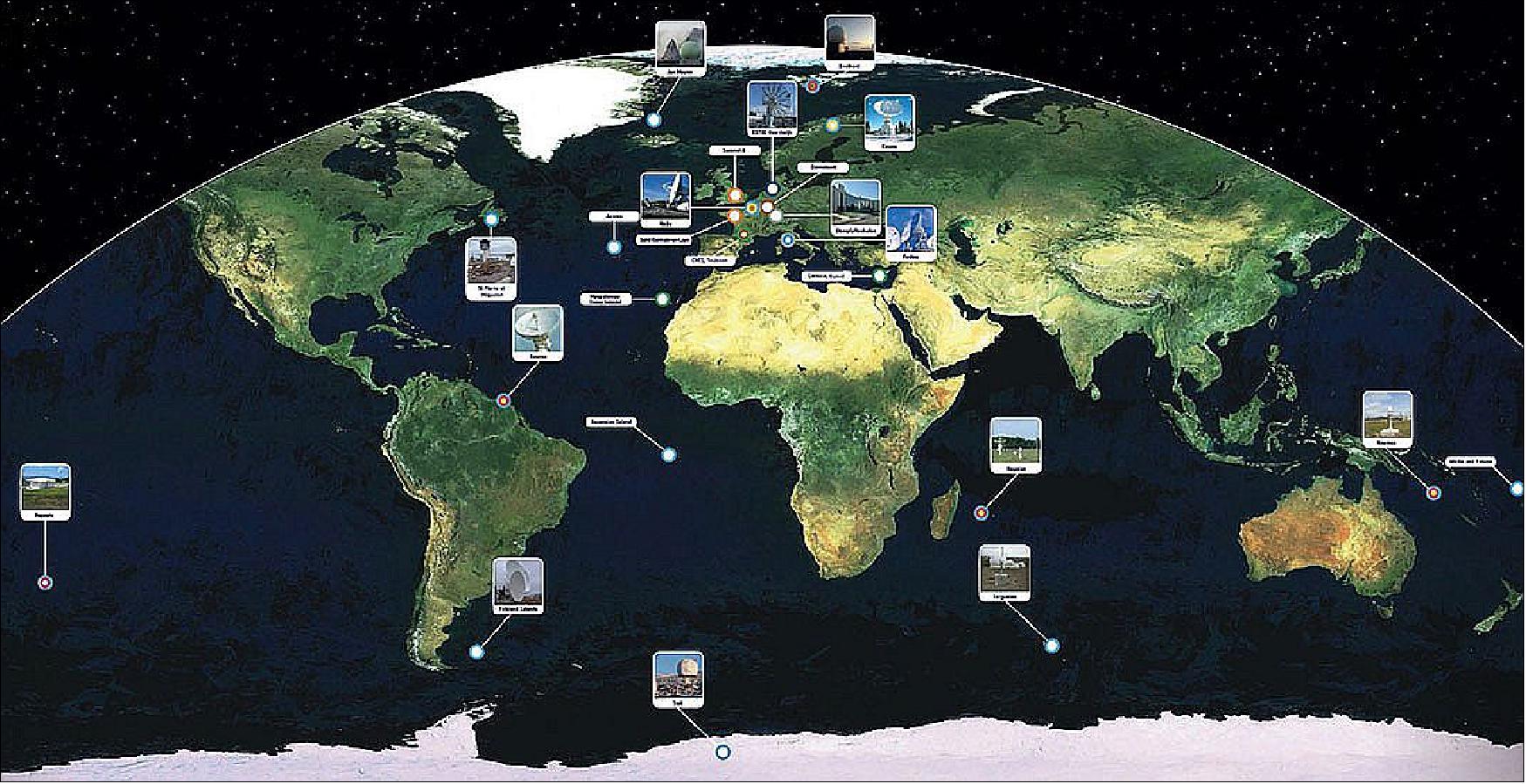
- Three phases. G2G is divided into several phases. In the first, led by the European Space Agency (ESA), mission requirements were defined at system level. This was followed by a preparation phase, then an implementation phase.
- As well as priming several mission-requirement projects, GMV, since 2018, has been heading one of the consortia working on G2G’s complete ground segment during the preparation phase.
- Within the preparation phase — shortly before the start of the COVID lockdown — ESA announced the successful end of the first phase before launching a bid invitation for the second phase as the prelude to G2G implementation.
- Although publication of the bid invitation for this phase was eventually pushed back until mid-June, GMV never broke off its G2G activities. In recent months GMV has brought new recruitments and partners into the project team while also working on new ideas and kicking off some project activities.
- Team members have attended various skills-training courses, some of them gaining certification under SAFe 5 Agilist. During these months, GMV has also been working under new pandemic circumstances with teleworking, virtual meetings and new toolboxes.
- First Generation. Galileo First Generation (G1G), running since December 2016, consists of space infrastructure (26 satellites to date) and ground infrastructure. Galileo is now providing 20-cm-precision positioning, navigation and timing services for over 400 million users around the world.
• December 21, 2018: Having completed all necessary qualification testing, ESA has received the green light to upgrade the global infrastructure running Europe’s Galileo satellite navigation system. The resulting migration, set to start in February 2019, will incorporate new elements into the world-spanning system and boost the robustness of Galileo services delivered from the 26 satellites in orbit. 138)
- Authorization for this upgrade – formally known as Galileo System Build 1.5.1 – has been given by the Galileo Security Accreditation Board, made up of European Union Member States.
![Figure 106: A replica Galileo satellite at the Oberpfaffenhofen Control Center in Germany, used to oversee the Galileo constellation [image credit: European GSA (Global Navigation Satellite Systems Agency)]](https://www.eoportal.org/ftp/satellite-missions/g/GalileoFOC_130622/GalileoFOC_Auto11.jpeg)
- This important milestone marks the climax of a system qualification campaign that took more than a year to execute: more than 150 system tests summing up to a total of 409 tests runs across Europe in the various Galileo operational centers. This work was performed by the ESA Galileo project team in very tight collaboration with the WP1x system support team led by Thales Alenia Space in Italy.
- “This marks the first update for Galileo’s operational infrastructure since it entered service,” explains ESA Galileo system test and verification manager Edward Breeuwer. “Galileo Initial Services began in December 2016 then last year we passed control of the system to our partner organization, the European GSA (Global Navigation Satellite System Agency).
- “This therefore marks a major step, but migration to the upgraded system should in principle be entirely transparent to Galileo users. We achieve this by taking advantage of the redundant elements of the Galileo system, taking them offline to update them while their operational counterparts continue to run.”
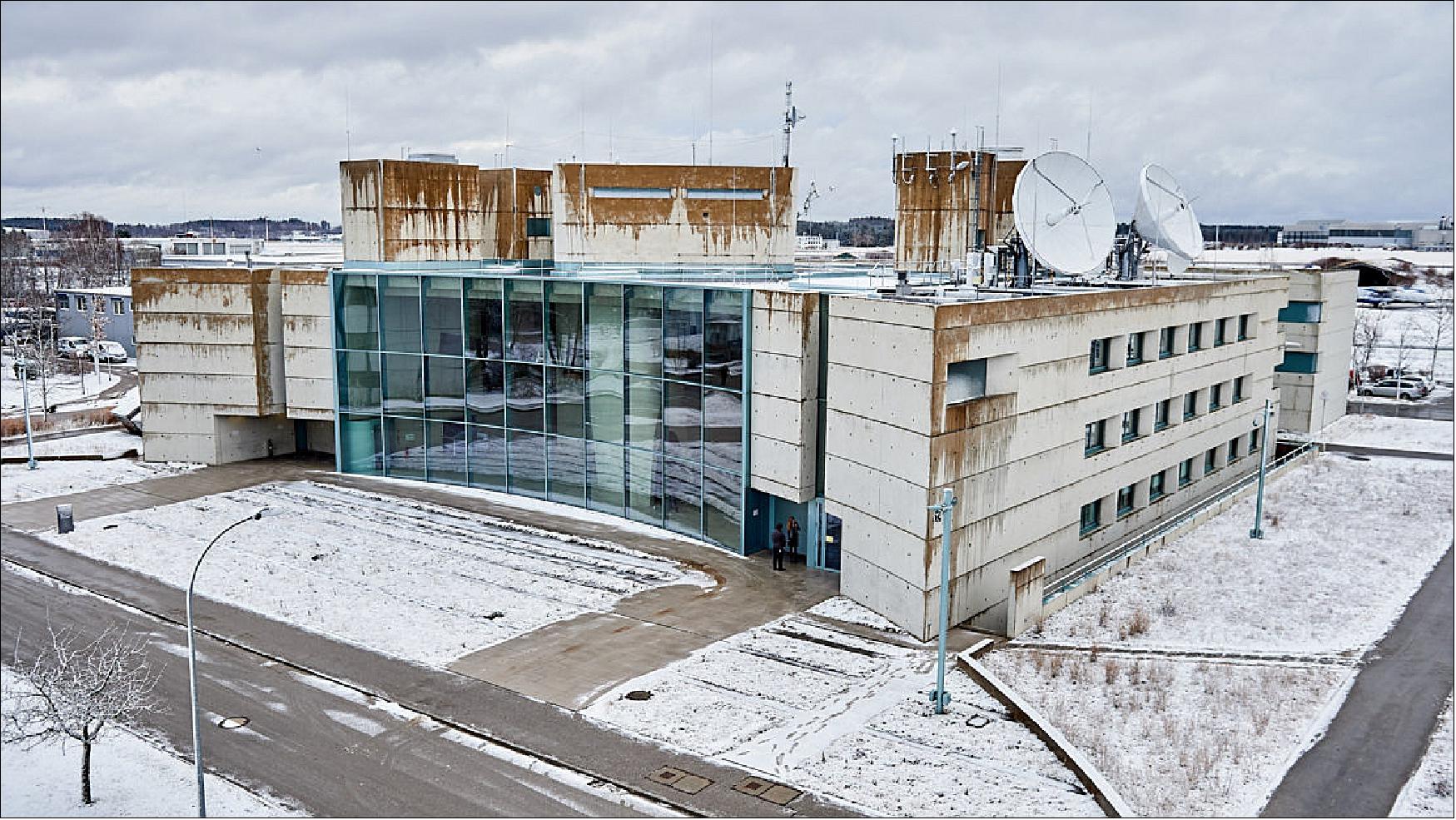
- The constellation in orbit is only one element of the overall satellite navigation system. At the same time as satellites were being built, tested and launched, ESA was putting in place a global ground segment, extending to some of the world’s loneliest places.
- The ground segment is essential to keeping Galileo services running reliably. It identifies and generates corrections for any tiny drifts in the onboard atomic clocks delivering meter-scale positioning, or in the positioning of the satellites themselves.
- Establishing Galileo’s ground segment was among the most complex developments ever undertaken by ESA, with the requirement to fulfil strict levels of performance, security and safety.
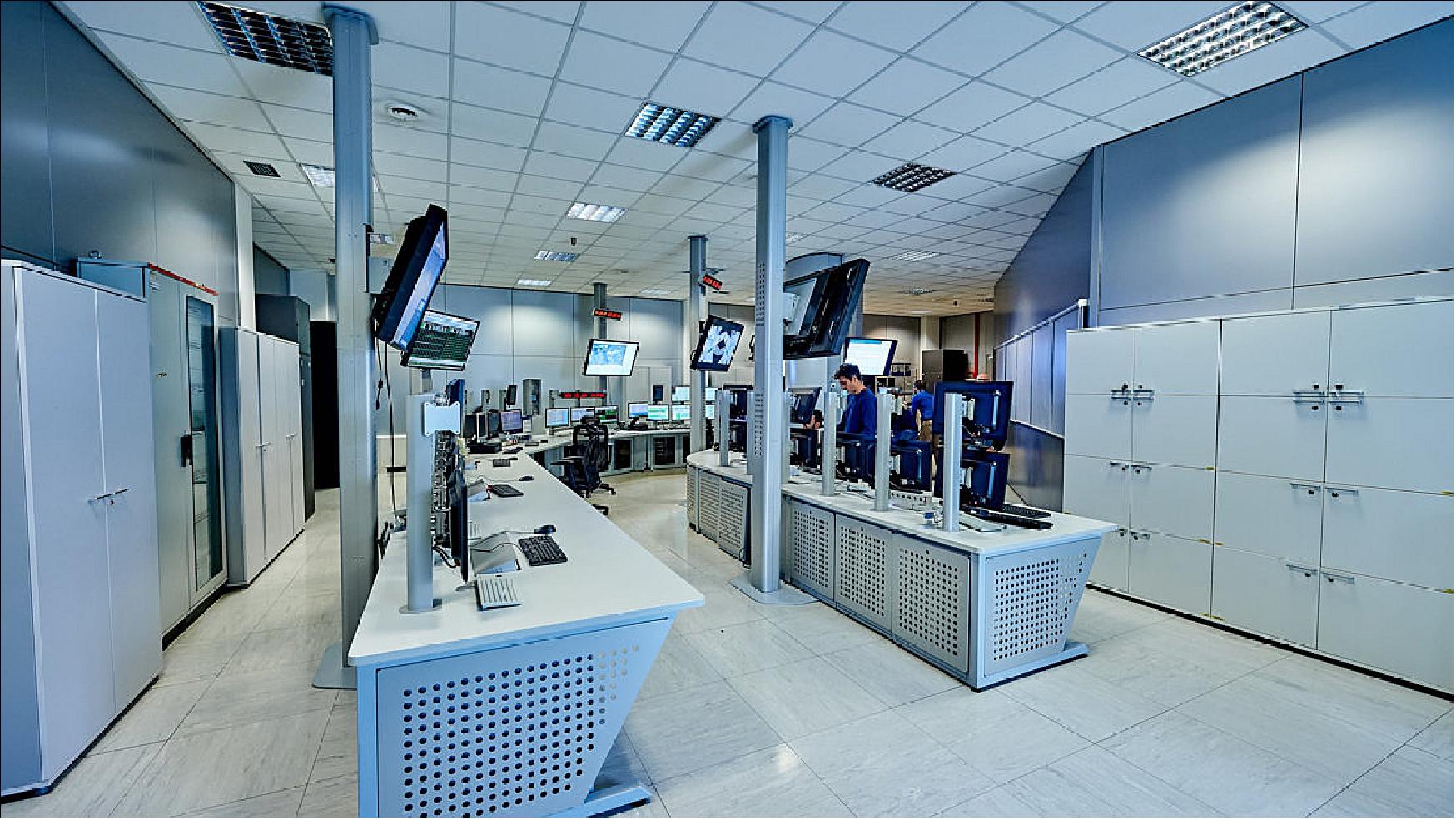
- A major driver of this latest update was the growth of the Galileo constellation, which increased by 12 satellites through a trio of Ariane 5 launches in the last three years to become Europe’s largest.
- The updated ground system incorporates a sixth telemetry, tracking and control station in Papeete, used to oversee Galileo satellite platforms, as well as an expansion of the number of antennas at the sites of uplink stations at Kourou in French Guiana; Reunion Island in the Indian Ocean and Noumea in French Polynesia – serving to upload navigation message corrections to the satellites for rebroadcast to users.
- The updated ground system incorporates a sixth telemetry, tracking and control station in Papeete, used to oversee Galileo satellite platforms, as well as an expansion of the number of antennas at the sites of uplink stations at Kourou in French Guiana; Reunion Island in the Indian Ocean and Noumea in French Polynesia – serving to upload navigation message corrections to the satellites for rebroadcast to users.
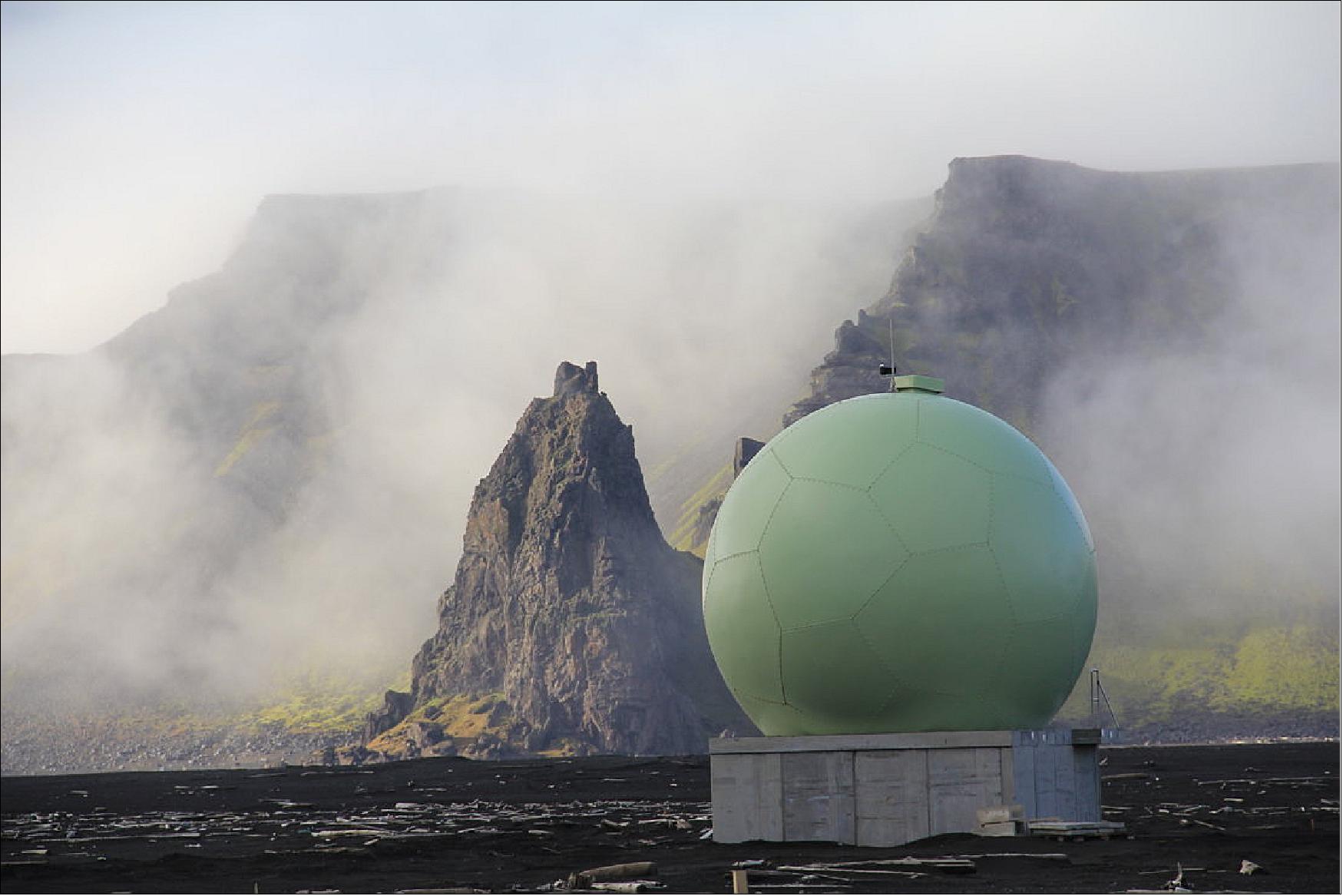
- Additional receivers have been added to the Galileo sensor stations to ensure full redundancy: their small antennas check the accuracy and signal quality of individual satellites in real time, and work together to pinpoint the current satellite orbits.
- And the two Galileo control centers at the heart of this global ground segment – Fucino in Italy focused on Galileo navigation payloads and Oberpfaffenhofen in Germany on the satellites hosting them – will be made fully redundant of one another, each one able to perform all the functions of the other at a moment’s notice ensuring the required business continuity.
- Operation of the individual Galileo satellites from the control centers will be further streamlined, with automation of key housekeeping tasks.
- The system build connects two brand new Galileo Security Monitoring Centers, one in Paris and, in the near future, one in Madrid currently under construction, to the core Galileo infrastructure. These two sites check on security issues related to Galileo services, and are used for controlling access to the Public Regulated Service, the single most accurate and secure class of Galileo signal, restricted to governmental users.
- Similarly, the new System Build is able to connect to the Galileo Service Center in Madrid, the portal for the Galileo user community and to the Galileo’s Search-and-Rescue Return Link service, overseen by French space agency CNES from Toulouse. See Figure 111 for an overview of Galileo's global ground segment.
• December 20, 2018: With 26 satellites in orbit and Initial Services available for two years, Europe’s Galileo satellite navigation system continues to evolve. Its latest onward step came this week, with contracts signed with Thales Alenia Space to strengthen Galileo’s global ground segment. 139)
- The constellation in orbit is only one element of the overall satellite navigation system – the tip of the Galileo iceberg. At the same time as the satellites were being built, tested and launched, a global ground segment was put in place.
- The first work order aims to improve overall Galileo service accuracy, robustness and availability, by resolving looming obsolescence issues with the ground segment by aligning to the latest IT concepts based on virtualized architectures.
- Two new uplink stations – tasked with distributing the latest navigation corrections to satellites – will be established at Papete in French Polynesia and Svalbard in the Norwegian Arctic, with a new sensor station – to monitor Galileo signal quality and track satellites – put in place on France’s Wallis Island in the Pacific.
- The second work order is focused on improving security monitoring functions for Galileo operations assets, including its control centers, service facilities and ground stations, over the next three years.
- The final work order covers improved access, streamlined operations and increased automation of Galileo’s PRS (Public Regulated Service), the single most accurate and secure class of Galileo system, available to Member State governmental organizations. The work order will also allow direct Member State access to PRS.
- Establishing Galileo’s ground segment was among the most complex developments ever undertaken by ESA, having to fulfil strict levels of performance, security and safety.
- Last year, responsibility for operating the Galileo ground segment was passed to ESA’s partner organization, the GSA (European GNSS Agency). Nevertheless, ESA continues to be in charge of the maintenance, development and evolution of the ground segment, as well as the development of the space segment.
- ESA has issued these work orders in its role of undertaking the design and development of future upgrades and the technical development of infrastructure as well as overseeing Galileo’s deployment, on behalf of the European Union, Galileo's owner.
- Galileo Initial Services began on 15 December 2016, with Full Operational Capability projected to take place at the end of this decade.
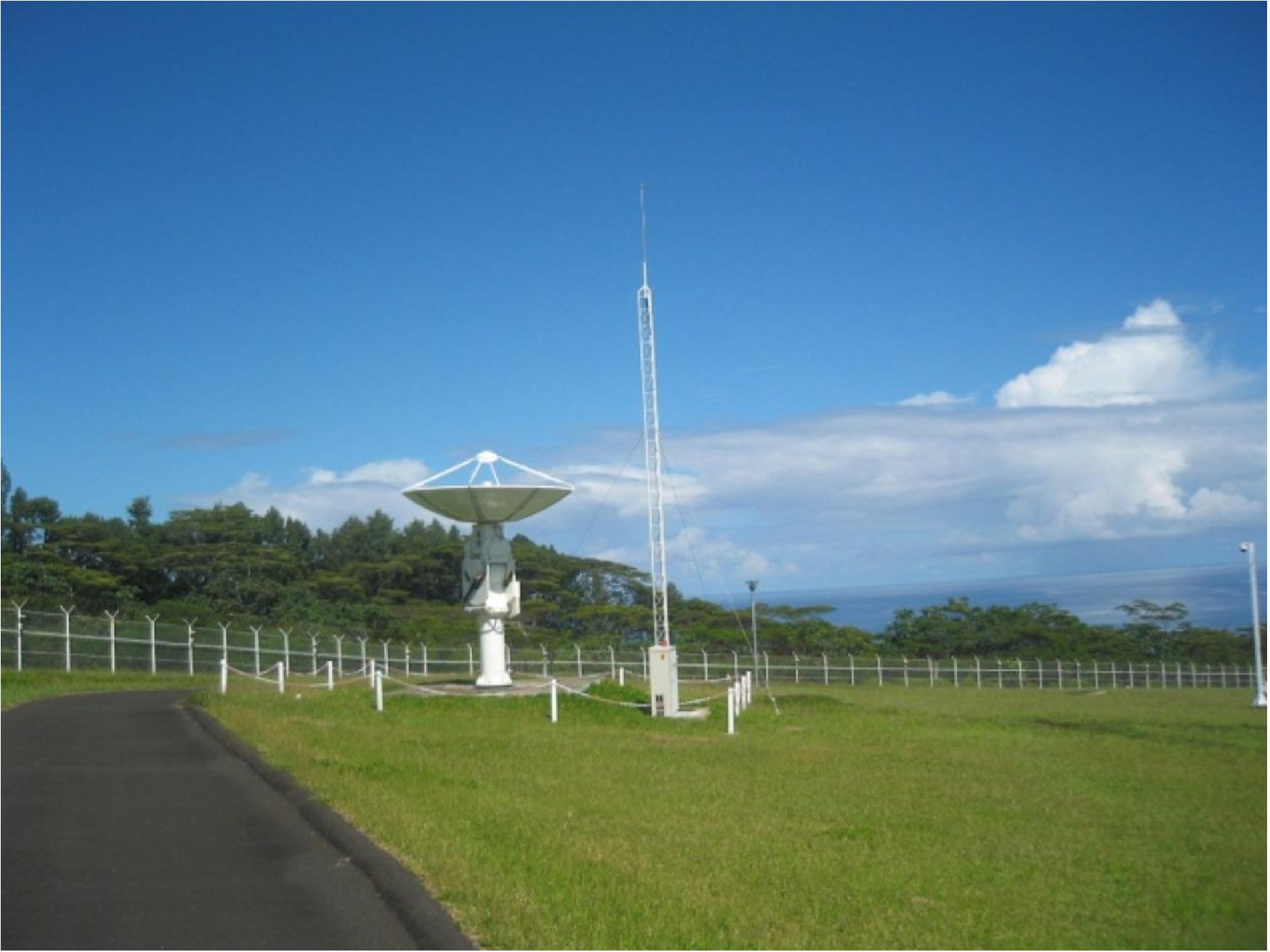
• March 2018: Galileo’s initial services have been running for more than 15 months now: signals from the satellites in space are routinely serving users all across the world. The functioning of Galileo is dependent on a global network of ground stations, its current extent shown in the map here (Figure 111). 141)
The constellation in orbit is only one element of the overall satellite navigation system – the tip of the Galileo iceberg. At the same time as satellites were being built, tested and launched, a global ground segment has been put in place, extending to some of the world’s loneliest places, from Svalbard in the High Arctic to storm-engulfed Jan Mayen Island, Ascension Island in the Mid Atlantic to Noumea in the South Pacific, Kerguelen in the southern Indian Ocean to Troll base in the Antarctic interior.
Among the latest developments are updated control and mission software for the two Galileo control centers that sit at the heart of this global web: Fucino in Italy generates the accurate navigation messages that are then broadcast through the navigation payloads, and Oberpfaffenhofen in Germany controls the constellation of satellites. A new telemetry, tracking and command station last year arose in Papeete on Tahiti, in the South Pacific.
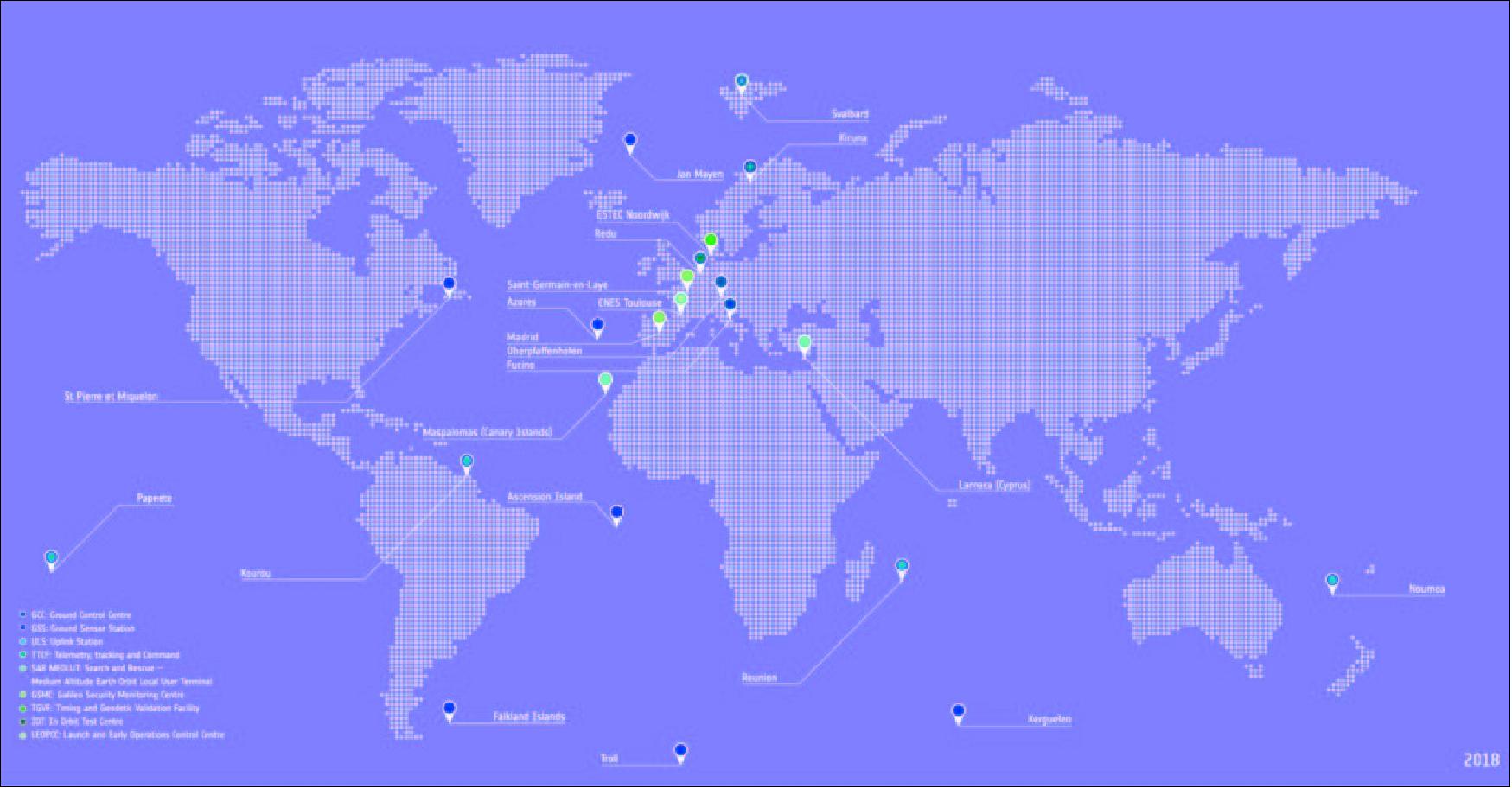
Galileo ‘sensor stations’ – with small omnidirectional receiving antennas around just 50 cm high – have been placed around the globe to check the accuracy and signal quality of individual satellites in real time, and work together to pinpoint the current satellite orbits. These measurements are transmitted via secure satellite communications to the Fucino Galileo Control Center, where they serve as the basis of a set of corrections – accounting for timing or orbital slips – to be uplinked to the satellites via a network of 3 m diameter ‘uplink stations’ for rebroadcast within navigation messages to users – currently updated every 50 minutes.
Considering Galileo is Europe’s largest satellite constellation, timely control of the satellites is essential, enabled by 13 m diameter ‘telemetry, tracking and command stations‘ – located in Kiruna, Sweden and Redu, Belgium as well as the equator-hugging Kourou, French Guiana, Reunion, Noumea in New Caledonia and now Papeete sites.
The ground segment also comprises a set of four MEOLUTs (Medium-Earth Orbit Local User Terminals), serving Galileo’s search and rescue service, at the corners of Europe and facilities for testing Galileo service quality and security – the Timing and Geodetic Validation Facility and two Galileo Security Monitoring Centers.
The Launch and Early Operations Control Centers have the task of bringing newly-launched satellites to life, to be handed over to the main Satellite Control Center in Oberpfaffenhofen within typically one week after the launch while Redu in Belgium, set up as Galileo’s In-Orbit Test Center, is then putting these satellites through a complex set of testing and check-outs ahead of them joining the working constellation.
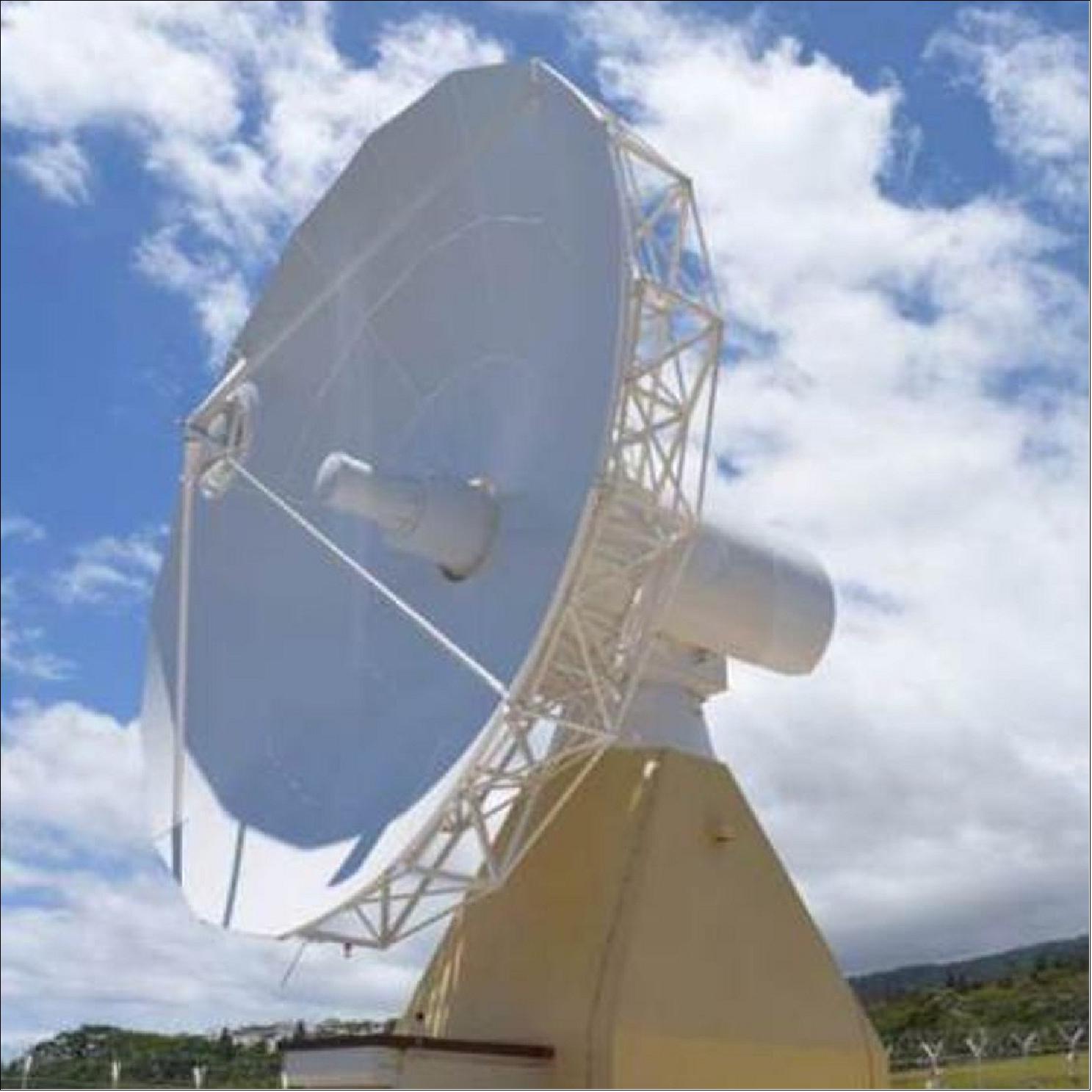
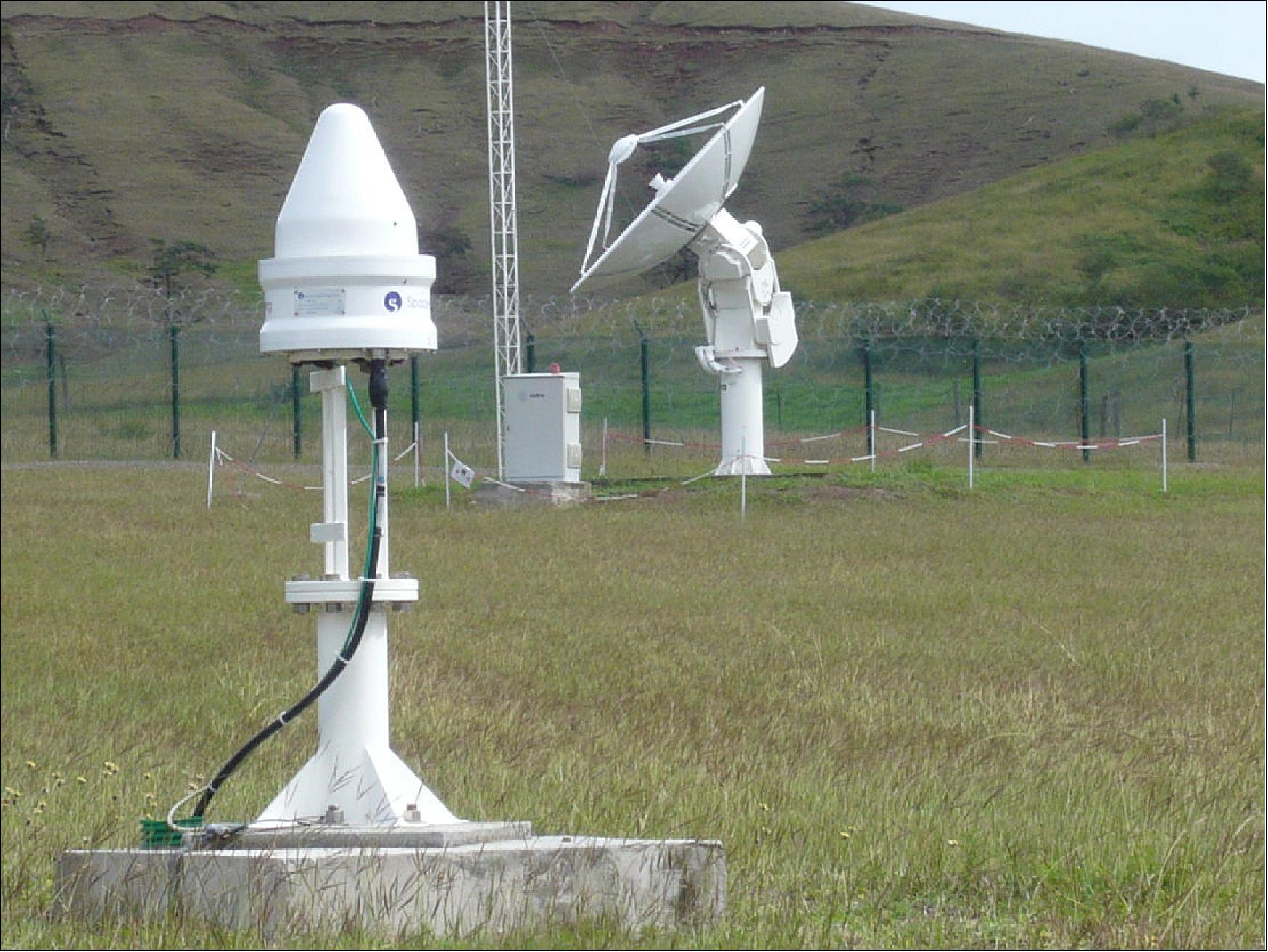
Establishing Galileo’s ground segment was among the most complex developments ever undertaken by ESA, having to fulfil strict levels of performance, security and safety. Formal responsibility for the operations of this Galileo ground segment was last year passed to ESA’s partner organization, the European Global Navigation Satellite System Agency, or GSA, but ESA continues to be in charge of its maintenance and growth.
Users don’t have to worry about this ground segment, but it is essential to keeping Galileo services running reliably. The atomic clocks aboard the satellites are accurate to a few nanoseconds, delivering meter-scale positioning precision, but they are prone to drift over time.
Similarly, the orbits of the satellites can be slightly nudged by the gravitational tug of Earth’s slight equatorial bulge and by the Moon and Sun. Even the slight but continuous push of sunlight itself can affect satellites in their orbital paths. The quality of signals received on the ground can be affected by their transit through the ever-changing ionosphere, the electrically active outer layer of Earth’s atmosphere.
Ground System of SAR/Galileo (Search And Rescue/Galileo)
• January 21, 2020: Global Search and Rescue (SAR) operations quickly locate and help people in distress. The SAR/Galileo service, launched on 15 December 2016 as part of Galileo Initial Services, contributes to these live-saving efforts by swiftly relaying radio beacon distress signals to the relevant SAR crews by means of dedicated payloads on-board Galileo satellites, supported by three ground stations strategically deployed across Europe. 142)
On January 21 2020, the SAR/Galileo Return Link Service (RLS) was declared operational. Now, Galileo not only locates people in distress and makes their position known to the relevant authorities, the SAR/Galileo RLS provides an automatic acknowledgement message back to the user informing them that their request for help has been received.
How the SAR/Galileo Service Works
The SAR/Galileo service is the biggest contributor to the Cospas-Sarsat MEOSAR program in terms of ground segment and space segment assets. It provides the following two services:
1) SAR/Galileo Forward Link: relay of Cospas-Sarsat 406 MHz distress signals to the ground;
2) SAR/Galileo Return Link: unique return link alert that informs the sender that their distress alert has been received.
These SAR/Galileo services are fully integrated into the Cospas-Sarsat system. The SAR transponder on Galileo satellites picks up signals emitted from distress beacons in the 406 – 406.1 MHz band and broadcasts this information to dedicated ground stations (MEOLUTs) in the L-band at 1544.1 MHz. These downlink signals transmitted by the Galileo SAR payloads are used by the MEOLUTs to generate an independent location of the beacon, which is then relayed to first responders through dedicated Cospas-Sarsat Mission Control Centers.
What is Cospas-Sarsat?
Cospas-Sarsat is a non-profit satellite-based search and rescue distress alert detection and information distribution system. It provides accurate, timely, and reliable distress alert and location data to SAR authorities, increasing the survival chances for people in distress by reducing the time it takes to locate them and relay this information to responders.
Established in 1979 by Canada, France, the USA and the former Soviet Union, the Cospas-Sarsat Program currently has 45 countries and organisations that maintain, co-ordinate and operate the interoperable ground and space segments in line with Cospas-Sarsat specifications and performance standards.
The system is available to maritime and aviation users and to individual persons in distress situations on a non-discriminatory basis. It is free of charge for the end-user. The figure below shows the main components of the system:
- Distress beacons operating at 406 MHz (users);
- SAR payloads on satellites in low-altitude, medium and geostationary Earth orbit;
- Ground receiving stations (LUTs) spread around the world; and
- A network of Mission Control Centers (MCCs) to distribute distress alert and location information to SAR authorities, worldwide.
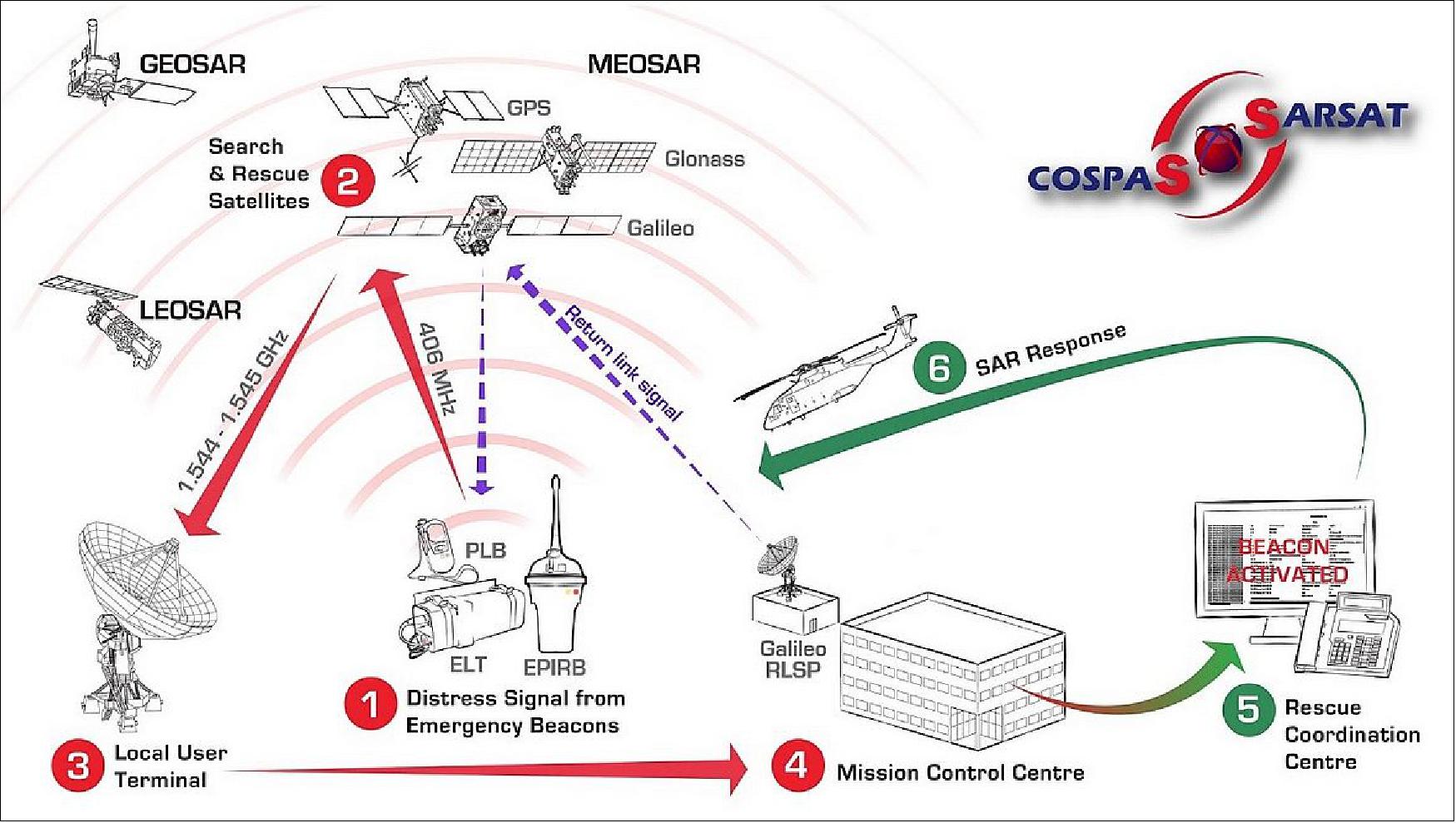
What it Means for You
With contributions from Galileo and other GNSS providers, Cospas-Sarsat has been able to transition from its original design based on satellites in low Earth orbits (LEOSAR), later complemented by geostationary orbit satellites (GEOSAR), towards MEOSAR - a solution based on medium orbit satellites such as Galileo.
The MEOSAR system offer the advantages of both the LEOSAR and GEOSAR systems without their limitations by providing transmission of the distress message and independent location of the beacon, with near-real-time worldwide coverage. Users benefit from:
- Global coverage;
- Single burst detection and location capability;
- Reduced detection time from hours to just minutes after the distress beacon is activated;
- Improved independent GNSS localization of the distress alert under 5 km or better 95% of the time;
- Improved availability with increased satellite redundancy;
- Better signal detection in difficult terrain and weather conditions;
- Automatic acknowledgment to the person in distress thanks to SAR/Galileo RLS.
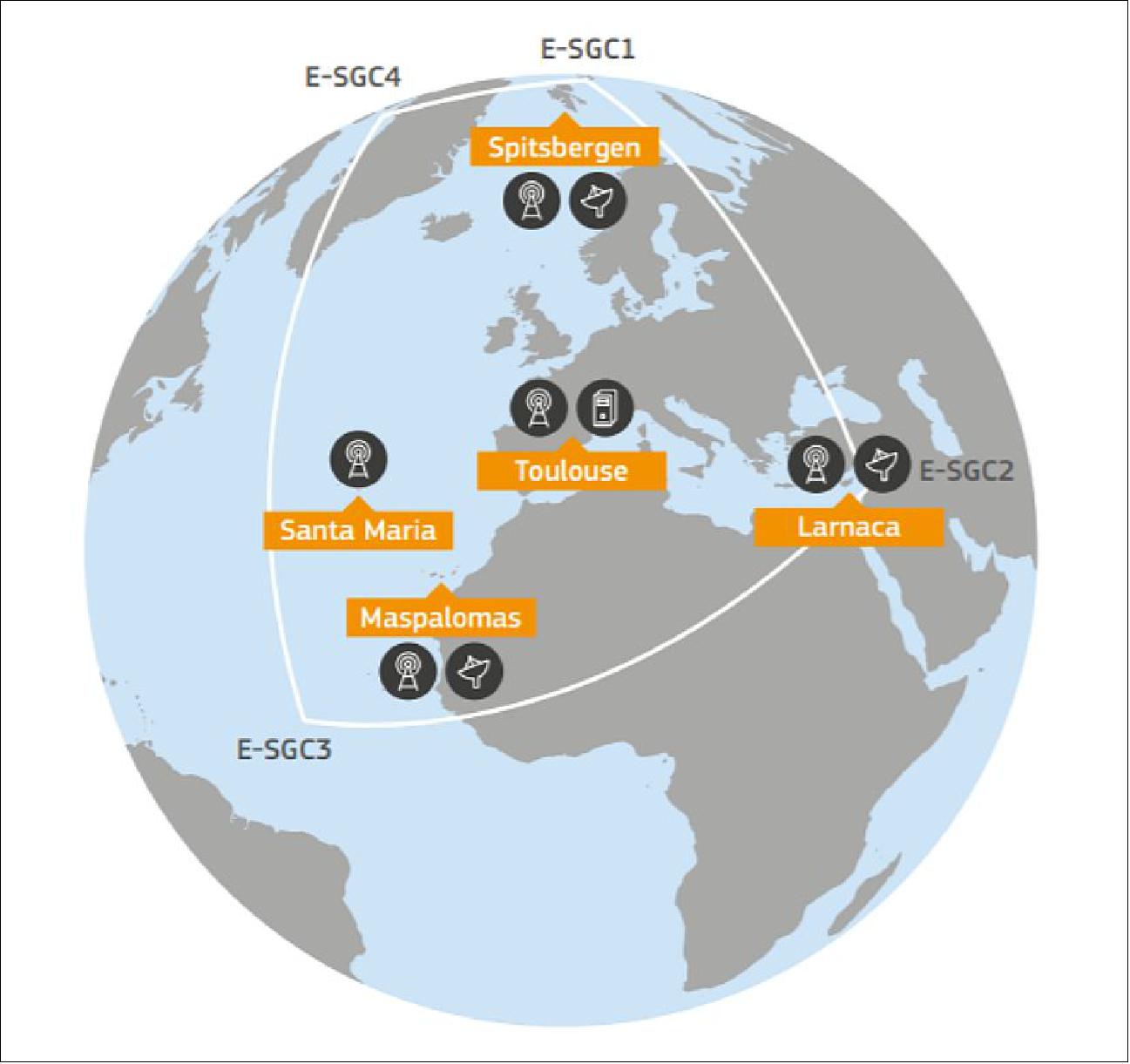
With the introduction of the Return Link Service (RLS) Galileo became an even greater differentiator in search and rescue operations. The RLS relies on Galileo’s E1 navigation signal and is available worldwide for RLS-enabled beacons. Thanks to the improvements offered by the SAR/Galileo service, more lives are being saved.
• November 14, 2014: The Galileo Program involvement into COSPAS-SARSAT goes beyond the space component of the MEOSAR (Medium Earth Orbit Search And Rescue) system. Indeed, the European Union has deployed a significant Ground Segment infrastructure, which provides localization services for distress alerts transmitted by SAR beacons over a wide area comprising continental Europe, and vast oceanic areas around the continent (Figure 118). The SAR/Galileo Ground Segment can receive and process SAR distress signals relayed by any operational Galileo spacecraft or other satellite of the COSPAS-SARSAT MEOSAR constellation and determine thereby the location of the beacon within the coverage area (Ref. 116). 143)
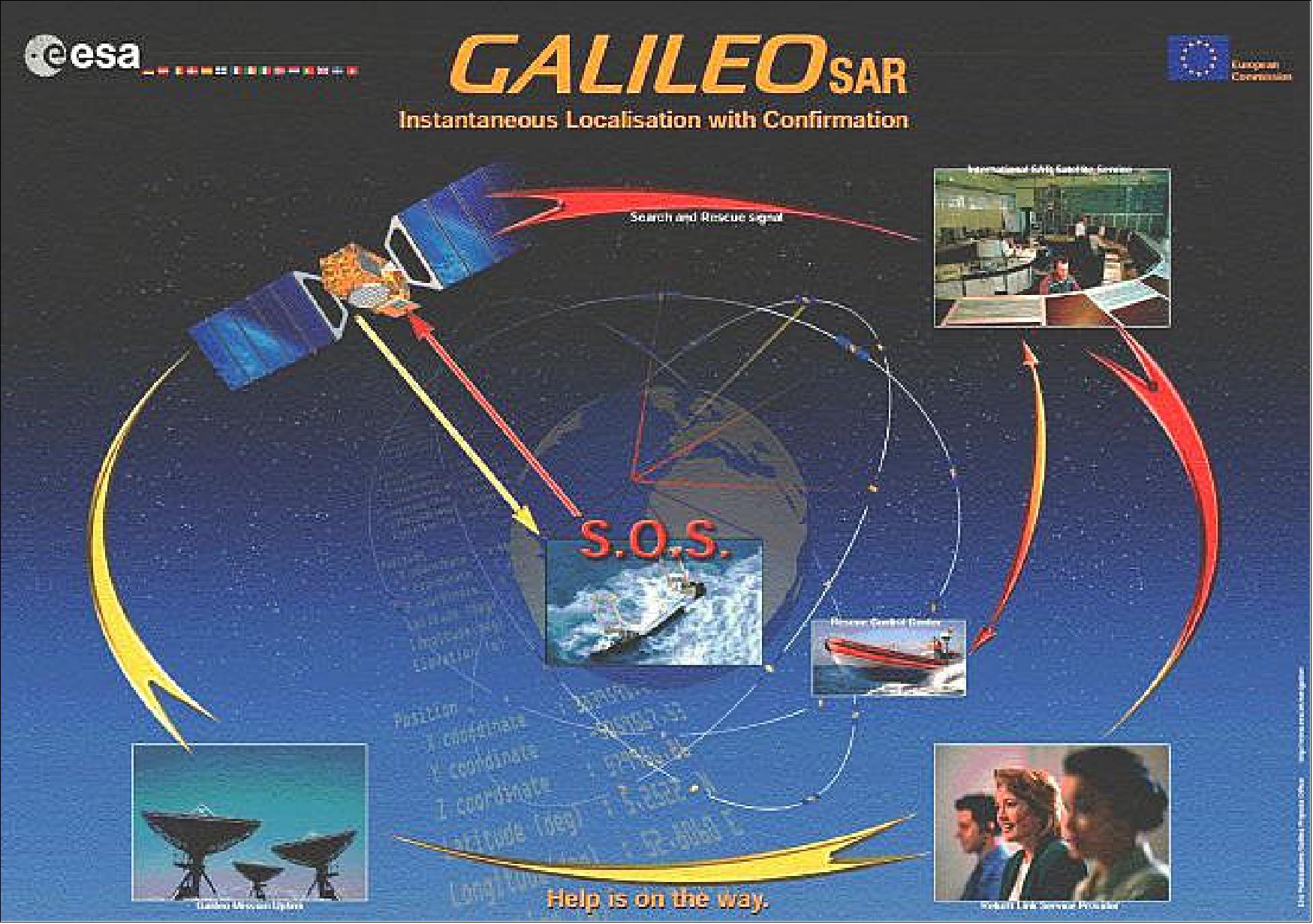
The ground segment of the Search and Rescue Service of Galileo consists of 3 receiving ground stations, called MEOLUTs (Medium Earth Orbit Local User Terminal), which receive the distress signals relayed by the Galileo Search and Rescue repeater in the 1544 MHz band. Each MEOLUT includes a minimum of 4 antennas tracking different Galileo satellites.
Receiving the signal relayed from four different satellites makes it possible to determine the distressed beacon position by triangulation using TOA (Time of Arrival) and FOA (Frequency of Arrival) techniques. The MEOLUT then decodes the distress signal message, determines the beacon localization and provides this information to the COSPAS-SARSAT MCCs (Mission Control Centers).
The 3 European MEOLUTs are located in Svalbard (Norway), Makarios (Cyprus) and Maspalomas (Spain) and provide the SAR/Galileo service over the ECA (European Coverage Area) as shown in Figure 118. Each site is equipped with four antennas to track four satellites. Each MEOLUT is connected to a central facility, the MEOLUT MTCF (Tracking Coordination Facility) located at the SAR/Galileo control center in Toulouse, France, which optimizes the MEOLUT tracking plan of the 3 European MEOLUT in order to achieve the best location accuracy and availability over the European Coverage Area.
As a component of the COSPAS-SARSAT MEOSAR system, agreed to at the COSPAS-SARSAT 2012 conference, the SAR/Galileo ground segment is also capable of receiving the distress signal relayed by the MEOSAR payloads embarked on the GLONASS and GPS satellites (SAR/GLONASS and GPS/DASS payloads).
The performances achieved by the SAR/Galileo Service when the full Galileo constellation is operational are indicated in Table 8. The SAR/Galileo ground segment also includes the RLSP (Return Link Service Provider), which is responsible for providing Return Link Acknowledgment Messages to the COSPAS-SARSAT distress beacons equipped with a Galileo receiver. The Return Link Messages are embedded within the navigation message of the E1 signal.
Detection probability | 99.5% |
Localization probability | 98.0% |
Localization accuracy | < 5 km (2σ) within 10 min |
Worst case service availability | 95.0% |
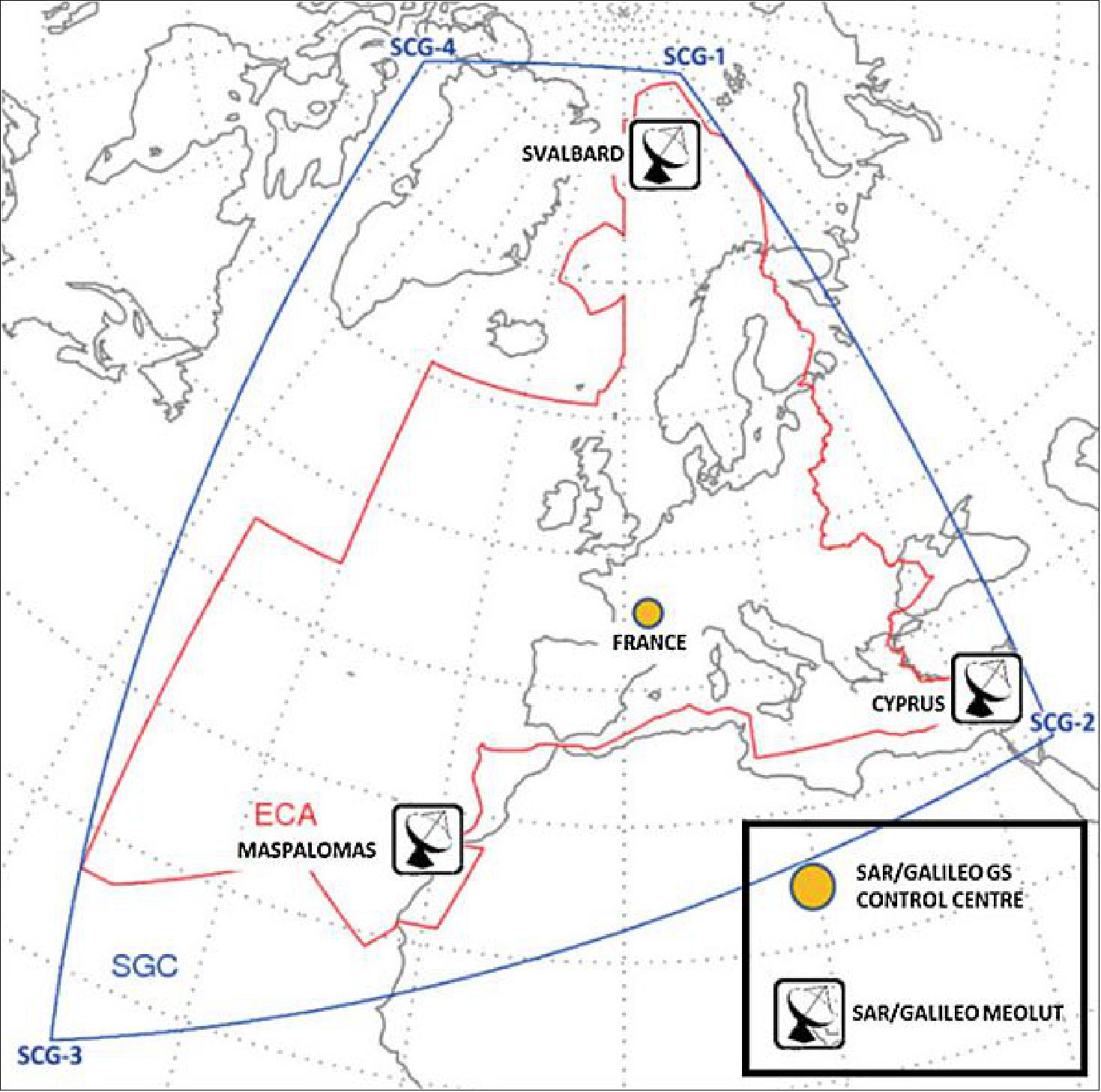
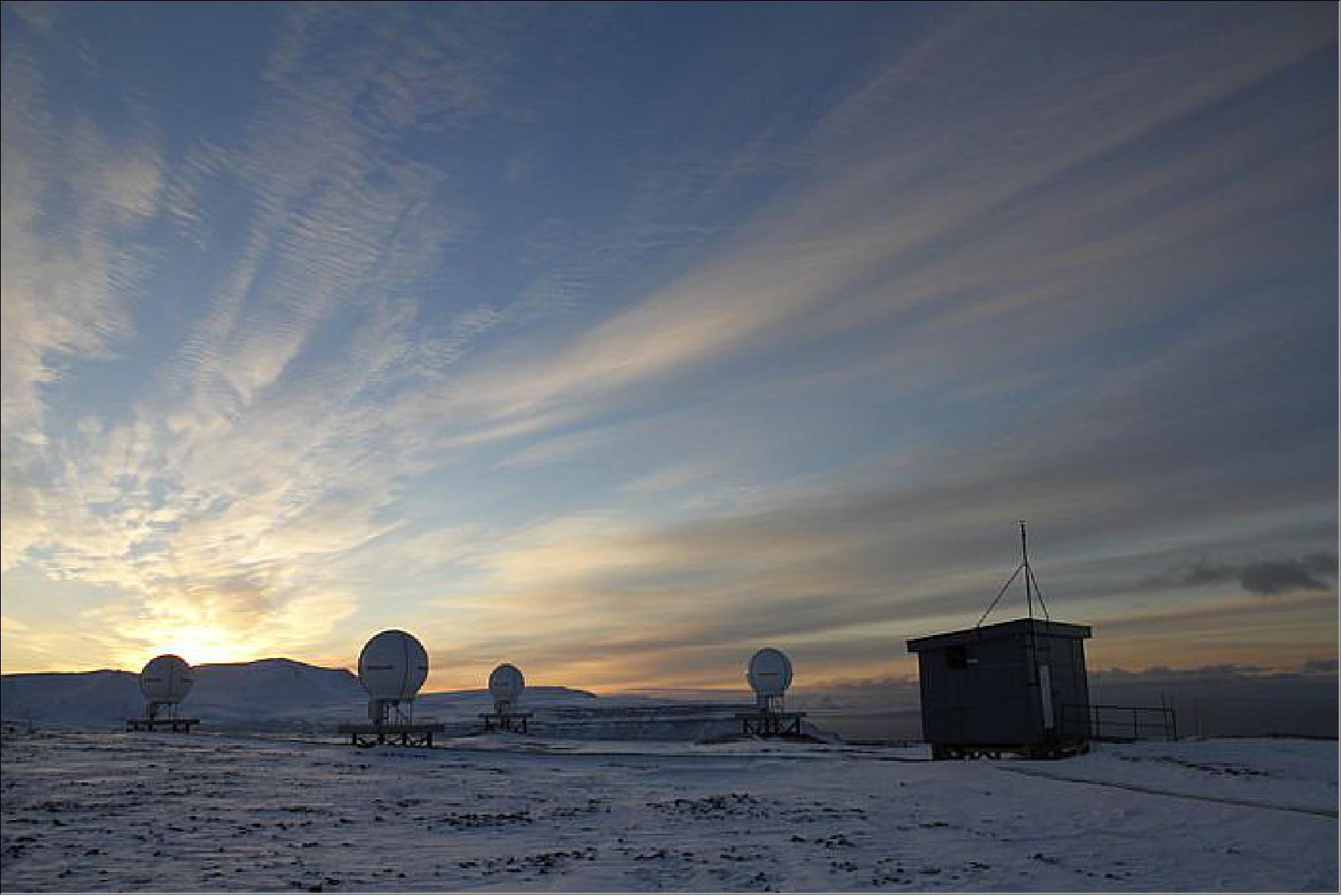
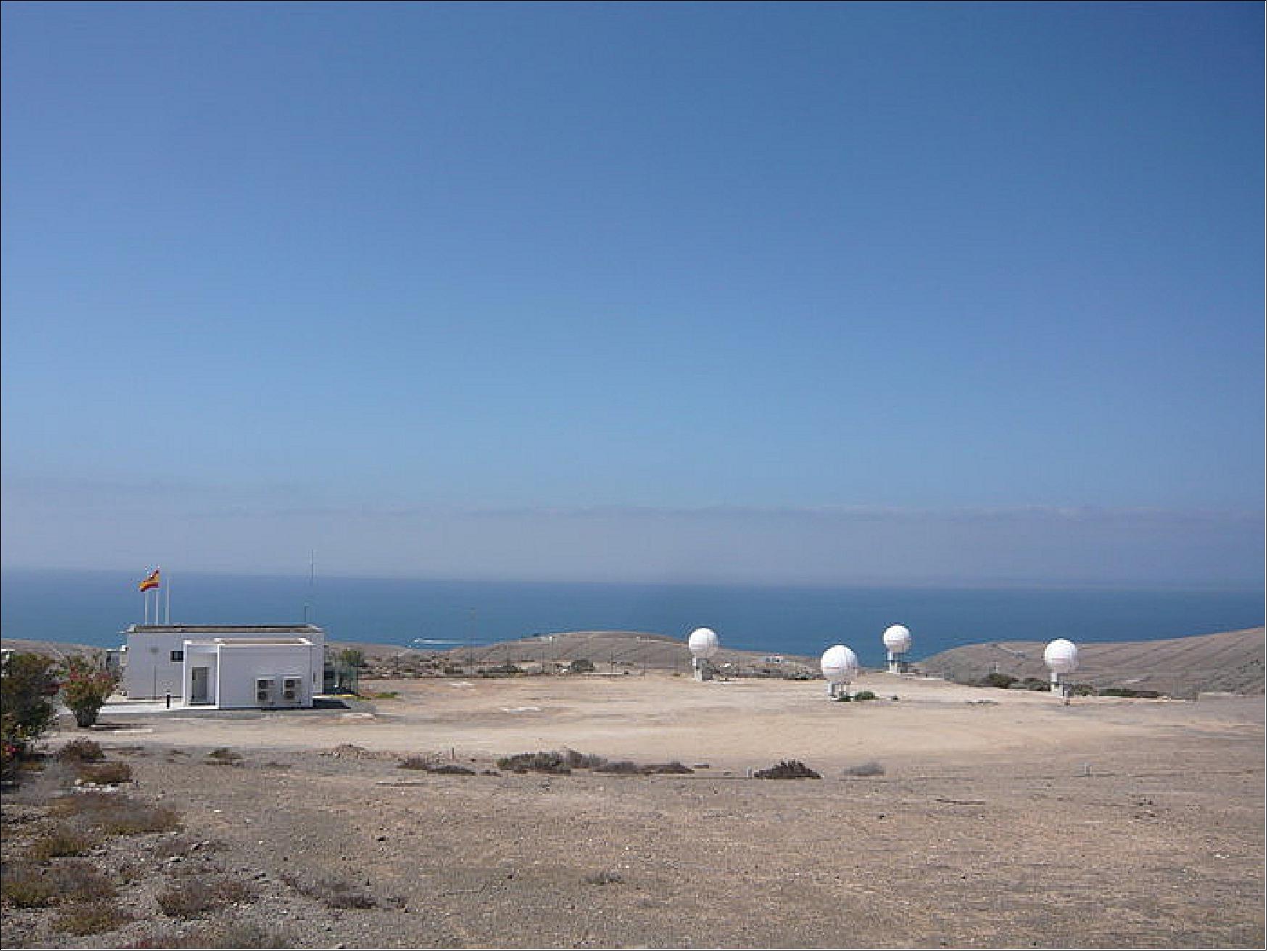
Legend to Figure 120: The ESA-built Maspalomas MEOLUT on Gran Canaria, is part of an extension of the international COSPAS-SARSAT search and rescue program into MEO , spearheaded by Galileo. Each site is equipped with four antennas to track four satellites. There are three sites in all: Maspalomas and Spitsbergen will combine with a third station at Larnaca in Cyprus, currently approaching completion. These three sites are monitored and controlled from the SAR Ground Segment Data Service Provider site, based at Toulouse in France. The stations are networked to share raw data, effectively acting as a single huge 12-antenna station, achieving unprecedented detection time and localization accuracy in relaying search and rescue signals to local authorities.
Extension of MEOLUT (Medium Orbit Local User Terminal) Stations
In October 2018, TAS (Thales Alenia Space) has won a contract from the European Commission (EC) to develop and build an operational ground station on La Reunion Island to track GNSS (Global Navigation Satellite System) satellites in MEO. GNSS refers to the constellations of GPS (USA), Galileo (Europe), GLONASS (Russia) and BeiDou/Compass (China). 145) 146)
The ground station will receive and process 406 MHz distress beacon signals from the MEO navigation satellites being tracked and relay them to the SAR/Galileo network via the French Mission Control Center (FMCC) at the CNES facility in Toulouse. The contract also included the procurement of the best possible hosting site for this ground station.
This MEOLUT Next will enhance the Commission’s contribution to the Cospas/Sarsat Search And Rescue system by extending its coverage in the South Indian ocean, contributing to worldwide coverage. It complements the three MEOLUTs that are already deployed around Europe, in Larnaca (Cyprus), Maspalomas (Grand Canaria) and Spitzbergen (Norway) and are under responsibility of the GSA [GNSS (Global Navigation Satellite System) Supervisory Agency (Europe)].
The MEO system, which replaces the legacy LEO (Low Earth Orbit) system, is designed to offer a faster response and better location data in near real time for search & rescue (SAR) authorities, using spacecraft and ground facilities to detect and locate signals from the 406 MHz distress beacons.
Thales Alenia Space designs, operates and delivers satellite-based systems for governments and institutions, helping them position and connect anyone or anything, everywhere. Since being commissioned in 2016, MEOLUT Next has delivered unrivaled performance, detecting distress signals from more than 5,000 km away. Several countries have already chosen or are interested by this breakthrough technology, including Canada and Togo.
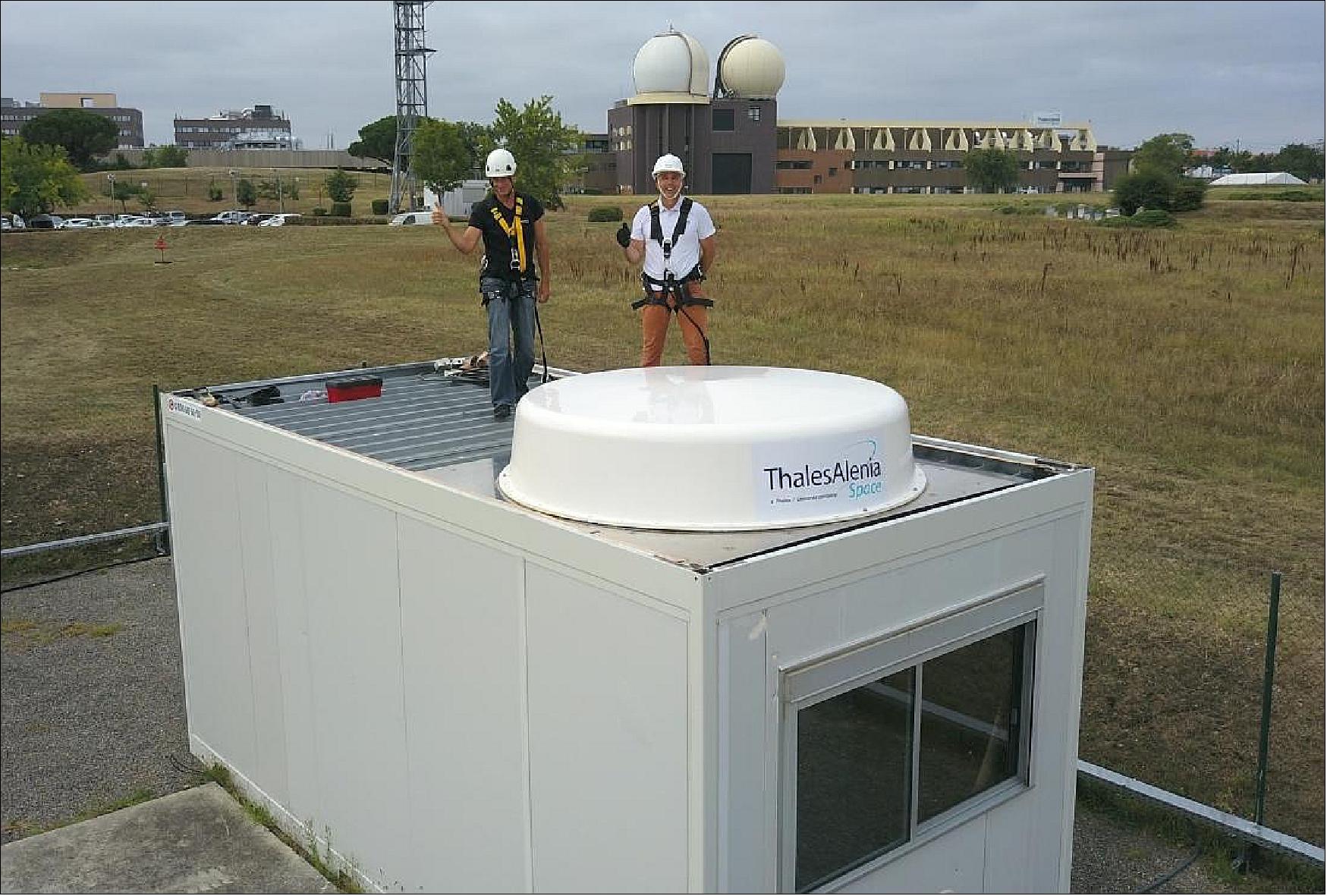
MEOLUT Next: Conventional MEOLUT (Medium Earth Orbit Local User Terminal) systems use large parabolic antennas and are limited by how many satellite signals they can receive. Thales Alenia Space's MEOLUT Next solution is compact, measuring less than six square meters, with the ability to track up to 30 satellites, significantly enhancing the distress beacon detection rate while expanding the coverage zone. Since there are no mechanical components, hardware maintenance costs are the lowest on the market.
Thales Alenia Space designs, operates and delivers satellite-based systems for governments and institutions, helping them position and connect anyone or anything, everywhere. Since being commissioned in 2016, MEOLUT Next has delivered unrivaled performance, detecting distress signals from more than 5,000 km away. Several countries have already chosen or are interested by this breakthrough technology, including Canada and Togo.
Galileo’s Contribution to the MEOSAR System
• In 2000, the USA, the European Commission and Russia began consultations with COSPAS-SARSAT on the feasibility of installing SAR repeater payloads on their Medium-Altitude Earth Orbit Navigation Satellite Systems (MEOSAR), and incorporating a 406 MHz MEOSAR capability into COSPAS-SARSAT. The USA MEOSAR program is called SAR-GPS, the European program is called SAR/Galileo, and the Russian program is referred to as SAR/GLONASS. 147)
The initial investigations identified many possible SAR alerting benefits that might be realized from a MEOSAR system. These include:
- near instantaneous global coverage with accurate independent location capability;
- robust beacon to satellite communication links, high levels of satellite redundancy and availability;
- resilience against beacon to satellite obstructions;
- the possible provision of additional (enhanced) SAR services.
Once fully operational, the MEOSAR system will offer the advantages of both the Low Earth Orbit Search and Rescue (LEOSAR) and the Geostationary Earth Orbit Search and Rescue (GEOSAR) systems without their current limitations. It will provide for the transmission of the distress message and the independent location of the beacon with near real-time worldwide coverage.
The large number of MEOSAR satellites that will be in orbit when the system is fully operational will allow each distress message to be relayed at the same time by several satellites to several ground antennas. This will improve the likelihood of detection and the accuracy of location determination.
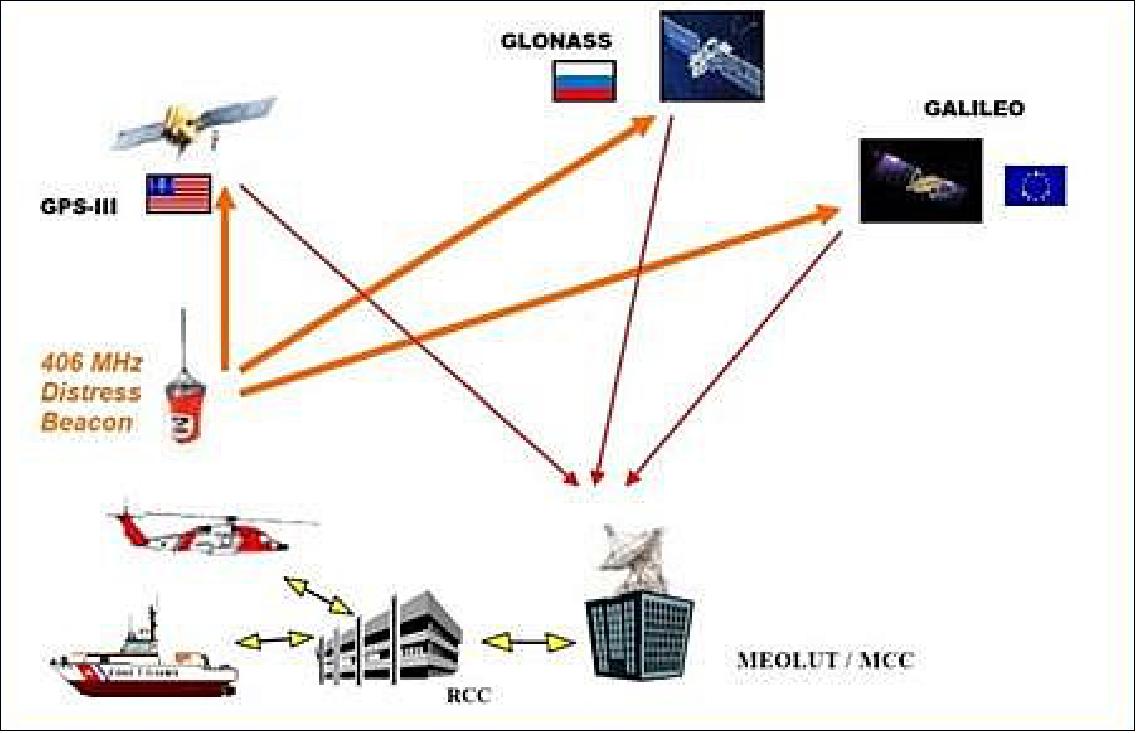
MEOSAR satellites orbit the Earth at altitudes ranging from 19 000 to 24 000 km. The primary missions for the satellites used in the three MEOSAR constellations are their respective Global Navigation Satellite Systems (GPS, Galileo and GLONASS).
MEOSAR constellation | GPS-DASS (S-band) | GLONASS K | Galileo (IOV+FOC) | SAR-GPS (L-band) |
No of active satellites | 17/24 | 2/24 | 6/24 | 0/24 |
No of orbital planes | 6 | 3 | 3 | 6 |
Orbital inclination | 55º | 64º | 56º | 55º |
Orbital altitude | 20,180 km | 19,140 km | 23,222 km | 20,180 km |
Period of revolution | 11 h 58 m | 11 h 15 m | 14 h 22 m | 11 h 58 m |
Uplink polarization | LHCP | RHCP | RHCP | LHCP |
Downlink frequency / Pol. | 2226 MHz RHCP | 1544.9 MHz LHCP | 1544.1 MHz LHCP | 1544.9 MHz RHCP |
Status | Experimental payloads | In Test | Operational | In development |
First launch date | January 2001 | February 2011 | October 2012 | Planned 2020 |
*Note: GPS/DASS satellites are S-Band satellites. They are viewed as experimental payloads and cannot therefore be considered for long-term MEOSAR operations. Their operational use on a temporary basis for the MEOSAR EOC and IOC is authorized however.
All MEOSAR satellite constellations use transparent repeater instruments to relay 406 MHz beacon signals, without on board processing, data storage, or demodulation. The SAR/Galileo and SAR/GLONASS payloads operate with downlinks in the 1544 – 1545 MHz band (L-band) and the GPS-DASS uses the S-band at 2226 MHz (experimental).
Galileo Satellites Help Rescue Vendée Globe Yachtsman
• December 3, 2020: A sailor in the Vendée Globe solo round-the-world yacht race faced disaster in the Southern Ocean as raging waves pounded his vessel apart. But he was save148)d thanks to the search and rescue antennas aboard Europe’s Galileo satellites, part of the international Cospas-Sarsat rescue system.
- Skipper Kevin Escoffier later recounted his Monday afternoon ordeal: “You see the images of shipwrecks? It was like that, but worse. In four seconds the boat nosedived, the bow folded at 90 degrees. I put my head down in the cockpit, a wave was coming. I had time to send one text before the wave fried the electronics. It was completely crazy. It folded the boat in two.”
- In a few minutes he had taken to his life raft: “I would have liked to stay a little longer on board but I could see that everything was going very quickly and then I took a break and went into the water with the raft. At that time, I was not at all reassured… You are in a raft with 35 knots of wind. No, it is not reassuring.”
- For the next 11 hours Kevin Escoffier was adrift in fierce winds and surging waves. But he was not entirely alone. Once his raft hit the water it automatically activated its rescue beacon, transmitting a 406 MHz SOS signal for automatic pickup by participating satellites, courtesy of the Cospas-Sarsat satellite-based emergency detecting and locating system.
- The only system that can independently locate a beacon anywhere on Earth’s surface, Cospas-Sarsat has helped save thousands of people since it was first established in 1982. Originally the system operated through transponders hosted aboard either low-Earth orbit or geostationary satellites. In the last decade Galileo joined Cospas-Sarsat – supported by the European Commission, the system’s owner – driving a significant increase in performance.
- Because they have such a high orbital altitude, at 23 222 km up, while still moving steadily through the sky, Galileo satellites combine broad views of Earth with the ability to facilitate quick determination of the position of a distress signal through a combination of delay and Doppler ranging.
- At 13:48:51 UTC on Monday (30 November) the Cospas-Sarsat system’s French Mission Control Centre (FMCC) based in Toulouse and operated by French space agency CNES received the first alert via the search and rescue transponders of a trio of Galileo satellites, picked up the Search and Rescue (SAR)/Galileo Medium Earth Orbit Local User Terminal (MEOLUT) in Cyprus. This is one of three MEOLUTS, put in place as part of Europe’s Galileo program and European contribution to the Cospas-Sarsat system.
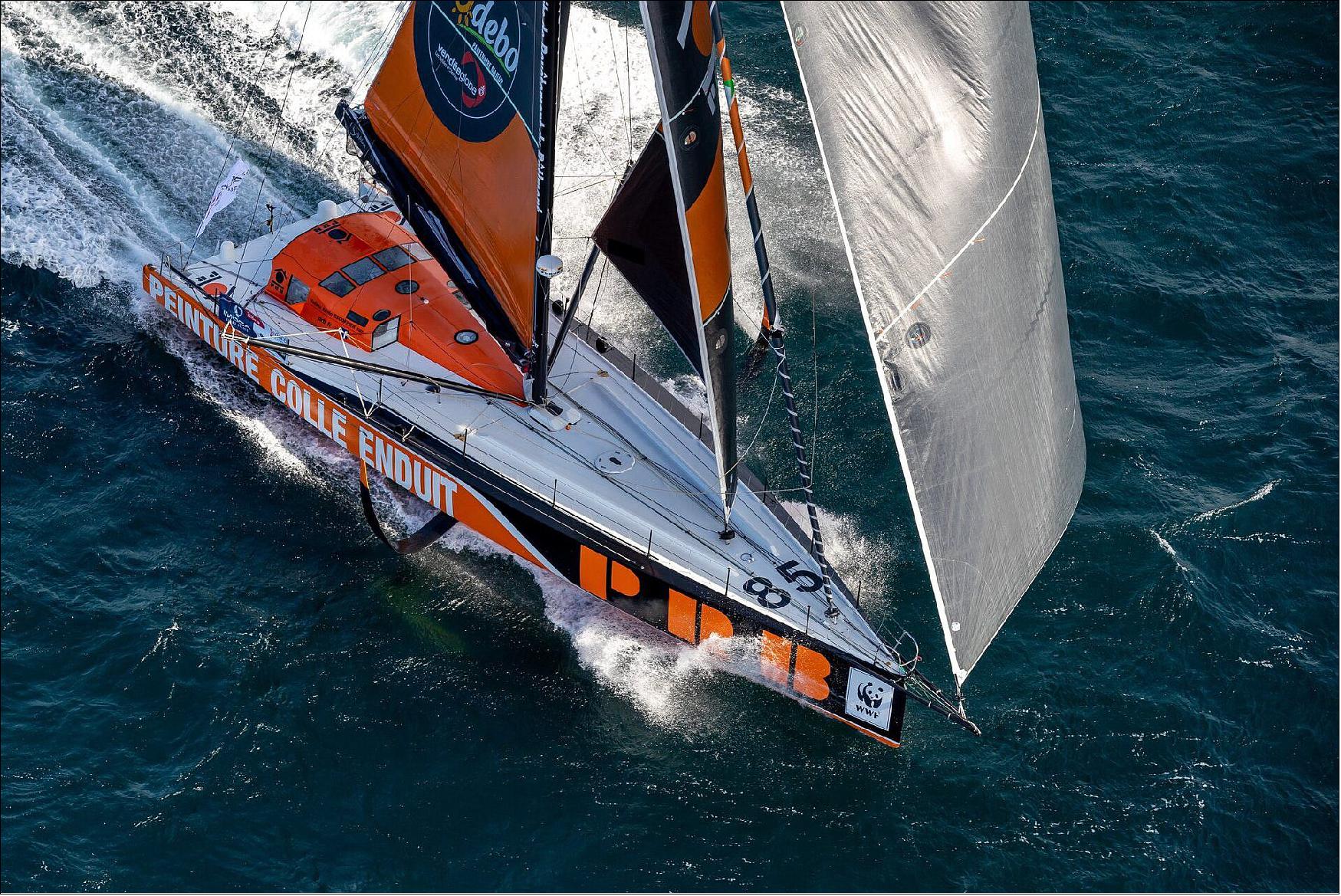
- The next step was to localize the signal’s origin, which was achieved under two minutes later at 13:51:07 UTC, pinning down its source within the South African Mission Control Centre Service Area (ASMCC), which extends from southern Africa down to the Antarctic coast – to a location around 1000 km south of Cape of Good Hope.
- The alert was immediately forwarded on to the Australian Mission Control Centre (AUMCC) in Canberra, Australia, whose data distribution region includes South Africa.
- At the same time, the alert was also forwarded to France’s CROSS Gris-Nez centre – a national point of contact for Cospas-Sarsat incidents – which immediately notified Vendée Globe Race Direction in Les Sables d’Olonne. The team were able to call on rival racer Jean Le Cam, the competitor closest to the stricken sailor, to look for him.
- As Race Director Jacques Caraës explained: “When we saw that the EPIRB (Emergency Position Indicating Radio Beacon) position was lining up with the drift prediction track we sent Jean to that point.”
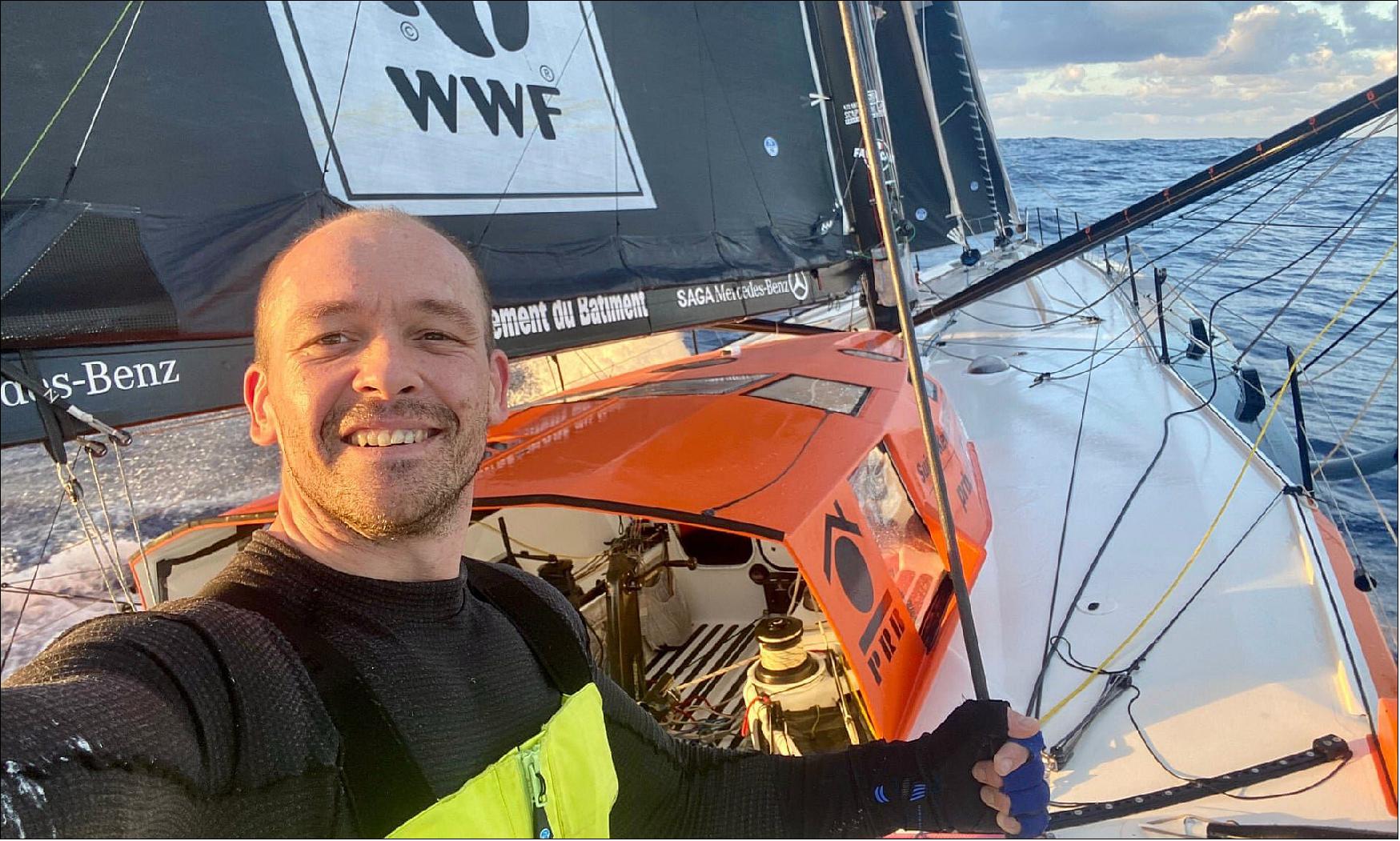
- After repeated attempts, Le Cam was finally able to take Escoffier safely aboard at 01:18 UTC on Tuesday morning. In the meantime the race organizers used the beacon signals as the basis of a wider search effort, calling in other skippers to help. Further signals were received at the FMCC in Toulouse from 14:10:34 UTC on Monday afternoon and on a regular basis after that, serving to track the gradually drifting signal source.
European Satellite Navigation
- Galileo is Europe's global navigation satellite system. It provides accurate and reliable positioning and timing information for autonomous and connected cars, railways, aviation and other sectors. Galileo has been operational since December 2016, when it started offering initial services to public authorities, businesses and citizens.
- With 26 satellites in orbit and their supporting ground infrastructure, Galileo is currently offering three Initial Services after an extensive testing period. Its search and rescue service contributes to the international distress beacon locating organization Cospas-Sarsat. Galileo's data helps to locate beacons and rescue people in distress in every kind of environment.
- ESA acts as the system architect for Galileo and EGNOS infrastructure. It manages its design, development, procurement, deployment and validation on the EU’s behalf. ESA will maintain this role throughout the life of the systems, also providing technical support to the European GNSS Agency (GSA), which was designated by the Commission to exploit the system and provide Galileo and EGNOS services.
- Established in 2004, GSA is responsible for managing a range of activities relating to Galileo and EGNOS. This includes preparing for the successful commercialization and exploitation of the two systems; supporting the utilization and marketing of GNSS activities; and ensuring the security of the systems, notably through the establishment and operation of the Galileo Security Monitoring Centres.
- Both entities are working in close cooperation with the European Commission, the program owner.
References
1) “Procurement of full Galileo system begins,” ESA, July 1, 2008, URL: http://www.esa.int/esaNA/SEM3ODSHKHF_galileo_0.html
2) “Commission awards major contracts to make Galileo operational early 2014,” Brussels, Jan. 7, 2010, URL: http://europa.eu/rapid/pressReleasesAction.do?reference=IP/10/7
3) “Contract signing gives Galileo system its operators,” ESA, Oct. 26, 2010, URL: http://www.esa.int/esaNA/SEMF0R1PLFG_index_0.html
4) Kristian Pauly, “Galileo FOC – Design, Production, Early Operations after 1st Launch, and Project Status,” Proceedings of the 65th International Astronautical Congress (IAC 2014), Toronto, Canada, Sept. 29-Oct. 3, 2014, paper: IAC-14-B2-2-1
5) ”Galileo – a new tool for science,” ESA Applications, 13 June 2022, URL: https://www.esa.int/Applications/Navigation/Galileo_a_new_tool_for_science2
6) ”The face of Galileo,” ESA Applications, 10 June 2022, URL: https://www.esa.int/ESA_Multimedia/Images/2022/06/The_face_of_Galileo
7) ”Arianespace to launch eight new Galileo satellites,” Arianespace Press Release, 6 January 2022, URL: https://www.arianespace.com/press-release/arianespace-to-launch-eight-new-galileo-satellites/
8) ”Galileo satellites in place for launch,” ESA Applications, 25 November 2021, URL: https://www.esa.int/Applications/Navigation/Galileo_satellites_in_place_for_launch
9) ”Galileo satellites arrive at Europe’s Spaceport,” ESA Applications, 8 October 2021, URL: https://www.esa.int/Applications/Navigation/Galileo_satellites_arrive_at_Europe_s_Spaceport
10) ”Galileo Second Generation proof-of-concept testing begins,” ESA Applications, 19 July 2021, URL: https://www.esa.int/Applications/Navigation/Galileo_Second_Generation_proof-of-concept_testing_begins
11) ”Galileo satellites’ last step before launch,” ESA Applications, 3 June 2021, URL: https://www.esa.int/Applications/Navigation/Galileo_satellites_last_step_before_launch
12) ”ESA signs contract for new generation of Galileo,” ESA Applications, 28 May 2021, URL: https://www.esa.int/Applications/Navigation/ESA_signs_contract_for_new_generation_of_Galileo
13) ”Commission awards €1.47 bn in contracts to launch the 2nd Generation of Galileo Satellites,” Defence Industry and Space, 20 January 2021, URL: https://ec.europa.eu/defence-industry-space/commission-awards-eu147-bn-contracts-launch-2nd-generation-galileo-satellites-2021-01-20_de
14) Philip E. Davies, Jaspal Bharj, Chris Jackson, Steve O'Donnell, Ben Stocker, Martin Sweeting, “Rapid Development of Navigation Payloads for Galileo Full Operational Capability,” Proceedings of the 61st IAC (International Astronautical Congress), Prague, Czech Republic, Sept. 27-Oct. 1, 2010, IAC-10.B2.4.3
15) “Galileo spreads its wings,” ESA, July 11, 2013, URL: http://www.esa.int/Our_Activities/Navigation/Galileo_spreads_its_wings
16) Kristian Pauly, Oliver Koch, Vincent Bertrand-Noel, ”Galileo FOC – Design, Production, Early Operations after 1st Launch, and Project Status,” Proceedings of the 66th International Astronautical Congress (IAC 2015), Jerusalem, Israel, Oct.12-16, 2015, paper: IAC-15-B2.2.1
17) “Galileo inspection,” ESA, August 2013, URL: http://www.esa.int/Our_Activities/Navigation/Highlights/Galileo_put_to_the_test
18) ”Ten years of Soyuz at Europe’s Spaceport,” ESA-Agency, 20 October 2021, URL: https://www.esa.int/About_Us/ESA_history/Ten_years_of_Soyuz_at_Europe_s_Spaceport
19) “Galileo satellites experience orbital injection anomaly on Soyuz launch: Initial report,” Arianespace, August 23, 2014, URL: http://www.arianespace.com/news-press-release/2014/8-23-2014.asp
20) http://www.esa.int/spaceinimages/Images/2015/03/Galileo_satellites_fitted_onto_dispenser
21) “Two new satellites join the Galileo constellation,” ESA, March 28, 2015, URL: http://www.esa.int/Our_Activities/Navigation/The_future_-_Galileo/Launching_Galileo/Two_new_satellites_join_the_Galileo_constellation
22) “Arianespace continues deployment of Galileo, a flagship project for Europe,” Arianespace, March 28, 2015, URL: http://www.arianespace.com/images/launch-kits/launch-kit-pdf-eng/VS11-launchkit-GB.pdf
23) “Galileo FOC satellites 'Adam and Anastasia' successfully launched,” OHB press release of March 28, 2015, URL: http://www.ohb.de/press-releases-details/galileo-foc-satellites-adam-and-anastasia-successfully-launched.html
24) “Galileo taking flight: Ten satellites now in orbit,” ESA, Sept. 11, 2015, URL: http://www.esa.int/Our_Activities/Navigation/The_future_-_Galileo/Launching_Galileo/Galileo_taking_flight_ten_satellites_now_in_orbit
25) Martin Stade, “Successful launch of Galileo FOC satellites Alba and Oriana,” OHB pressrelease, Sept. 11, 2015, URL: https://www.ohb-system.de/press-releases-details/successful-launch-of-galileo-foc-satellites-alba-and-oriana.html
26) “Galileo satellites in launch zone,” ESA, Sept. 9, 2015, URL: http://www.esa.int/Our_Activities/Navigation/The_future_-_Galileo/Launching_Galileo/Galileo_satellites_in_launch_zone
27) ”Galileo's dozen: 12 satellites now in orbit,” ESA, Dec. 17, 2015, URL: http://www.esa.int/Our_Activities/Navigation/The_future_-_Galileo/Launching_Galileo/Galileo_s_dozen_12_satellites_now_in_orbit
28) ”And yet it moves: 14 Galileo satellites now in orbit,” ESA, May 24, 2016, URL: http://www.esa.int/Our_Activities/Navigation/Galileo/Launching_Galileo/And_yet_it_moves_14_Galileo_satellites_now_in_orbit
29) ”Galileo FOC satellites Danielè and Alizée successfully launched,” OHB Press Release, May 24, 2016, URL: http://www.ohb.de/press-releases-details/galileo-foc-satellites-daniele-and-alizee-successfully-launched.html
30) ”Launch of new Galileo navigation quartet,” ESA, Nov. 17, 2016, URL: http://m.esa.int/Our_Activities/Navigation/Galileo/Launching_Galileo/Launch_of_new_Galileo_navigation_quartet
31) ”Four Galileo satellites are “topped off” for Arianespace’s milestone Ariane 5 launch from the Spaceport,” Arianespace, Oct. 20, 2016, URL: http://www.arianespace.com/mission-update/galileo-satellites-fueling-ariane-5-launch/
32) ”Quad satellites see space,” ESA, Nov. 8, 2016, URL: http://m.esa.int/spaceinimages/Images/2016/11/Quad_satellites_see_space
33) ”Galileo launch brings navigation network close to completion,” ESA, 12 December 2017, URL: http://m.esa.int/Our_Activities/Navigation/Galileo_launch_brings_navigation_network_close_to_completion
34) ”Arianespace Launches Four Galileo Satellites and Surrey Satellite Systems Comments About the Last of 2017,” Satnews Daily, 12 Dec. 2017, URL: http://www.satnews.com/story.php?number=525764555
35) ”New satellite launch extends Galileo’s global reach,” ESA, 25 July 2018, URL: http://m.esa.int/Our_Activities/Navigation/New_satellite_launch_extends_Galileo_s_global_reach
36) ”Next four Galileo satellites fuelled for launch,” ESA, 3 July 2018, URL: https://www.esa.int/Our_Activities/Navigation/Next_four_Galileo_satellites_fuelled_for_launch
37) ”Two new satellites mark further enlargement of Galileo,” ESA Applications, 05 December 2021, URL: https://www.esa.int/Applications/Navigation/Two_new_satellites_mark_further_enlargement_of_Galileo
38) ”VS26: Galileo successfully expands his fleet with Arianespace,” Arianespace Press Release, 5 December 2021, URL: https://www.arianespace.com/press-release/vs26-galileo-soyuz-success-arianespace/
39) ”EUSPA celebrates its first 365 days of new Galileo operations,” GPS Daily, 17 May 2022, URL: https://www.gpsdaily.com/reports/EUSPA_celebrates_its_first_365_days_of_new_Galileo_operations_999.html
40) ”Happy Birthday EUSPA!,” EUSPA, 12 May 2022, URL: https://www.euspa.europa.eu/newsroom/news/happy-birthday-euspa
41) ”Roof of the satnav world,” ESA Enabling & Support, 2 February 2022, URL: https://www.esa.int/ESA_Multimedia/Images/2022/02/Roof_of_the_satnav_world
42) ”New technology can now pinpoint your location even underground,” ESA Enabling & Support, 03 January 2022, URL: https://www.esa.int/Enabling_Support/Space_Engineering_Technology/Shaping_the_Future/New_technology_can_now_pinpoint_your_location_even_underground
43) ”GIOVE-A, Galileo Pathfinder Satellite, De-commissioned after 16 Years of In-Orbit Service,” SSTL Press Release, 24 November 2021, URL: https://www.sstl.co.uk/media-hub/latest-news/2021/giove-a-galileo-pathfinder-satellite-de-commission
44) ”New angle on reflected satnav yields sharper sea tracking,” ESA Enabling & Support, 8 September 2021, URL: https://www.esa.int/Enabling_Support/Space_Engineering_Technology/New_angle_on_reflected_satnav_yields_sharper_sea_tracking
45) ”GMV develops a new maritime Galileo receiver,” GPS Daily, 24 June 2021, URL: https://www.gpsdaily.com/reports/GMV_develops_a_new_maritime_Galileo_receiver_999.html
46) ”GMV at the core of the Galileo High Accuracy Service,” Inside GNSS, 10 June 2021, URL: https://insidegnss.com/gmv-at-the-core-of-the-galileo-high-accuracy-service/
47) ”European Union Agency for the Space Program: Linking space to user needs,” EUSPA, 08 May 2021, https://www.euspa.europa.eu/gsa/about-gsa
48) ”GSA commissions RUAG to study more accurate satellite navigation,” GPS Daily, 01 May 2021, URL: https://www.gpsdaily.com/reports/GSA_commissions_RUAG_to_study_more_accurate_satellite_navigation_999.html
49) ”EU Space Regulation ready to take off with EUSPA,” GAS Press Release, GSA/PR/28/06, Prague, 28 April 2021, URL: file:///G:/desktop35.ileaf/eu_space_regulation_ready_to_take_off_with_the_creation_of_the_euspa.pdf
50) ”Finding our way,” ESA, 18 April 2021, URL: https://www.youtube.com/watch?v=ZRBiF92-LAc
51) ”406 Day: celebrating Galileo saving lives,” ESA / Applications / Navigation, 6 April 2021, URL: https://www.esa.int/Applications/Navigation/406_Day_celebrating_Galileo_saving_lives
52) ”How Galileo performed first-ever authenticated positioning fix,” ESA / Application / Navigation, 10 March 2021, URL: https://www.esa.int/Applications/Navigation/How_Galileo_performed_first-ever_authenticated_positioning_fix
53) ”How far we've come: Galileo’s 500th ESA Engineering Board,” ESA / Applications / Navigation, 11 January 2021: https://www.esa.int/Applications/Navigation/How_far_we_ve_come_Galileo_s_500th_ESA_Engineering_Board
54) ”Galileo next-gen satellites on the horizon,” ESA Applications, 14 August 2020, URL: https://www.esa.int/Applications/Navigation/Galileo_next-gen_satellites_on_the_horizon
55) ”GIDAS: Real-time interference detection making satnav safer,” ESA / Applications / Navigation, 20 July 2020, URL: https://www.esa.int/Applications/Navigation/GIDAS_Real-time_interference_detection_making_satnav_safer
56) ”Galileo positioning aiding COVID-19 reaction,” ESA / Applications / Navigation, 29 April 2020, URL: http://www.esa.int/Applications/Navigation/Galileo_positioning_aiding_COVID-19_reaction
57) ”The GEO-3 Payload Aboard the EUTELSAT 5 West B Satellite Enters Service,” Satnews Daily, 14 February 2020, URL: http://www.satnews.com/story.php?number=1207599404
58) ”Galileo now replying to SOS messages worldwide,” ESA / Applications / Navigation, 23 January 2020, URL: http://www.esa.int/Applications/Navigation/Galileo_now_replying_to_SOS_messages_worldwide
59) ”From airport approaches to eCall in cars – 10 years of EGNOS,” ESA / Applications / Navigation, 20 December 2019, URL: http://www.esa.int/Applications/Navigation/From_airport_approaches_to_eCall_in_cars_10_years_of_EGNOS
60) ”European Galileo satellite navigation system resumes Initial Services,” GPS Daily, 22 July 2019, URL: http://www.gpsdaily.com/reports/European_Galileo_satellite_navigation_system_resumes_Initial_Services_999.html
61) ”Galileo Initial Services have now been restored,” GSA, 18 July 2019, URL: https://www.gsa.europa.eu/newsroom/news/galileo-initial-services-have-now-been-restored
62) ”Galileo Initial Service recovery actions underway,” GSA, 17 July 2019, URL: https://www.gsa.europa.eu/newsroom/news/galileo-initial-service-recovery-actions-underway
63) ”Update on the availability of some Galileo Initial Services, GSA (Global Navigation Satellite Systems Agency), 14 July 2019, URL: https://www.gsa.europa.eu/newsroom/news/update-availability-some-galileo-initial-services
64) ”Galileo smartphone app competition 2019,” ESA, 11 June 2019, URL: http://www.esa.int/spaceinvideos/Videos/2019/06/Galileo_smartphone_app_competition_2019
65) ”Orolia launches the world's first Galileo enabled PLB,” GPS Daily, 4 March 2019, URL: http://www.gpsdaily.com/reports/Orolia_launches_the_worlds_first_Galileo_enabled_PLB_999.html
66) ”Four new Galileos join Europe’s largest satellite constellation,” ESA, 7 February 2019, URL: http://m.esa.int/Our_Activities/Navigation/Four_new_Galileos_join_Europe_s_largest_satellite_constellation
67) ”Gaming with Galileo: new Android smartphone apps published,” ESA, 17 December 2018, URL: http://m.esa.int/Our_Activities/Navigation/Gaming_with_Galileo_new_Android_smartphone_apps_published
68) ”Galileo satellites prove Einstein's Relativity Theory to highest accuracy yet,” ESA, 4 December 2018, URL: http://m.esa.int/Our_Activities/Navigation/Galileo_satellites_prove_Einstein_s_Relativity_Theory_to_highest_accuracy_yet
69) P. Delva, N. Puchades, E. Schönemann, F. Dilssner, C. Courde, S. Bertone, F. Gonzalez, A. Hees, Ch. Le Poncin-Lafitte, F. Meynadier, R. Prieto-Cerdeira, B. Sohet, J. Ventura-Traveset, and P. Wolf, ”Gravitational Redshift Test Using Eccentric Galileo Satellites,” Physical Review Letters, Vol. 121, 231101 (2018), Published 4 December 2018, URL of abstract: https://physics.aps.org/synopsis-for/10.1103/PhysRevLett.121.231101
70) ”New ESA facility puts satnav at the service of science,” ESA, 9 November 2018, URL: http://m.esa.int/Our_Activities/Navigation/New_ESA_facility_puts_satnav_at_the_service_of_science
71) ”Contract signing to boost performance and security of Galileo services,” ESA, 18 October 2018, URL: http://m.esa.int/Our_Activities/Navigation/Contract_signing_to_boost_performance_and_security_of_Galileo_services
72) Peter Buist, Marco Porretta, Alvaro Mozo, and Hillar Tork, ”The Galileo Reference Centre and Its Role in the Galileo Service Provision,” Proceedings of the 69th IAC (International Astronautical Congress) Bremen, Germany, 1-5 October 2018, paper: IAC-18-B2.1.12
73) ”European GNSS Agency (GSA) launches enhanced UseGalileo.eu site,” European GSA Press Release, 21 September 2018, GSA/PR/18/05, URL: https://www.gsa.europa.eu/sites/default/files/content/press_releases/european_gnss_agency_gsa_launches_enhanced_usegalileo.eu_site_pr_final.pdf
74) ” GNSS Compare - Android smartphone app connects you to Galileo,” ESA, 18 September 2018, URL: http://m.esa.int/Our_Activities/Navigation/Android_smartphone_app_connects_you_to_Galileo
75) ”Europe’s next Galileo satellites in place atop Ariane 5,” ESA, 13 July, 2018, URL: http://m.esa.int/Our_Activities/Navigation/Europe_s_next_Galileo_satellites_in_place_atop_Ariane_5
76) ”Galileo satellites viewed in smartphone app,” ESA, 11 July 2018, URL: http://m.esa.int/spaceinimages/Images/2018/07/Galileo_satellites_viewed_in_smartphone_app
77) ”Combined orbital Galileo-GPS position fix achieved aboard ISS,” ESA, 2 July 2018, URL: http://m.esa.int/Our_Activities/Space_Engineering_Technology/Combined_orbital_Galileo-GPS_position_fix_achieved_aboard_ISS
78) ”ESTEC’s new Galileo Payload Testbed Facility,” ESA technology image of the week, 7 June 2018, URL: http://m.esa.int/spaceinimages/Images/2018/06/ESTEC_s_new_Galileo_Payload_Testbed_Facility
79) ”Next two Galileos plus launcher at Europe’s Spaceport for July launch,” ESA, 05 June 2018, URL: http://m.esa.int/Our_Activities/Navigation/Next_two_Galileos_plus_launcher_at_Europe_s_Spaceport_for_July_launch
80) ”Satellite pair arrive for Galileo’s next rumble in the jungle,” ESA, 9 May 2018, URL: http://m.esa.int/Our_Activities/Navigation/Satellite_pair_arrive_for_Galileo_s_next_rumble_in_the_jungle
81) ”Indra Expands With Four New Stations The Ground Segment Managing Galileo Satellites,” GPS Daily, 15 March 2018, URL: http://www.gpsdaily.com/reports/Indra_Expands_With_Four_New_Stations_The_Ground_Segment_Managing_Galileo_Satellites_999.html
82) ”Indra expands with four new stations the ground segment managing Galileo satellites,” Indra Press Release, 14 March, 2018, URL: https://www.indracompany.com/sites/default/files/180314_pr_indra_uls_galileo.pdf
83) ”Europe claims 100 million users for Galileo satnav system,” Phys.org, 1 Feb. 2018, URL: https://phys.org/news/2018-02-europe-million-users-galileo-satnav.html
84) ”European industry has its say on Galileo’s post-2020 future,” ESA, 29 Jan. 2018, URL: http://m.esa.int/Our_Activities/Navigation/European_industry_has_its_say_on_Galileo_s_post-2020_future
85) ”Europe's Galileo satnav identifies problems behind failing clocks,” GPS Daily, July 4, 2017, URL: http://www.gpsdaily.com/reports/Europes_Galileo_satnav_identifies_problems_behind_failing_clocks_999.html
86) ”Another eight Galileo satellites for Europe,” ESA, 22 June 2017, URL: http://m.esa.int/Our_Activities/Navigation/Another_eight_Galileo_satellites_for_Europe
87) ”Galileo grows: two more satellites join working constellation,” ESA, June 8, 2017, URL: http://m.esa.int/Our_Activities/Navigation/Galileo/Launching_Galileo/Galileo_grows_two_more_satellites_join_working_constellation
88) ”Galileo Initial Services: first quarter service performance for users,” ESA, 2 June 2017, URL: http://m.esa.int/Our_Activities/Navigation/Galileo_Initial_Services_first_quarter_service_performance_for_users
89) ”GSA, Eutelsat Contract Marks Major Milestone for EGNOS V3,” Inside GNSS, March 28, 2017, URL: http://www.insidegnss.com/node/5393
90) ”UK Galileo advocate receives honor,” ESA, Feb. 28, 2017, URL: http://m.esa.int/Our_Activities/Navigation/UK_Galileo_advocate_receives_honour
91) ”Vidal Ashkenazi, one of the ‘Fathers’ of Galileo, named Officer of the Order of the British Empire,” EGSA (European Global Navigation Satellite Systems Agency), Jan. 16, 2017, URL: https://www.gsa.europa.eu/newsroom/news/vidal-ashkenazi-one-fathers-galileo-named-officer-order-british-empire
92) ”Galileo clock anomalies under investigation,” ESA, Jan. 19, 2017, URL: http://m.esa.int/Our_Activities/Navigation/Galileo_clock_anomalies_under_investigation
93) ”Father of GPS meets Europe’s Galileo team,” ESA, January 17, 2017, URL: http://m.esa.int/Our_Activities/Navigation/Father_of_GPS_meets_Europe_s_Galileo_team
94) ”Galileo begins serving the globe,” ESA, Dec. 15, 2016, URL: http://m.esa.int/Our_Activities/Navigation/Galileo_begins_serving_the_globe
95) ”New Galileos join Europe's satnav constellation,” ESA, Dec. 8, 2016, URL: http://www.esa.int/Our_Activities/Navigation/Galileo/Launching_Galileo/New_Galileos_join_Europe_s_satnav_constellation
96) ”Green light for ESA’s advanced satnav technology and innovation program,” ESA, Dec. 5, 2016, URL: http://m.esa.int/Our_Activities/Navigation/Green_light_for_ESA_s_advanced_satnav_technology_and_innovation_programme
97) ”Galileo teamwork,” ESA, Nov. 23, 2016, URL: http://m.esa.int/spaceinimages/Images/2016/11/Galileo_teamwork
98) ”Salvaged Galileos to help satnav specialists find their way,” ESA, Aug. 9, 2016, URL: http://m.esa.int/Our_Activities/Navigation/Galileo/Launching_Galileo/Salvaged_Galileos_to_help_satnav_specialists_find_their_way
99) ”Precision satnav in the far north,” ESA, June 22, 2016, URL: http://m.esa.int/Our_Activities/Navigation/Precision_satnav_in_the_far_north
100) ”Satellites 11 and 12 join working Galileo fleet,” ESA, April 29, 2016, URL: http://www.esa.int/Our_Activities/Navigation/Satellites_11_and_12_join_working_Galileo_fleet
101) ”Galileo signals covering more of the sky,” ESA, Feb. 2, 2016, URL: http://www.esa.int/Our_Activities/Navigation/Galileo_signals_covering_more_of_the_sky
102) ”More Galileo satellites broadcasting navigation signals,” ESA, Dec. 1, 2015: URL: http://www.esa.int/Our_Activities/Navigation/More_Galileo_satellites_broadcasting_navigation_signals
103) ”Galileo satellites set for year-long Einstein Experiment,” ESA, Nov. 9, 2015, URL: http://www.esa.int/Our_Activities/Navigation/Galileo_satellites_set_for_year-long_Einstein_experiment
104) ”Galileo satellites handed over to operator,” ESA, Sept. 25, 2015, URL: http://www.esa.int/Our_Activities/Navigation/The_future_-_Galileo/Launching_Galileo/Galileo_satellites_handed_over_to_operator
105) “Sixth Galileo satellite reaches corrected orbit,” ESA, March 13, 2015, URL: http://www.esa.int/Our_Activities/Navigation/The_future_-_Galileo/Launching_Galileo/Sixth_Galileo_satellite_reaches_corrected_orbit
106) “Galileo satellite recovered and transmitting navigation signals,” ESA, Dec. 3, 2014, URL: http://www.esa.int/Our_Activities/Navigation/Galileo_satellite_recovered_and_transmitting_navigation_signals
107) “Galileo satellite set for new orbit,” ESA, Nov. 10, 2014, URL: http://www.esa.int/Our_Activities/Navigation/Galileo_satellite_set_for_new_orbit
108) http://www.esa.int/spaceinimages/Images/2014/09/Galileo_orbits_viewed_from_above
109) “Independent Inquiry Board Conclusions on 22-Aug. FOC Galileo launch,” Galileo GNSS, ESA, Galileo-FOC FM1, Galileo-FOC FM2, Soyuz, Oct. 8, 2014, URL: http://galileognss.eu/tag/galileo-foc-fm1/
110) “Galileo FOC satellites launch failure conclusions,” Galileo GNSS, Oct. 6, 2014, URL: http://galileognss.eu/tag/galileo-foc-fm1/
111) “Galileo FOC FM1 and FM2 handed over,” Galileo GNSS, Oct. 21, 2014, URL: http://galileognss.eu/galileo-foc-fm1-and-fm2-handed-over/
112) “Orolia, Atomic Clock supplier for FOC Galileo Satellites,” Galileo GNSS, October 26, 2013, URL: http://galileognss.eu/2013/10/
113) Alex da Silva Curiel, “Rapid development of navigation payloads for Galileo Full Operational Capability,” SSTL, January 2011, URL: http://www.unoosa.org/pdf/sap/2011/UAE/Presentations/05.pdf
114) “Galileo FOC FM2 main antenna,” ESA, URL: http://www.esa.int/Our_Activities/Navigation/Highlights/Galileo_put_to_the_test
115) “SSTL completes delivery of first four Galileo FOC satellite payloads,” SSTL, June 11, 2013, URL: https://www.sstl.co.uk/media-hub/latest-news/2013/sstl-completes-delivery-of-first-four-galileo-foc-satellite-payloads
116) Javier Pérez Bartolomé, Xavier Maufroid, Ignacio Fernández Hernández, José A. López Salcedo, Gonzalo Seco Granados, “Overview of Galileo System - Cospas-Sarsat and Galileo,” Springer, 2012, URL: http://www.springer.com/%20cda/%20content/%20document/%20cda_downloaddocument/%209789400718296-c2.pdf?SGWID=0-0-45-1477020-p175271702
117) “Galileo Implementation of Search And Rescue interfaces,” GSA, URL: http://www.gsa.europa.eu/galileo-implementation-search-and-rescue-interfaces
118) ”Galileo to spearhead extension of worldwide Search And Resue Service,” ESA, March 6, 2012, URL: http://www.esa.int/Our_Activities/Navigation/Galileo_to_spearhead_extension_of_worldwide_search_and_rescue_service
119) “Galileo's Search And Rescue system passes first space test,” ESA, Jan. 23, 2013, URL: http://www.esa.int/Our_Activities/Navigation/Galileo_s_search_and_rescue_system_passes_first_space_test
120) “Galileo Search And Resue Transponder,” ESA, Jan. 16, 2013, URL: http://www.esa.int/spaceinimages/Images/2013/01/Galileo_search_and_rescue_transponder
121) “Galileo FOC FM1 Search and Rescue antenna,” SSTL, URL: http://www.sstl.co.uk/Media-Gallery/Images/Galileo-FOC-FM1-Search-and-Rescue-antenna
122) “Norwegian company giving Galileo its voice,” ESA, Aug. 26, 2013, URL: http://www.esa.int/Our_Activities/Navigation/Norwegian_company_giving_Galileo_its_voice
123) http://www.esa.int/spaceinimages/Images/2013/08/Search_and_Rescue_Transponder
124) ”406 Day: how Galileo helps save lives,” ESA Applications, 06 April 2022, URL: https://www.esa.int/Applications/Navigation/406_Day_how_Galileo_helps_save_lives
125) ”The Galileo/SAR unique feature "Return Link" enters Full Operational Capacity just one year after its presentation,” EU Defence Industry and Space, 6 April 2021, URL: https://ec.europa.eu/defence-industry-space/galileosar-unique-feature-return-link-enters-full-operational-capacity-just-one-year-after-its-2021_de
126) ”Galileo now replying to SOS messages worldwide,” ESA / Applications / Navigation, 23 January 2020, URL: http://www.esa.int/Applications/Navigation/Galileo_now_replying_to_SOS_messages_worldwide
127) ”Galileo’s search and rescue service in the spotlight,” ESA, 6 April 2017, URL: http://www.esa.int/Our_Activities/Navigation/Galileo_s_search_and_rescue_service_in_the_spotlight
128) ”Galileo search and rescue service ready for green light!,” European GSA (Global Navigation Satellite Systems Agency), March 24, 2017, URL: https://www.gsa.europa.eu/newsroom/news/galileo-search-and-rescue-service-ready-green-light
129) ”Norwegian search and rescue,” ESA, April 6, 2017, URL: http://www.esa.int/spaceinimages/Images/2017/04/Norwegian_search_and_rescue
130) ”Galileo within the new system,” ESA, March 6, 2012, URL: http://www.esa.int/spaceinimages/Images/2012/03/Galileo_within_new_system
131) “Galileo on the Ground,” ESA, June 27, 2014, URL: http://www.esa.int/Our_Activities/Navigation/The_future_-_Galileo/Galileo_on_the_ground
132) “Galileo Ground Segment,” ESA, URL: http://www.navipedia.net/index.php/Galileo_Ground_Segment
133) ”Ground Control Segment,” Indra, URL: https://www.indracompany.com/sites/default/files/indra_gcs_ground_control_segment_en_baja.pdf
134) “Galileo antenna in Kiruna,” ESA, Oct. 11, 2011, URL: http://www.esa.int/spaceinimages/Images/2010/12/Galileo_antenna_at_Kiruna
135) ”Galileo Control Segment upgrade ready for next launch,” ESA Application & Navigation, 25 October 2021, URL: https://www.esa.int/Applications/Navigation/Galileo_Control_Segment_upgrade_ready_for_next_launch
136) ”Technologies and concepts for the satellite navigation systems of the future,” DLR, 21 October 2021, URL: https://www.dlr.de/content/en/articles/news/2021/04/20211021_technologies-and-concepts-for-future-satellite-navigation-systems.html
137) Tracy Cozzens, ”ESA chooses GMV as 1 of 3 contractors for new phase of Galileo ground station,” GPS World, 24 November 2020, URL: https://www.gpsworld.com/esa-chooses-gmv-as-1-of-3-contractors-for-new-phase-of-galileo-ground-station/
138) ”Galileo set to grow with global system update,” ESA, 21 December 2018, URL: http://m.esa.int/Our_Activities/Navigation/Galileo_set_to_grow_with_global_system_update
139) ”Contracts signed to make Galileo more robust and secure,” ESA, 20 December 2018, URL: http://m.esa.int/Our_Activities/Navigation/Contracts_signed_to_make_Galileo_more_robust_and_secure
140) ”Papette uplink station,” ESA, 14 January 2015, URL: http://m.esa.int/spaceinimages/Images/2015/01/Papette_uplink_station
141) ”World of Galileo,” ESA, 28 March 2018, URL: http://m.esa.int/spaceinimages/Images/2018/03/Galileo_s_global_ground_segment
142) ”Search and Rescue (SAR) / Galileo Service,” GSA (European Global Navigation Satellite Systems Agency), 21 January 2020, URL: https://www.gsa.europa.eu/european-gnss/galileo/services/search-and-rescue-sar-galileo-service
143) “New sites will boost European Search And Rescue,” ESA, Nov. 17, 2014, URL: http://www.esa.int/Our_Activities/Navigation/New_sites_will_boost_European_search_and_rescue
144) ”Maspalomas MEOLUT,” ESA, Oct. 8, 2013, URL: http://www.esa.int/spaceinimages/Images/2013/10/Maspalomas_MEOLUT
145) ”Thales Alenia Space to Build Ground Station for GNSS Satellite Tracking,” Satnews Daily, 9 October 2018, URL: http://www.satnews.com/story.php?number=716652626
146) ”European Commission to acquire Thales Alenia Space’s advanced technology to respond to distress signals,” TAS, 8 October 2018, URL: https://www.thalesgroup.com/en/worldwide/space/press-release/european-commission-acquire-thales-alenia-spaces-advanced-technology
147) ”Galileo’s contribution to the MEOSAR system,” URL: https://ec.europa.eu/growth/sectors/space/galileo/sar/meosar-contribution_es
148) ”Galileo satellites help rescue Vendée Globe yachtsman,” ESA / Application / Navigation, 3 December 2020, URL: https://www.esa.int/Applications/Navigation/Galileo_satellites_help_rescue_Vendee_Globe_yachtsman
The information compiled and edited in this article was provided by Herbert J. Kramer from his documentation of: ”Observation of the Earth and Its Environment: Survey of Missions and Sensors” (Springer Verlag) as well as many other sources after the publication of the 4th edition in 2002. - Comments and corrections to this article are always welcome for further updates (eoportal@symbios.space).
Spacecraft Launch Mission Status Navigation Payload SAR/Galileo Payload Ground Segment
References Back to Top